Survey Analysis on Smartphone Camera Usage
VerifiedAdded on 2021/04/16
|84
|20501
|117
AI Summary
The provided assignment is a survey questionnaire designed to collect data on smartphone camera usage compared to DSLR cameras. The survey questions cover various aspects, including user demographics, camera frequency of use, and opinions on the replacement of DSLRs with smartphones. The analysis aims to understand how users perceive the quality and functionality of these devices and whether high-end smartphone cameras create challenges for the DSLR market.
Contribute Materials
Your contribution can guide someone’s learning journey. Share your
documents today.
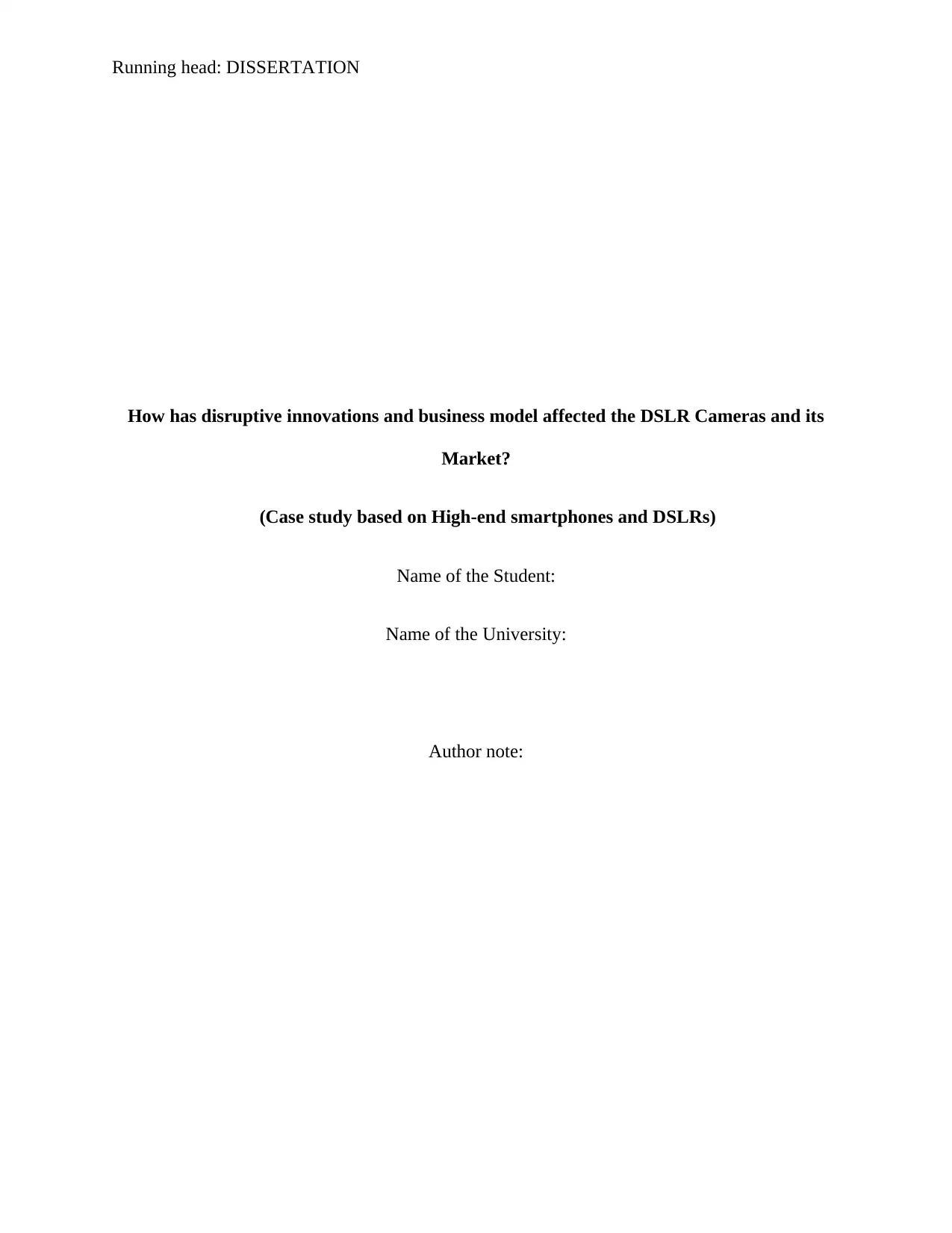
Running head: DISSERTATION
How has disruptive innovations and business model affected the DSLR Cameras and its
Market?
(Case study based on High-end smartphones and DSLRs)
Name of the Student:
Name of the University:
Author note:
How has disruptive innovations and business model affected the DSLR Cameras and its
Market?
(Case study based on High-end smartphones and DSLRs)
Name of the Student:
Name of the University:
Author note:
Secure Best Marks with AI Grader
Need help grading? Try our AI Grader for instant feedback on your assignments.
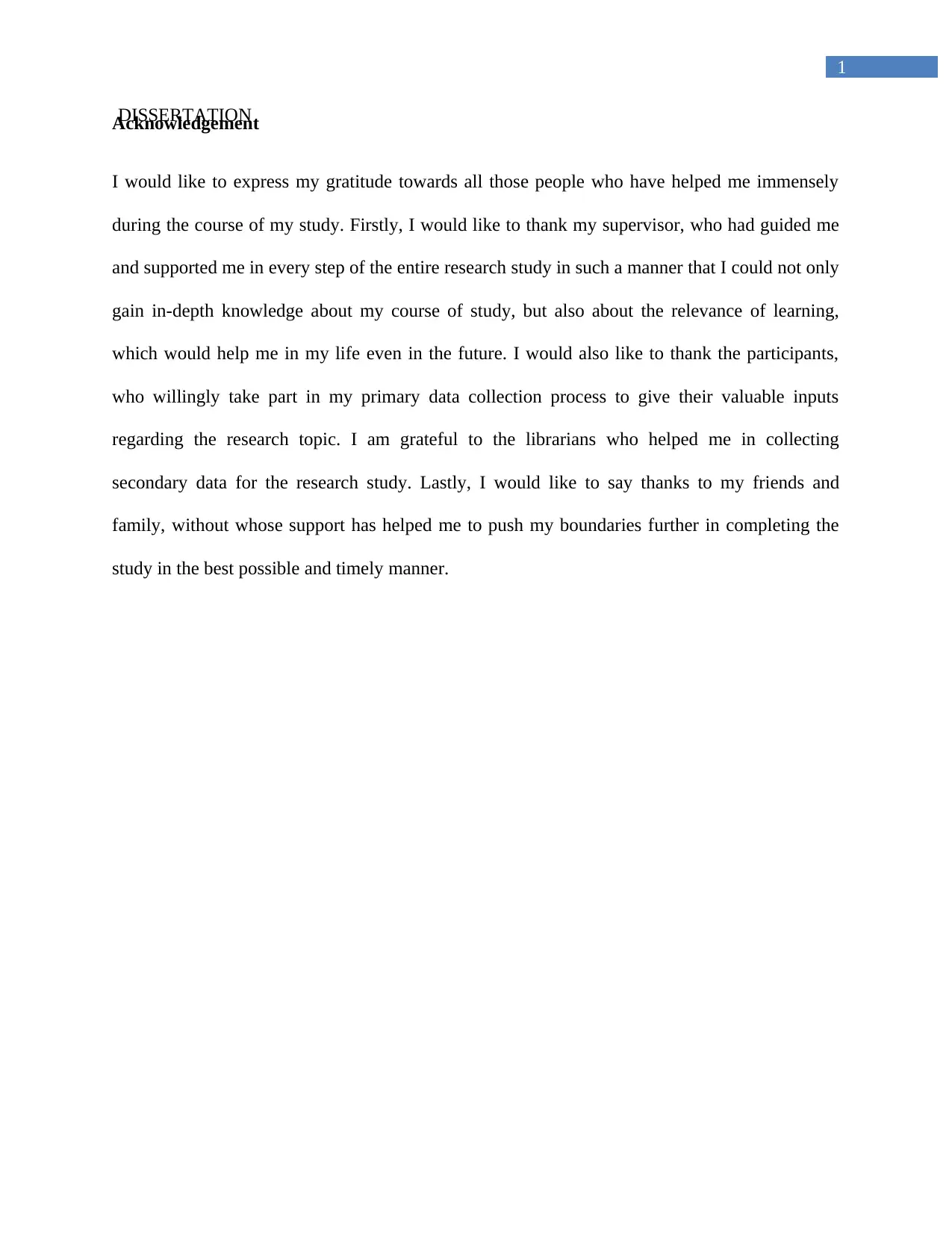
1
DISSERTATIONAcknowledgement
I would like to express my gratitude towards all those people who have helped me immensely
during the course of my study. Firstly, I would like to thank my supervisor, who had guided me
and supported me in every step of the entire research study in such a manner that I could not only
gain in-depth knowledge about my course of study, but also about the relevance of learning,
which would help me in my life even in the future. I would also like to thank the participants,
who willingly take part in my primary data collection process to give their valuable inputs
regarding the research topic. I am grateful to the librarians who helped me in collecting
secondary data for the research study. Lastly, I would like to say thanks to my friends and
family, without whose support has helped me to push my boundaries further in completing the
study in the best possible and timely manner.
DISSERTATIONAcknowledgement
I would like to express my gratitude towards all those people who have helped me immensely
during the course of my study. Firstly, I would like to thank my supervisor, who had guided me
and supported me in every step of the entire research study in such a manner that I could not only
gain in-depth knowledge about my course of study, but also about the relevance of learning,
which would help me in my life even in the future. I would also like to thank the participants,
who willingly take part in my primary data collection process to give their valuable inputs
regarding the research topic. I am grateful to the librarians who helped me in collecting
secondary data for the research study. Lastly, I would like to say thanks to my friends and
family, without whose support has helped me to push my boundaries further in completing the
study in the best possible and timely manner.
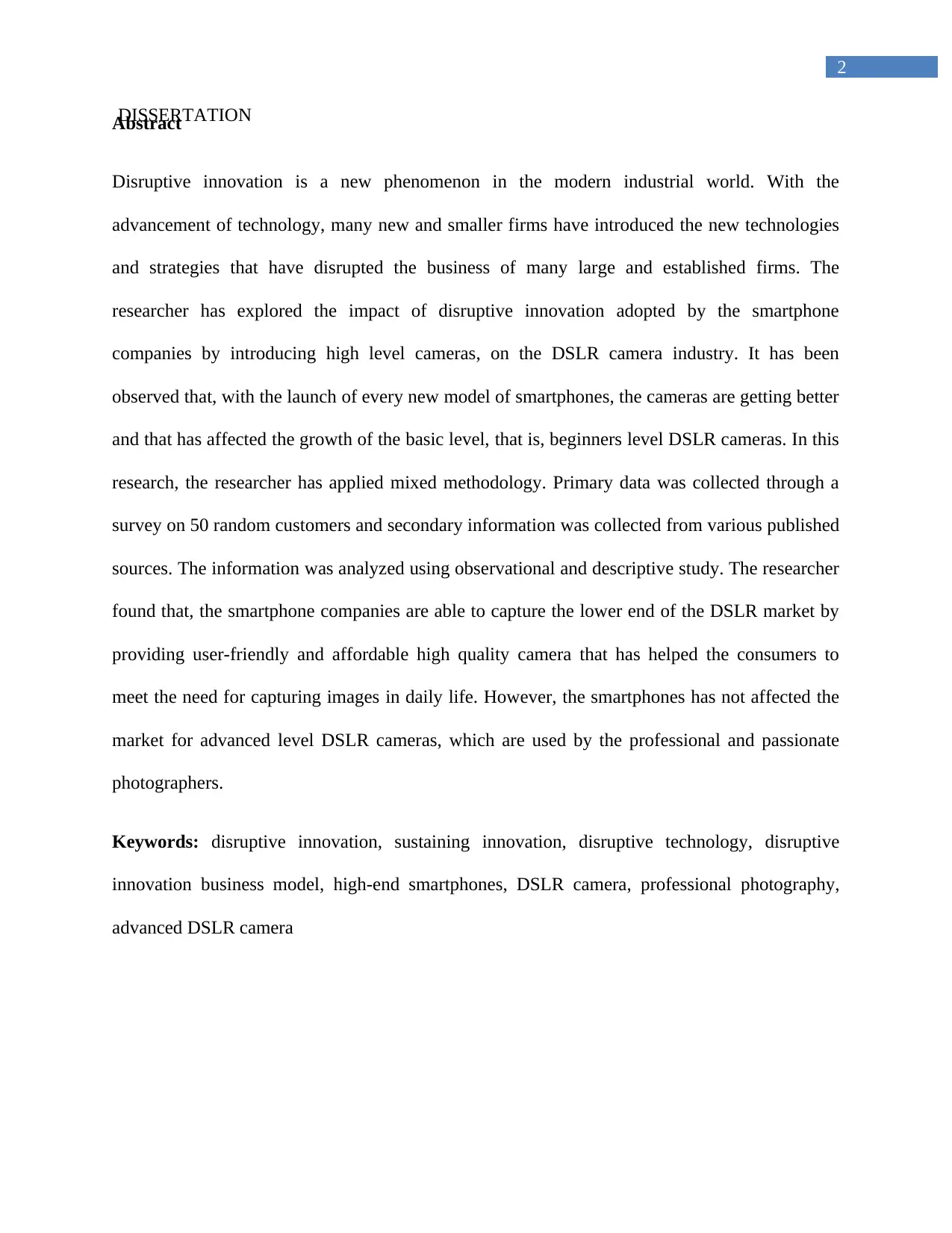
2
DISSERTATIONAbstract
Disruptive innovation is a new phenomenon in the modern industrial world. With the
advancement of technology, many new and smaller firms have introduced the new technologies
and strategies that have disrupted the business of many large and established firms. The
researcher has explored the impact of disruptive innovation adopted by the smartphone
companies by introducing high level cameras, on the DSLR camera industry. It has been
observed that, with the launch of every new model of smartphones, the cameras are getting better
and that has affected the growth of the basic level, that is, beginners level DSLR cameras. In this
research, the researcher has applied mixed methodology. Primary data was collected through a
survey on 50 random customers and secondary information was collected from various published
sources. The information was analyzed using observational and descriptive study. The researcher
found that, the smartphone companies are able to capture the lower end of the DSLR market by
providing user-friendly and affordable high quality camera that has helped the consumers to
meet the need for capturing images in daily life. However, the smartphones has not affected the
market for advanced level DSLR cameras, which are used by the professional and passionate
photographers.
Keywords: disruptive innovation, sustaining innovation, disruptive technology, disruptive
innovation business model, high-end smartphones, DSLR camera, professional photography,
advanced DSLR camera
DISSERTATIONAbstract
Disruptive innovation is a new phenomenon in the modern industrial world. With the
advancement of technology, many new and smaller firms have introduced the new technologies
and strategies that have disrupted the business of many large and established firms. The
researcher has explored the impact of disruptive innovation adopted by the smartphone
companies by introducing high level cameras, on the DSLR camera industry. It has been
observed that, with the launch of every new model of smartphones, the cameras are getting better
and that has affected the growth of the basic level, that is, beginners level DSLR cameras. In this
research, the researcher has applied mixed methodology. Primary data was collected through a
survey on 50 random customers and secondary information was collected from various published
sources. The information was analyzed using observational and descriptive study. The researcher
found that, the smartphone companies are able to capture the lower end of the DSLR market by
providing user-friendly and affordable high quality camera that has helped the consumers to
meet the need for capturing images in daily life. However, the smartphones has not affected the
market for advanced level DSLR cameras, which are used by the professional and passionate
photographers.
Keywords: disruptive innovation, sustaining innovation, disruptive technology, disruptive
innovation business model, high-end smartphones, DSLR camera, professional photography,
advanced DSLR camera
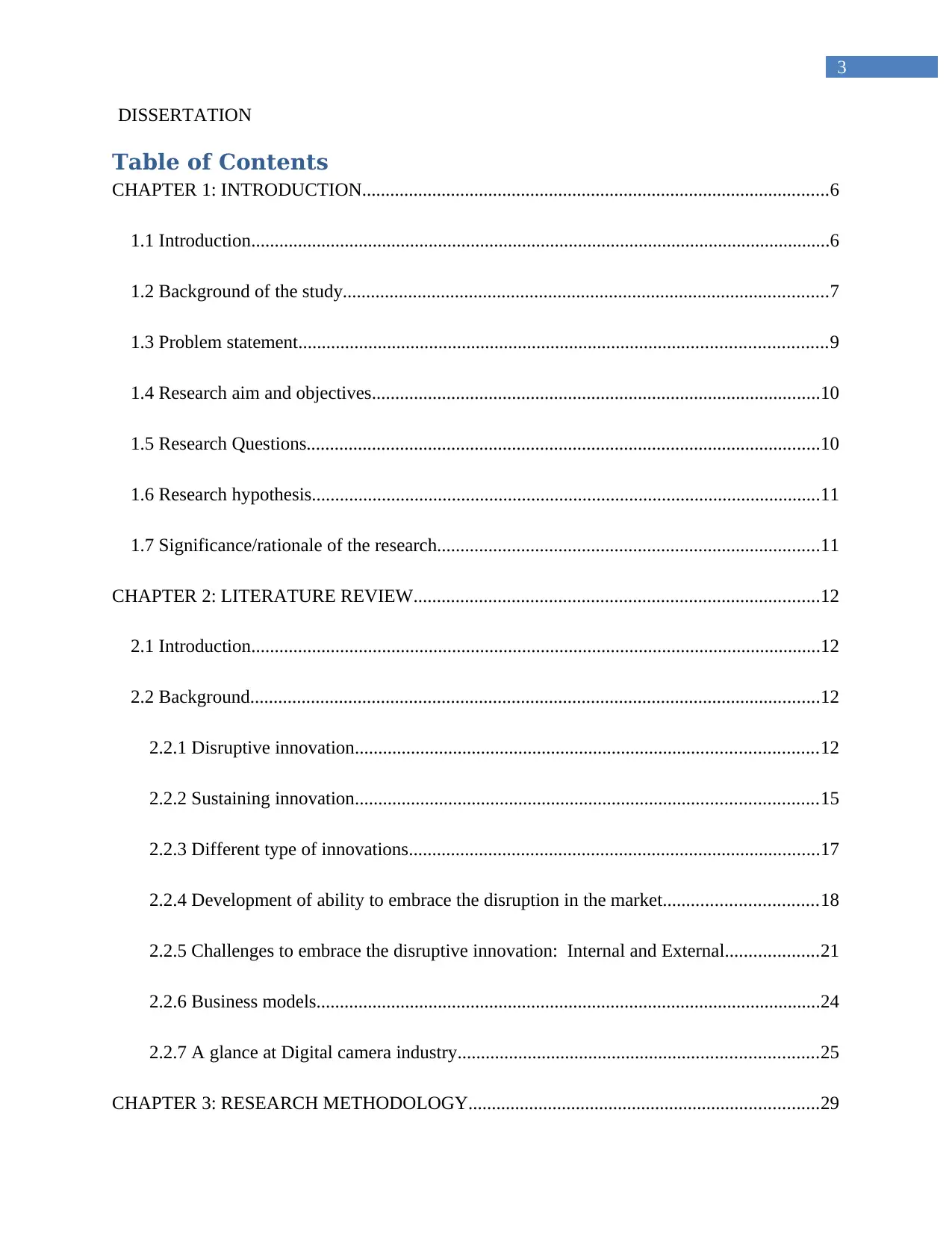
3
DISSERTATION
Table of Contents
CHAPTER 1: INTRODUCTION....................................................................................................6
1.1 Introduction............................................................................................................................6
1.2 Background of the study........................................................................................................7
1.3 Problem statement.................................................................................................................9
1.4 Research aim and objectives................................................................................................10
1.5 Research Questions..............................................................................................................10
1.6 Research hypothesis.............................................................................................................11
1.7 Significance/rationale of the research..................................................................................11
CHAPTER 2: LITERATURE REVIEW.......................................................................................12
2.1 Introduction..........................................................................................................................12
2.2 Background..........................................................................................................................12
2.2.1 Disruptive innovation...................................................................................................12
2.2.2 Sustaining innovation...................................................................................................15
2.2.3 Different type of innovations........................................................................................17
2.2.4 Development of ability to embrace the disruption in the market.................................18
2.2.5 Challenges to embrace the disruptive innovation: Internal and External....................21
2.2.6 Business models............................................................................................................24
2.2.7 A glance at Digital camera industry.............................................................................25
CHAPTER 3: RESEARCH METHODOLOGY...........................................................................29
DISSERTATION
Table of Contents
CHAPTER 1: INTRODUCTION....................................................................................................6
1.1 Introduction............................................................................................................................6
1.2 Background of the study........................................................................................................7
1.3 Problem statement.................................................................................................................9
1.4 Research aim and objectives................................................................................................10
1.5 Research Questions..............................................................................................................10
1.6 Research hypothesis.............................................................................................................11
1.7 Significance/rationale of the research..................................................................................11
CHAPTER 2: LITERATURE REVIEW.......................................................................................12
2.1 Introduction..........................................................................................................................12
2.2 Background..........................................................................................................................12
2.2.1 Disruptive innovation...................................................................................................12
2.2.2 Sustaining innovation...................................................................................................15
2.2.3 Different type of innovations........................................................................................17
2.2.4 Development of ability to embrace the disruption in the market.................................18
2.2.5 Challenges to embrace the disruptive innovation: Internal and External....................21
2.2.6 Business models............................................................................................................24
2.2.7 A glance at Digital camera industry.............................................................................25
CHAPTER 3: RESEARCH METHODOLOGY...........................................................................29
Secure Best Marks with AI Grader
Need help grading? Try our AI Grader for instant feedback on your assignments.
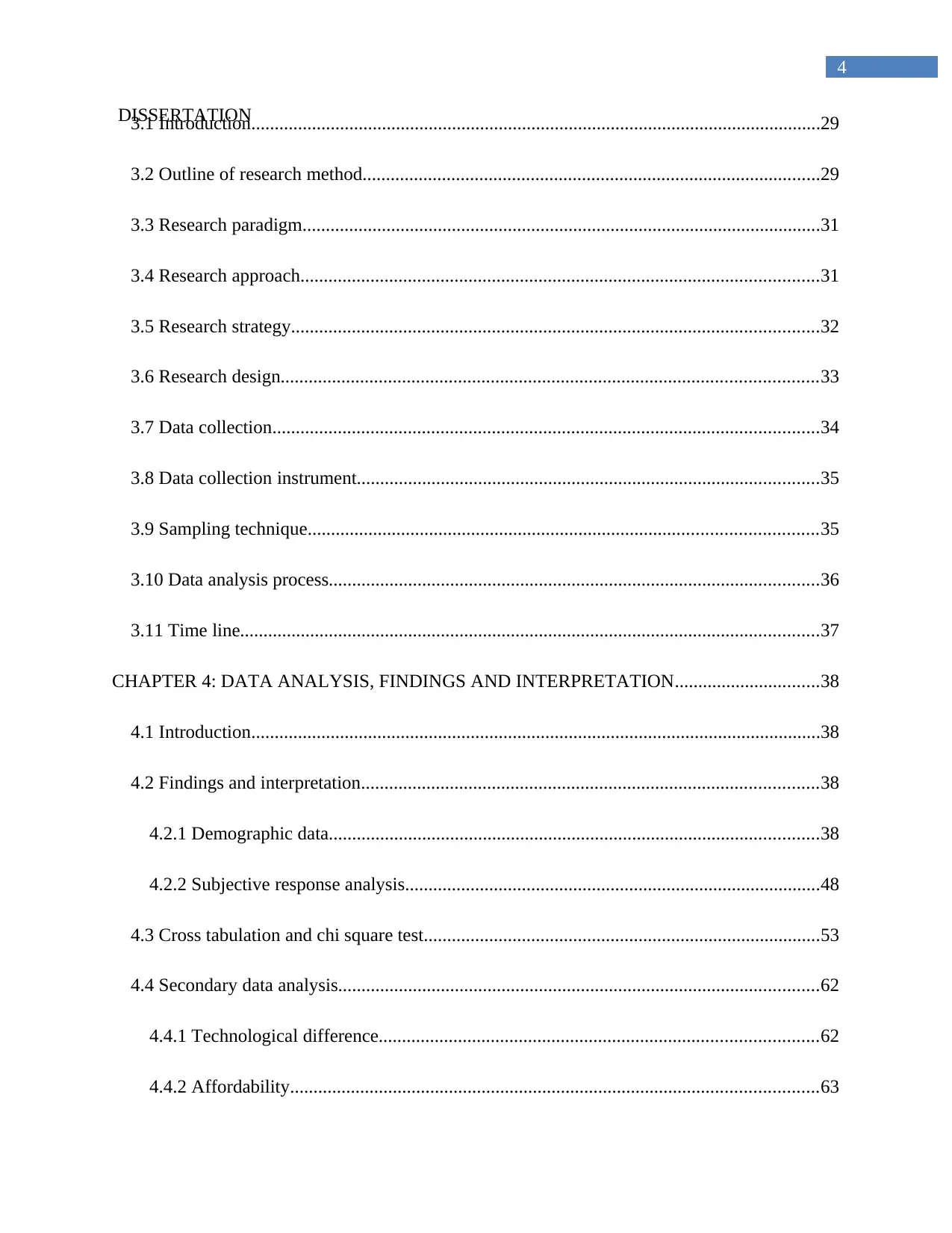
4
DISSERTATION3.1 Introduction..........................................................................................................................29
3.2 Outline of research method..................................................................................................29
3.3 Research paradigm...............................................................................................................31
3.4 Research approach...............................................................................................................31
3.5 Research strategy.................................................................................................................32
3.6 Research design...................................................................................................................33
3.7 Data collection.....................................................................................................................34
3.8 Data collection instrument...................................................................................................35
3.9 Sampling technique.............................................................................................................35
3.10 Data analysis process.........................................................................................................36
3.11 Time line............................................................................................................................37
CHAPTER 4: DATA ANALYSIS, FINDINGS AND INTERPRETATION...............................38
4.1 Introduction..........................................................................................................................38
4.2 Findings and interpretation..................................................................................................38
4.2.1 Demographic data.........................................................................................................38
4.2.2 Subjective response analysis.........................................................................................48
4.3 Cross tabulation and chi square test.....................................................................................53
4.4 Secondary data analysis.......................................................................................................62
4.4.1 Technological difference..............................................................................................62
4.4.2 Affordability.................................................................................................................63
DISSERTATION3.1 Introduction..........................................................................................................................29
3.2 Outline of research method..................................................................................................29
3.3 Research paradigm...............................................................................................................31
3.4 Research approach...............................................................................................................31
3.5 Research strategy.................................................................................................................32
3.6 Research design...................................................................................................................33
3.7 Data collection.....................................................................................................................34
3.8 Data collection instrument...................................................................................................35
3.9 Sampling technique.............................................................................................................35
3.10 Data analysis process.........................................................................................................36
3.11 Time line............................................................................................................................37
CHAPTER 4: DATA ANALYSIS, FINDINGS AND INTERPRETATION...............................38
4.1 Introduction..........................................................................................................................38
4.2 Findings and interpretation..................................................................................................38
4.2.1 Demographic data.........................................................................................................38
4.2.2 Subjective response analysis.........................................................................................48
4.3 Cross tabulation and chi square test.....................................................................................53
4.4 Secondary data analysis.......................................................................................................62
4.4.1 Technological difference..............................................................................................62
4.4.2 Affordability.................................................................................................................63

5
DISSERTATION4.5 Summary..............................................................................................................................64
CHAPTER 5: CONCLUSION AND RECOMMENDATIONS...................................................65
5.1 Introduction..........................................................................................................................65
5.2 Linking to the objectives.....................................................................................................65
5.2.1 Linking to the first objective.........................................................................................65
5.2.2 Linking to the second objective....................................................................................67
5.2.3 Linking to the third objective.......................................................................................68
5.3 Recommendations................................................................................................................68
5.4 Limitations and future scope of study.................................................................................69
References......................................................................................................................................71
Appendix 1.....................................................................................................................................80
Appendix 2.....................................................................................................................................83
Appendix 3.....................................................................................................................................83
DISSERTATION4.5 Summary..............................................................................................................................64
CHAPTER 5: CONCLUSION AND RECOMMENDATIONS...................................................65
5.1 Introduction..........................................................................................................................65
5.2 Linking to the objectives.....................................................................................................65
5.2.1 Linking to the first objective.........................................................................................65
5.2.2 Linking to the second objective....................................................................................67
5.2.3 Linking to the third objective.......................................................................................68
5.3 Recommendations................................................................................................................68
5.4 Limitations and future scope of study.................................................................................69
References......................................................................................................................................71
Appendix 1.....................................................................................................................................80
Appendix 2.....................................................................................................................................83
Appendix 3.....................................................................................................................................83
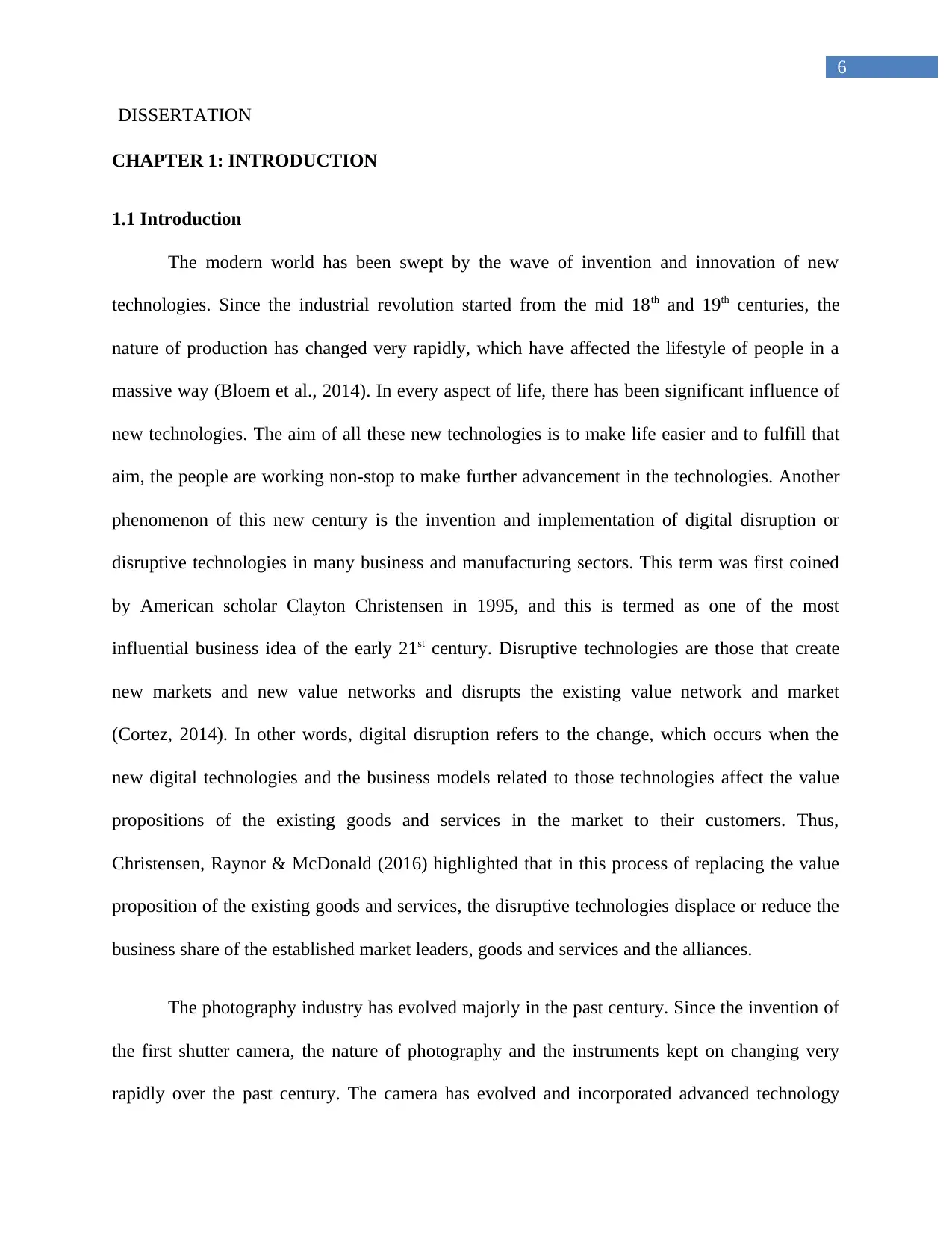
6
DISSERTATION
CHAPTER 1: INTRODUCTION
1.1 Introduction
The modern world has been swept by the wave of invention and innovation of new
technologies. Since the industrial revolution started from the mid 18th and 19th centuries, the
nature of production has changed very rapidly, which have affected the lifestyle of people in a
massive way (Bloem et al., 2014). In every aspect of life, there has been significant influence of
new technologies. The aim of all these new technologies is to make life easier and to fulfill that
aim, the people are working non-stop to make further advancement in the technologies. Another
phenomenon of this new century is the invention and implementation of digital disruption or
disruptive technologies in many business and manufacturing sectors. This term was first coined
by American scholar Clayton Christensen in 1995, and this is termed as one of the most
influential business idea of the early 21st century. Disruptive technologies are those that create
new markets and new value networks and disrupts the existing value network and market
(Cortez, 2014). In other words, digital disruption refers to the change, which occurs when the
new digital technologies and the business models related to those technologies affect the value
propositions of the existing goods and services in the market to their customers. Thus,
Christensen, Raynor & McDonald (2016) highlighted that in this process of replacing the value
proposition of the existing goods and services, the disruptive technologies displace or reduce the
business share of the established market leaders, goods and services and the alliances.
The photography industry has evolved majorly in the past century. Since the invention of
the first shutter camera, the nature of photography and the instruments kept on changing very
rapidly over the past century. The camera has evolved and incorporated advanced technology
DISSERTATION
CHAPTER 1: INTRODUCTION
1.1 Introduction
The modern world has been swept by the wave of invention and innovation of new
technologies. Since the industrial revolution started from the mid 18th and 19th centuries, the
nature of production has changed very rapidly, which have affected the lifestyle of people in a
massive way (Bloem et al., 2014). In every aspect of life, there has been significant influence of
new technologies. The aim of all these new technologies is to make life easier and to fulfill that
aim, the people are working non-stop to make further advancement in the technologies. Another
phenomenon of this new century is the invention and implementation of digital disruption or
disruptive technologies in many business and manufacturing sectors. This term was first coined
by American scholar Clayton Christensen in 1995, and this is termed as one of the most
influential business idea of the early 21st century. Disruptive technologies are those that create
new markets and new value networks and disrupts the existing value network and market
(Cortez, 2014). In other words, digital disruption refers to the change, which occurs when the
new digital technologies and the business models related to those technologies affect the value
propositions of the existing goods and services in the market to their customers. Thus,
Christensen, Raynor & McDonald (2016) highlighted that in this process of replacing the value
proposition of the existing goods and services, the disruptive technologies displace or reduce the
business share of the established market leaders, goods and services and the alliances.
The photography industry has evolved majorly in the past century. Since the invention of
the first shutter camera, the nature of photography and the instruments kept on changing very
rapidly over the past century. The camera has evolved and incorporated advanced technology
Paraphrase This Document
Need a fresh take? Get an instant paraphrase of this document with our AI Paraphraser
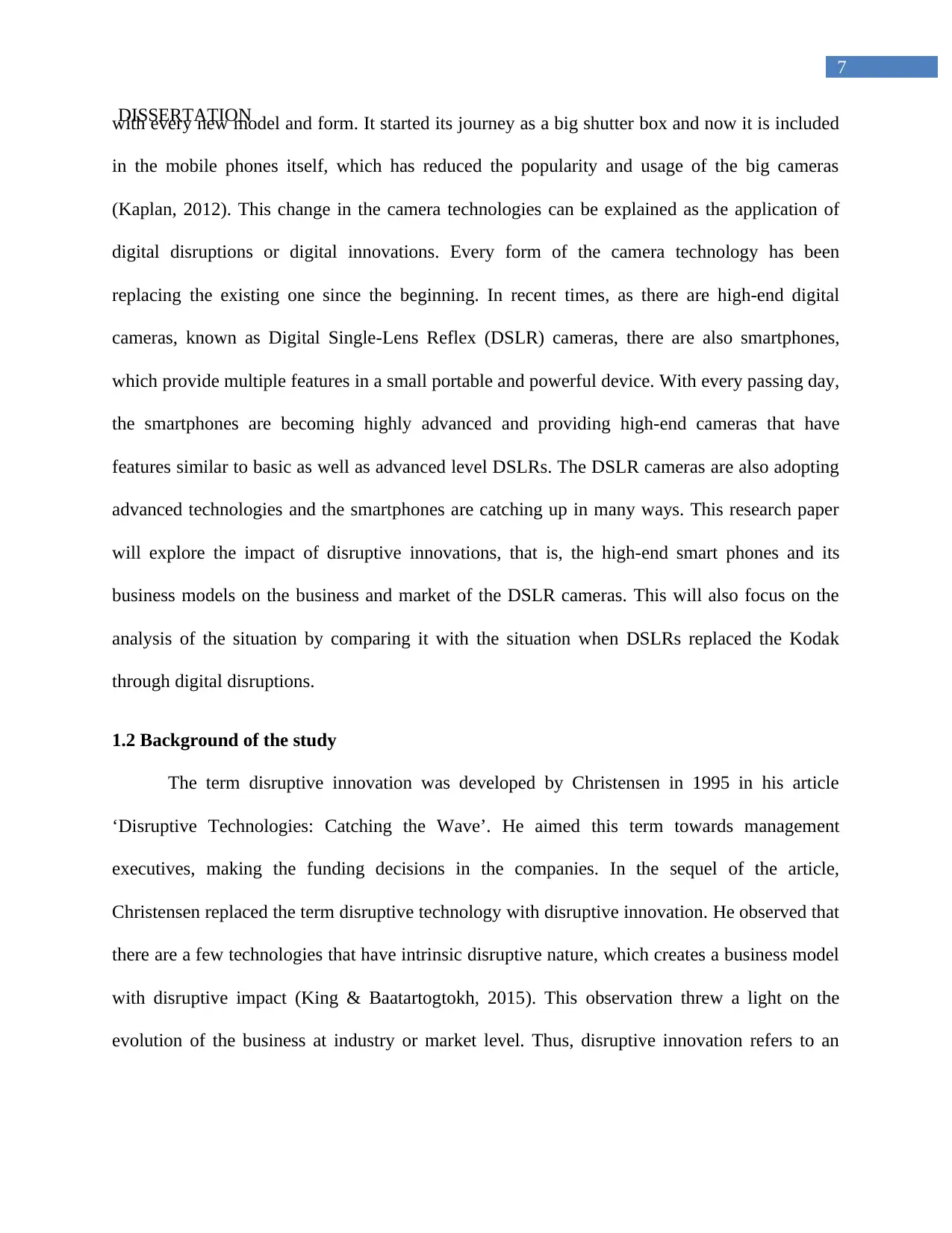
7
DISSERTATIONwith every new model and form. It started its journey as a big shutter box and now it is included
in the mobile phones itself, which has reduced the popularity and usage of the big cameras
(Kaplan, 2012). This change in the camera technologies can be explained as the application of
digital disruptions or digital innovations. Every form of the camera technology has been
replacing the existing one since the beginning. In recent times, as there are high-end digital
cameras, known as Digital Single-Lens Reflex (DSLR) cameras, there are also smartphones,
which provide multiple features in a small portable and powerful device. With every passing day,
the smartphones are becoming highly advanced and providing high-end cameras that have
features similar to basic as well as advanced level DSLRs. The DSLR cameras are also adopting
advanced technologies and the smartphones are catching up in many ways. This research paper
will explore the impact of disruptive innovations, that is, the high-end smart phones and its
business models on the business and market of the DSLR cameras. This will also focus on the
analysis of the situation by comparing it with the situation when DSLRs replaced the Kodak
through digital disruptions.
1.2 Background of the study
The term disruptive innovation was developed by Christensen in 1995 in his article
‘Disruptive Technologies: Catching the Wave’. He aimed this term towards management
executives, making the funding decisions in the companies. In the sequel of the article,
Christensen replaced the term disruptive technology with disruptive innovation. He observed that
there are a few technologies that have intrinsic disruptive nature, which creates a business model
with disruptive impact (King & Baatartogtokh, 2015). This observation threw a light on the
evolution of the business at industry or market level. Thus, disruptive innovation refers to an
DISSERTATIONwith every new model and form. It started its journey as a big shutter box and now it is included
in the mobile phones itself, which has reduced the popularity and usage of the big cameras
(Kaplan, 2012). This change in the camera technologies can be explained as the application of
digital disruptions or digital innovations. Every form of the camera technology has been
replacing the existing one since the beginning. In recent times, as there are high-end digital
cameras, known as Digital Single-Lens Reflex (DSLR) cameras, there are also smartphones,
which provide multiple features in a small portable and powerful device. With every passing day,
the smartphones are becoming highly advanced and providing high-end cameras that have
features similar to basic as well as advanced level DSLRs. The DSLR cameras are also adopting
advanced technologies and the smartphones are catching up in many ways. This research paper
will explore the impact of disruptive innovations, that is, the high-end smart phones and its
business models on the business and market of the DSLR cameras. This will also focus on the
analysis of the situation by comparing it with the situation when DSLRs replaced the Kodak
through digital disruptions.
1.2 Background of the study
The term disruptive innovation was developed by Christensen in 1995 in his article
‘Disruptive Technologies: Catching the Wave’. He aimed this term towards management
executives, making the funding decisions in the companies. In the sequel of the article,
Christensen replaced the term disruptive technology with disruptive innovation. He observed that
there are a few technologies that have intrinsic disruptive nature, which creates a business model
with disruptive impact (King & Baatartogtokh, 2015). This observation threw a light on the
evolution of the business at industry or market level. Thus, disruptive innovation refers to an

8
DISSERTATIONevolutionary journey of technologies and business models rather than to a product or service at
one fixed point of time (Lepore, 2014).
Disruptive innovations have been influencing various industries for the past two decades.
The business models introduced by these innovations have been quite revolutionary as they have
changed the course of business of the existing industries. One of the biggest examples of the
disruptive innovations is the inventions of smartphones. Apple CEO Steve Jobs introduced the
first smartphone in the world in 2007. The mobile device incorporated touch screen and
operating systems like the computers (Wilson & Watkins, 2014). This was a big revolution in the
mobile business that started from United States to all over the world. IPhone disrupted the
business for the other traditional mobile companies, such as, Nokia, and Motorola. These
companies were forced to change their technology as well as business models to retain their
market share. After iPhone, many companies, such as, Samsung, Google, HTC, and many lower
budget mobile companies have moved into the smartphone technology. Over time, these phones
have been incorporating many new features, such as, high-end cameras. The camera technology
was started with VGA camera and now the companies are providing cameras for up to 16MP
with dual lens, with many features similar to the DSLRs (Chesher, 2012). The phones are also
affordable to people than any DSLR camera.
Similarly, in the photographic device market, Nikon, Canon, Pentax and Sony have
captured the digital photography market with advanced digi-cams and DSLRs and led Kodak out
of business. The disruptive innovations by these companies have changed the business model of
the photography market, which was captured by Kodak earlier (Downes & Nunes, 2013). This
creates the background context for this study. The researcher will explore different aspects of the
DISSERTATIONevolutionary journey of technologies and business models rather than to a product or service at
one fixed point of time (Lepore, 2014).
Disruptive innovations have been influencing various industries for the past two decades.
The business models introduced by these innovations have been quite revolutionary as they have
changed the course of business of the existing industries. One of the biggest examples of the
disruptive innovations is the inventions of smartphones. Apple CEO Steve Jobs introduced the
first smartphone in the world in 2007. The mobile device incorporated touch screen and
operating systems like the computers (Wilson & Watkins, 2014). This was a big revolution in the
mobile business that started from United States to all over the world. IPhone disrupted the
business for the other traditional mobile companies, such as, Nokia, and Motorola. These
companies were forced to change their technology as well as business models to retain their
market share. After iPhone, many companies, such as, Samsung, Google, HTC, and many lower
budget mobile companies have moved into the smartphone technology. Over time, these phones
have been incorporating many new features, such as, high-end cameras. The camera technology
was started with VGA camera and now the companies are providing cameras for up to 16MP
with dual lens, with many features similar to the DSLRs (Chesher, 2012). The phones are also
affordable to people than any DSLR camera.
Similarly, in the photographic device market, Nikon, Canon, Pentax and Sony have
captured the digital photography market with advanced digi-cams and DSLRs and led Kodak out
of business. The disruptive innovations by these companies have changed the business model of
the photography market, which was captured by Kodak earlier (Downes & Nunes, 2013). This
creates the background context for this study. The researcher will explore different aspects of the
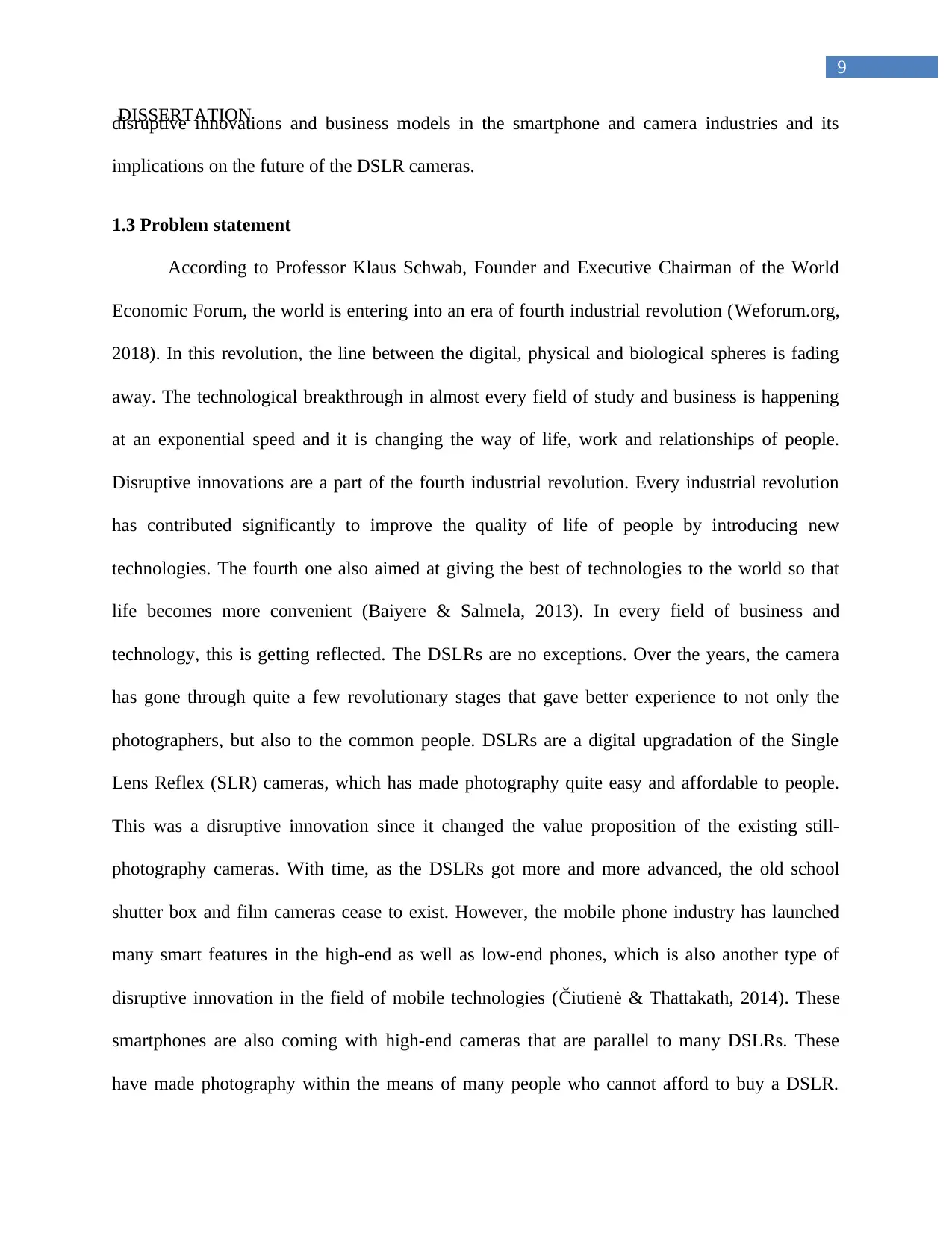
9
DISSERTATIONdisruptive innovations and business models in the smartphone and camera industries and its
implications on the future of the DSLR cameras.
1.3 Problem statement
According to Professor Klaus Schwab, Founder and Executive Chairman of the World
Economic Forum, the world is entering into an era of fourth industrial revolution (Weforum.org,
2018). In this revolution, the line between the digital, physical and biological spheres is fading
away. The technological breakthrough in almost every field of study and business is happening
at an exponential speed and it is changing the way of life, work and relationships of people.
Disruptive innovations are a part of the fourth industrial revolution. Every industrial revolution
has contributed significantly to improve the quality of life of people by introducing new
technologies. The fourth one also aimed at giving the best of technologies to the world so that
life becomes more convenient (Baiyere & Salmela, 2013). In every field of business and
technology, this is getting reflected. The DSLRs are no exceptions. Over the years, the camera
has gone through quite a few revolutionary stages that gave better experience to not only the
photographers, but also to the common people. DSLRs are a digital upgradation of the Single
Lens Reflex (SLR) cameras, which has made photography quite easy and affordable to people.
This was a disruptive innovation since it changed the value proposition of the existing still-
photography cameras. With time, as the DSLRs got more and more advanced, the old school
shutter box and film cameras cease to exist. However, the mobile phone industry has launched
many smart features in the high-end as well as low-end phones, which is also another type of
disruptive innovation in the field of mobile technologies (Čiutienė & Thattakath, 2014). These
smartphones are also coming with high-end cameras that are parallel to many DSLRs. These
have made photography within the means of many people who cannot afford to buy a DSLR.
DISSERTATIONdisruptive innovations and business models in the smartphone and camera industries and its
implications on the future of the DSLR cameras.
1.3 Problem statement
According to Professor Klaus Schwab, Founder and Executive Chairman of the World
Economic Forum, the world is entering into an era of fourth industrial revolution (Weforum.org,
2018). In this revolution, the line between the digital, physical and biological spheres is fading
away. The technological breakthrough in almost every field of study and business is happening
at an exponential speed and it is changing the way of life, work and relationships of people.
Disruptive innovations are a part of the fourth industrial revolution. Every industrial revolution
has contributed significantly to improve the quality of life of people by introducing new
technologies. The fourth one also aimed at giving the best of technologies to the world so that
life becomes more convenient (Baiyere & Salmela, 2013). In every field of business and
technology, this is getting reflected. The DSLRs are no exceptions. Over the years, the camera
has gone through quite a few revolutionary stages that gave better experience to not only the
photographers, but also to the common people. DSLRs are a digital upgradation of the Single
Lens Reflex (SLR) cameras, which has made photography quite easy and affordable to people.
This was a disruptive innovation since it changed the value proposition of the existing still-
photography cameras. With time, as the DSLRs got more and more advanced, the old school
shutter box and film cameras cease to exist. However, the mobile phone industry has launched
many smart features in the high-end as well as low-end phones, which is also another type of
disruptive innovation in the field of mobile technologies (Čiutienė & Thattakath, 2014). These
smartphones are also coming with high-end cameras that are parallel to many DSLRs. These
have made photography within the means of many people who cannot afford to buy a DSLR.
Secure Best Marks with AI Grader
Need help grading? Try our AI Grader for instant feedback on your assignments.
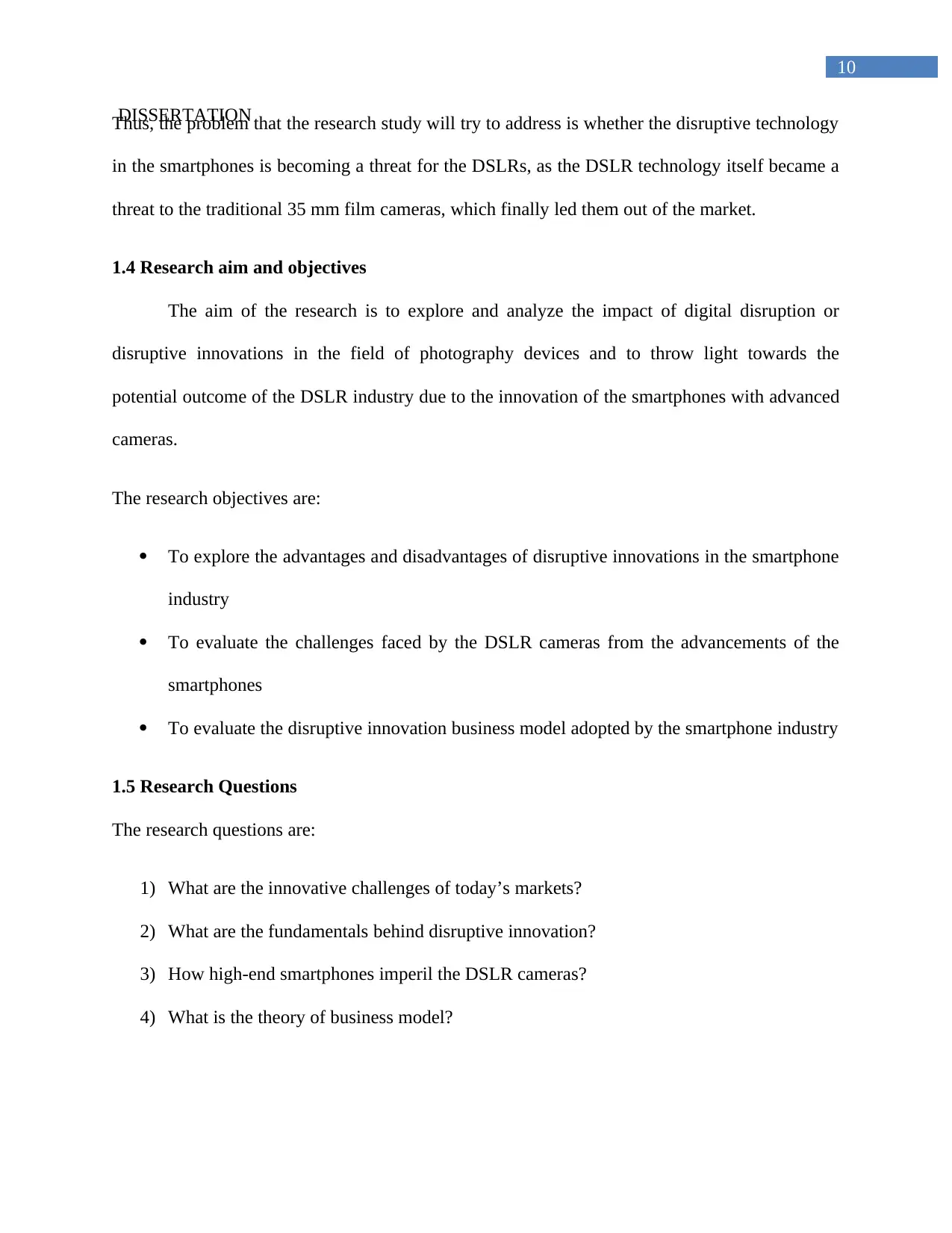
10
DISSERTATIONThus, the problem that the research study will try to address is whether the disruptive technology
in the smartphones is becoming a threat for the DSLRs, as the DSLR technology itself became a
threat to the traditional 35 mm film cameras, which finally led them out of the market.
1.4 Research aim and objectives
The aim of the research is to explore and analyze the impact of digital disruption or
disruptive innovations in the field of photography devices and to throw light towards the
potential outcome of the DSLR industry due to the innovation of the smartphones with advanced
cameras.
The research objectives are:
To explore the advantages and disadvantages of disruptive innovations in the smartphone
industry
To evaluate the challenges faced by the DSLR cameras from the advancements of the
smartphones
To evaluate the disruptive innovation business model adopted by the smartphone industry
1.5 Research Questions
The research questions are:
1) What are the innovative challenges of today’s markets?
2) What are the fundamentals behind disruptive innovation?
3) How high-end smartphones imperil the DSLR cameras?
4) What is the theory of business model?
DISSERTATIONThus, the problem that the research study will try to address is whether the disruptive technology
in the smartphones is becoming a threat for the DSLRs, as the DSLR technology itself became a
threat to the traditional 35 mm film cameras, which finally led them out of the market.
1.4 Research aim and objectives
The aim of the research is to explore and analyze the impact of digital disruption or
disruptive innovations in the field of photography devices and to throw light towards the
potential outcome of the DSLR industry due to the innovation of the smartphones with advanced
cameras.
The research objectives are:
To explore the advantages and disadvantages of disruptive innovations in the smartphone
industry
To evaluate the challenges faced by the DSLR cameras from the advancements of the
smartphones
To evaluate the disruptive innovation business model adopted by the smartphone industry
1.5 Research Questions
The research questions are:
1) What are the innovative challenges of today’s markets?
2) What are the fundamentals behind disruptive innovation?
3) How high-end smartphones imperil the DSLR cameras?
4) What is the theory of business model?
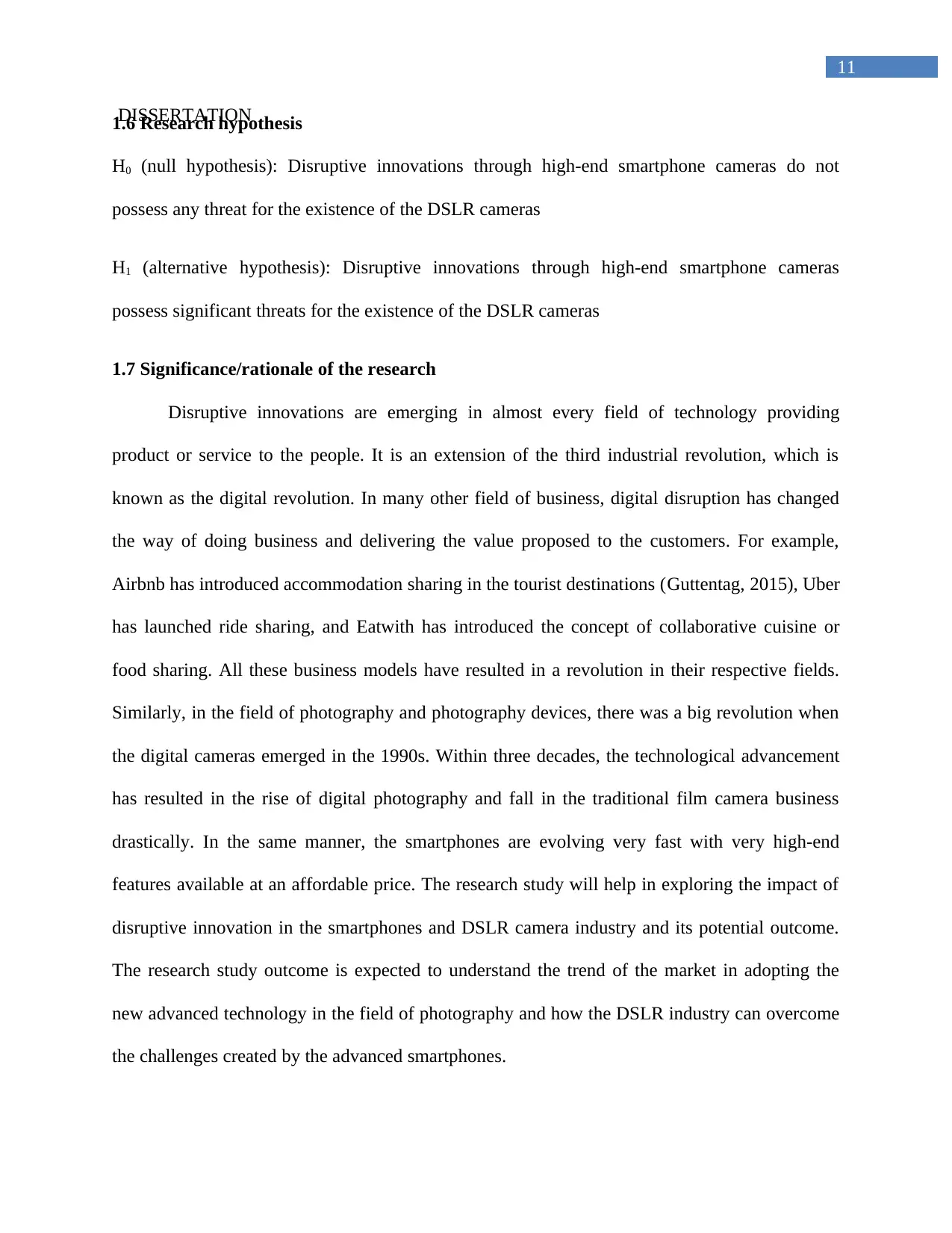
11
DISSERTATION1.6 Research hypothesis
H0 (null hypothesis): Disruptive innovations through high-end smartphone cameras do not
possess any threat for the existence of the DSLR cameras
H1 (alternative hypothesis): Disruptive innovations through high-end smartphone cameras
possess significant threats for the existence of the DSLR cameras
1.7 Significance/rationale of the research
Disruptive innovations are emerging in almost every field of technology providing
product or service to the people. It is an extension of the third industrial revolution, which is
known as the digital revolution. In many other field of business, digital disruption has changed
the way of doing business and delivering the value proposed to the customers. For example,
Airbnb has introduced accommodation sharing in the tourist destinations (Guttentag, 2015), Uber
has launched ride sharing, and Eatwith has introduced the concept of collaborative cuisine or
food sharing. All these business models have resulted in a revolution in their respective fields.
Similarly, in the field of photography and photography devices, there was a big revolution when
the digital cameras emerged in the 1990s. Within three decades, the technological advancement
has resulted in the rise of digital photography and fall in the traditional film camera business
drastically. In the same manner, the smartphones are evolving very fast with very high-end
features available at an affordable price. The research study will help in exploring the impact of
disruptive innovation in the smartphones and DSLR camera industry and its potential outcome.
The research study outcome is expected to understand the trend of the market in adopting the
new advanced technology in the field of photography and how the DSLR industry can overcome
the challenges created by the advanced smartphones.
DISSERTATION1.6 Research hypothesis
H0 (null hypothesis): Disruptive innovations through high-end smartphone cameras do not
possess any threat for the existence of the DSLR cameras
H1 (alternative hypothesis): Disruptive innovations through high-end smartphone cameras
possess significant threats for the existence of the DSLR cameras
1.7 Significance/rationale of the research
Disruptive innovations are emerging in almost every field of technology providing
product or service to the people. It is an extension of the third industrial revolution, which is
known as the digital revolution. In many other field of business, digital disruption has changed
the way of doing business and delivering the value proposed to the customers. For example,
Airbnb has introduced accommodation sharing in the tourist destinations (Guttentag, 2015), Uber
has launched ride sharing, and Eatwith has introduced the concept of collaborative cuisine or
food sharing. All these business models have resulted in a revolution in their respective fields.
Similarly, in the field of photography and photography devices, there was a big revolution when
the digital cameras emerged in the 1990s. Within three decades, the technological advancement
has resulted in the rise of digital photography and fall in the traditional film camera business
drastically. In the same manner, the smartphones are evolving very fast with very high-end
features available at an affordable price. The research study will help in exploring the impact of
disruptive innovation in the smartphones and DSLR camera industry and its potential outcome.
The research study outcome is expected to understand the trend of the market in adopting the
new advanced technology in the field of photography and how the DSLR industry can overcome
the challenges created by the advanced smartphones.
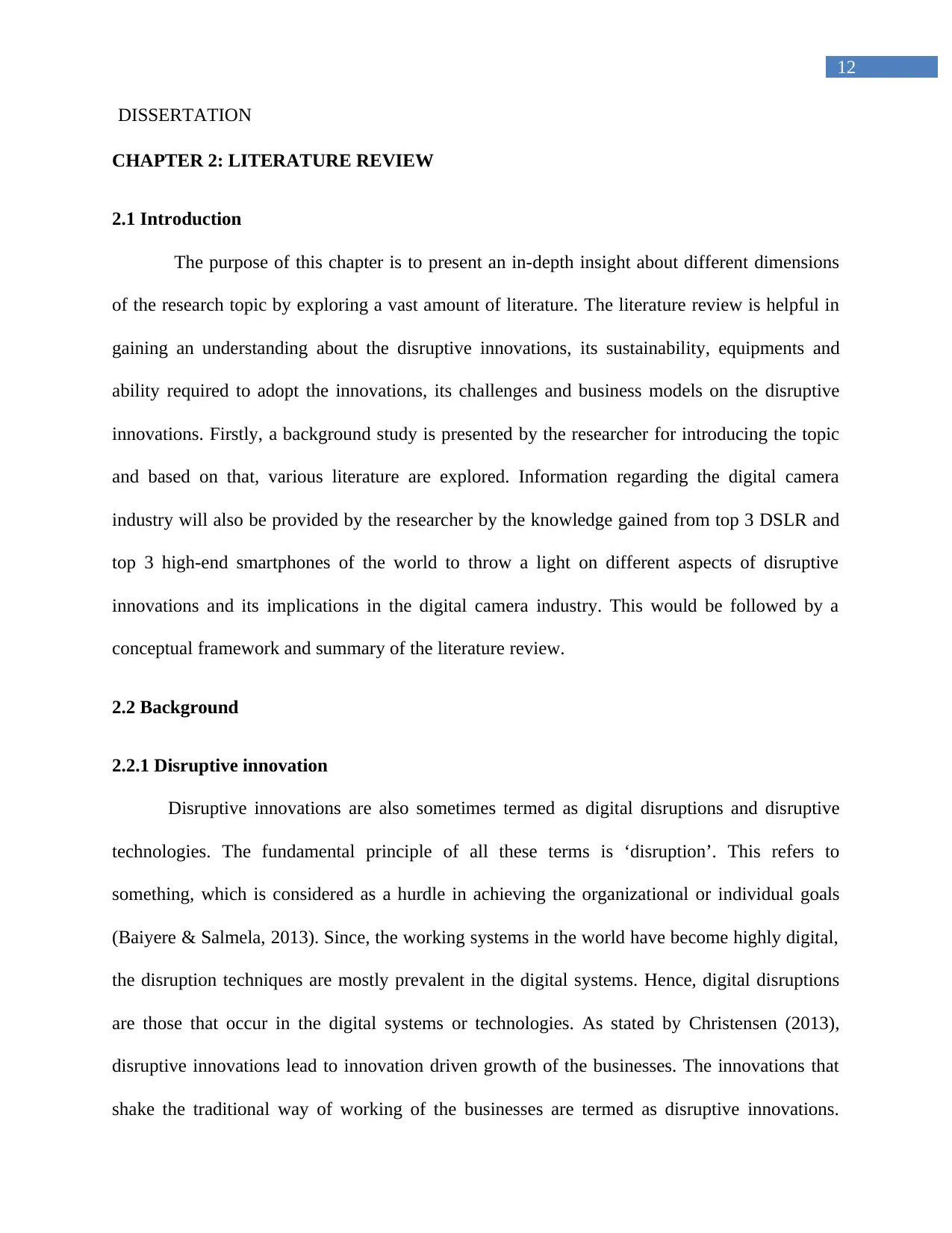
12
DISSERTATION
CHAPTER 2: LITERATURE REVIEW
2.1 Introduction
The purpose of this chapter is to present an in-depth insight about different dimensions
of the research topic by exploring a vast amount of literature. The literature review is helpful in
gaining an understanding about the disruptive innovations, its sustainability, equipments and
ability required to adopt the innovations, its challenges and business models on the disruptive
innovations. Firstly, a background study is presented by the researcher for introducing the topic
and based on that, various literature are explored. Information regarding the digital camera
industry will also be provided by the researcher by the knowledge gained from top 3 DSLR and
top 3 high-end smartphones of the world to throw a light on different aspects of disruptive
innovations and its implications in the digital camera industry. This would be followed by a
conceptual framework and summary of the literature review.
2.2 Background
2.2.1 Disruptive innovation
Disruptive innovations are also sometimes termed as digital disruptions and disruptive
technologies. The fundamental principle of all these terms is ‘disruption’. This refers to
something, which is considered as a hurdle in achieving the organizational or individual goals
(Baiyere & Salmela, 2013). Since, the working systems in the world have become highly digital,
the disruption techniques are mostly prevalent in the digital systems. Hence, digital disruptions
are those that occur in the digital systems or technologies. As stated by Christensen (2013),
disruptive innovations lead to innovation driven growth of the businesses. The innovations that
shake the traditional way of working of the businesses are termed as disruptive innovations.
DISSERTATION
CHAPTER 2: LITERATURE REVIEW
2.1 Introduction
The purpose of this chapter is to present an in-depth insight about different dimensions
of the research topic by exploring a vast amount of literature. The literature review is helpful in
gaining an understanding about the disruptive innovations, its sustainability, equipments and
ability required to adopt the innovations, its challenges and business models on the disruptive
innovations. Firstly, a background study is presented by the researcher for introducing the topic
and based on that, various literature are explored. Information regarding the digital camera
industry will also be provided by the researcher by the knowledge gained from top 3 DSLR and
top 3 high-end smartphones of the world to throw a light on different aspects of disruptive
innovations and its implications in the digital camera industry. This would be followed by a
conceptual framework and summary of the literature review.
2.2 Background
2.2.1 Disruptive innovation
Disruptive innovations are also sometimes termed as digital disruptions and disruptive
technologies. The fundamental principle of all these terms is ‘disruption’. This refers to
something, which is considered as a hurdle in achieving the organizational or individual goals
(Baiyere & Salmela, 2013). Since, the working systems in the world have become highly digital,
the disruption techniques are mostly prevalent in the digital systems. Hence, digital disruptions
are those that occur in the digital systems or technologies. As stated by Christensen (2013),
disruptive innovations lead to innovation driven growth of the businesses. The innovations that
shake the traditional way of working of the businesses are termed as disruptive innovations.
Paraphrase This Document
Need a fresh take? Get an instant paraphrase of this document with our AI Paraphraser
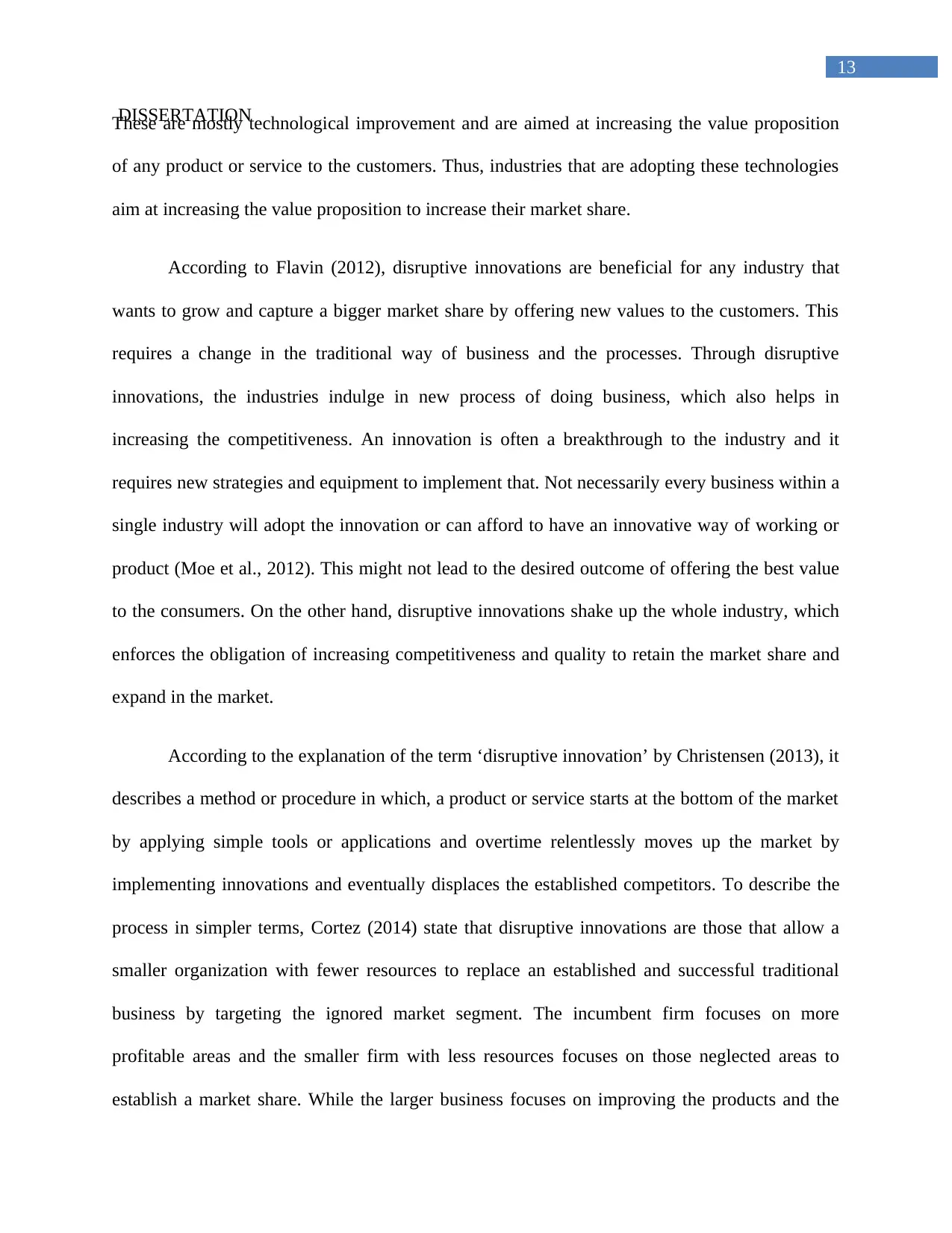
13
DISSERTATIONThese are mostly technological improvement and are aimed at increasing the value proposition
of any product or service to the customers. Thus, industries that are adopting these technologies
aim at increasing the value proposition to increase their market share.
According to Flavin (2012), disruptive innovations are beneficial for any industry that
wants to grow and capture a bigger market share by offering new values to the customers. This
requires a change in the traditional way of business and the processes. Through disruptive
innovations, the industries indulge in new process of doing business, which also helps in
increasing the competitiveness. An innovation is often a breakthrough to the industry and it
requires new strategies and equipment to implement that. Not necessarily every business within a
single industry will adopt the innovation or can afford to have an innovative way of working or
product (Moe et al., 2012). This might not lead to the desired outcome of offering the best value
to the consumers. On the other hand, disruptive innovations shake up the whole industry, which
enforces the obligation of increasing competitiveness and quality to retain the market share and
expand in the market.
According to the explanation of the term ‘disruptive innovation’ by Christensen (2013), it
describes a method or procedure in which, a product or service starts at the bottom of the market
by applying simple tools or applications and overtime relentlessly moves up the market by
implementing innovations and eventually displaces the established competitors. To describe the
process in simpler terms, Cortez (2014) state that disruptive innovations are those that allow a
smaller organization with fewer resources to replace an established and successful traditional
business by targeting the ignored market segment. The incumbent firm focuses on more
profitable areas and the smaller firm with less resources focuses on those neglected areas to
establish a market share. While the larger business focuses on improving the products and the
DISSERTATIONThese are mostly technological improvement and are aimed at increasing the value proposition
of any product or service to the customers. Thus, industries that are adopting these technologies
aim at increasing the value proposition to increase their market share.
According to Flavin (2012), disruptive innovations are beneficial for any industry that
wants to grow and capture a bigger market share by offering new values to the customers. This
requires a change in the traditional way of business and the processes. Through disruptive
innovations, the industries indulge in new process of doing business, which also helps in
increasing the competitiveness. An innovation is often a breakthrough to the industry and it
requires new strategies and equipment to implement that. Not necessarily every business within a
single industry will adopt the innovation or can afford to have an innovative way of working or
product (Moe et al., 2012). This might not lead to the desired outcome of offering the best value
to the consumers. On the other hand, disruptive innovations shake up the whole industry, which
enforces the obligation of increasing competitiveness and quality to retain the market share and
expand in the market.
According to the explanation of the term ‘disruptive innovation’ by Christensen (2013), it
describes a method or procedure in which, a product or service starts at the bottom of the market
by applying simple tools or applications and overtime relentlessly moves up the market by
implementing innovations and eventually displaces the established competitors. To describe the
process in simpler terms, Cortez (2014) state that disruptive innovations are those that allow a
smaller organization with fewer resources to replace an established and successful traditional
business by targeting the ignored market segment. The incumbent firm focuses on more
profitable areas and the smaller firm with less resources focuses on those neglected areas to
establish a market share. While the larger business focuses on improving the products and the
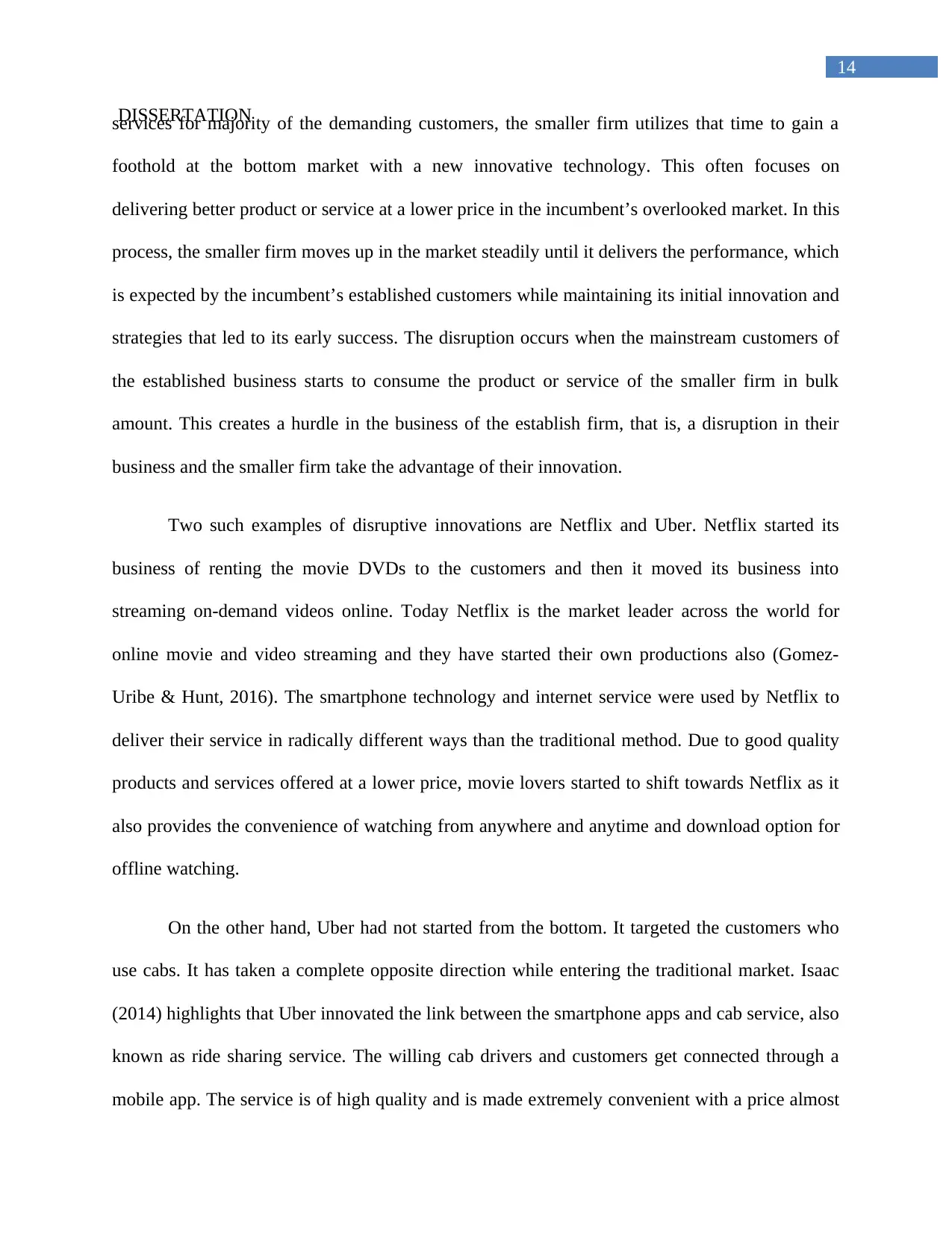
14
DISSERTATIONservices for majority of the demanding customers, the smaller firm utilizes that time to gain a
foothold at the bottom market with a new innovative technology. This often focuses on
delivering better product or service at a lower price in the incumbent’s overlooked market. In this
process, the smaller firm moves up in the market steadily until it delivers the performance, which
is expected by the incumbent’s established customers while maintaining its initial innovation and
strategies that led to its early success. The disruption occurs when the mainstream customers of
the established business starts to consume the product or service of the smaller firm in bulk
amount. This creates a hurdle in the business of the establish firm, that is, a disruption in their
business and the smaller firm take the advantage of their innovation.
Two such examples of disruptive innovations are Netflix and Uber. Netflix started its
business of renting the movie DVDs to the customers and then it moved its business into
streaming on-demand videos online. Today Netflix is the market leader across the world for
online movie and video streaming and they have started their own productions also (Gomez-
Uribe & Hunt, 2016). The smartphone technology and internet service were used by Netflix to
deliver their service in radically different ways than the traditional method. Due to good quality
products and services offered at a lower price, movie lovers started to shift towards Netflix as it
also provides the convenience of watching from anywhere and anytime and download option for
offline watching.
On the other hand, Uber had not started from the bottom. It targeted the customers who
use cabs. It has taken a complete opposite direction while entering the traditional market. Isaac
(2014) highlights that Uber innovated the link between the smartphone apps and cab service, also
known as ride sharing service. The willing cab drivers and customers get connected through a
mobile app. The service is of high quality and is made extremely convenient with a price almost
DISSERTATIONservices for majority of the demanding customers, the smaller firm utilizes that time to gain a
foothold at the bottom market with a new innovative technology. This often focuses on
delivering better product or service at a lower price in the incumbent’s overlooked market. In this
process, the smaller firm moves up in the market steadily until it delivers the performance, which
is expected by the incumbent’s established customers while maintaining its initial innovation and
strategies that led to its early success. The disruption occurs when the mainstream customers of
the established business starts to consume the product or service of the smaller firm in bulk
amount. This creates a hurdle in the business of the establish firm, that is, a disruption in their
business and the smaller firm take the advantage of their innovation.
Two such examples of disruptive innovations are Netflix and Uber. Netflix started its
business of renting the movie DVDs to the customers and then it moved its business into
streaming on-demand videos online. Today Netflix is the market leader across the world for
online movie and video streaming and they have started their own productions also (Gomez-
Uribe & Hunt, 2016). The smartphone technology and internet service were used by Netflix to
deliver their service in radically different ways than the traditional method. Due to good quality
products and services offered at a lower price, movie lovers started to shift towards Netflix as it
also provides the convenience of watching from anywhere and anytime and download option for
offline watching.
On the other hand, Uber had not started from the bottom. It targeted the customers who
use cabs. It has taken a complete opposite direction while entering the traditional market. Isaac
(2014) highlights that Uber innovated the link between the smartphone apps and cab service, also
known as ride sharing service. The willing cab drivers and customers get connected through a
mobile app. The service is of high quality and is made extremely convenient with a price almost
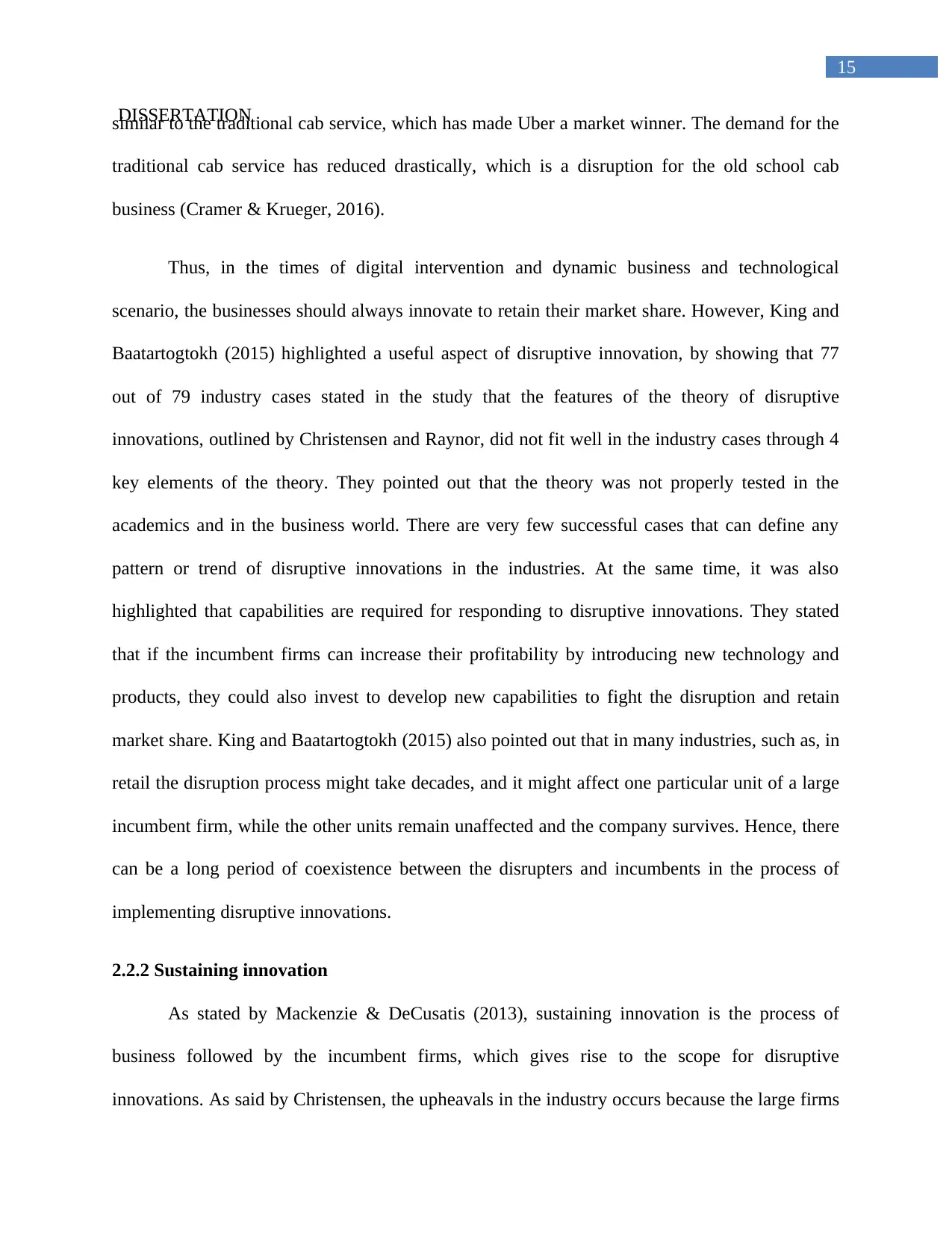
15
DISSERTATIONsimilar to the traditional cab service, which has made Uber a market winner. The demand for the
traditional cab service has reduced drastically, which is a disruption for the old school cab
business (Cramer & Krueger, 2016).
Thus, in the times of digital intervention and dynamic business and technological
scenario, the businesses should always innovate to retain their market share. However, King and
Baatartogtokh (2015) highlighted a useful aspect of disruptive innovation, by showing that 77
out of 79 industry cases stated in the study that the features of the theory of disruptive
innovations, outlined by Christensen and Raynor, did not fit well in the industry cases through 4
key elements of the theory. They pointed out that the theory was not properly tested in the
academics and in the business world. There are very few successful cases that can define any
pattern or trend of disruptive innovations in the industries. At the same time, it was also
highlighted that capabilities are required for responding to disruptive innovations. They stated
that if the incumbent firms can increase their profitability by introducing new technology and
products, they could also invest to develop new capabilities to fight the disruption and retain
market share. King and Baatartogtokh (2015) also pointed out that in many industries, such as, in
retail the disruption process might take decades, and it might affect one particular unit of a large
incumbent firm, while the other units remain unaffected and the company survives. Hence, there
can be a long period of coexistence between the disrupters and incumbents in the process of
implementing disruptive innovations.
2.2.2 Sustaining innovation
As stated by Mackenzie & DeCusatis (2013), sustaining innovation is the process of
business followed by the incumbent firms, which gives rise to the scope for disruptive
innovations. As said by Christensen, the upheavals in the industry occurs because the large firms
DISSERTATIONsimilar to the traditional cab service, which has made Uber a market winner. The demand for the
traditional cab service has reduced drastically, which is a disruption for the old school cab
business (Cramer & Krueger, 2016).
Thus, in the times of digital intervention and dynamic business and technological
scenario, the businesses should always innovate to retain their market share. However, King and
Baatartogtokh (2015) highlighted a useful aspect of disruptive innovation, by showing that 77
out of 79 industry cases stated in the study that the features of the theory of disruptive
innovations, outlined by Christensen and Raynor, did not fit well in the industry cases through 4
key elements of the theory. They pointed out that the theory was not properly tested in the
academics and in the business world. There are very few successful cases that can define any
pattern or trend of disruptive innovations in the industries. At the same time, it was also
highlighted that capabilities are required for responding to disruptive innovations. They stated
that if the incumbent firms can increase their profitability by introducing new technology and
products, they could also invest to develop new capabilities to fight the disruption and retain
market share. King and Baatartogtokh (2015) also pointed out that in many industries, such as, in
retail the disruption process might take decades, and it might affect one particular unit of a large
incumbent firm, while the other units remain unaffected and the company survives. Hence, there
can be a long period of coexistence between the disrupters and incumbents in the process of
implementing disruptive innovations.
2.2.2 Sustaining innovation
As stated by Mackenzie & DeCusatis (2013), sustaining innovation is the process of
business followed by the incumbent firms, which gives rise to the scope for disruptive
innovations. As said by Christensen, the upheavals in the industry occurs because the large firms
Secure Best Marks with AI Grader
Need help grading? Try our AI Grader for instant feedback on your assignments.

16
DISSERTATIONfocus on innovating for making their good products or services better for their existing
consumers and not for targeting a new market. Sustaining innovation refers to an incremental
innovation, which sustains an existing product or service. This is different from disruptive
innovation. In the disruptive innovation, the innovators create new market and new value
network and disrupt the traditional business of the existing established firms and eventually
replace earlier technology, while in the sustaining innovation, the firms improve their existing
product or services to more value creation. One of the classic examples of sustaining innovation
is the improvisation of Macintosh by Apple. The Macintosh went through various innovations
but it had a drab and unattractive look compared to the rival products of IBM. The company
almost filed for bankruptcy. In 1998, Steve Jobs consolidated all the features and functionalities
of all models of Macintosh into iMac G3, which not only led to success but also revitalized the
brand across existing and new market (Wonglimpiyarat, 2012).
Downes & Nunes (2013) highlighted that companies must innovate faster than the
evolution of the needs of the customers. In this process, the firms end up producing many
products or services that might be too sophisticated or expensive or complicated for the mass.
Thus, the sustaining innovations are pursued by the firms at the top tiers of their existing market
as they could charge higher prices from the sophisticated and most demanding consumers and
increase profitability. In this process, these companies make way for disrupters at the bottom end
of the market. A disruptive innovation allows a huge population of consumers at the bottom of
the market to avail the product or service that was accessible only to the top tier of the market.
Sustaining and disruptive innovations often creates a challenging situation for a firm
when they face ‘innovator’s dilemma’. This refers to the situation when a firm faces the dilemma
of whether to improvise the existing product or service and hold onto the existing or slightly
DISSERTATIONfocus on innovating for making their good products or services better for their existing
consumers and not for targeting a new market. Sustaining innovation refers to an incremental
innovation, which sustains an existing product or service. This is different from disruptive
innovation. In the disruptive innovation, the innovators create new market and new value
network and disrupt the traditional business of the existing established firms and eventually
replace earlier technology, while in the sustaining innovation, the firms improve their existing
product or services to more value creation. One of the classic examples of sustaining innovation
is the improvisation of Macintosh by Apple. The Macintosh went through various innovations
but it had a drab and unattractive look compared to the rival products of IBM. The company
almost filed for bankruptcy. In 1998, Steve Jobs consolidated all the features and functionalities
of all models of Macintosh into iMac G3, which not only led to success but also revitalized the
brand across existing and new market (Wonglimpiyarat, 2012).
Downes & Nunes (2013) highlighted that companies must innovate faster than the
evolution of the needs of the customers. In this process, the firms end up producing many
products or services that might be too sophisticated or expensive or complicated for the mass.
Thus, the sustaining innovations are pursued by the firms at the top tiers of their existing market
as they could charge higher prices from the sophisticated and most demanding consumers and
increase profitability. In this process, these companies make way for disrupters at the bottom end
of the market. A disruptive innovation allows a huge population of consumers at the bottom of
the market to avail the product or service that was accessible only to the top tier of the market.
Sustaining and disruptive innovations often creates a challenging situation for a firm
when they face ‘innovator’s dilemma’. This refers to the situation when a firm faces the dilemma
of whether to improvise the existing product or service and hold onto the existing or slightly
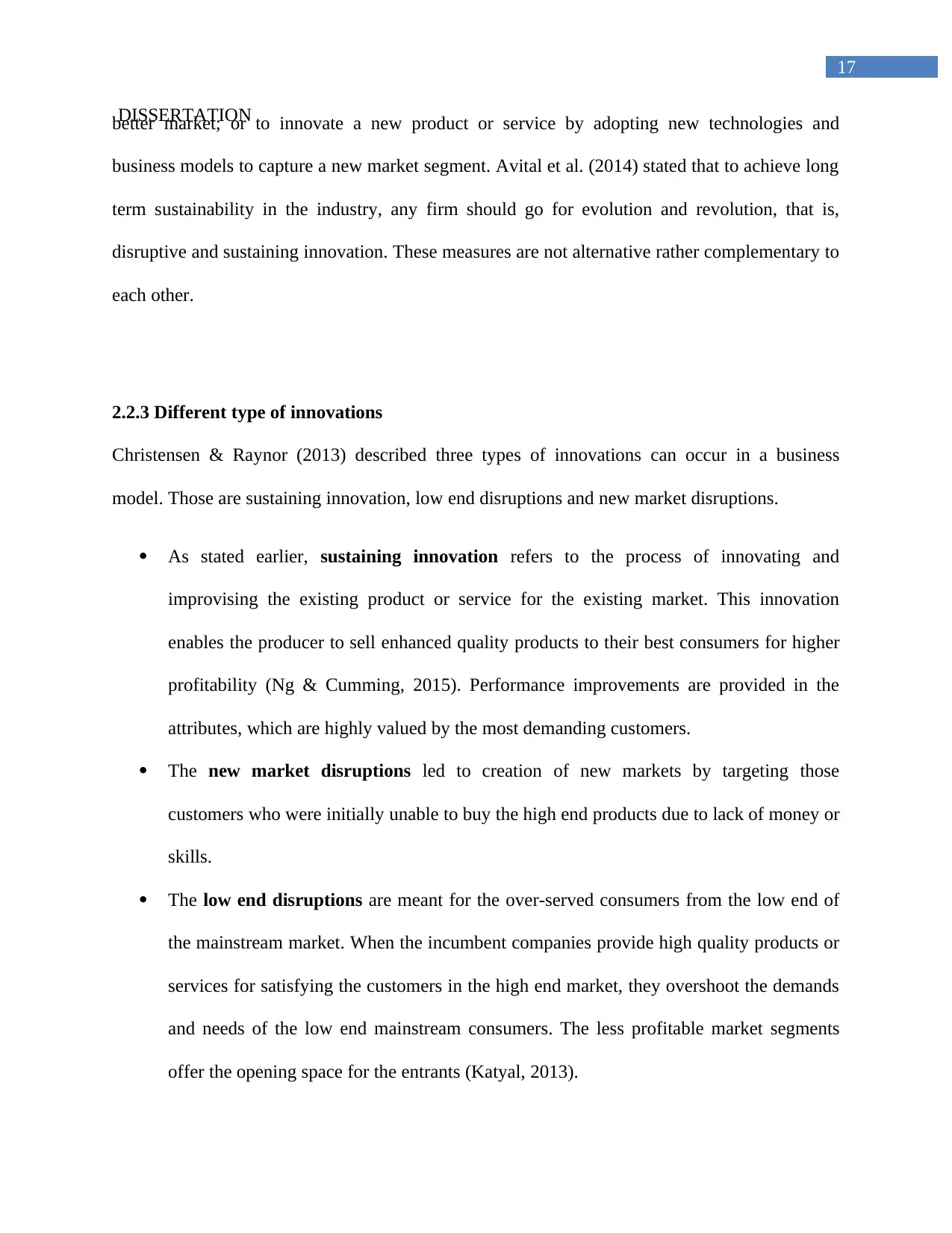
17
DISSERTATIONbetter market; or to innovate a new product or service by adopting new technologies and
business models to capture a new market segment. Avital et al. (2014) stated that to achieve long
term sustainability in the industry, any firm should go for evolution and revolution, that is,
disruptive and sustaining innovation. These measures are not alternative rather complementary to
each other.
2.2.3 Different type of innovations
Christensen & Raynor (2013) described three types of innovations can occur in a business
model. Those are sustaining innovation, low end disruptions and new market disruptions.
As stated earlier, sustaining innovation refers to the process of innovating and
improvising the existing product or service for the existing market. This innovation
enables the producer to sell enhanced quality products to their best consumers for higher
profitability (Ng & Cumming, 2015). Performance improvements are provided in the
attributes, which are highly valued by the most demanding customers.
The new market disruptions led to creation of new markets by targeting those
customers who were initially unable to buy the high end products due to lack of money or
skills.
The low end disruptions are meant for the over-served consumers from the low end of
the mainstream market. When the incumbent companies provide high quality products or
services for satisfying the customers in the high end market, they overshoot the demands
and needs of the low end mainstream consumers. The less profitable market segments
offer the opening space for the entrants (Katyal, 2013).
DISSERTATIONbetter market; or to innovate a new product or service by adopting new technologies and
business models to capture a new market segment. Avital et al. (2014) stated that to achieve long
term sustainability in the industry, any firm should go for evolution and revolution, that is,
disruptive and sustaining innovation. These measures are not alternative rather complementary to
each other.
2.2.3 Different type of innovations
Christensen & Raynor (2013) described three types of innovations can occur in a business
model. Those are sustaining innovation, low end disruptions and new market disruptions.
As stated earlier, sustaining innovation refers to the process of innovating and
improvising the existing product or service for the existing market. This innovation
enables the producer to sell enhanced quality products to their best consumers for higher
profitability (Ng & Cumming, 2015). Performance improvements are provided in the
attributes, which are highly valued by the most demanding customers.
The new market disruptions led to creation of new markets by targeting those
customers who were initially unable to buy the high end products due to lack of money or
skills.
The low end disruptions are meant for the over-served consumers from the low end of
the mainstream market. When the incumbent companies provide high quality products or
services for satisfying the customers in the high end market, they overshoot the demands
and needs of the low end mainstream consumers. The less profitable market segments
offer the opening space for the entrants (Katyal, 2013).
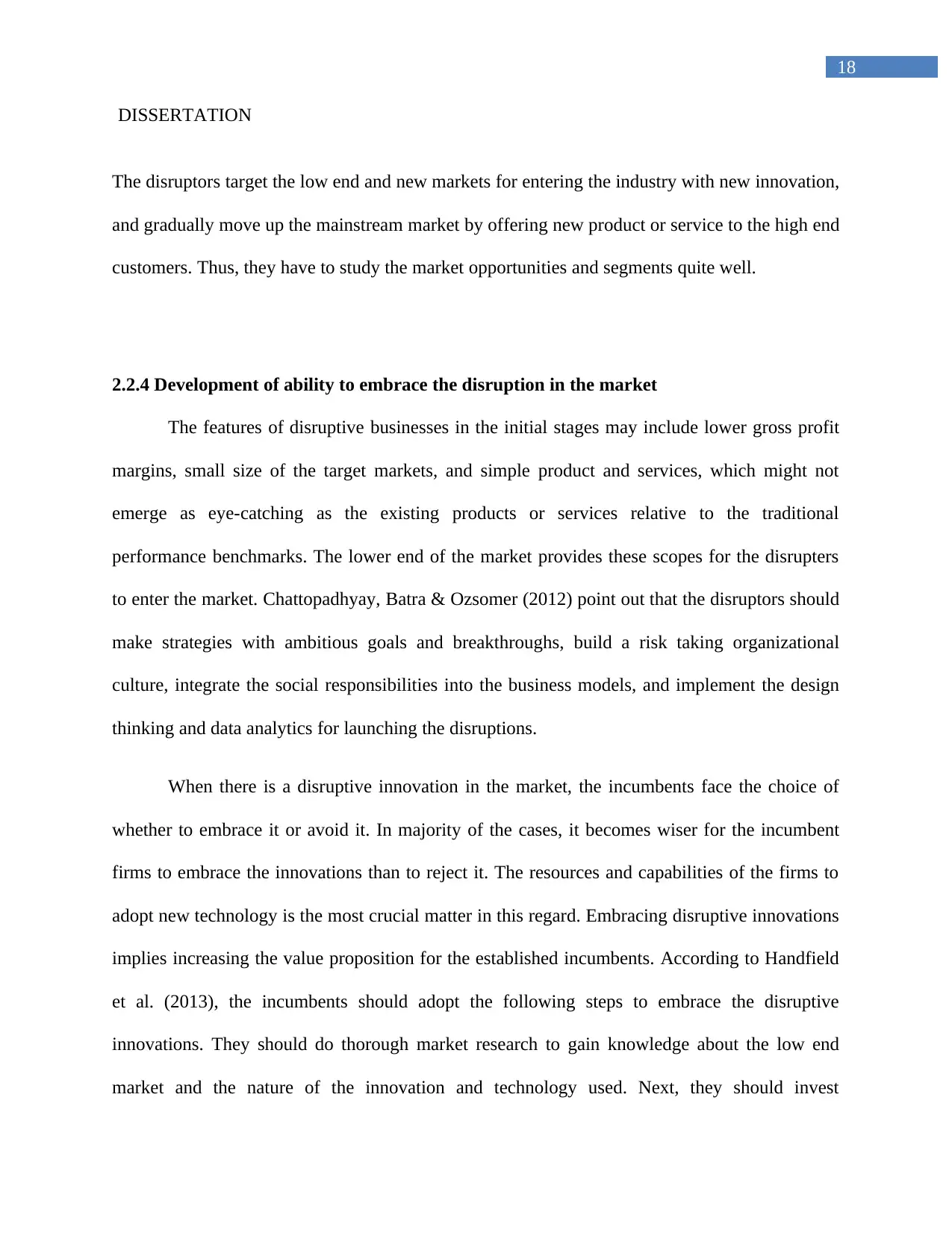
18
DISSERTATION
The disruptors target the low end and new markets for entering the industry with new innovation,
and gradually move up the mainstream market by offering new product or service to the high end
customers. Thus, they have to study the market opportunities and segments quite well.
2.2.4 Development of ability to embrace the disruption in the market
The features of disruptive businesses in the initial stages may include lower gross profit
margins, small size of the target markets, and simple product and services, which might not
emerge as eye-catching as the existing products or services relative to the traditional
performance benchmarks. The lower end of the market provides these scopes for the disrupters
to enter the market. Chattopadhyay, Batra & Ozsomer (2012) point out that the disruptors should
make strategies with ambitious goals and breakthroughs, build a risk taking organizational
culture, integrate the social responsibilities into the business models, and implement the design
thinking and data analytics for launching the disruptions.
When there is a disruptive innovation in the market, the incumbents face the choice of
whether to embrace it or avoid it. In majority of the cases, it becomes wiser for the incumbent
firms to embrace the innovations than to reject it. The resources and capabilities of the firms to
adopt new technology is the most crucial matter in this regard. Embracing disruptive innovations
implies increasing the value proposition for the established incumbents. According to Handfield
et al. (2013), the incumbents should adopt the following steps to embrace the disruptive
innovations. They should do thorough market research to gain knowledge about the low end
market and the nature of the innovation and technology used. Next, they should invest
DISSERTATION
The disruptors target the low end and new markets for entering the industry with new innovation,
and gradually move up the mainstream market by offering new product or service to the high end
customers. Thus, they have to study the market opportunities and segments quite well.
2.2.4 Development of ability to embrace the disruption in the market
The features of disruptive businesses in the initial stages may include lower gross profit
margins, small size of the target markets, and simple product and services, which might not
emerge as eye-catching as the existing products or services relative to the traditional
performance benchmarks. The lower end of the market provides these scopes for the disrupters
to enter the market. Chattopadhyay, Batra & Ozsomer (2012) point out that the disruptors should
make strategies with ambitious goals and breakthroughs, build a risk taking organizational
culture, integrate the social responsibilities into the business models, and implement the design
thinking and data analytics for launching the disruptions.
When there is a disruptive innovation in the market, the incumbents face the choice of
whether to embrace it or avoid it. In majority of the cases, it becomes wiser for the incumbent
firms to embrace the innovations than to reject it. The resources and capabilities of the firms to
adopt new technology is the most crucial matter in this regard. Embracing disruptive innovations
implies increasing the value proposition for the established incumbents. According to Handfield
et al. (2013), the incumbents should adopt the following steps to embrace the disruptive
innovations. They should do thorough market research to gain knowledge about the low end
market and the nature of the innovation and technology used. Next, they should invest
Paraphrase This Document
Need a fresh take? Get an instant paraphrase of this document with our AI Paraphraser
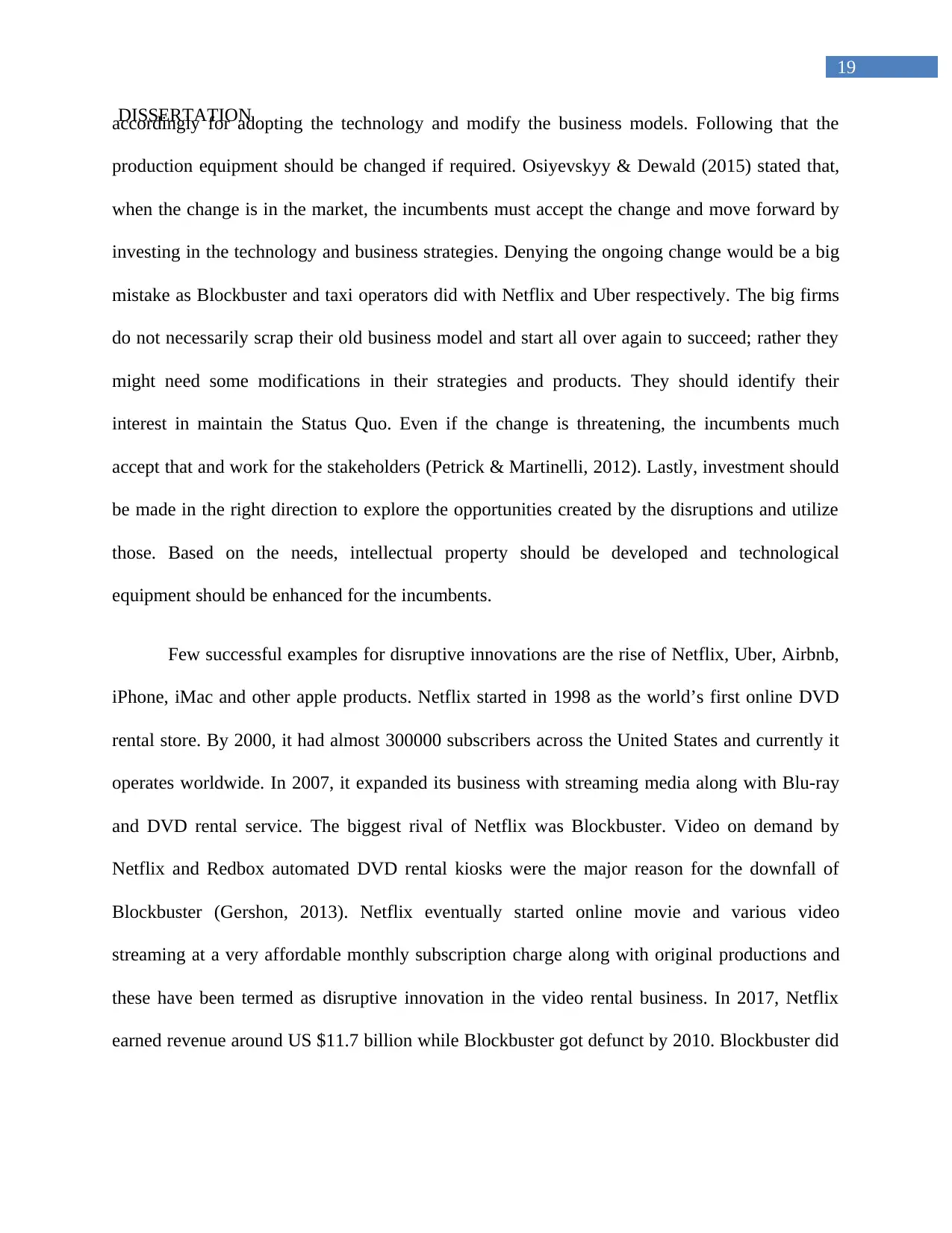
19
DISSERTATIONaccordingly for adopting the technology and modify the business models. Following that the
production equipment should be changed if required. Osiyevskyy & Dewald (2015) stated that,
when the change is in the market, the incumbents must accept the change and move forward by
investing in the technology and business strategies. Denying the ongoing change would be a big
mistake as Blockbuster and taxi operators did with Netflix and Uber respectively. The big firms
do not necessarily scrap their old business model and start all over again to succeed; rather they
might need some modifications in their strategies and products. They should identify their
interest in maintain the Status Quo. Even if the change is threatening, the incumbents much
accept that and work for the stakeholders (Petrick & Martinelli, 2012). Lastly, investment should
be made in the right direction to explore the opportunities created by the disruptions and utilize
those. Based on the needs, intellectual property should be developed and technological
equipment should be enhanced for the incumbents.
Few successful examples for disruptive innovations are the rise of Netflix, Uber, Airbnb,
iPhone, iMac and other apple products. Netflix started in 1998 as the world’s first online DVD
rental store. By 2000, it had almost 300000 subscribers across the United States and currently it
operates worldwide. In 2007, it expanded its business with streaming media along with Blu-ray
and DVD rental service. The biggest rival of Netflix was Blockbuster. Video on demand by
Netflix and Redbox automated DVD rental kiosks were the major reason for the downfall of
Blockbuster (Gershon, 2013). Netflix eventually started online movie and various video
streaming at a very affordable monthly subscription charge along with original productions and
these have been termed as disruptive innovation in the video rental business. In 2017, Netflix
earned revenue around US $11.7 billion while Blockbuster got defunct by 2010. Blockbuster did
DISSERTATIONaccordingly for adopting the technology and modify the business models. Following that the
production equipment should be changed if required. Osiyevskyy & Dewald (2015) stated that,
when the change is in the market, the incumbents must accept the change and move forward by
investing in the technology and business strategies. Denying the ongoing change would be a big
mistake as Blockbuster and taxi operators did with Netflix and Uber respectively. The big firms
do not necessarily scrap their old business model and start all over again to succeed; rather they
might need some modifications in their strategies and products. They should identify their
interest in maintain the Status Quo. Even if the change is threatening, the incumbents much
accept that and work for the stakeholders (Petrick & Martinelli, 2012). Lastly, investment should
be made in the right direction to explore the opportunities created by the disruptions and utilize
those. Based on the needs, intellectual property should be developed and technological
equipment should be enhanced for the incumbents.
Few successful examples for disruptive innovations are the rise of Netflix, Uber, Airbnb,
iPhone, iMac and other apple products. Netflix started in 1998 as the world’s first online DVD
rental store. By 2000, it had almost 300000 subscribers across the United States and currently it
operates worldwide. In 2007, it expanded its business with streaming media along with Blu-ray
and DVD rental service. The biggest rival of Netflix was Blockbuster. Video on demand by
Netflix and Redbox automated DVD rental kiosks were the major reason for the downfall of
Blockbuster (Gershon, 2013). Netflix eventually started online movie and various video
streaming at a very affordable monthly subscription charge along with original productions and
these have been termed as disruptive innovation in the video rental business. In 2017, Netflix
earned revenue around US $11.7 billion while Blockbuster got defunct by 2010. Blockbuster did
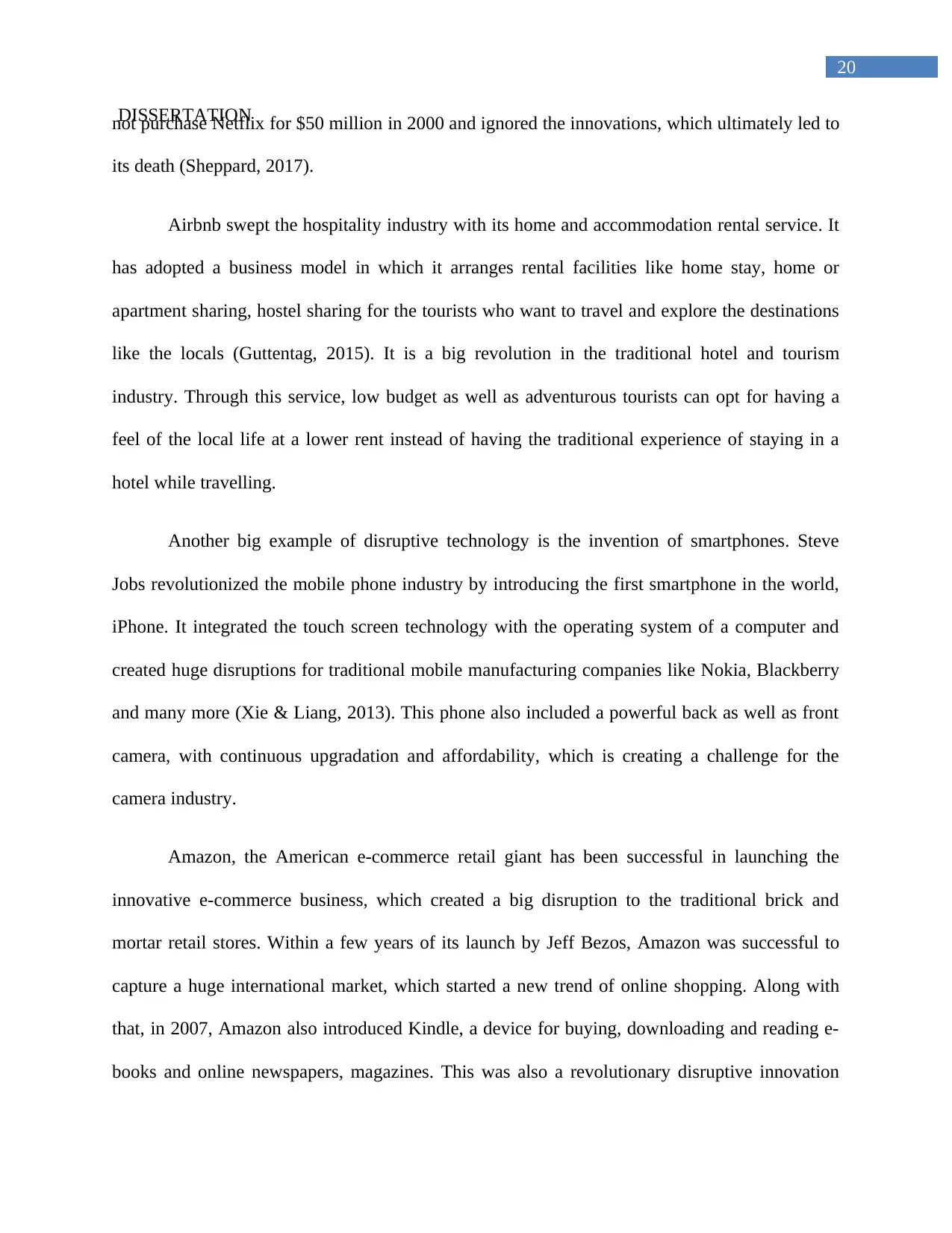
20
DISSERTATIONnot purchase Netflix for $50 million in 2000 and ignored the innovations, which ultimately led to
its death (Sheppard, 2017).
Airbnb swept the hospitality industry with its home and accommodation rental service. It
has adopted a business model in which it arranges rental facilities like home stay, home or
apartment sharing, hostel sharing for the tourists who want to travel and explore the destinations
like the locals (Guttentag, 2015). It is a big revolution in the traditional hotel and tourism
industry. Through this service, low budget as well as adventurous tourists can opt for having a
feel of the local life at a lower rent instead of having the traditional experience of staying in a
hotel while travelling.
Another big example of disruptive technology is the invention of smartphones. Steve
Jobs revolutionized the mobile phone industry by introducing the first smartphone in the world,
iPhone. It integrated the touch screen technology with the operating system of a computer and
created huge disruptions for traditional mobile manufacturing companies like Nokia, Blackberry
and many more (Xie & Liang, 2013). This phone also included a powerful back as well as front
camera, with continuous upgradation and affordability, which is creating a challenge for the
camera industry.
Amazon, the American e-commerce retail giant has been successful in launching the
innovative e-commerce business, which created a big disruption to the traditional brick and
mortar retail stores. Within a few years of its launch by Jeff Bezos, Amazon was successful to
capture a huge international market, which started a new trend of online shopping. Along with
that, in 2007, Amazon also introduced Kindle, a device for buying, downloading and reading e-
books and online newspapers, magazines. This was also a revolutionary disruptive innovation
DISSERTATIONnot purchase Netflix for $50 million in 2000 and ignored the innovations, which ultimately led to
its death (Sheppard, 2017).
Airbnb swept the hospitality industry with its home and accommodation rental service. It
has adopted a business model in which it arranges rental facilities like home stay, home or
apartment sharing, hostel sharing for the tourists who want to travel and explore the destinations
like the locals (Guttentag, 2015). It is a big revolution in the traditional hotel and tourism
industry. Through this service, low budget as well as adventurous tourists can opt for having a
feel of the local life at a lower rent instead of having the traditional experience of staying in a
hotel while travelling.
Another big example of disruptive technology is the invention of smartphones. Steve
Jobs revolutionized the mobile phone industry by introducing the first smartphone in the world,
iPhone. It integrated the touch screen technology with the operating system of a computer and
created huge disruptions for traditional mobile manufacturing companies like Nokia, Blackberry
and many more (Xie & Liang, 2013). This phone also included a powerful back as well as front
camera, with continuous upgradation and affordability, which is creating a challenge for the
camera industry.
Amazon, the American e-commerce retail giant has been successful in launching the
innovative e-commerce business, which created a big disruption to the traditional brick and
mortar retail stores. Within a few years of its launch by Jeff Bezos, Amazon was successful to
capture a huge international market, which started a new trend of online shopping. Along with
that, in 2007, Amazon also introduced Kindle, a device for buying, downloading and reading e-
books and online newspapers, magazines. This was also a revolutionary disruptive innovation
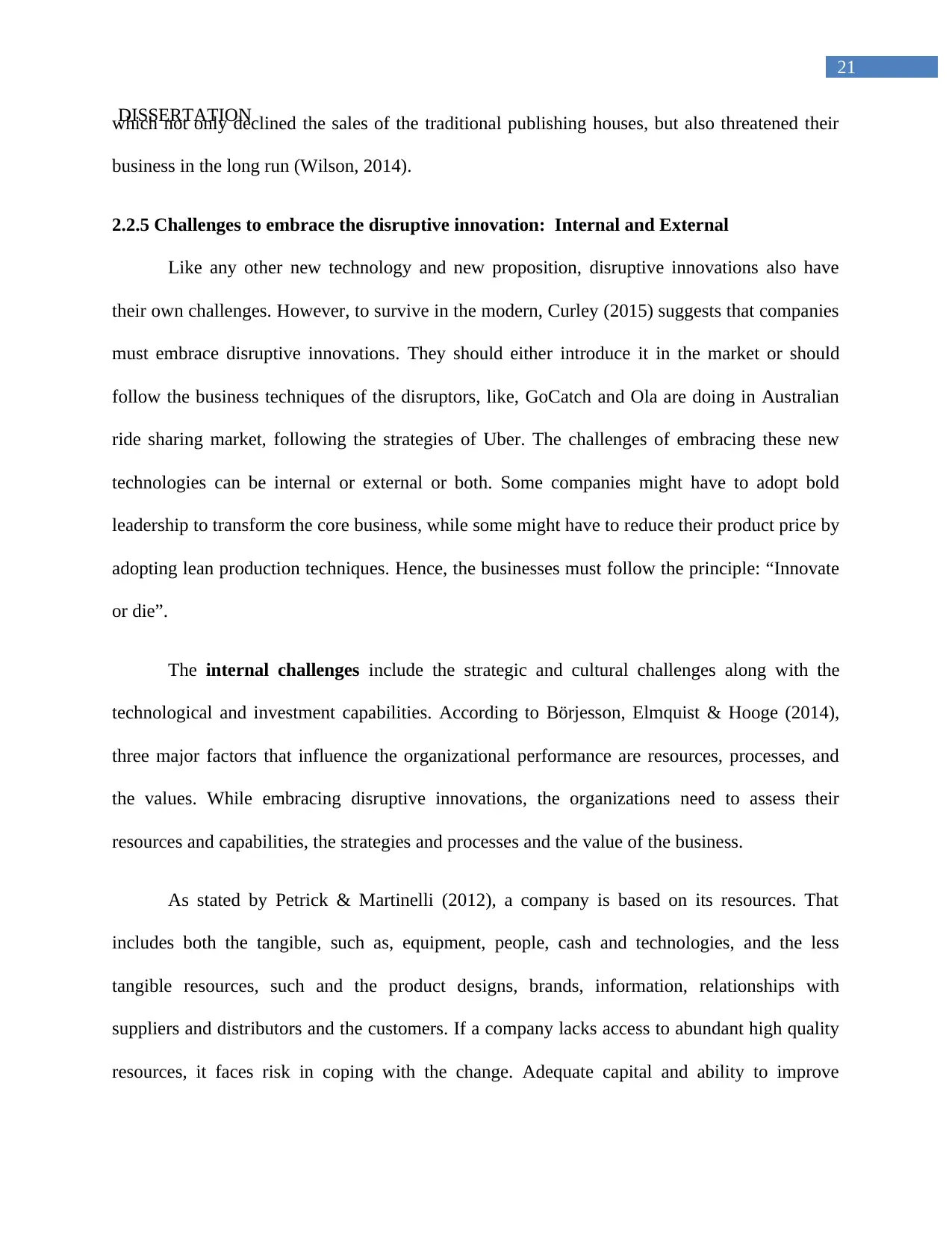
21
DISSERTATIONwhich not only declined the sales of the traditional publishing houses, but also threatened their
business in the long run (Wilson, 2014).
2.2.5 Challenges to embrace the disruptive innovation: Internal and External
Like any other new technology and new proposition, disruptive innovations also have
their own challenges. However, to survive in the modern, Curley (2015) suggests that companies
must embrace disruptive innovations. They should either introduce it in the market or should
follow the business techniques of the disruptors, like, GoCatch and Ola are doing in Australian
ride sharing market, following the strategies of Uber. The challenges of embracing these new
technologies can be internal or external or both. Some companies might have to adopt bold
leadership to transform the core business, while some might have to reduce their product price by
adopting lean production techniques. Hence, the businesses must follow the principle: “Innovate
or die”.
The internal challenges include the strategic and cultural challenges along with the
technological and investment capabilities. According to Börjesson, Elmquist & Hooge (2014),
three major factors that influence the organizational performance are resources, processes, and
the values. While embracing disruptive innovations, the organizations need to assess their
resources and capabilities, the strategies and processes and the value of the business.
As stated by Petrick & Martinelli (2012), a company is based on its resources. That
includes both the tangible, such as, equipment, people, cash and technologies, and the less
tangible resources, such and the product designs, brands, information, relationships with
suppliers and distributors and the customers. If a company lacks access to abundant high quality
resources, it faces risk in coping with the change. Adequate capital and ability to improve
DISSERTATIONwhich not only declined the sales of the traditional publishing houses, but also threatened their
business in the long run (Wilson, 2014).
2.2.5 Challenges to embrace the disruptive innovation: Internal and External
Like any other new technology and new proposition, disruptive innovations also have
their own challenges. However, to survive in the modern, Curley (2015) suggests that companies
must embrace disruptive innovations. They should either introduce it in the market or should
follow the business techniques of the disruptors, like, GoCatch and Ola are doing in Australian
ride sharing market, following the strategies of Uber. The challenges of embracing these new
technologies can be internal or external or both. Some companies might have to adopt bold
leadership to transform the core business, while some might have to reduce their product price by
adopting lean production techniques. Hence, the businesses must follow the principle: “Innovate
or die”.
The internal challenges include the strategic and cultural challenges along with the
technological and investment capabilities. According to Börjesson, Elmquist & Hooge (2014),
three major factors that influence the organizational performance are resources, processes, and
the values. While embracing disruptive innovations, the organizations need to assess their
resources and capabilities, the strategies and processes and the value of the business.
As stated by Petrick & Martinelli (2012), a company is based on its resources. That
includes both the tangible, such as, equipment, people, cash and technologies, and the less
tangible resources, such and the product designs, brands, information, relationships with
suppliers and distributors and the customers. If a company lacks access to abundant high quality
resources, it faces risk in coping with the change. Adequate capital and ability to improve
Secure Best Marks with AI Grader
Need help grading? Try our AI Grader for instant feedback on your assignments.
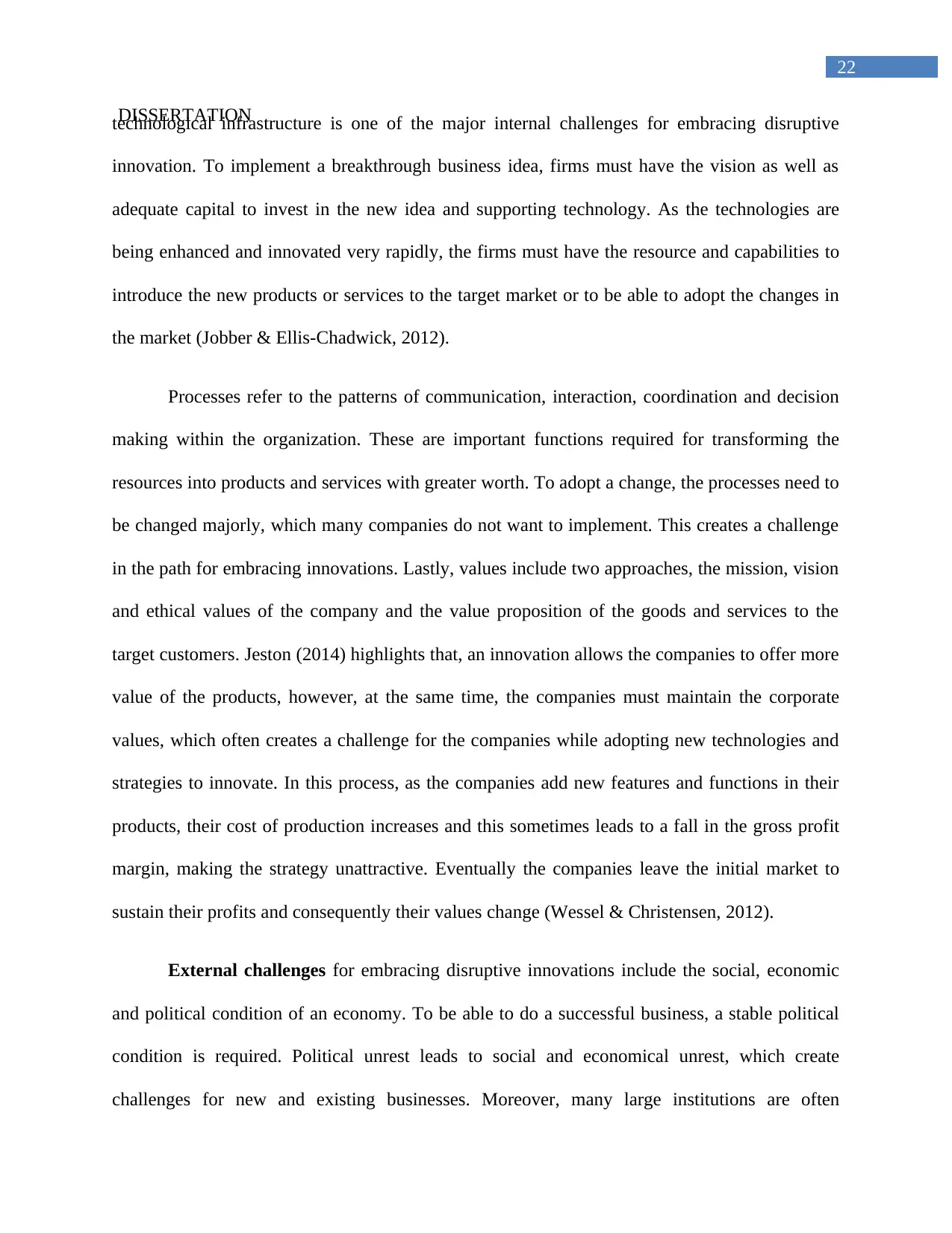
22
DISSERTATIONtechnological infrastructure is one of the major internal challenges for embracing disruptive
innovation. To implement a breakthrough business idea, firms must have the vision as well as
adequate capital to invest in the new idea and supporting technology. As the technologies are
being enhanced and innovated very rapidly, the firms must have the resource and capabilities to
introduce the new products or services to the target market or to be able to adopt the changes in
the market (Jobber & Ellis-Chadwick, 2012).
Processes refer to the patterns of communication, interaction, coordination and decision
making within the organization. These are important functions required for transforming the
resources into products and services with greater worth. To adopt a change, the processes need to
be changed majorly, which many companies do not want to implement. This creates a challenge
in the path for embracing innovations. Lastly, values include two approaches, the mission, vision
and ethical values of the company and the value proposition of the goods and services to the
target customers. Jeston (2014) highlights that, an innovation allows the companies to offer more
value of the products, however, at the same time, the companies must maintain the corporate
values, which often creates a challenge for the companies while adopting new technologies and
strategies to innovate. In this process, as the companies add new features and functions in their
products, their cost of production increases and this sometimes leads to a fall in the gross profit
margin, making the strategy unattractive. Eventually the companies leave the initial market to
sustain their profits and consequently their values change (Wessel & Christensen, 2012).
External challenges for embracing disruptive innovations include the social, economic
and political condition of an economy. To be able to do a successful business, a stable political
condition is required. Political unrest leads to social and economical unrest, which create
challenges for new and existing businesses. Moreover, many large institutions are often
DISSERTATIONtechnological infrastructure is one of the major internal challenges for embracing disruptive
innovation. To implement a breakthrough business idea, firms must have the vision as well as
adequate capital to invest in the new idea and supporting technology. As the technologies are
being enhanced and innovated very rapidly, the firms must have the resource and capabilities to
introduce the new products or services to the target market or to be able to adopt the changes in
the market (Jobber & Ellis-Chadwick, 2012).
Processes refer to the patterns of communication, interaction, coordination and decision
making within the organization. These are important functions required for transforming the
resources into products and services with greater worth. To adopt a change, the processes need to
be changed majorly, which many companies do not want to implement. This creates a challenge
in the path for embracing innovations. Lastly, values include two approaches, the mission, vision
and ethical values of the company and the value proposition of the goods and services to the
target customers. Jeston (2014) highlights that, an innovation allows the companies to offer more
value of the products, however, at the same time, the companies must maintain the corporate
values, which often creates a challenge for the companies while adopting new technologies and
strategies to innovate. In this process, as the companies add new features and functions in their
products, their cost of production increases and this sometimes leads to a fall in the gross profit
margin, making the strategy unattractive. Eventually the companies leave the initial market to
sustain their profits and consequently their values change (Wessel & Christensen, 2012).
External challenges for embracing disruptive innovations include the social, economic
and political condition of an economy. To be able to do a successful business, a stable political
condition is required. Political unrest leads to social and economical unrest, which create
challenges for new and existing businesses. Moreover, many large institutions are often
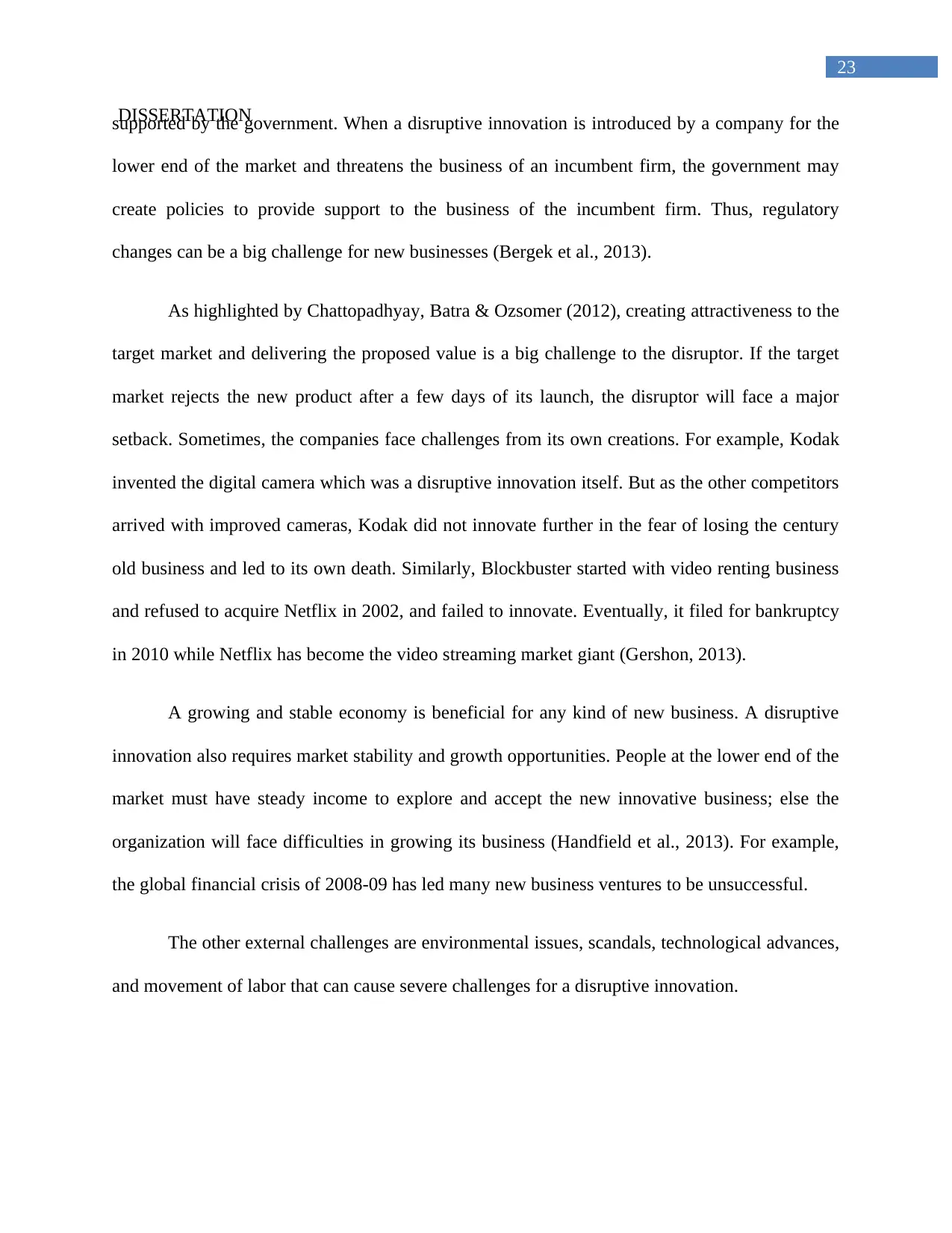
23
DISSERTATIONsupported by the government. When a disruptive innovation is introduced by a company for the
lower end of the market and threatens the business of an incumbent firm, the government may
create policies to provide support to the business of the incumbent firm. Thus, regulatory
changes can be a big challenge for new businesses (Bergek et al., 2013).
As highlighted by Chattopadhyay, Batra & Ozsomer (2012), creating attractiveness to the
target market and delivering the proposed value is a big challenge to the disruptor. If the target
market rejects the new product after a few days of its launch, the disruptor will face a major
setback. Sometimes, the companies face challenges from its own creations. For example, Kodak
invented the digital camera which was a disruptive innovation itself. But as the other competitors
arrived with improved cameras, Kodak did not innovate further in the fear of losing the century
old business and led to its own death. Similarly, Blockbuster started with video renting business
and refused to acquire Netflix in 2002, and failed to innovate. Eventually, it filed for bankruptcy
in 2010 while Netflix has become the video streaming market giant (Gershon, 2013).
A growing and stable economy is beneficial for any kind of new business. A disruptive
innovation also requires market stability and growth opportunities. People at the lower end of the
market must have steady income to explore and accept the new innovative business; else the
organization will face difficulties in growing its business (Handfield et al., 2013). For example,
the global financial crisis of 2008-09 has led many new business ventures to be unsuccessful.
The other external challenges are environmental issues, scandals, technological advances,
and movement of labor that can cause severe challenges for a disruptive innovation.
DISSERTATIONsupported by the government. When a disruptive innovation is introduced by a company for the
lower end of the market and threatens the business of an incumbent firm, the government may
create policies to provide support to the business of the incumbent firm. Thus, regulatory
changes can be a big challenge for new businesses (Bergek et al., 2013).
As highlighted by Chattopadhyay, Batra & Ozsomer (2012), creating attractiveness to the
target market and delivering the proposed value is a big challenge to the disruptor. If the target
market rejects the new product after a few days of its launch, the disruptor will face a major
setback. Sometimes, the companies face challenges from its own creations. For example, Kodak
invented the digital camera which was a disruptive innovation itself. But as the other competitors
arrived with improved cameras, Kodak did not innovate further in the fear of losing the century
old business and led to its own death. Similarly, Blockbuster started with video renting business
and refused to acquire Netflix in 2002, and failed to innovate. Eventually, it filed for bankruptcy
in 2010 while Netflix has become the video streaming market giant (Gershon, 2013).
A growing and stable economy is beneficial for any kind of new business. A disruptive
innovation also requires market stability and growth opportunities. People at the lower end of the
market must have steady income to explore and accept the new innovative business; else the
organization will face difficulties in growing its business (Handfield et al., 2013). For example,
the global financial crisis of 2008-09 has led many new business ventures to be unsuccessful.
The other external challenges are environmental issues, scandals, technological advances,
and movement of labor that can cause severe challenges for a disruptive innovation.
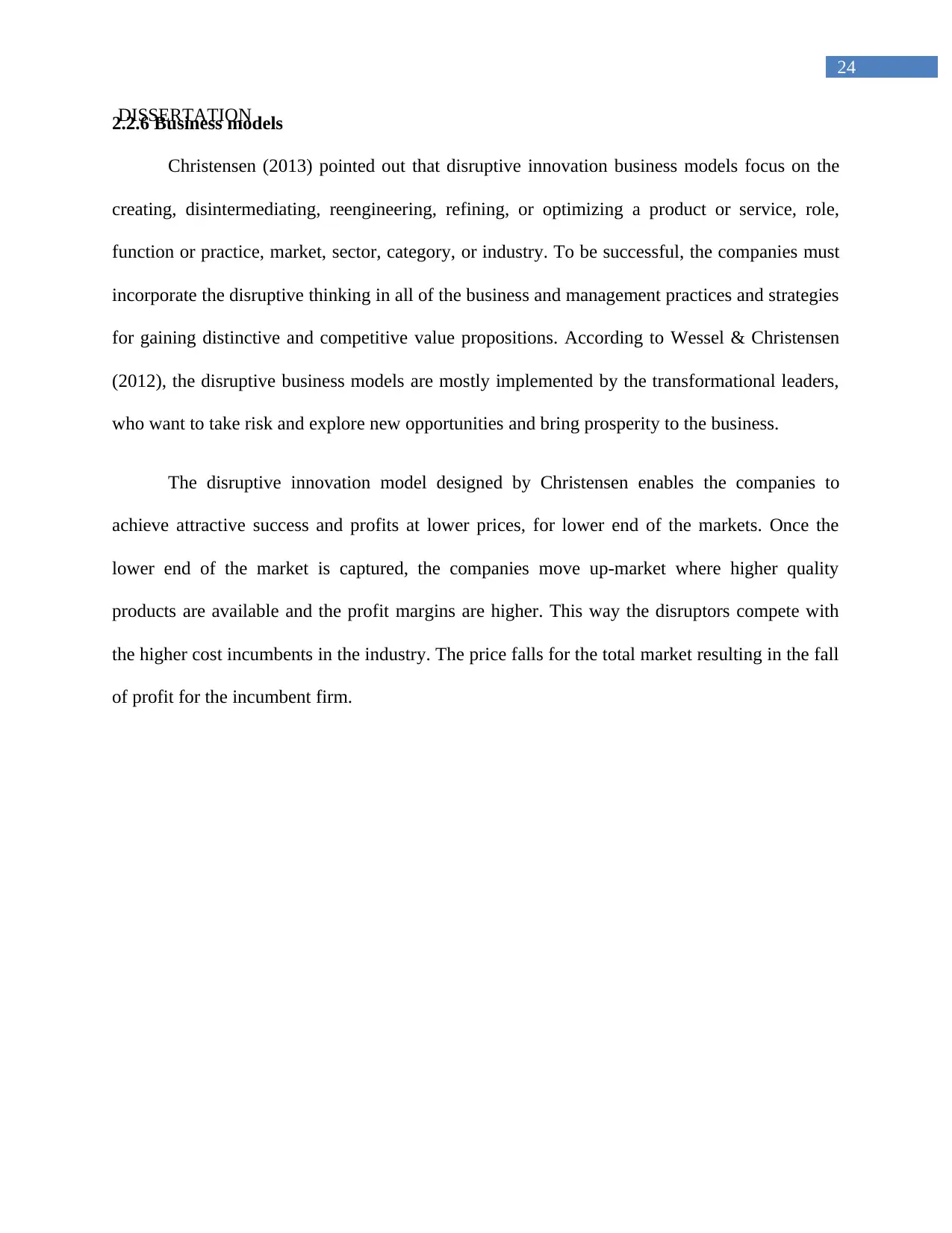
24
DISSERTATION2.2.6 Business models
Christensen (2013) pointed out that disruptive innovation business models focus on the
creating, disintermediating, reengineering, refining, or optimizing a product or service, role,
function or practice, market, sector, category, or industry. To be successful, the companies must
incorporate the disruptive thinking in all of the business and management practices and strategies
for gaining distinctive and competitive value propositions. According to Wessel & Christensen
(2012), the disruptive business models are mostly implemented by the transformational leaders,
who want to take risk and explore new opportunities and bring prosperity to the business.
The disruptive innovation model designed by Christensen enables the companies to
achieve attractive success and profits at lower prices, for lower end of the markets. Once the
lower end of the market is captured, the companies move up-market where higher quality
products are available and the profit margins are higher. This way the disruptors compete with
the higher cost incumbents in the industry. The price falls for the total market resulting in the fall
of profit for the incumbent firm.
DISSERTATION2.2.6 Business models
Christensen (2013) pointed out that disruptive innovation business models focus on the
creating, disintermediating, reengineering, refining, or optimizing a product or service, role,
function or practice, market, sector, category, or industry. To be successful, the companies must
incorporate the disruptive thinking in all of the business and management practices and strategies
for gaining distinctive and competitive value propositions. According to Wessel & Christensen
(2012), the disruptive business models are mostly implemented by the transformational leaders,
who want to take risk and explore new opportunities and bring prosperity to the business.
The disruptive innovation model designed by Christensen enables the companies to
achieve attractive success and profits at lower prices, for lower end of the markets. Once the
lower end of the market is captured, the companies move up-market where higher quality
products are available and the profit margins are higher. This way the disruptors compete with
the higher cost incumbents in the industry. The price falls for the total market resulting in the fall
of profit for the incumbent firm.
Paraphrase This Document
Need a fresh take? Get an instant paraphrase of this document with our AI Paraphraser
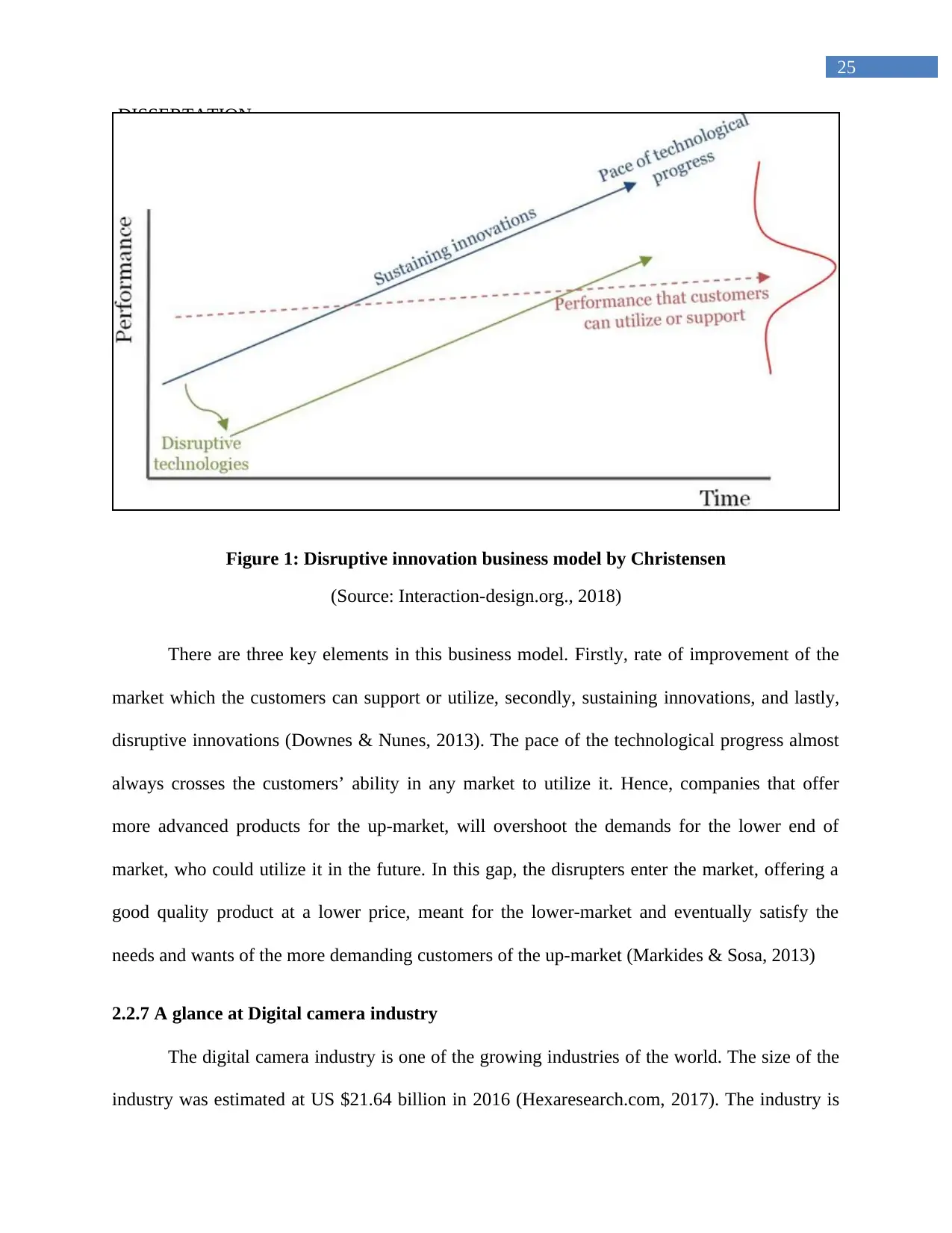
25
DISSERTATION
Figure 1: Disruptive innovation business model by Christensen
(Source: Interaction-design.org., 2018)
There are three key elements in this business model. Firstly, rate of improvement of the
market which the customers can support or utilize, secondly, sustaining innovations, and lastly,
disruptive innovations (Downes & Nunes, 2013). The pace of the technological progress almost
always crosses the customers’ ability in any market to utilize it. Hence, companies that offer
more advanced products for the up-market, will overshoot the demands for the lower end of
market, who could utilize it in the future. In this gap, the disrupters enter the market, offering a
good quality product at a lower price, meant for the lower-market and eventually satisfy the
needs and wants of the more demanding customers of the up-market (Markides & Sosa, 2013)
2.2.7 A glance at Digital camera industry
The digital camera industry is one of the growing industries of the world. The size of the
industry was estimated at US $21.64 billion in 2016 (Hexaresearch.com, 2017). The industry is
DISSERTATION
Figure 1: Disruptive innovation business model by Christensen
(Source: Interaction-design.org., 2018)
There are three key elements in this business model. Firstly, rate of improvement of the
market which the customers can support or utilize, secondly, sustaining innovations, and lastly,
disruptive innovations (Downes & Nunes, 2013). The pace of the technological progress almost
always crosses the customers’ ability in any market to utilize it. Hence, companies that offer
more advanced products for the up-market, will overshoot the demands for the lower end of
market, who could utilize it in the future. In this gap, the disrupters enter the market, offering a
good quality product at a lower price, meant for the lower-market and eventually satisfy the
needs and wants of the more demanding customers of the up-market (Markides & Sosa, 2013)
2.2.7 A glance at Digital camera industry
The digital camera industry is one of the growing industries of the world. The size of the
industry was estimated at US $21.64 billion in 2016 (Hexaresearch.com, 2017). The industry is
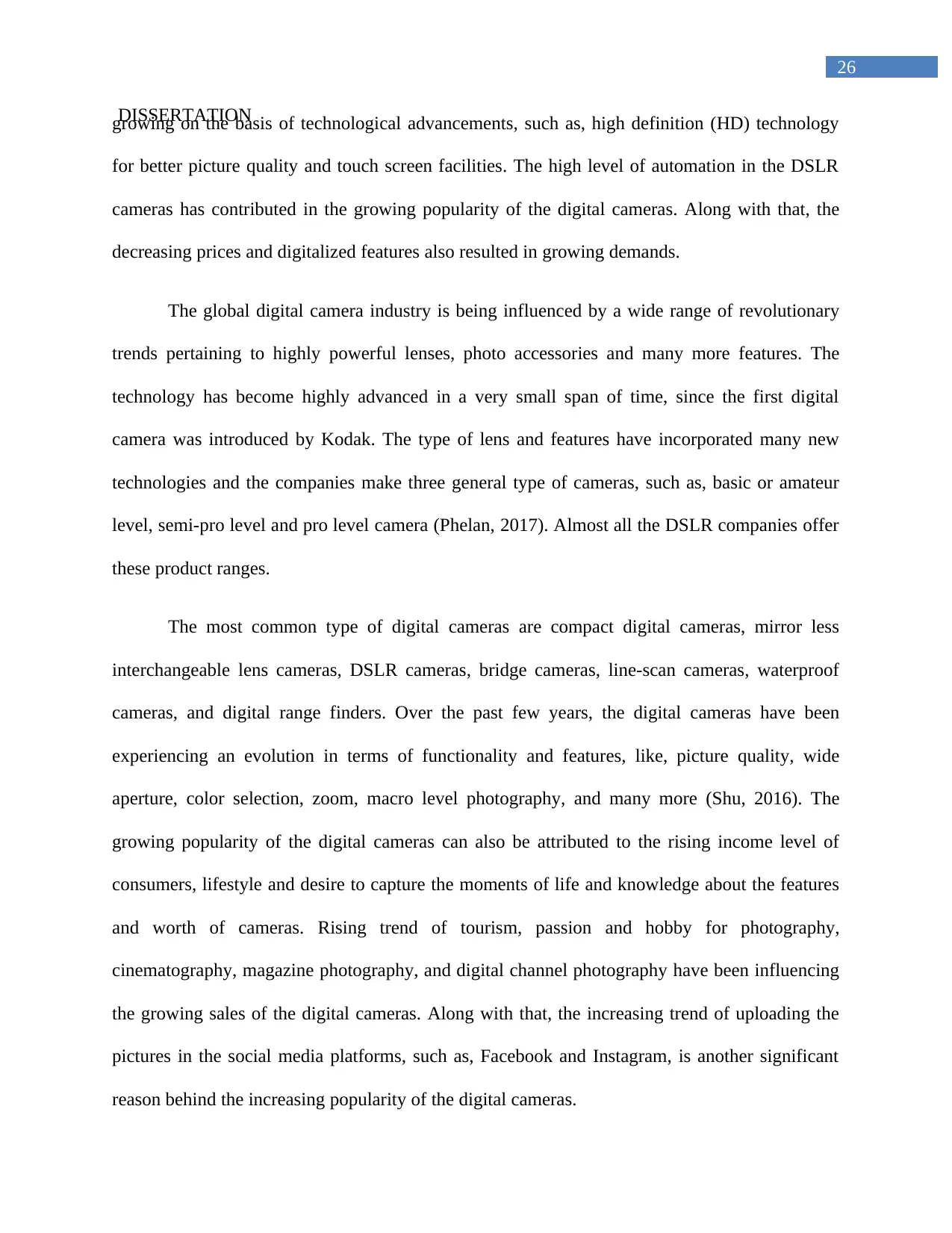
26
DISSERTATIONgrowing on the basis of technological advancements, such as, high definition (HD) technology
for better picture quality and touch screen facilities. The high level of automation in the DSLR
cameras has contributed in the growing popularity of the digital cameras. Along with that, the
decreasing prices and digitalized features also resulted in growing demands.
The global digital camera industry is being influenced by a wide range of revolutionary
trends pertaining to highly powerful lenses, photo accessories and many more features. The
technology has become highly advanced in a very small span of time, since the first digital
camera was introduced by Kodak. The type of lens and features have incorporated many new
technologies and the companies make three general type of cameras, such as, basic or amateur
level, semi-pro level and pro level camera (Phelan, 2017). Almost all the DSLR companies offer
these product ranges.
The most common type of digital cameras are compact digital cameras, mirror less
interchangeable lens cameras, DSLR cameras, bridge cameras, line-scan cameras, waterproof
cameras, and digital range finders. Over the past few years, the digital cameras have been
experiencing an evolution in terms of functionality and features, like, picture quality, wide
aperture, color selection, zoom, macro level photography, and many more (Shu, 2016). The
growing popularity of the digital cameras can also be attributed to the rising income level of
consumers, lifestyle and desire to capture the moments of life and knowledge about the features
and worth of cameras. Rising trend of tourism, passion and hobby for photography,
cinematography, magazine photography, and digital channel photography have been influencing
the growing sales of the digital cameras. Along with that, the increasing trend of uploading the
pictures in the social media platforms, such as, Facebook and Instagram, is another significant
reason behind the increasing popularity of the digital cameras.
DISSERTATIONgrowing on the basis of technological advancements, such as, high definition (HD) technology
for better picture quality and touch screen facilities. The high level of automation in the DSLR
cameras has contributed in the growing popularity of the digital cameras. Along with that, the
decreasing prices and digitalized features also resulted in growing demands.
The global digital camera industry is being influenced by a wide range of revolutionary
trends pertaining to highly powerful lenses, photo accessories and many more features. The
technology has become highly advanced in a very small span of time, since the first digital
camera was introduced by Kodak. The type of lens and features have incorporated many new
technologies and the companies make three general type of cameras, such as, basic or amateur
level, semi-pro level and pro level camera (Phelan, 2017). Almost all the DSLR companies offer
these product ranges.
The most common type of digital cameras are compact digital cameras, mirror less
interchangeable lens cameras, DSLR cameras, bridge cameras, line-scan cameras, waterproof
cameras, and digital range finders. Over the past few years, the digital cameras have been
experiencing an evolution in terms of functionality and features, like, picture quality, wide
aperture, color selection, zoom, macro level photography, and many more (Shu, 2016). The
growing popularity of the digital cameras can also be attributed to the rising income level of
consumers, lifestyle and desire to capture the moments of life and knowledge about the features
and worth of cameras. Rising trend of tourism, passion and hobby for photography,
cinematography, magazine photography, and digital channel photography have been influencing
the growing sales of the digital cameras. Along with that, the increasing trend of uploading the
pictures in the social media platforms, such as, Facebook and Instagram, is another significant
reason behind the increasing popularity of the digital cameras.
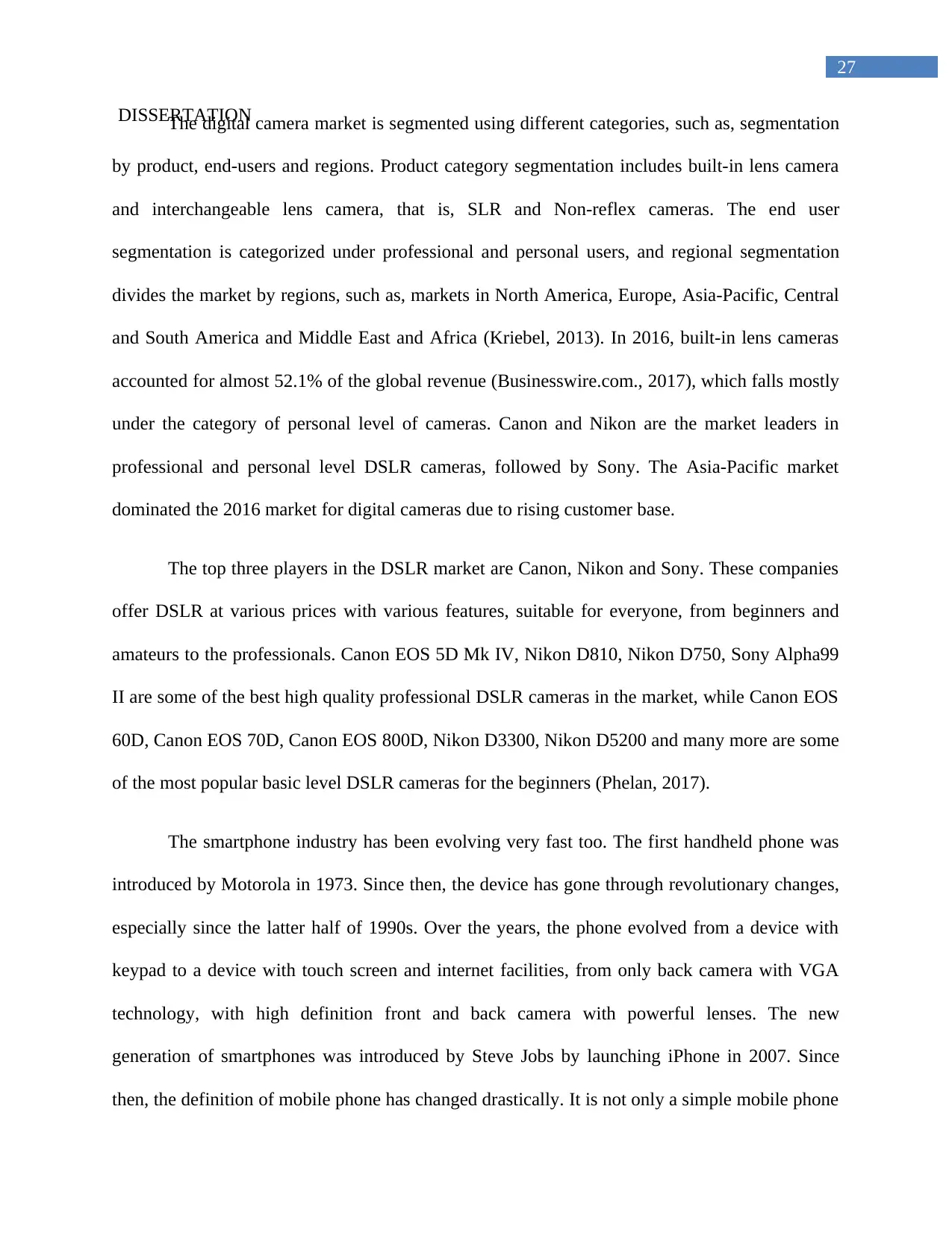
27
DISSERTATIONThe digital camera market is segmented using different categories, such as, segmentation
by product, end-users and regions. Product category segmentation includes built-in lens camera
and interchangeable lens camera, that is, SLR and Non-reflex cameras. The end user
segmentation is categorized under professional and personal users, and regional segmentation
divides the market by regions, such as, markets in North America, Europe, Asia-Pacific, Central
and South America and Middle East and Africa (Kriebel, 2013). In 2016, built-in lens cameras
accounted for almost 52.1% of the global revenue (Businesswire.com., 2017), which falls mostly
under the category of personal level of cameras. Canon and Nikon are the market leaders in
professional and personal level DSLR cameras, followed by Sony. The Asia-Pacific market
dominated the 2016 market for digital cameras due to rising customer base.
The top three players in the DSLR market are Canon, Nikon and Sony. These companies
offer DSLR at various prices with various features, suitable for everyone, from beginners and
amateurs to the professionals. Canon EOS 5D Mk IV, Nikon D810, Nikon D750, Sony Alpha99
II are some of the best high quality professional DSLR cameras in the market, while Canon EOS
60D, Canon EOS 70D, Canon EOS 800D, Nikon D3300, Nikon D5200 and many more are some
of the most popular basic level DSLR cameras for the beginners (Phelan, 2017).
The smartphone industry has been evolving very fast too. The first handheld phone was
introduced by Motorola in 1973. Since then, the device has gone through revolutionary changes,
especially since the latter half of 1990s. Over the years, the phone evolved from a device with
keypad to a device with touch screen and internet facilities, from only back camera with VGA
technology, with high definition front and back camera with powerful lenses. The new
generation of smartphones was introduced by Steve Jobs by launching iPhone in 2007. Since
then, the definition of mobile phone has changed drastically. It is not only a simple mobile phone
DISSERTATIONThe digital camera market is segmented using different categories, such as, segmentation
by product, end-users and regions. Product category segmentation includes built-in lens camera
and interchangeable lens camera, that is, SLR and Non-reflex cameras. The end user
segmentation is categorized under professional and personal users, and regional segmentation
divides the market by regions, such as, markets in North America, Europe, Asia-Pacific, Central
and South America and Middle East and Africa (Kriebel, 2013). In 2016, built-in lens cameras
accounted for almost 52.1% of the global revenue (Businesswire.com., 2017), which falls mostly
under the category of personal level of cameras. Canon and Nikon are the market leaders in
professional and personal level DSLR cameras, followed by Sony. The Asia-Pacific market
dominated the 2016 market for digital cameras due to rising customer base.
The top three players in the DSLR market are Canon, Nikon and Sony. These companies
offer DSLR at various prices with various features, suitable for everyone, from beginners and
amateurs to the professionals. Canon EOS 5D Mk IV, Nikon D810, Nikon D750, Sony Alpha99
II are some of the best high quality professional DSLR cameras in the market, while Canon EOS
60D, Canon EOS 70D, Canon EOS 800D, Nikon D3300, Nikon D5200 and many more are some
of the most popular basic level DSLR cameras for the beginners (Phelan, 2017).
The smartphone industry has been evolving very fast too. The first handheld phone was
introduced by Motorola in 1973. Since then, the device has gone through revolutionary changes,
especially since the latter half of 1990s. Over the years, the phone evolved from a device with
keypad to a device with touch screen and internet facilities, from only back camera with VGA
technology, with high definition front and back camera with powerful lenses. The new
generation of smartphones was introduced by Steve Jobs by launching iPhone in 2007. Since
then, the definition of mobile phone has changed drastically. It is not only a simple mobile phone
Secure Best Marks with AI Grader
Need help grading? Try our AI Grader for instant feedback on your assignments.
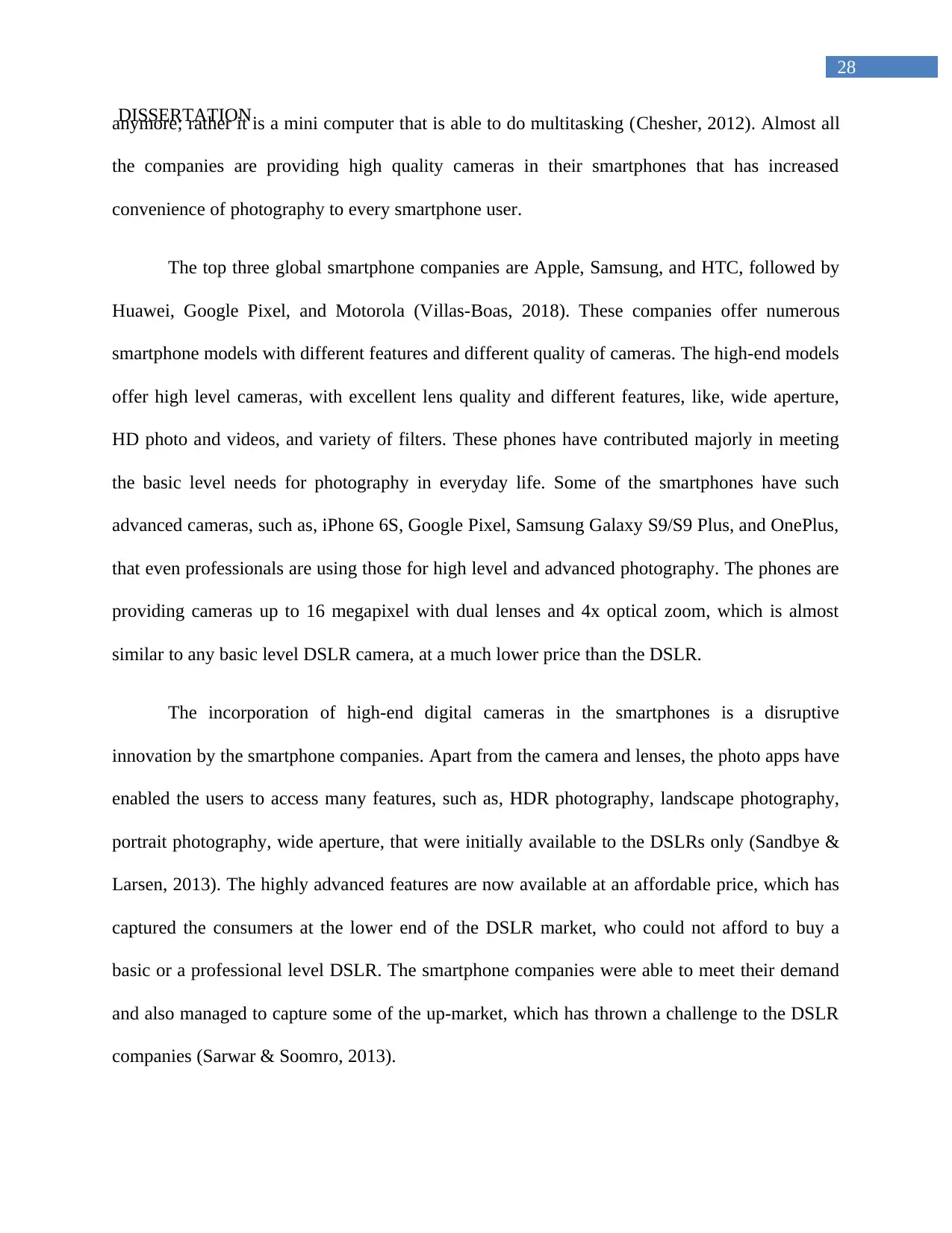
28
DISSERTATIONanymore; rather it is a mini computer that is able to do multitasking (Chesher, 2012). Almost all
the companies are providing high quality cameras in their smartphones that has increased
convenience of photography to every smartphone user.
The top three global smartphone companies are Apple, Samsung, and HTC, followed by
Huawei, Google Pixel, and Motorola (Villas-Boas, 2018). These companies offer numerous
smartphone models with different features and different quality of cameras. The high-end models
offer high level cameras, with excellent lens quality and different features, like, wide aperture,
HD photo and videos, and variety of filters. These phones have contributed majorly in meeting
the basic level needs for photography in everyday life. Some of the smartphones have such
advanced cameras, such as, iPhone 6S, Google Pixel, Samsung Galaxy S9/S9 Plus, and OnePlus,
that even professionals are using those for high level and advanced photography. The phones are
providing cameras up to 16 megapixel with dual lenses and 4x optical zoom, which is almost
similar to any basic level DSLR camera, at a much lower price than the DSLR.
The incorporation of high-end digital cameras in the smartphones is a disruptive
innovation by the smartphone companies. Apart from the camera and lenses, the photo apps have
enabled the users to access many features, such as, HDR photography, landscape photography,
portrait photography, wide aperture, that were initially available to the DSLRs only (Sandbye &
Larsen, 2013). The highly advanced features are now available at an affordable price, which has
captured the consumers at the lower end of the DSLR market, who could not afford to buy a
basic or a professional level DSLR. The smartphone companies were able to meet their demand
and also managed to capture some of the up-market, which has thrown a challenge to the DSLR
companies (Sarwar & Soomro, 2013).
DISSERTATIONanymore; rather it is a mini computer that is able to do multitasking (Chesher, 2012). Almost all
the companies are providing high quality cameras in their smartphones that has increased
convenience of photography to every smartphone user.
The top three global smartphone companies are Apple, Samsung, and HTC, followed by
Huawei, Google Pixel, and Motorola (Villas-Boas, 2018). These companies offer numerous
smartphone models with different features and different quality of cameras. The high-end models
offer high level cameras, with excellent lens quality and different features, like, wide aperture,
HD photo and videos, and variety of filters. These phones have contributed majorly in meeting
the basic level needs for photography in everyday life. Some of the smartphones have such
advanced cameras, such as, iPhone 6S, Google Pixel, Samsung Galaxy S9/S9 Plus, and OnePlus,
that even professionals are using those for high level and advanced photography. The phones are
providing cameras up to 16 megapixel with dual lenses and 4x optical zoom, which is almost
similar to any basic level DSLR camera, at a much lower price than the DSLR.
The incorporation of high-end digital cameras in the smartphones is a disruptive
innovation by the smartphone companies. Apart from the camera and lenses, the photo apps have
enabled the users to access many features, such as, HDR photography, landscape photography,
portrait photography, wide aperture, that were initially available to the DSLRs only (Sandbye &
Larsen, 2013). The highly advanced features are now available at an affordable price, which has
captured the consumers at the lower end of the DSLR market, who could not afford to buy a
basic or a professional level DSLR. The smartphone companies were able to meet their demand
and also managed to capture some of the up-market, which has thrown a challenge to the DSLR
companies (Sarwar & Soomro, 2013).
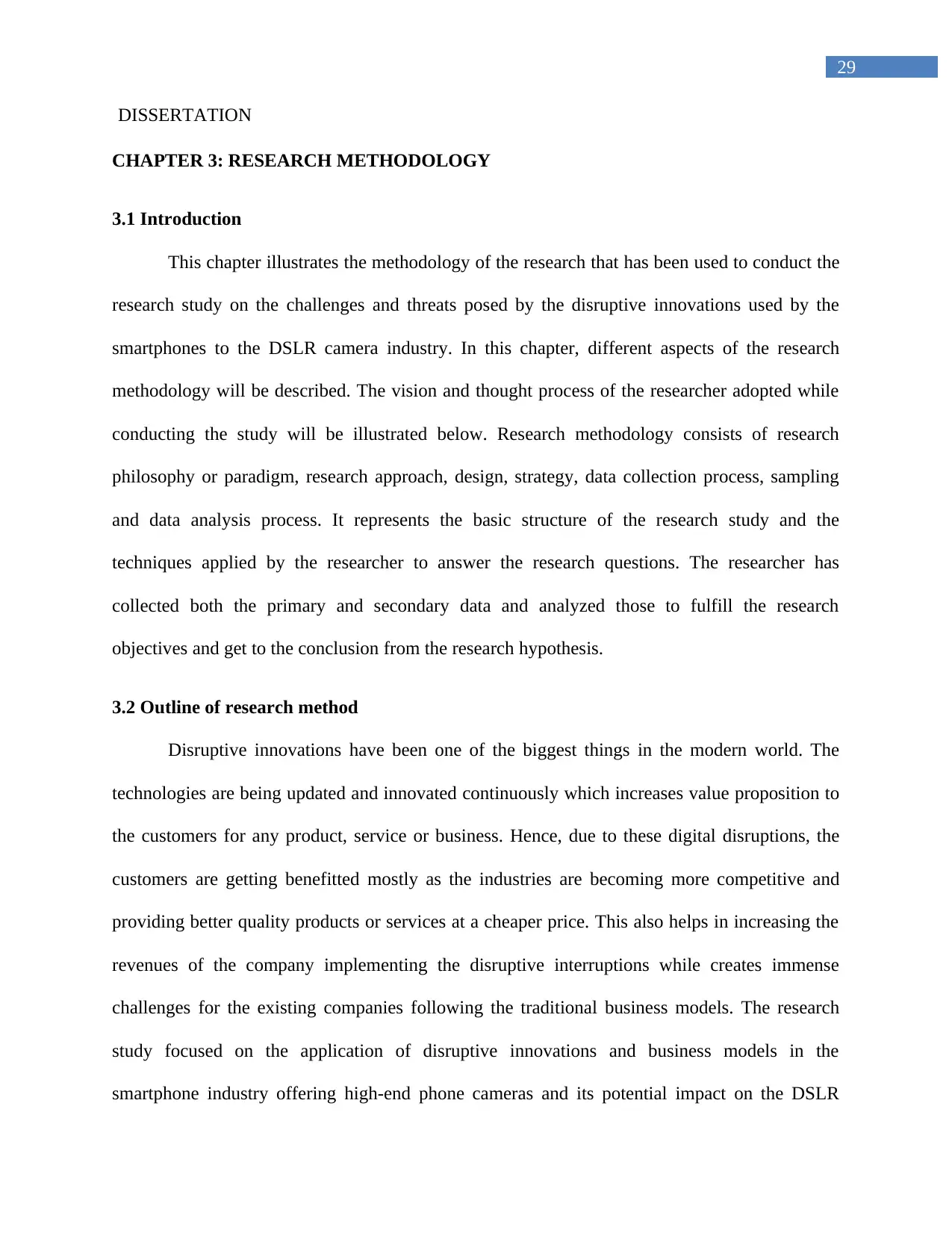
29
DISSERTATION
CHAPTER 3: RESEARCH METHODOLOGY
3.1 Introduction
This chapter illustrates the methodology of the research that has been used to conduct the
research study on the challenges and threats posed by the disruptive innovations used by the
smartphones to the DSLR camera industry. In this chapter, different aspects of the research
methodology will be described. The vision and thought process of the researcher adopted while
conducting the study will be illustrated below. Research methodology consists of research
philosophy or paradigm, research approach, design, strategy, data collection process, sampling
and data analysis process. It represents the basic structure of the research study and the
techniques applied by the researcher to answer the research questions. The researcher has
collected both the primary and secondary data and analyzed those to fulfill the research
objectives and get to the conclusion from the research hypothesis.
3.2 Outline of research method
Disruptive innovations have been one of the biggest things in the modern world. The
technologies are being updated and innovated continuously which increases value proposition to
the customers for any product, service or business. Hence, due to these digital disruptions, the
customers are getting benefitted mostly as the industries are becoming more competitive and
providing better quality products or services at a cheaper price. This also helps in increasing the
revenues of the company implementing the disruptive interruptions while creates immense
challenges for the existing companies following the traditional business models. The research
study focused on the application of disruptive innovations and business models in the
smartphone industry offering high-end phone cameras and its potential impact on the DSLR
DISSERTATION
CHAPTER 3: RESEARCH METHODOLOGY
3.1 Introduction
This chapter illustrates the methodology of the research that has been used to conduct the
research study on the challenges and threats posed by the disruptive innovations used by the
smartphones to the DSLR camera industry. In this chapter, different aspects of the research
methodology will be described. The vision and thought process of the researcher adopted while
conducting the study will be illustrated below. Research methodology consists of research
philosophy or paradigm, research approach, design, strategy, data collection process, sampling
and data analysis process. It represents the basic structure of the research study and the
techniques applied by the researcher to answer the research questions. The researcher has
collected both the primary and secondary data and analyzed those to fulfill the research
objectives and get to the conclusion from the research hypothesis.
3.2 Outline of research method
Disruptive innovations have been one of the biggest things in the modern world. The
technologies are being updated and innovated continuously which increases value proposition to
the customers for any product, service or business. Hence, due to these digital disruptions, the
customers are getting benefitted mostly as the industries are becoming more competitive and
providing better quality products or services at a cheaper price. This also helps in increasing the
revenues of the company implementing the disruptive interruptions while creates immense
challenges for the existing companies following the traditional business models. The research
study focused on the application of disruptive innovations and business models in the
smartphone industry offering high-end phone cameras and its potential impact on the DSLR
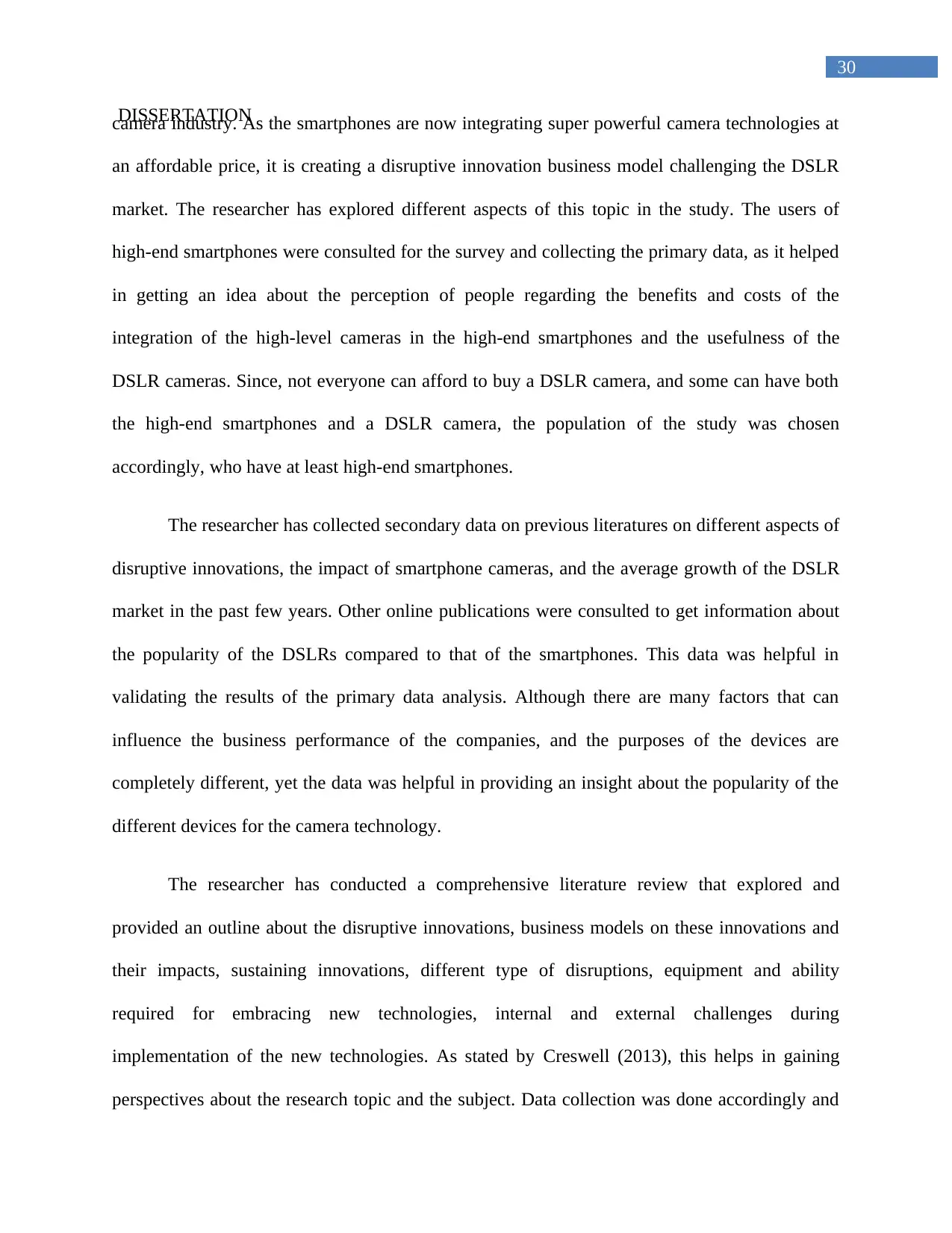
30
DISSERTATIONcamera industry. As the smartphones are now integrating super powerful camera technologies at
an affordable price, it is creating a disruptive innovation business model challenging the DSLR
market. The researcher has explored different aspects of this topic in the study. The users of
high-end smartphones were consulted for the survey and collecting the primary data, as it helped
in getting an idea about the perception of people regarding the benefits and costs of the
integration of the high-level cameras in the high-end smartphones and the usefulness of the
DSLR cameras. Since, not everyone can afford to buy a DSLR camera, and some can have both
the high-end smartphones and a DSLR camera, the population of the study was chosen
accordingly, who have at least high-end smartphones.
The researcher has collected secondary data on previous literatures on different aspects of
disruptive innovations, the impact of smartphone cameras, and the average growth of the DSLR
market in the past few years. Other online publications were consulted to get information about
the popularity of the DSLRs compared to that of the smartphones. This data was helpful in
validating the results of the primary data analysis. Although there are many factors that can
influence the business performance of the companies, and the purposes of the devices are
completely different, yet the data was helpful in providing an insight about the popularity of the
different devices for the camera technology.
The researcher has conducted a comprehensive literature review that explored and
provided an outline about the disruptive innovations, business models on these innovations and
their impacts, sustaining innovations, different type of disruptions, equipment and ability
required for embracing new technologies, internal and external challenges during
implementation of the new technologies. As stated by Creswell (2013), this helps in gaining
perspectives about the research topic and the subject. Data collection was done accordingly and
DISSERTATIONcamera industry. As the smartphones are now integrating super powerful camera technologies at
an affordable price, it is creating a disruptive innovation business model challenging the DSLR
market. The researcher has explored different aspects of this topic in the study. The users of
high-end smartphones were consulted for the survey and collecting the primary data, as it helped
in getting an idea about the perception of people regarding the benefits and costs of the
integration of the high-level cameras in the high-end smartphones and the usefulness of the
DSLR cameras. Since, not everyone can afford to buy a DSLR camera, and some can have both
the high-end smartphones and a DSLR camera, the population of the study was chosen
accordingly, who have at least high-end smartphones.
The researcher has collected secondary data on previous literatures on different aspects of
disruptive innovations, the impact of smartphone cameras, and the average growth of the DSLR
market in the past few years. Other online publications were consulted to get information about
the popularity of the DSLRs compared to that of the smartphones. This data was helpful in
validating the results of the primary data analysis. Although there are many factors that can
influence the business performance of the companies, and the purposes of the devices are
completely different, yet the data was helpful in providing an insight about the popularity of the
different devices for the camera technology.
The researcher has conducted a comprehensive literature review that explored and
provided an outline about the disruptive innovations, business models on these innovations and
their impacts, sustaining innovations, different type of disruptions, equipment and ability
required for embracing new technologies, internal and external challenges during
implementation of the new technologies. As stated by Creswell (2013), this helps in gaining
perspectives about the research topic and the subject. Data collection was done accordingly and
Paraphrase This Document
Need a fresh take? Get an instant paraphrase of this document with our AI Paraphraser
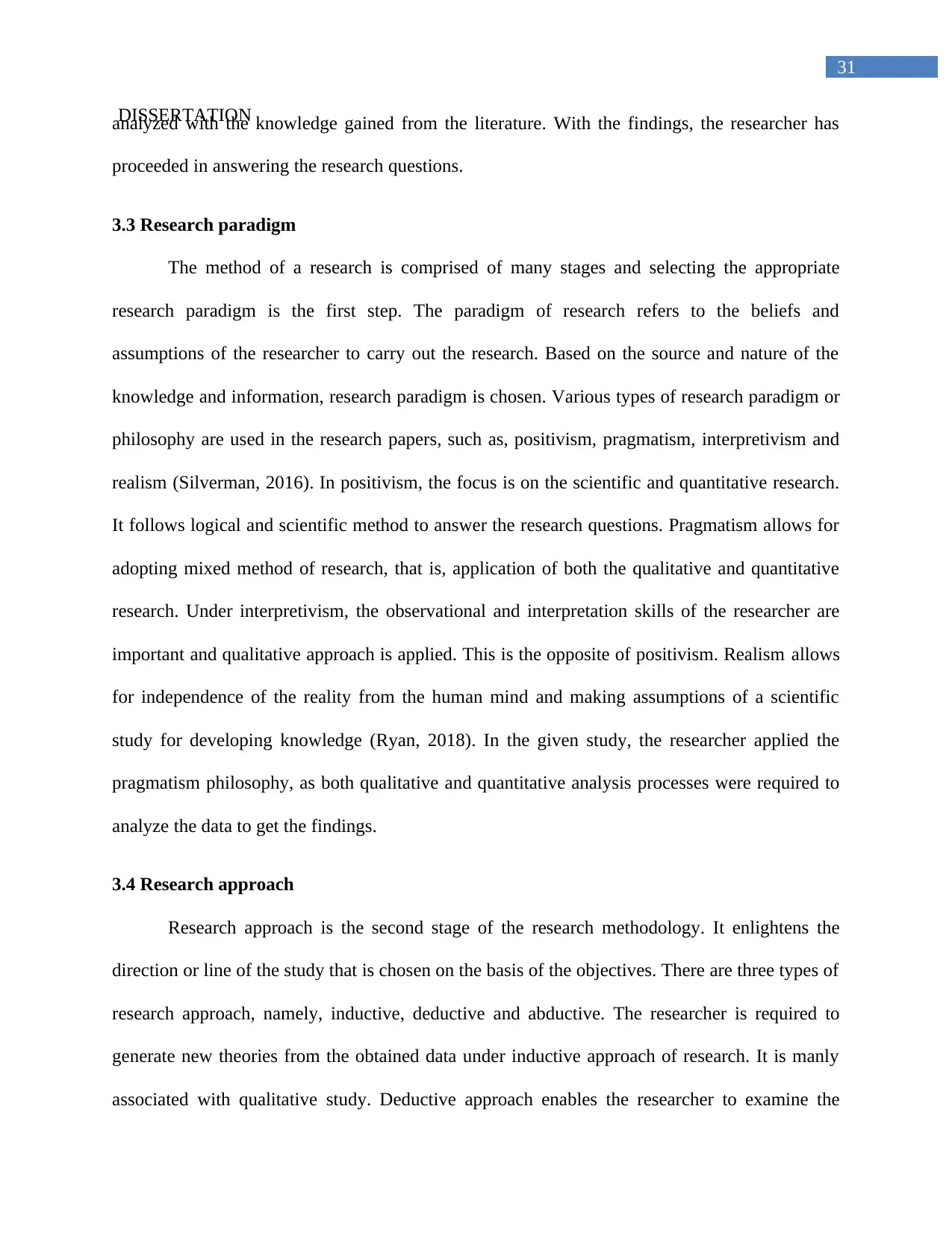
31
DISSERTATIONanalyzed with the knowledge gained from the literature. With the findings, the researcher has
proceeded in answering the research questions.
3.3 Research paradigm
The method of a research is comprised of many stages and selecting the appropriate
research paradigm is the first step. The paradigm of research refers to the beliefs and
assumptions of the researcher to carry out the research. Based on the source and nature of the
knowledge and information, research paradigm is chosen. Various types of research paradigm or
philosophy are used in the research papers, such as, positivism, pragmatism, interpretivism and
realism (Silverman, 2016). In positivism, the focus is on the scientific and quantitative research.
It follows logical and scientific method to answer the research questions. Pragmatism allows for
adopting mixed method of research, that is, application of both the qualitative and quantitative
research. Under interpretivism, the observational and interpretation skills of the researcher are
important and qualitative approach is applied. This is the opposite of positivism. Realism allows
for independence of the reality from the human mind and making assumptions of a scientific
study for developing knowledge (Ryan, 2018). In the given study, the researcher applied the
pragmatism philosophy, as both qualitative and quantitative analysis processes were required to
analyze the data to get the findings.
3.4 Research approach
Research approach is the second stage of the research methodology. It enlightens the
direction or line of the study that is chosen on the basis of the objectives. There are three types of
research approach, namely, inductive, deductive and abductive. The researcher is required to
generate new theories from the obtained data under inductive approach of research. It is manly
associated with qualitative study. Deductive approach enables the researcher to examine the
DISSERTATIONanalyzed with the knowledge gained from the literature. With the findings, the researcher has
proceeded in answering the research questions.
3.3 Research paradigm
The method of a research is comprised of many stages and selecting the appropriate
research paradigm is the first step. The paradigm of research refers to the beliefs and
assumptions of the researcher to carry out the research. Based on the source and nature of the
knowledge and information, research paradigm is chosen. Various types of research paradigm or
philosophy are used in the research papers, such as, positivism, pragmatism, interpretivism and
realism (Silverman, 2016). In positivism, the focus is on the scientific and quantitative research.
It follows logical and scientific method to answer the research questions. Pragmatism allows for
adopting mixed method of research, that is, application of both the qualitative and quantitative
research. Under interpretivism, the observational and interpretation skills of the researcher are
important and qualitative approach is applied. This is the opposite of positivism. Realism allows
for independence of the reality from the human mind and making assumptions of a scientific
study for developing knowledge (Ryan, 2018). In the given study, the researcher applied the
pragmatism philosophy, as both qualitative and quantitative analysis processes were required to
analyze the data to get the findings.
3.4 Research approach
Research approach is the second stage of the research methodology. It enlightens the
direction or line of the study that is chosen on the basis of the objectives. There are three types of
research approach, namely, inductive, deductive and abductive. The researcher is required to
generate new theories from the obtained data under inductive approach of research. It is manly
associated with qualitative study. Deductive approach enables the researcher to examine the

32
DISSERTATIONresearch hypothesis on the basis of already established theories. As stated by Flick (2015), the
hypothesis testing under deductive approach is done with an emphasis on finding causality
against the theories. This is majorly applied in the quantitative study, although can be applied in
the qualitative study also. The third type is abductive research, in which a potential conclusion is
chosen from a set of possible outcomes of the research phenomena (Bryman, 2015).
In the given paper, the researcher adopted deductive research approach. The research
hypotheses, formulated in the introduction chapter, were examined using quantitative methods.
The secondary data was examined against the findings of the quantitative study. The findings
were tested against the theories on disruptive innovations and business models. However, neither
any new theory was generated like in inductive research, nor any particular solution was chosen
from a set of solutions like in abductive research.
3.5 Research strategy
Research strategy refers to the basic plan of the researcher about how to conduct the
study to answer the research questions in the correct direction and in logical manner (Bryman,
2015). Different types of research strategies are: surveys, case studies, experiment, ethnography,
action research, archival research and narrative inquiry (Neuman & Robson, 2014). The most
commonly used strategies under deductive approach are case studies, experiments and surveys.
In the following paper, the researcher adopted the case study and survey strategy. This helps in
obtaining useful first hand information from the subjects (Robson & McCartan, 2016). For the
study on disruptive technology adopted by the smartphone companies and the potential
challenges that it creates for the DSLR companies, the researcher chose to study the business
growth of top three DSLR making companies and top three high-end smartphone companies.
Secondary data was collected from these six companies and primary data collected from random
DISSERTATIONresearch hypothesis on the basis of already established theories. As stated by Flick (2015), the
hypothesis testing under deductive approach is done with an emphasis on finding causality
against the theories. This is majorly applied in the quantitative study, although can be applied in
the qualitative study also. The third type is abductive research, in which a potential conclusion is
chosen from a set of possible outcomes of the research phenomena (Bryman, 2015).
In the given paper, the researcher adopted deductive research approach. The research
hypotheses, formulated in the introduction chapter, were examined using quantitative methods.
The secondary data was examined against the findings of the quantitative study. The findings
were tested against the theories on disruptive innovations and business models. However, neither
any new theory was generated like in inductive research, nor any particular solution was chosen
from a set of solutions like in abductive research.
3.5 Research strategy
Research strategy refers to the basic plan of the researcher about how to conduct the
study to answer the research questions in the correct direction and in logical manner (Bryman,
2015). Different types of research strategies are: surveys, case studies, experiment, ethnography,
action research, archival research and narrative inquiry (Neuman & Robson, 2014). The most
commonly used strategies under deductive approach are case studies, experiments and surveys.
In the following paper, the researcher adopted the case study and survey strategy. This helps in
obtaining useful first hand information from the subjects (Robson & McCartan, 2016). For the
study on disruptive technology adopted by the smartphone companies and the potential
challenges that it creates for the DSLR companies, the researcher chose to study the business
growth of top three DSLR making companies and top three high-end smartphone companies.
Secondary data was collected from these six companies and primary data collected from random
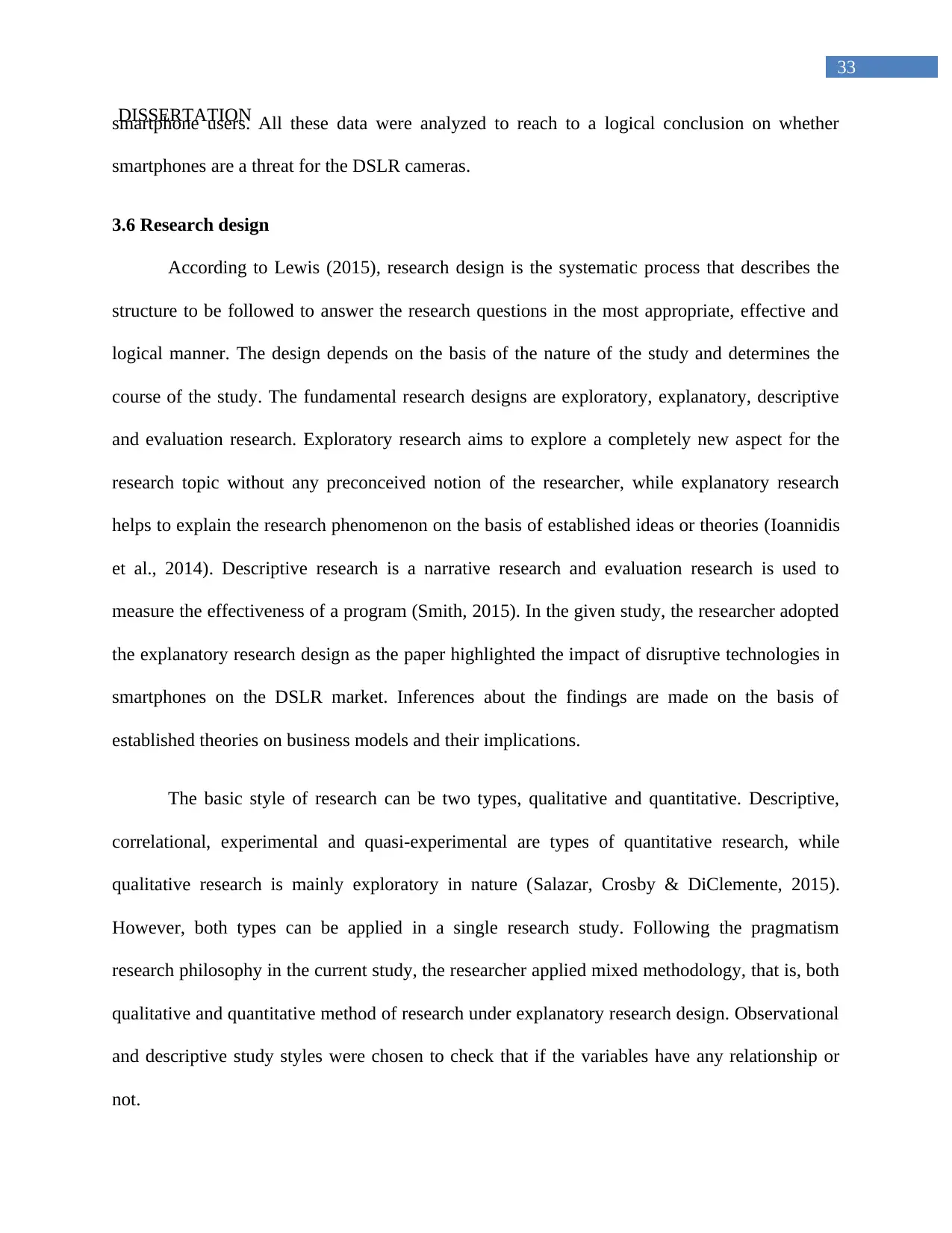
33
DISSERTATIONsmartphone users. All these data were analyzed to reach to a logical conclusion on whether
smartphones are a threat for the DSLR cameras.
3.6 Research design
According to Lewis (2015), research design is the systematic process that describes the
structure to be followed to answer the research questions in the most appropriate, effective and
logical manner. The design depends on the basis of the nature of the study and determines the
course of the study. The fundamental research designs are exploratory, explanatory, descriptive
and evaluation research. Exploratory research aims to explore a completely new aspect for the
research topic without any preconceived notion of the researcher, while explanatory research
helps to explain the research phenomenon on the basis of established ideas or theories (Ioannidis
et al., 2014). Descriptive research is a narrative research and evaluation research is used to
measure the effectiveness of a program (Smith, 2015). In the given study, the researcher adopted
the explanatory research design as the paper highlighted the impact of disruptive technologies in
smartphones on the DSLR market. Inferences about the findings are made on the basis of
established theories on business models and their implications.
The basic style of research can be two types, qualitative and quantitative. Descriptive,
correlational, experimental and quasi-experimental are types of quantitative research, while
qualitative research is mainly exploratory in nature (Salazar, Crosby & DiClemente, 2015).
However, both types can be applied in a single research study. Following the pragmatism
research philosophy in the current study, the researcher applied mixed methodology, that is, both
qualitative and quantitative method of research under explanatory research design. Observational
and descriptive study styles were chosen to check that if the variables have any relationship or
not.
DISSERTATIONsmartphone users. All these data were analyzed to reach to a logical conclusion on whether
smartphones are a threat for the DSLR cameras.
3.6 Research design
According to Lewis (2015), research design is the systematic process that describes the
structure to be followed to answer the research questions in the most appropriate, effective and
logical manner. The design depends on the basis of the nature of the study and determines the
course of the study. The fundamental research designs are exploratory, explanatory, descriptive
and evaluation research. Exploratory research aims to explore a completely new aspect for the
research topic without any preconceived notion of the researcher, while explanatory research
helps to explain the research phenomenon on the basis of established ideas or theories (Ioannidis
et al., 2014). Descriptive research is a narrative research and evaluation research is used to
measure the effectiveness of a program (Smith, 2015). In the given study, the researcher adopted
the explanatory research design as the paper highlighted the impact of disruptive technologies in
smartphones on the DSLR market. Inferences about the findings are made on the basis of
established theories on business models and their implications.
The basic style of research can be two types, qualitative and quantitative. Descriptive,
correlational, experimental and quasi-experimental are types of quantitative research, while
qualitative research is mainly exploratory in nature (Salazar, Crosby & DiClemente, 2015).
However, both types can be applied in a single research study. Following the pragmatism
research philosophy in the current study, the researcher applied mixed methodology, that is, both
qualitative and quantitative method of research under explanatory research design. Observational
and descriptive study styles were chosen to check that if the variables have any relationship or
not.
Secure Best Marks with AI Grader
Need help grading? Try our AI Grader for instant feedback on your assignments.
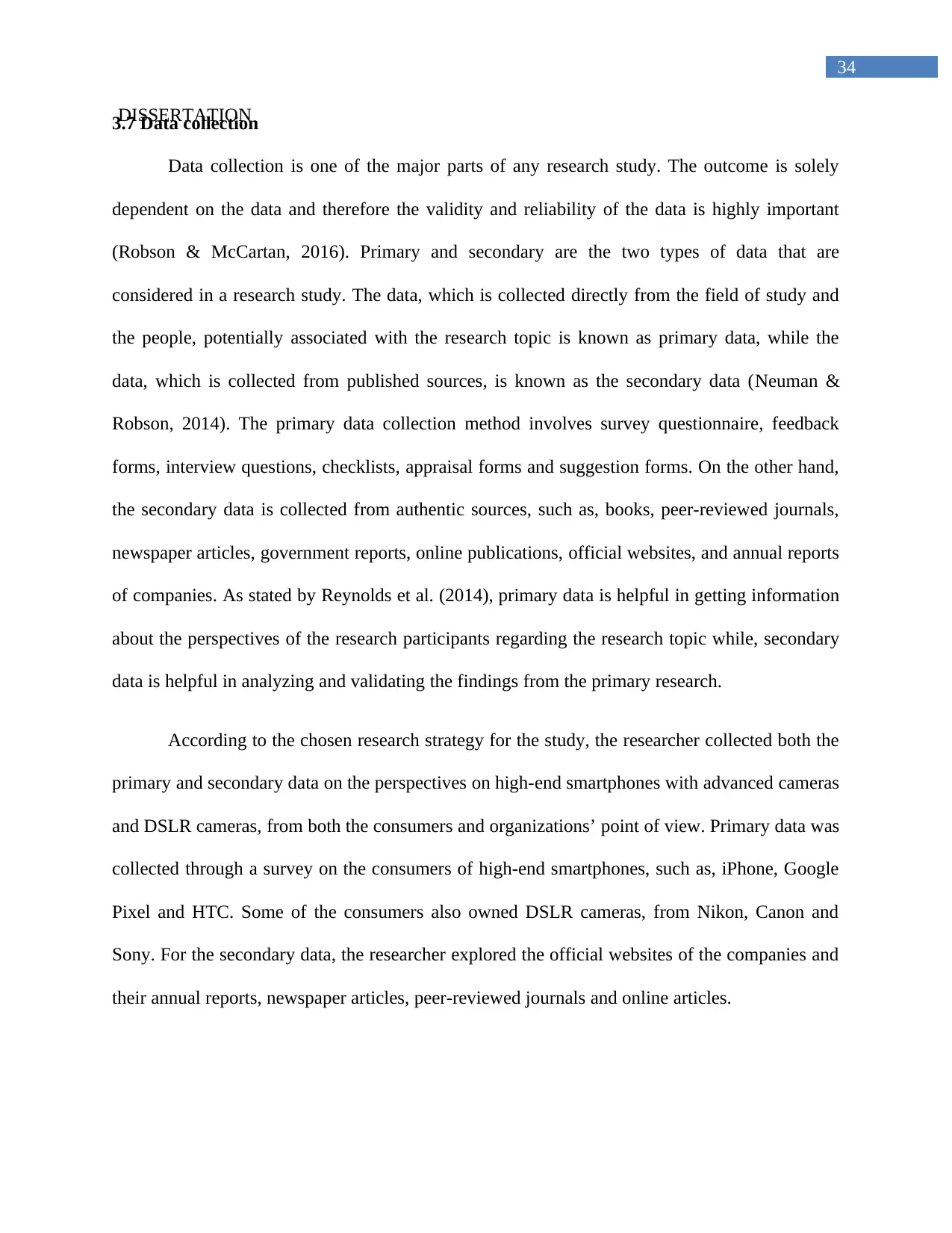
34
DISSERTATION3.7 Data collection
Data collection is one of the major parts of any research study. The outcome is solely
dependent on the data and therefore the validity and reliability of the data is highly important
(Robson & McCartan, 2016). Primary and secondary are the two types of data that are
considered in a research study. The data, which is collected directly from the field of study and
the people, potentially associated with the research topic is known as primary data, while the
data, which is collected from published sources, is known as the secondary data (Neuman &
Robson, 2014). The primary data collection method involves survey questionnaire, feedback
forms, interview questions, checklists, appraisal forms and suggestion forms. On the other hand,
the secondary data is collected from authentic sources, such as, books, peer-reviewed journals,
newspaper articles, government reports, online publications, official websites, and annual reports
of companies. As stated by Reynolds et al. (2014), primary data is helpful in getting information
about the perspectives of the research participants regarding the research topic while, secondary
data is helpful in analyzing and validating the findings from the primary research.
According to the chosen research strategy for the study, the researcher collected both the
primary and secondary data on the perspectives on high-end smartphones with advanced cameras
and DSLR cameras, from both the consumers and organizations’ point of view. Primary data was
collected through a survey on the consumers of high-end smartphones, such as, iPhone, Google
Pixel and HTC. Some of the consumers also owned DSLR cameras, from Nikon, Canon and
Sony. For the secondary data, the researcher explored the official websites of the companies and
their annual reports, newspaper articles, peer-reviewed journals and online articles.
DISSERTATION3.7 Data collection
Data collection is one of the major parts of any research study. The outcome is solely
dependent on the data and therefore the validity and reliability of the data is highly important
(Robson & McCartan, 2016). Primary and secondary are the two types of data that are
considered in a research study. The data, which is collected directly from the field of study and
the people, potentially associated with the research topic is known as primary data, while the
data, which is collected from published sources, is known as the secondary data (Neuman &
Robson, 2014). The primary data collection method involves survey questionnaire, feedback
forms, interview questions, checklists, appraisal forms and suggestion forms. On the other hand,
the secondary data is collected from authentic sources, such as, books, peer-reviewed journals,
newspaper articles, government reports, online publications, official websites, and annual reports
of companies. As stated by Reynolds et al. (2014), primary data is helpful in getting information
about the perspectives of the research participants regarding the research topic while, secondary
data is helpful in analyzing and validating the findings from the primary research.
According to the chosen research strategy for the study, the researcher collected both the
primary and secondary data on the perspectives on high-end smartphones with advanced cameras
and DSLR cameras, from both the consumers and organizations’ point of view. Primary data was
collected through a survey on the consumers of high-end smartphones, such as, iPhone, Google
Pixel and HTC. Some of the consumers also owned DSLR cameras, from Nikon, Canon and
Sony. For the secondary data, the researcher explored the official websites of the companies and
their annual reports, newspaper articles, peer-reviewed journals and online articles.

35
DISSERTATION3.8 Data collection instrument
The survey questionnaire was the primary data collection instrument for this study. It was
designed using easy and comprehensible language and in a simple format. There were total of 12
questions, among which first 4 focused on demographic questions and the rest emphasized on
topic oriented perspectives. All the questions were close ended, as close ended questions help to
narrow down the scope of answers and that is easier to use for quantitative calculations (Mertens,
2014). The answers for the topic oriented questions were collected on a five point rating scale,
such as, Likert Scale, with answer options ranging from strongly disagree to strongly agree.
3.9 Sampling technique
In a primary research, where primary data is collected from a population, sampling is
essential. In any research, studying the entire population is not possible, especially if the
population size is large. Hence, sampling is done using appropriate technique to draw out a small
subset from the large population, which has the same features like the population. Two types of
sampling are probability and non-probability sampling. As stated by Best & Kahn (2016), each
sample has random and equal chance of being selected under probability sampling, while under
non-probability sampling, each sample has no particular probability of selection and it is based
on the subjective judgment of the researcher. The researcher applied simple random sampling to
draw a sample of size 50 from the customers of Irma, the supermarket and grocery retail chain in
Copenhagen, Denmark, with the assumption that all the people generally possess a smartphone
in today’s world, and some will also possess DSLR cameras. Simple random sampling is
beneficial to reduce the sampling fluctuations and biasness in the data.
DISSERTATION3.8 Data collection instrument
The survey questionnaire was the primary data collection instrument for this study. It was
designed using easy and comprehensible language and in a simple format. There were total of 12
questions, among which first 4 focused on demographic questions and the rest emphasized on
topic oriented perspectives. All the questions were close ended, as close ended questions help to
narrow down the scope of answers and that is easier to use for quantitative calculations (Mertens,
2014). The answers for the topic oriented questions were collected on a five point rating scale,
such as, Likert Scale, with answer options ranging from strongly disagree to strongly agree.
3.9 Sampling technique
In a primary research, where primary data is collected from a population, sampling is
essential. In any research, studying the entire population is not possible, especially if the
population size is large. Hence, sampling is done using appropriate technique to draw out a small
subset from the large population, which has the same features like the population. Two types of
sampling are probability and non-probability sampling. As stated by Best & Kahn (2016), each
sample has random and equal chance of being selected under probability sampling, while under
non-probability sampling, each sample has no particular probability of selection and it is based
on the subjective judgment of the researcher. The researcher applied simple random sampling to
draw a sample of size 50 from the customers of Irma, the supermarket and grocery retail chain in
Copenhagen, Denmark, with the assumption that all the people generally possess a smartphone
in today’s world, and some will also possess DSLR cameras. Simple random sampling is
beneficial to reduce the sampling fluctuations and biasness in the data.
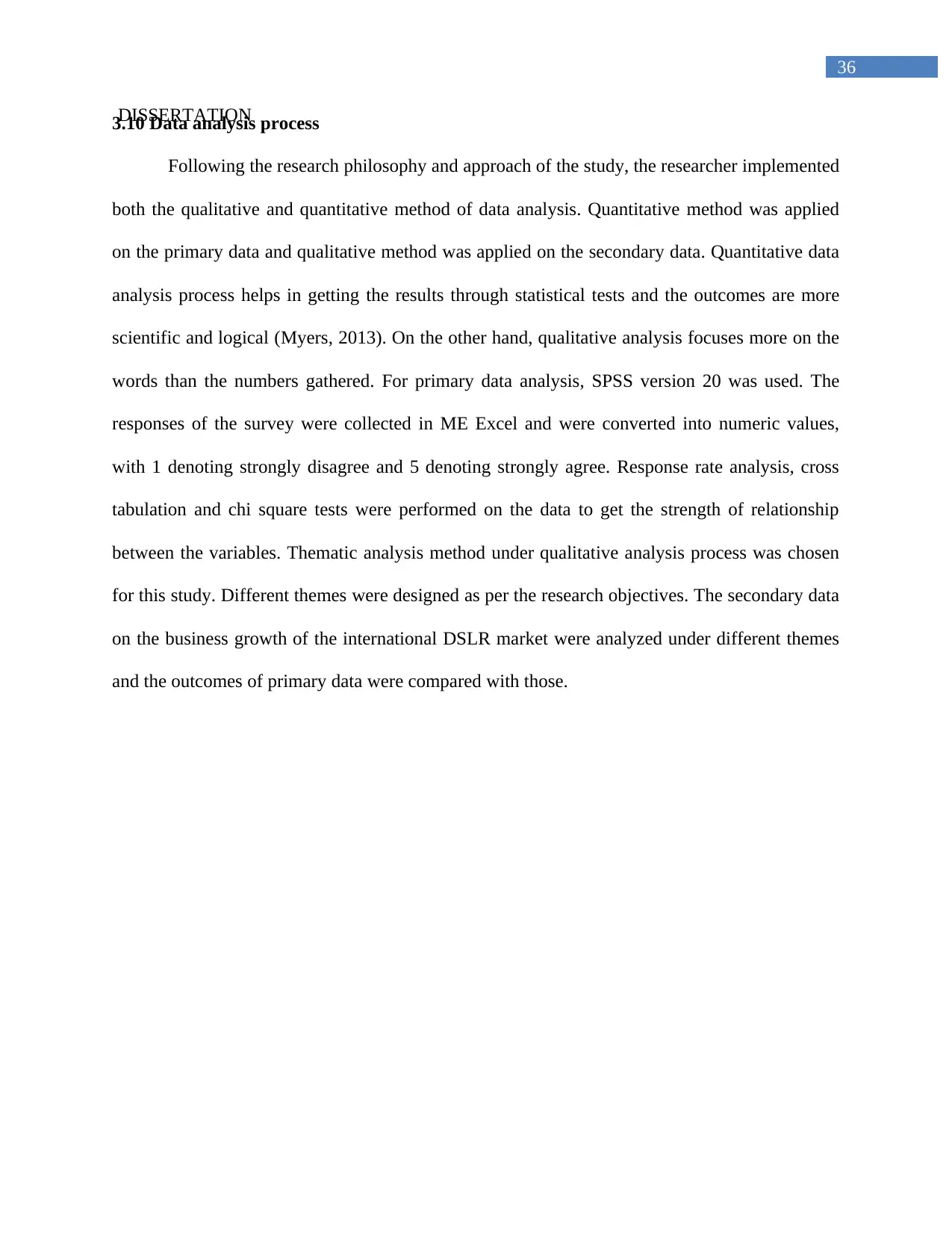
36
DISSERTATION3.10 Data analysis process
Following the research philosophy and approach of the study, the researcher implemented
both the qualitative and quantitative method of data analysis. Quantitative method was applied
on the primary data and qualitative method was applied on the secondary data. Quantitative data
analysis process helps in getting the results through statistical tests and the outcomes are more
scientific and logical (Myers, 2013). On the other hand, qualitative analysis focuses more on the
words than the numbers gathered. For primary data analysis, SPSS version 20 was used. The
responses of the survey were collected in ME Excel and were converted into numeric values,
with 1 denoting strongly disagree and 5 denoting strongly agree. Response rate analysis, cross
tabulation and chi square tests were performed on the data to get the strength of relationship
between the variables. Thematic analysis method under qualitative analysis process was chosen
for this study. Different themes were designed as per the research objectives. The secondary data
on the business growth of the international DSLR market were analyzed under different themes
and the outcomes of primary data were compared with those.
DISSERTATION3.10 Data analysis process
Following the research philosophy and approach of the study, the researcher implemented
both the qualitative and quantitative method of data analysis. Quantitative method was applied
on the primary data and qualitative method was applied on the secondary data. Quantitative data
analysis process helps in getting the results through statistical tests and the outcomes are more
scientific and logical (Myers, 2013). On the other hand, qualitative analysis focuses more on the
words than the numbers gathered. For primary data analysis, SPSS version 20 was used. The
responses of the survey were collected in ME Excel and were converted into numeric values,
with 1 denoting strongly disagree and 5 denoting strongly agree. Response rate analysis, cross
tabulation and chi square tests were performed on the data to get the strength of relationship
between the variables. Thematic analysis method under qualitative analysis process was chosen
for this study. Different themes were designed as per the research objectives. The secondary data
on the business growth of the international DSLR market were analyzed under different themes
and the outcomes of primary data were compared with those.
Paraphrase This Document
Need a fresh take? Get an instant paraphrase of this document with our AI Paraphraser
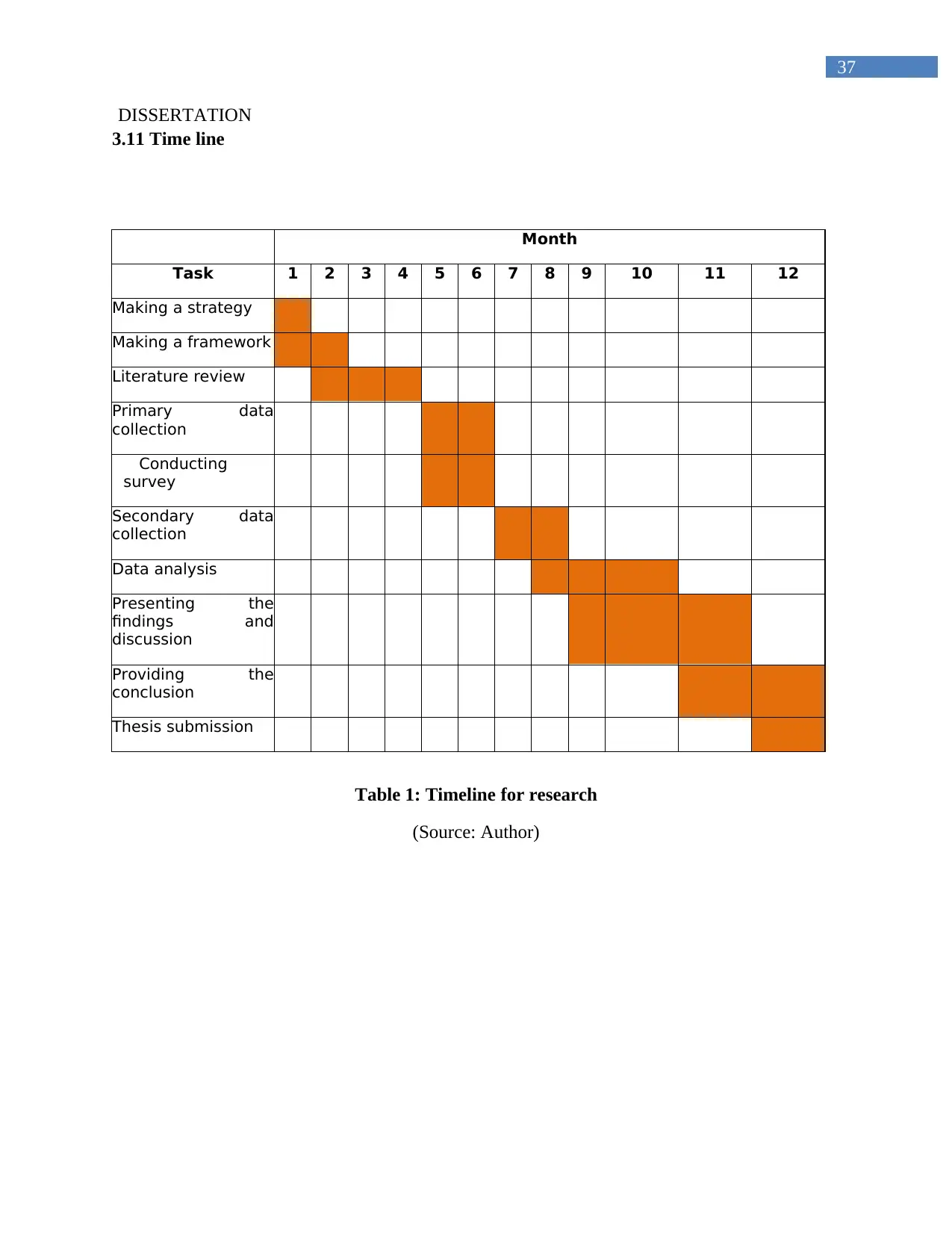
37
DISSERTATION
3.11 Time line
Month
Task 1 2 3 4 5 6 7 8 9 10 11 12
Making a strategy
Making a framework
Literature review
Primary data
collection
Conducting
survey
Secondary data
collection
Data analysis
Presenting the
findings and
discussion
Providing the
conclusion
Thesis submission
Table 1: Timeline for research
(Source: Author)
DISSERTATION
3.11 Time line
Month
Task 1 2 3 4 5 6 7 8 9 10 11 12
Making a strategy
Making a framework
Literature review
Primary data
collection
Conducting
survey
Secondary data
collection
Data analysis
Presenting the
findings and
discussion
Providing the
conclusion
Thesis submission
Table 1: Timeline for research
(Source: Author)
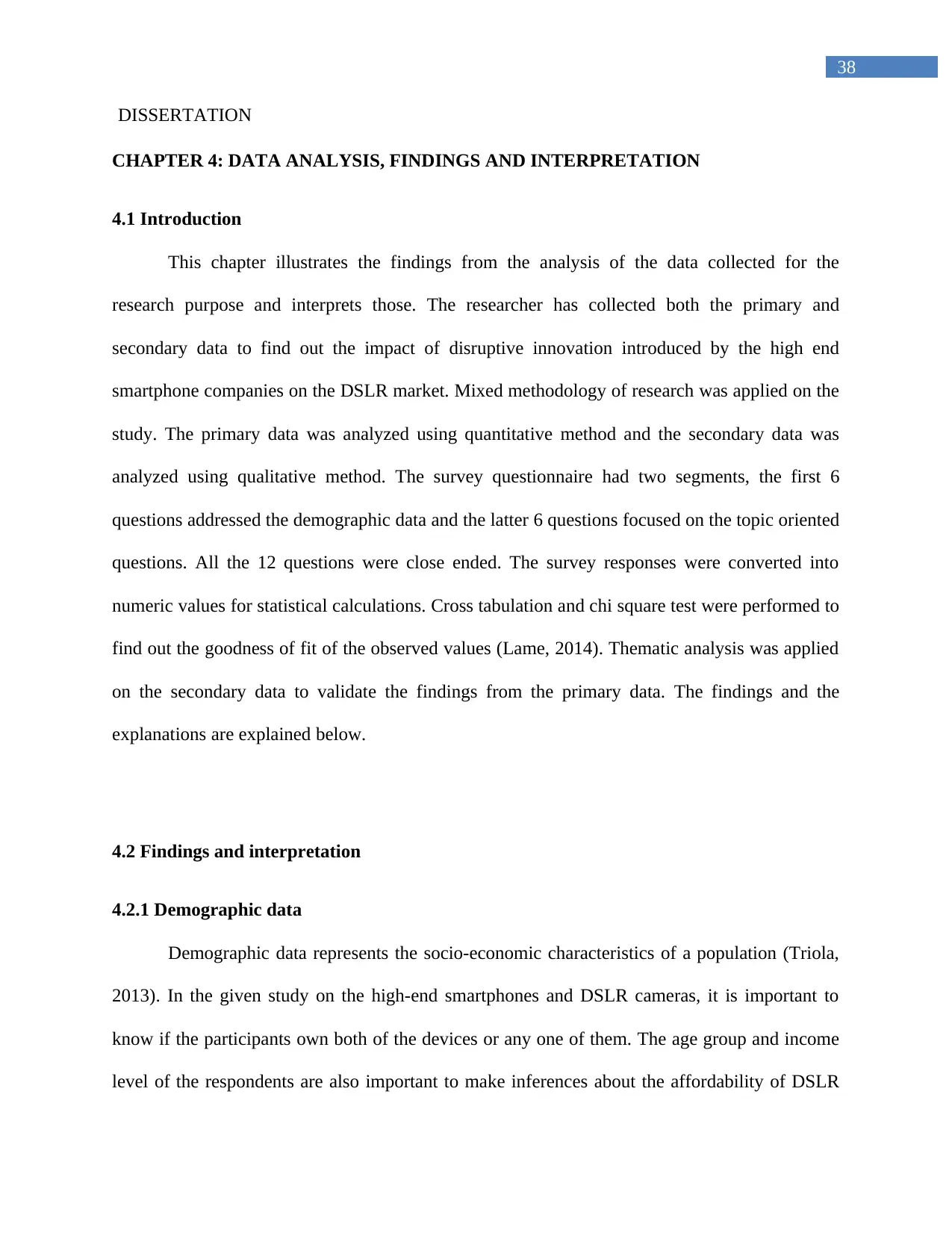
38
DISSERTATION
CHAPTER 4: DATA ANALYSIS, FINDINGS AND INTERPRETATION
4.1 Introduction
This chapter illustrates the findings from the analysis of the data collected for the
research purpose and interprets those. The researcher has collected both the primary and
secondary data to find out the impact of disruptive innovation introduced by the high end
smartphone companies on the DSLR market. Mixed methodology of research was applied on the
study. The primary data was analyzed using quantitative method and the secondary data was
analyzed using qualitative method. The survey questionnaire had two segments, the first 6
questions addressed the demographic data and the latter 6 questions focused on the topic oriented
questions. All the 12 questions were close ended. The survey responses were converted into
numeric values for statistical calculations. Cross tabulation and chi square test were performed to
find out the goodness of fit of the observed values (Lame, 2014). Thematic analysis was applied
on the secondary data to validate the findings from the primary data. The findings and the
explanations are explained below.
4.2 Findings and interpretation
4.2.1 Demographic data
Demographic data represents the socio-economic characteristics of a population (Triola,
2013). In the given study on the high-end smartphones and DSLR cameras, it is important to
know if the participants own both of the devices or any one of them. The age group and income
level of the respondents are also important to make inferences about the affordability of DSLR
DISSERTATION
CHAPTER 4: DATA ANALYSIS, FINDINGS AND INTERPRETATION
4.1 Introduction
This chapter illustrates the findings from the analysis of the data collected for the
research purpose and interprets those. The researcher has collected both the primary and
secondary data to find out the impact of disruptive innovation introduced by the high end
smartphone companies on the DSLR market. Mixed methodology of research was applied on the
study. The primary data was analyzed using quantitative method and the secondary data was
analyzed using qualitative method. The survey questionnaire had two segments, the first 6
questions addressed the demographic data and the latter 6 questions focused on the topic oriented
questions. All the 12 questions were close ended. The survey responses were converted into
numeric values for statistical calculations. Cross tabulation and chi square test were performed to
find out the goodness of fit of the observed values (Lame, 2014). Thematic analysis was applied
on the secondary data to validate the findings from the primary data. The findings and the
explanations are explained below.
4.2 Findings and interpretation
4.2.1 Demographic data
Demographic data represents the socio-economic characteristics of a population (Triola,
2013). In the given study on the high-end smartphones and DSLR cameras, it is important to
know if the participants own both of the devices or any one of them. The age group and income
level of the respondents are also important to make inferences about the affordability of DSLR

39
DISSERTATIONcameras and high-end smartphones and with that the knowledge of people can be estimated. It
also considered the frequency of usage of smartphone cameras and DSLR cameras. These
questions were aimed at gaining an idea about the age, preference, affordability of the
respondents in terms of owning and using smart phones and DSLR cameras. The questions
started with whether the participants owned high-end smartphones with good cameras as well as
DSLR cameras. Eventually, it made progress to other aspects of the research topic.
Do you use high-end smartphones with a good camera
Frequency Percent Valid Percent Cumulative
Percent
Valid
Yes 34 68.0 68.0 68.0
No 16 32.0 32.0 100.0
Total 50 100.0 100.0
Table 2: Possession of high-end smartphones with a good camera
Figure 2: Possession of high-end smartphones with a good camera
DISSERTATIONcameras and high-end smartphones and with that the knowledge of people can be estimated. It
also considered the frequency of usage of smartphone cameras and DSLR cameras. These
questions were aimed at gaining an idea about the age, preference, affordability of the
respondents in terms of owning and using smart phones and DSLR cameras. The questions
started with whether the participants owned high-end smartphones with good cameras as well as
DSLR cameras. Eventually, it made progress to other aspects of the research topic.
Do you use high-end smartphones with a good camera
Frequency Percent Valid Percent Cumulative
Percent
Valid
Yes 34 68.0 68.0 68.0
No 16 32.0 32.0 100.0
Total 50 100.0 100.0
Table 2: Possession of high-end smartphones with a good camera
Figure 2: Possession of high-end smartphones with a good camera
Secure Best Marks with AI Grader
Need help grading? Try our AI Grader for instant feedback on your assignments.
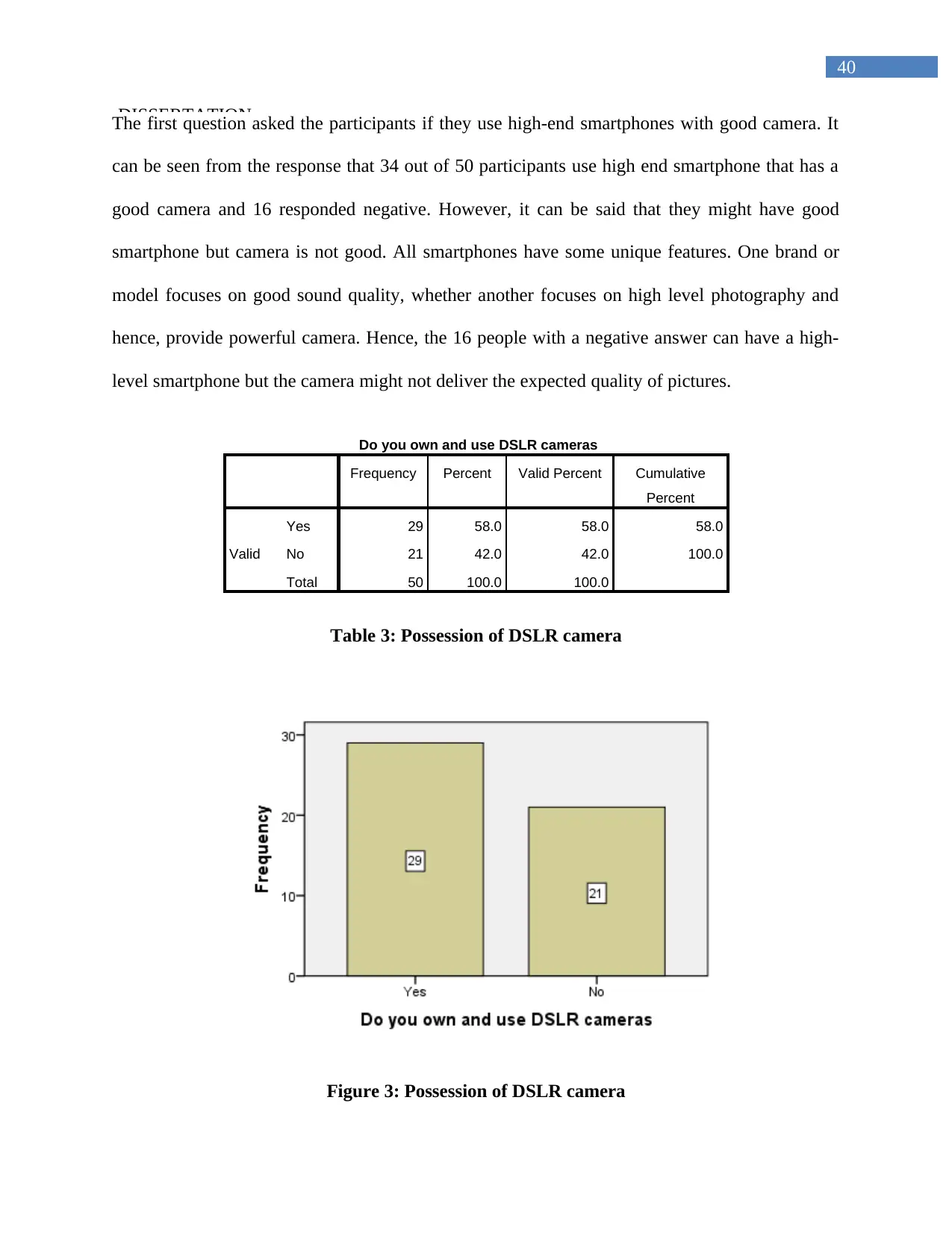
40
DISSERTATIONThe first question asked the participants if they use high-end smartphones with good camera. It
can be seen from the response that 34 out of 50 participants use high end smartphone that has a
good camera and 16 responded negative. However, it can be said that they might have good
smartphone but camera is not good. All smartphones have some unique features. One brand or
model focuses on good sound quality, whether another focuses on high level photography and
hence, provide powerful camera. Hence, the 16 people with a negative answer can have a high-
level smartphone but the camera might not deliver the expected quality of pictures.
Do you own and use DSLR cameras
Frequency Percent Valid Percent Cumulative
Percent
Valid
Yes 29 58.0 58.0 58.0
No 21 42.0 42.0 100.0
Total 50 100.0 100.0
Table 3: Possession of DSLR camera
Figure 3: Possession of DSLR camera
DISSERTATIONThe first question asked the participants if they use high-end smartphones with good camera. It
can be seen from the response that 34 out of 50 participants use high end smartphone that has a
good camera and 16 responded negative. However, it can be said that they might have good
smartphone but camera is not good. All smartphones have some unique features. One brand or
model focuses on good sound quality, whether another focuses on high level photography and
hence, provide powerful camera. Hence, the 16 people with a negative answer can have a high-
level smartphone but the camera might not deliver the expected quality of pictures.
Do you own and use DSLR cameras
Frequency Percent Valid Percent Cumulative
Percent
Valid
Yes 29 58.0 58.0 58.0
No 21 42.0 42.0 100.0
Total 50 100.0 100.0
Table 3: Possession of DSLR camera
Figure 3: Possession of DSLR camera
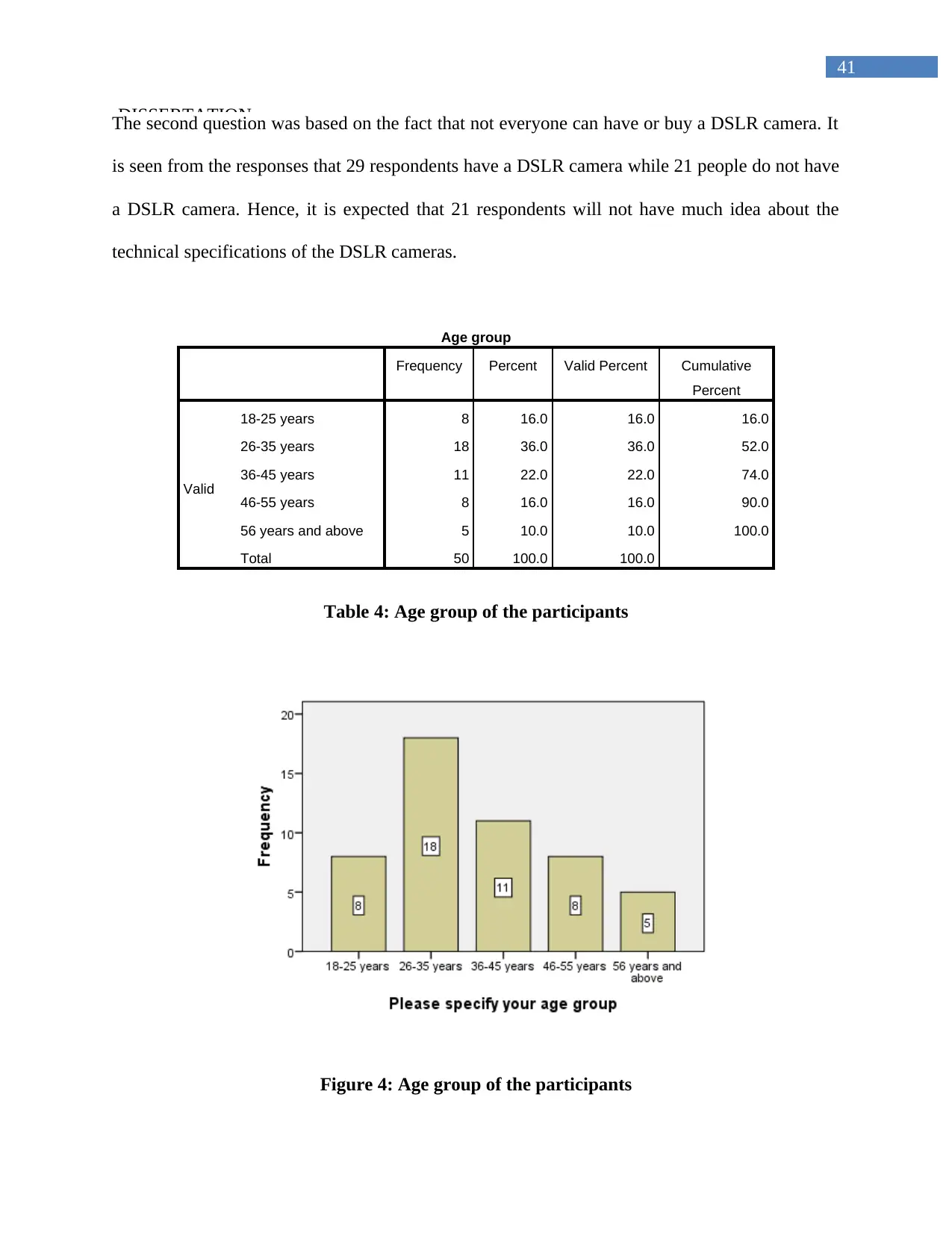
41
DISSERTATIONThe second question was based on the fact that not everyone can have or buy a DSLR camera. It
is seen from the responses that 29 respondents have a DSLR camera while 21 people do not have
a DSLR camera. Hence, it is expected that 21 respondents will not have much idea about the
technical specifications of the DSLR cameras.
Age group
Frequency Percent Valid Percent Cumulative
Percent
Valid
18-25 years 8 16.0 16.0 16.0
26-35 years 18 36.0 36.0 52.0
36-45 years 11 22.0 22.0 74.0
46-55 years 8 16.0 16.0 90.0
56 years and above 5 10.0 10.0 100.0
Total 50 100.0 100.0
Table 4: Age group of the participants
Figure 4: Age group of the participants
DISSERTATIONThe second question was based on the fact that not everyone can have or buy a DSLR camera. It
is seen from the responses that 29 respondents have a DSLR camera while 21 people do not have
a DSLR camera. Hence, it is expected that 21 respondents will not have much idea about the
technical specifications of the DSLR cameras.
Age group
Frequency Percent Valid Percent Cumulative
Percent
Valid
18-25 years 8 16.0 16.0 16.0
26-35 years 18 36.0 36.0 52.0
36-45 years 11 22.0 22.0 74.0
46-55 years 8 16.0 16.0 90.0
56 years and above 5 10.0 10.0 100.0
Total 50 100.0 100.0
Table 4: Age group of the participants
Figure 4: Age group of the participants
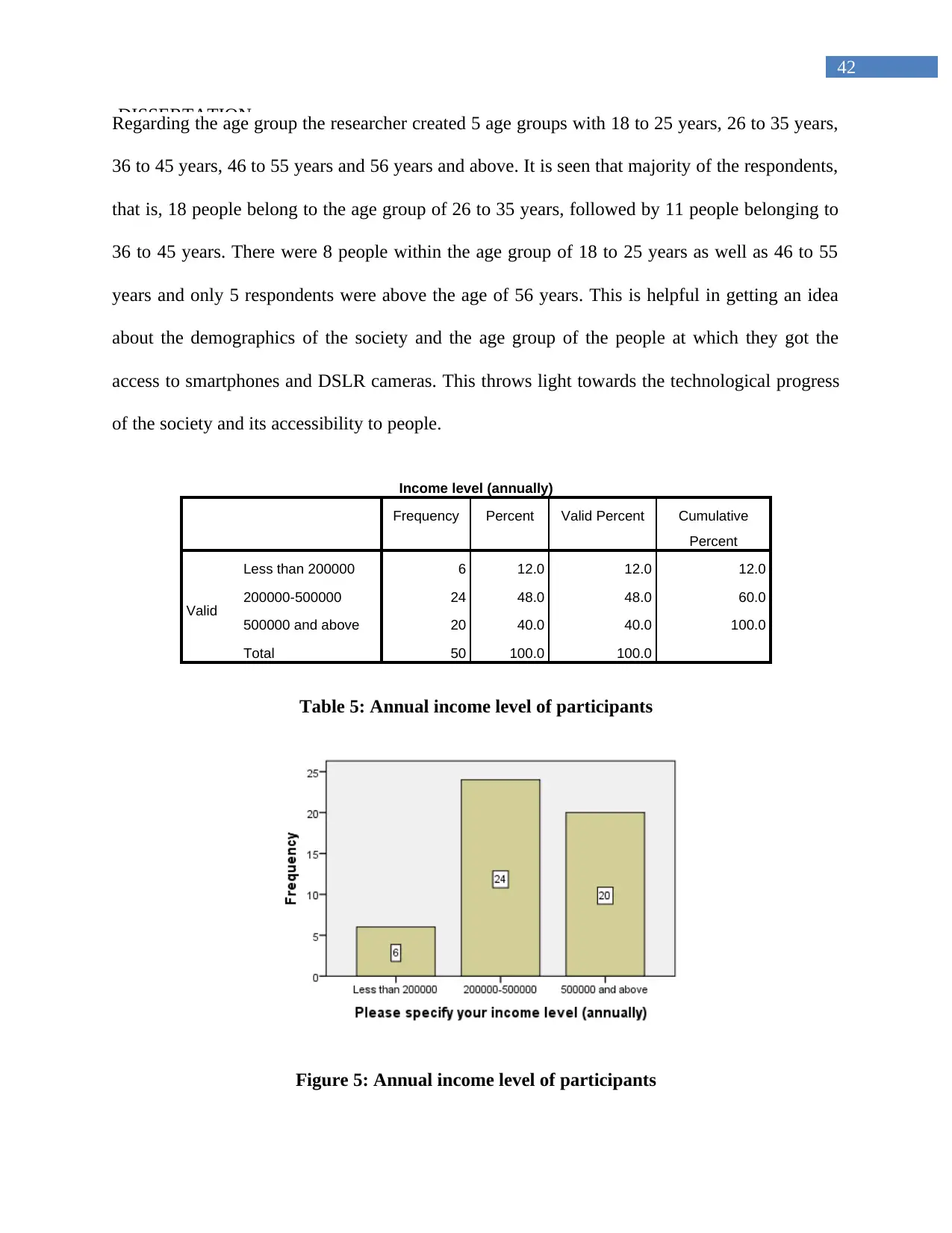
42
DISSERTATIONRegarding the age group the researcher created 5 age groups with 18 to 25 years, 26 to 35 years,
36 to 45 years, 46 to 55 years and 56 years and above. It is seen that majority of the respondents,
that is, 18 people belong to the age group of 26 to 35 years, followed by 11 people belonging to
36 to 45 years. There were 8 people within the age group of 18 to 25 years as well as 46 to 55
years and only 5 respondents were above the age of 56 years. This is helpful in getting an idea
about the demographics of the society and the age group of the people at which they got the
access to smartphones and DSLR cameras. This throws light towards the technological progress
of the society and its accessibility to people.
Income level (annually)
Frequency Percent Valid Percent Cumulative
Percent
Valid
Less than 200000 6 12.0 12.0 12.0
200000-500000 24 48.0 48.0 60.0
500000 and above 20 40.0 40.0 100.0
Total 50 100.0 100.0
Table 5: Annual income level of participants
Figure 5: Annual income level of participants
DISSERTATIONRegarding the age group the researcher created 5 age groups with 18 to 25 years, 26 to 35 years,
36 to 45 years, 46 to 55 years and 56 years and above. It is seen that majority of the respondents,
that is, 18 people belong to the age group of 26 to 35 years, followed by 11 people belonging to
36 to 45 years. There were 8 people within the age group of 18 to 25 years as well as 46 to 55
years and only 5 respondents were above the age of 56 years. This is helpful in getting an idea
about the demographics of the society and the age group of the people at which they got the
access to smartphones and DSLR cameras. This throws light towards the technological progress
of the society and its accessibility to people.
Income level (annually)
Frequency Percent Valid Percent Cumulative
Percent
Valid
Less than 200000 6 12.0 12.0 12.0
200000-500000 24 48.0 48.0 60.0
500000 and above 20 40.0 40.0 100.0
Total 50 100.0 100.0
Table 5: Annual income level of participants
Figure 5: Annual income level of participants
Paraphrase This Document
Need a fresh take? Get an instant paraphrase of this document with our AI Paraphraser
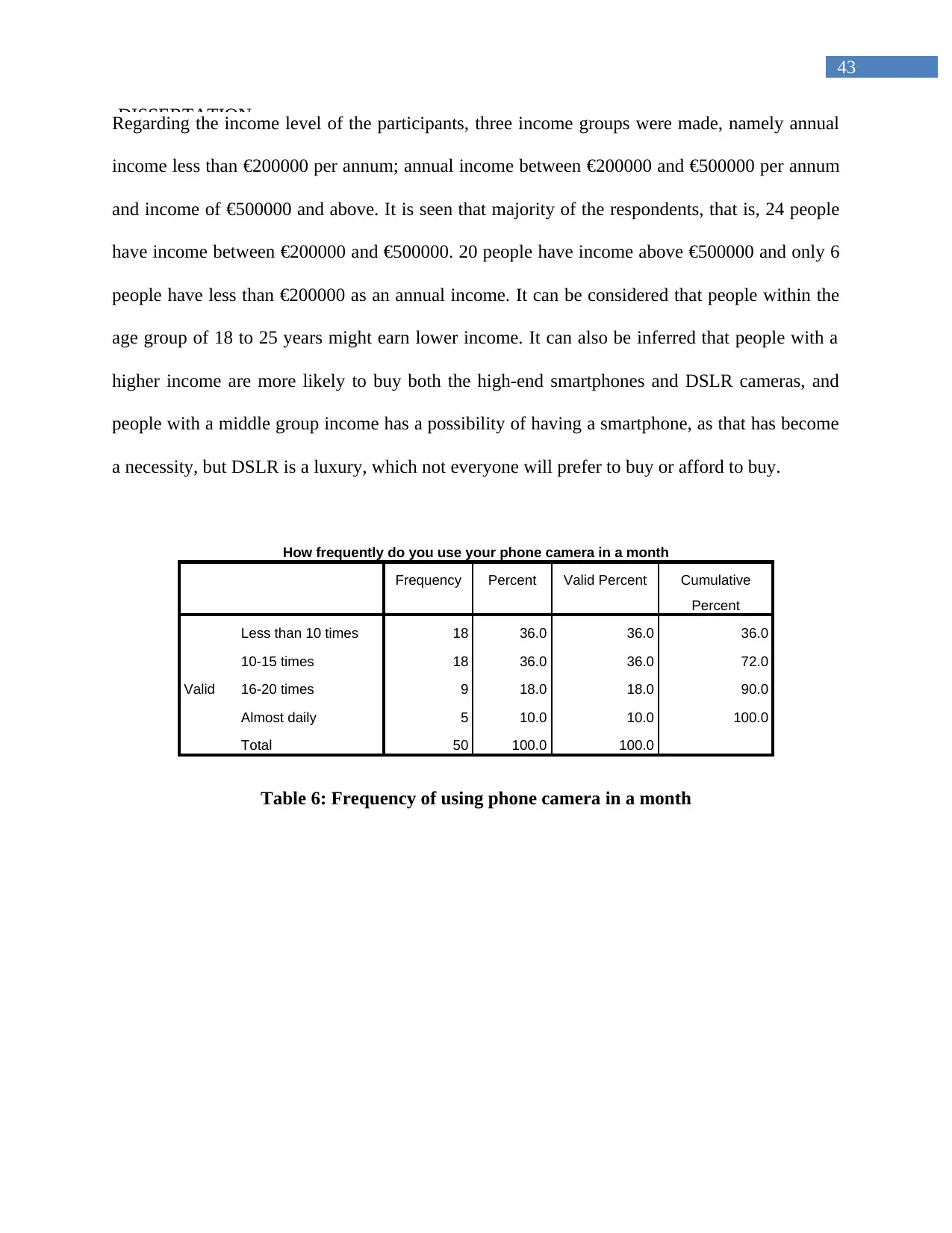
43
DISSERTATIONRegarding the income level of the participants, three income groups were made, namely annual
income less than €200000 per annum; annual income between €200000 and €500000 per annum
and income of €500000 and above. It is seen that majority of the respondents, that is, 24 people
have income between €200000 and €500000. 20 people have income above €500000 and only 6
people have less than €200000 as an annual income. It can be considered that people within the
age group of 18 to 25 years might earn lower income. It can also be inferred that people with a
higher income are more likely to buy both the high-end smartphones and DSLR cameras, and
people with a middle group income has a possibility of having a smartphone, as that has become
a necessity, but DSLR is a luxury, which not everyone will prefer to buy or afford to buy.
How frequently do you use your phone camera in a month
Frequency Percent Valid Percent Cumulative
Percent
Valid
Less than 10 times 18 36.0 36.0 36.0
10-15 times 18 36.0 36.0 72.0
16-20 times 9 18.0 18.0 90.0
Almost daily 5 10.0 10.0 100.0
Total 50 100.0 100.0
Table 6: Frequency of using phone camera in a month
DISSERTATIONRegarding the income level of the participants, three income groups were made, namely annual
income less than €200000 per annum; annual income between €200000 and €500000 per annum
and income of €500000 and above. It is seen that majority of the respondents, that is, 24 people
have income between €200000 and €500000. 20 people have income above €500000 and only 6
people have less than €200000 as an annual income. It can be considered that people within the
age group of 18 to 25 years might earn lower income. It can also be inferred that people with a
higher income are more likely to buy both the high-end smartphones and DSLR cameras, and
people with a middle group income has a possibility of having a smartphone, as that has become
a necessity, but DSLR is a luxury, which not everyone will prefer to buy or afford to buy.
How frequently do you use your phone camera in a month
Frequency Percent Valid Percent Cumulative
Percent
Valid
Less than 10 times 18 36.0 36.0 36.0
10-15 times 18 36.0 36.0 72.0
16-20 times 9 18.0 18.0 90.0
Almost daily 5 10.0 10.0 100.0
Total 50 100.0 100.0
Table 6: Frequency of using phone camera in a month
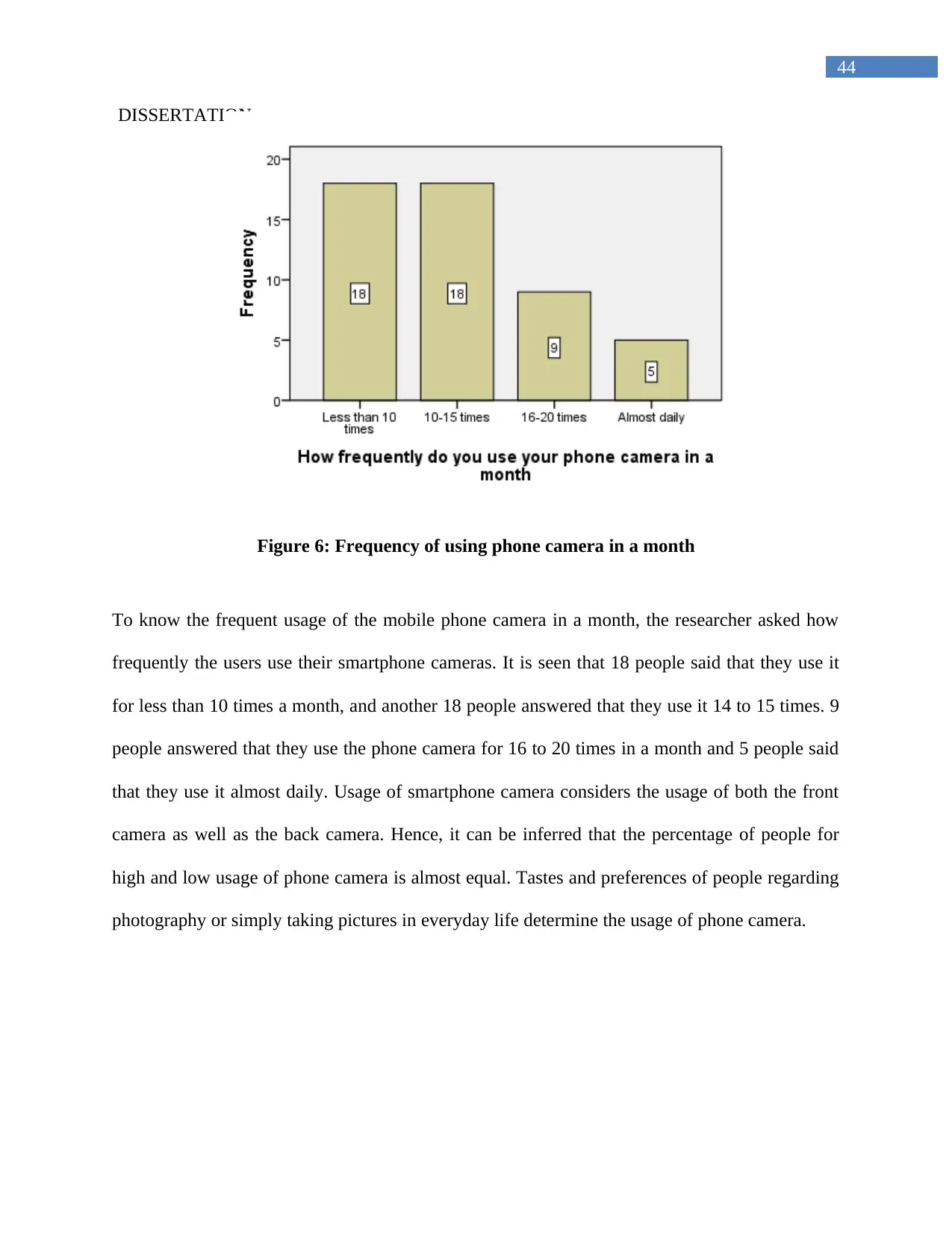
44
DISSERTATION
Figure 6: Frequency of using phone camera in a month
To know the frequent usage of the mobile phone camera in a month, the researcher asked how
frequently the users use their smartphone cameras. It is seen that 18 people said that they use it
for less than 10 times a month, and another 18 people answered that they use it 14 to 15 times. 9
people answered that they use the phone camera for 16 to 20 times in a month and 5 people said
that they use it almost daily. Usage of smartphone camera considers the usage of both the front
camera as well as the back camera. Hence, it can be inferred that the percentage of people for
high and low usage of phone camera is almost equal. Tastes and preferences of people regarding
photography or simply taking pictures in everyday life determine the usage of phone camera.
DISSERTATION
Figure 6: Frequency of using phone camera in a month
To know the frequent usage of the mobile phone camera in a month, the researcher asked how
frequently the users use their smartphone cameras. It is seen that 18 people said that they use it
for less than 10 times a month, and another 18 people answered that they use it 14 to 15 times. 9
people answered that they use the phone camera for 16 to 20 times in a month and 5 people said
that they use it almost daily. Usage of smartphone camera considers the usage of both the front
camera as well as the back camera. Hence, it can be inferred that the percentage of people for
high and low usage of phone camera is almost equal. Tastes and preferences of people regarding
photography or simply taking pictures in everyday life determine the usage of phone camera.
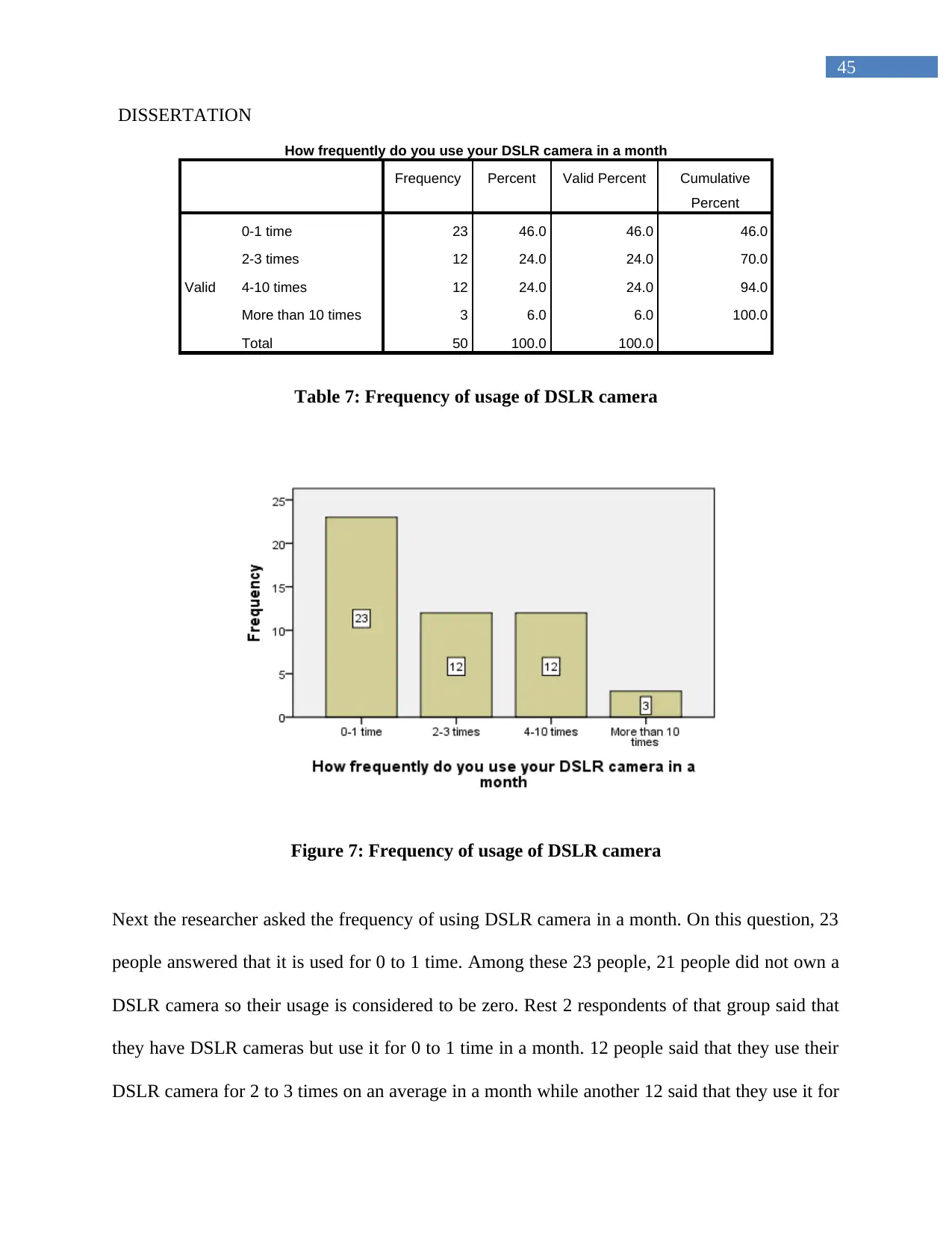
45
DISSERTATION
How frequently do you use your DSLR camera in a month
Frequency Percent Valid Percent Cumulative
Percent
Valid
0-1 time 23 46.0 46.0 46.0
2-3 times 12 24.0 24.0 70.0
4-10 times 12 24.0 24.0 94.0
More than 10 times 3 6.0 6.0 100.0
Total 50 100.0 100.0
Table 7: Frequency of usage of DSLR camera
Figure 7: Frequency of usage of DSLR camera
Next the researcher asked the frequency of using DSLR camera in a month. On this question, 23
people answered that it is used for 0 to 1 time. Among these 23 people, 21 people did not own a
DSLR camera so their usage is considered to be zero. Rest 2 respondents of that group said that
they have DSLR cameras but use it for 0 to 1 time in a month. 12 people said that they use their
DSLR camera for 2 to 3 times on an average in a month while another 12 said that they use it for
DISSERTATION
How frequently do you use your DSLR camera in a month
Frequency Percent Valid Percent Cumulative
Percent
Valid
0-1 time 23 46.0 46.0 46.0
2-3 times 12 24.0 24.0 70.0
4-10 times 12 24.0 24.0 94.0
More than 10 times 3 6.0 6.0 100.0
Total 50 100.0 100.0
Table 7: Frequency of usage of DSLR camera
Figure 7: Frequency of usage of DSLR camera
Next the researcher asked the frequency of using DSLR camera in a month. On this question, 23
people answered that it is used for 0 to 1 time. Among these 23 people, 21 people did not own a
DSLR camera so their usage is considered to be zero. Rest 2 respondents of that group said that
they have DSLR cameras but use it for 0 to 1 time in a month. 12 people said that they use their
DSLR camera for 2 to 3 times on an average in a month while another 12 said that they use it for
Secure Best Marks with AI Grader
Need help grading? Try our AI Grader for instant feedback on your assignments.
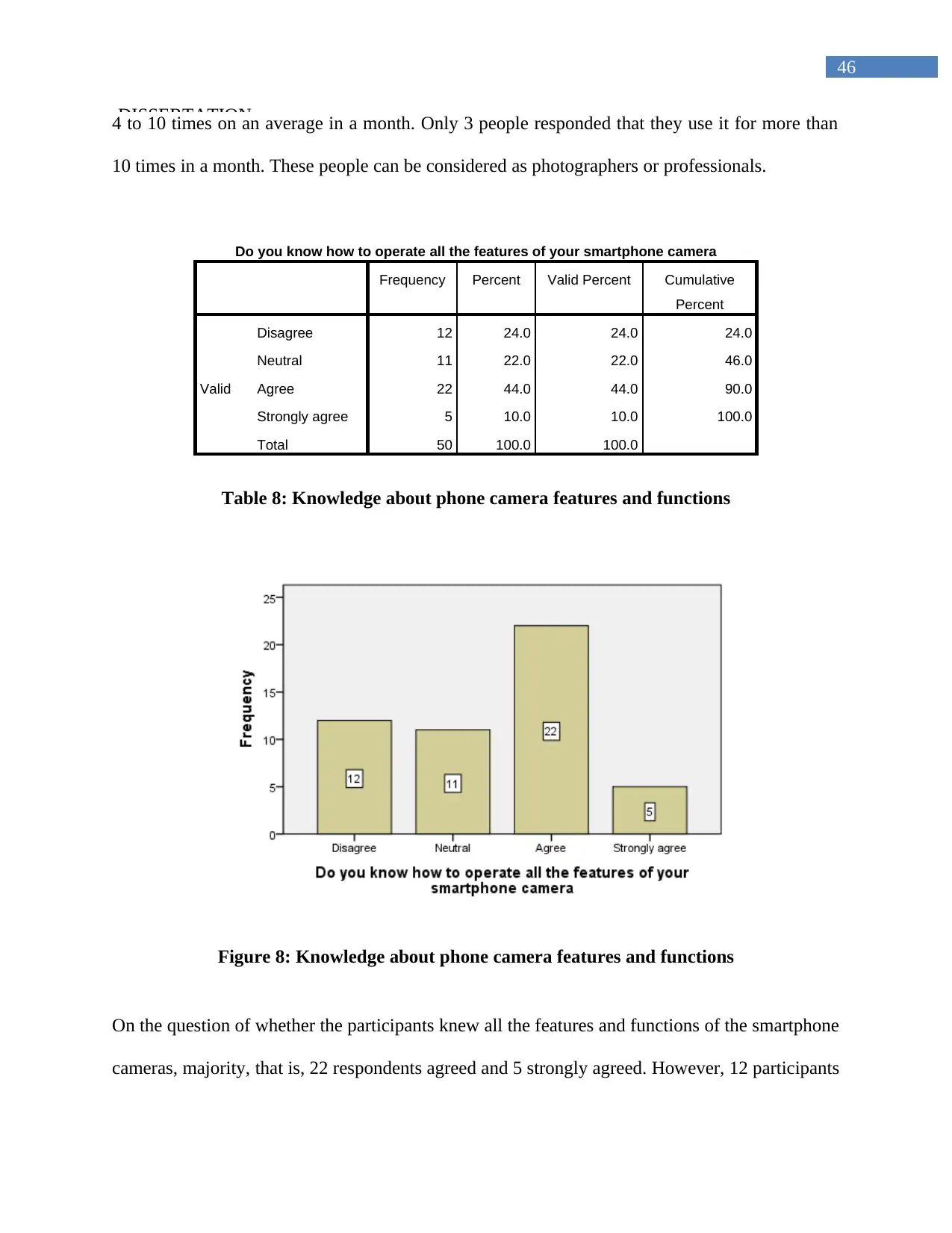
46
DISSERTATION4 to 10 times on an average in a month. Only 3 people responded that they use it for more than
10 times in a month. These people can be considered as photographers or professionals.
Do you know how to operate all the features of your smartphone camera
Frequency Percent Valid Percent Cumulative
Percent
Valid
Disagree 12 24.0 24.0 24.0
Neutral 11 22.0 22.0 46.0
Agree 22 44.0 44.0 90.0
Strongly agree 5 10.0 10.0 100.0
Total 50 100.0 100.0
Table 8: Knowledge about phone camera features and functions
Figure 8: Knowledge about phone camera features and functions
On the question of whether the participants knew all the features and functions of the smartphone
cameras, majority, that is, 22 respondents agreed and 5 strongly agreed. However, 12 participants
DISSERTATION4 to 10 times on an average in a month. Only 3 people responded that they use it for more than
10 times in a month. These people can be considered as photographers or professionals.
Do you know how to operate all the features of your smartphone camera
Frequency Percent Valid Percent Cumulative
Percent
Valid
Disagree 12 24.0 24.0 24.0
Neutral 11 22.0 22.0 46.0
Agree 22 44.0 44.0 90.0
Strongly agree 5 10.0 10.0 100.0
Total 50 100.0 100.0
Table 8: Knowledge about phone camera features and functions
Figure 8: Knowledge about phone camera features and functions
On the question of whether the participants knew all the features and functions of the smartphone
cameras, majority, that is, 22 respondents agreed and 5 strongly agreed. However, 12 participants
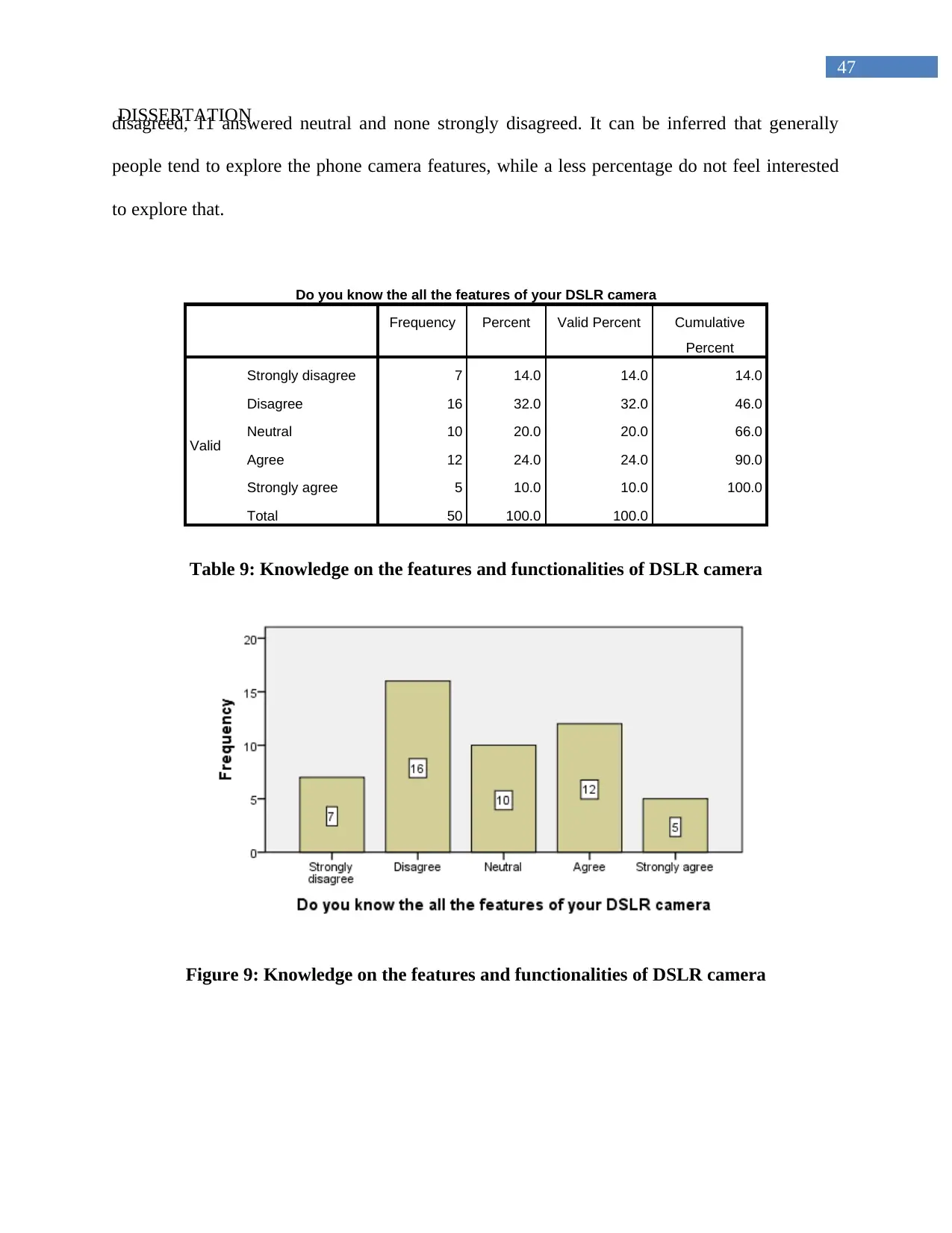
47
DISSERTATIONdisagreed, 11 answered neutral and none strongly disagreed. It can be inferred that generally
people tend to explore the phone camera features, while a less percentage do not feel interested
to explore that.
Do you know the all the features of your DSLR camera
Frequency Percent Valid Percent Cumulative
Percent
Valid
Strongly disagree 7 14.0 14.0 14.0
Disagree 16 32.0 32.0 46.0
Neutral 10 20.0 20.0 66.0
Agree 12 24.0 24.0 90.0
Strongly agree 5 10.0 10.0 100.0
Total 50 100.0 100.0
Table 9: Knowledge on the features and functionalities of DSLR camera
Figure 9: Knowledge on the features and functionalities of DSLR camera
DISSERTATIONdisagreed, 11 answered neutral and none strongly disagreed. It can be inferred that generally
people tend to explore the phone camera features, while a less percentage do not feel interested
to explore that.
Do you know the all the features of your DSLR camera
Frequency Percent Valid Percent Cumulative
Percent
Valid
Strongly disagree 7 14.0 14.0 14.0
Disagree 16 32.0 32.0 46.0
Neutral 10 20.0 20.0 66.0
Agree 12 24.0 24.0 90.0
Strongly agree 5 10.0 10.0 100.0
Total 50 100.0 100.0
Table 9: Knowledge on the features and functionalities of DSLR camera
Figure 9: Knowledge on the features and functionalities of DSLR camera
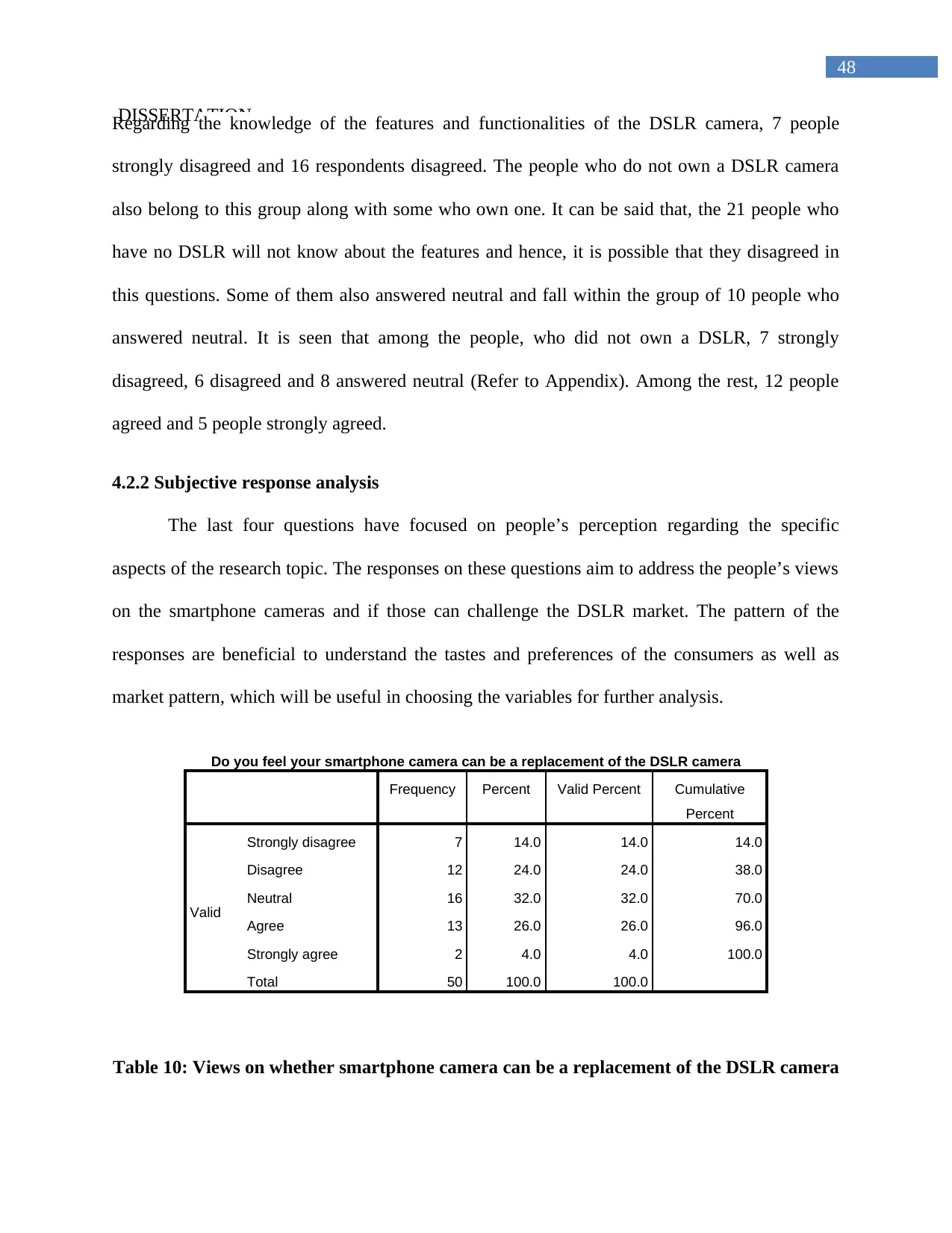
48
DISSERTATIONRegarding the knowledge of the features and functionalities of the DSLR camera, 7 people
strongly disagreed and 16 respondents disagreed. The people who do not own a DSLR camera
also belong to this group along with some who own one. It can be said that, the 21 people who
have no DSLR will not know about the features and hence, it is possible that they disagreed in
this questions. Some of them also answered neutral and fall within the group of 10 people who
answered neutral. It is seen that among the people, who did not own a DSLR, 7 strongly
disagreed, 6 disagreed and 8 answered neutral (Refer to Appendix). Among the rest, 12 people
agreed and 5 people strongly agreed.
4.2.2 Subjective response analysis
The last four questions have focused on people’s perception regarding the specific
aspects of the research topic. The responses on these questions aim to address the people’s views
on the smartphone cameras and if those can challenge the DSLR market. The pattern of the
responses are beneficial to understand the tastes and preferences of the consumers as well as
market pattern, which will be useful in choosing the variables for further analysis.
Do you feel your smartphone camera can be a replacement of the DSLR camera
Frequency Percent Valid Percent Cumulative
Percent
Valid
Strongly disagree 7 14.0 14.0 14.0
Disagree 12 24.0 24.0 38.0
Neutral 16 32.0 32.0 70.0
Agree 13 26.0 26.0 96.0
Strongly agree 2 4.0 4.0 100.0
Total 50 100.0 100.0
Table 10: Views on whether smartphone camera can be a replacement of the DSLR camera
DISSERTATIONRegarding the knowledge of the features and functionalities of the DSLR camera, 7 people
strongly disagreed and 16 respondents disagreed. The people who do not own a DSLR camera
also belong to this group along with some who own one. It can be said that, the 21 people who
have no DSLR will not know about the features and hence, it is possible that they disagreed in
this questions. Some of them also answered neutral and fall within the group of 10 people who
answered neutral. It is seen that among the people, who did not own a DSLR, 7 strongly
disagreed, 6 disagreed and 8 answered neutral (Refer to Appendix). Among the rest, 12 people
agreed and 5 people strongly agreed.
4.2.2 Subjective response analysis
The last four questions have focused on people’s perception regarding the specific
aspects of the research topic. The responses on these questions aim to address the people’s views
on the smartphone cameras and if those can challenge the DSLR market. The pattern of the
responses are beneficial to understand the tastes and preferences of the consumers as well as
market pattern, which will be useful in choosing the variables for further analysis.
Do you feel your smartphone camera can be a replacement of the DSLR camera
Frequency Percent Valid Percent Cumulative
Percent
Valid
Strongly disagree 7 14.0 14.0 14.0
Disagree 12 24.0 24.0 38.0
Neutral 16 32.0 32.0 70.0
Agree 13 26.0 26.0 96.0
Strongly agree 2 4.0 4.0 100.0
Total 50 100.0 100.0
Table 10: Views on whether smartphone camera can be a replacement of the DSLR camera
Paraphrase This Document
Need a fresh take? Get an instant paraphrase of this document with our AI Paraphraser
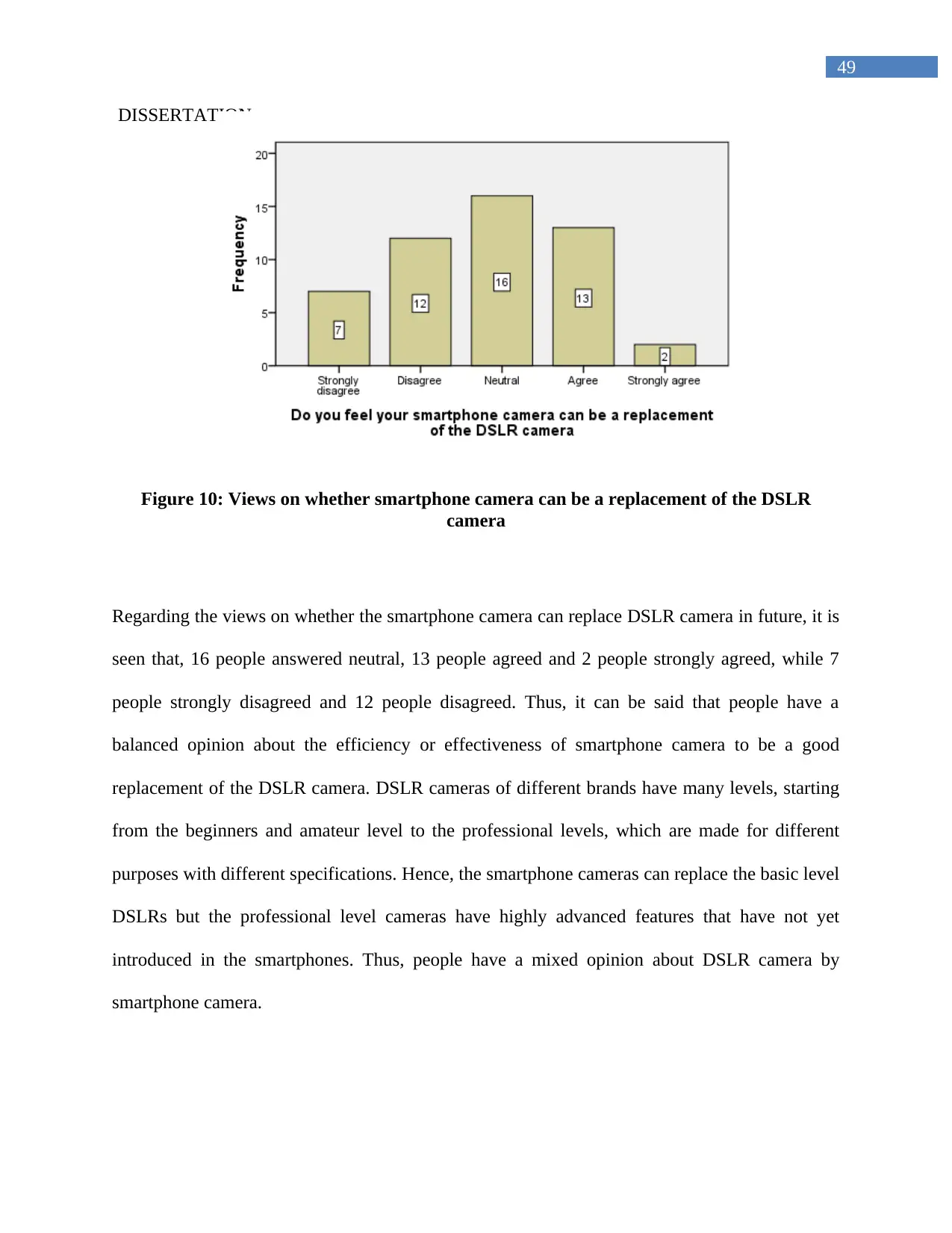
49
DISSERTATION
Figure 10: Views on whether smartphone camera can be a replacement of the DSLR
camera
Regarding the views on whether the smartphone camera can replace DSLR camera in future, it is
seen that, 16 people answered neutral, 13 people agreed and 2 people strongly agreed, while 7
people strongly disagreed and 12 people disagreed. Thus, it can be said that people have a
balanced opinion about the efficiency or effectiveness of smartphone camera to be a good
replacement of the DSLR camera. DSLR cameras of different brands have many levels, starting
from the beginners and amateur level to the professional levels, which are made for different
purposes with different specifications. Hence, the smartphone cameras can replace the basic level
DSLRs but the professional level cameras have highly advanced features that have not yet
introduced in the smartphones. Thus, people have a mixed opinion about DSLR camera by
smartphone camera.
DISSERTATION
Figure 10: Views on whether smartphone camera can be a replacement of the DSLR
camera
Regarding the views on whether the smartphone camera can replace DSLR camera in future, it is
seen that, 16 people answered neutral, 13 people agreed and 2 people strongly agreed, while 7
people strongly disagreed and 12 people disagreed. Thus, it can be said that people have a
balanced opinion about the efficiency or effectiveness of smartphone camera to be a good
replacement of the DSLR camera. DSLR cameras of different brands have many levels, starting
from the beginners and amateur level to the professional levels, which are made for different
purposes with different specifications. Hence, the smartphone cameras can replace the basic level
DSLRs but the professional level cameras have highly advanced features that have not yet
introduced in the smartphones. Thus, people have a mixed opinion about DSLR camera by
smartphone camera.
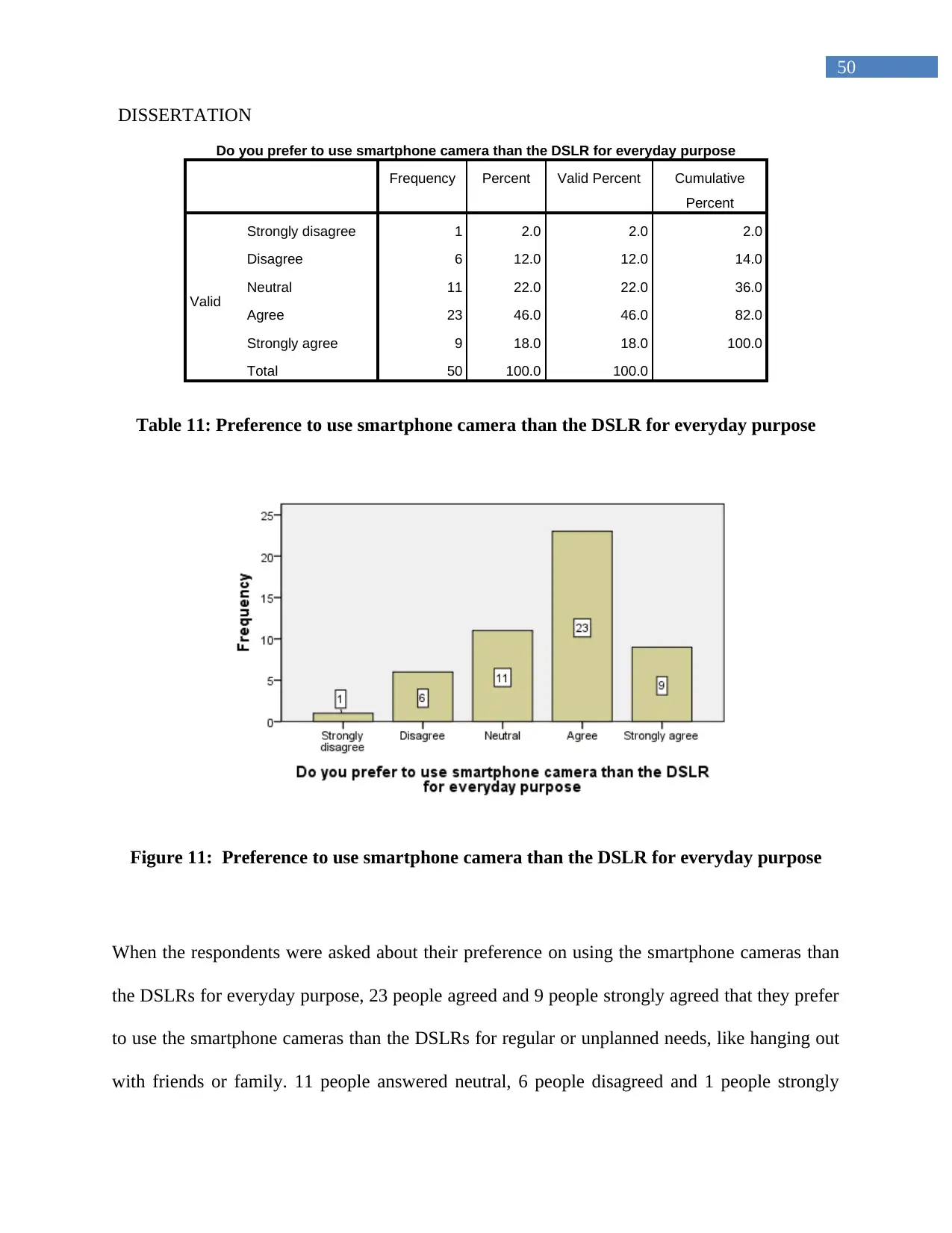
50
DISSERTATION
Do you prefer to use smartphone camera than the DSLR for everyday purpose
Frequency Percent Valid Percent Cumulative
Percent
Valid
Strongly disagree 1 2.0 2.0 2.0
Disagree 6 12.0 12.0 14.0
Neutral 11 22.0 22.0 36.0
Agree 23 46.0 46.0 82.0
Strongly agree 9 18.0 18.0 100.0
Total 50 100.0 100.0
Table 11: Preference to use smartphone camera than the DSLR for everyday purpose
Figure 11: Preference to use smartphone camera than the DSLR for everyday purpose
When the respondents were asked about their preference on using the smartphone cameras than
the DSLRs for everyday purpose, 23 people agreed and 9 people strongly agreed that they prefer
to use the smartphone cameras than the DSLRs for regular or unplanned needs, like hanging out
with friends or family. 11 people answered neutral, 6 people disagreed and 1 people strongly
DISSERTATION
Do you prefer to use smartphone camera than the DSLR for everyday purpose
Frequency Percent Valid Percent Cumulative
Percent
Valid
Strongly disagree 1 2.0 2.0 2.0
Disagree 6 12.0 12.0 14.0
Neutral 11 22.0 22.0 36.0
Agree 23 46.0 46.0 82.0
Strongly agree 9 18.0 18.0 100.0
Total 50 100.0 100.0
Table 11: Preference to use smartphone camera than the DSLR for everyday purpose
Figure 11: Preference to use smartphone camera than the DSLR for everyday purpose
When the respondents were asked about their preference on using the smartphone cameras than
the DSLRs for everyday purpose, 23 people agreed and 9 people strongly agreed that they prefer
to use the smartphone cameras than the DSLRs for regular or unplanned needs, like hanging out
with friends or family. 11 people answered neutral, 6 people disagreed and 1 people strongly

51
DISSERTATIONdisagreed to this. Thus, it can be inferred that people do not want to carry a big DSLR camera for
everyday purpose unless they are professional photographers or have any planned purpose for
photography.
For any good photography purpose, do you like to use your DSLR camera
Frequency Percent Valid Percent Cumulative
Percent
Valid
Disagree 5 10.0 10.0 10.0
Neutral 23 46.0 46.0 56.0
Agree 13 26.0 26.0 82.0
Strongly agree 9 18.0 18.0 100.0
Total 50 100.0 100.0
Table 12: Preference for DSLR camera for any good or planned photography purpose
Figure 12: Preference for DSLR camera for any good or planned photography purpose
DISSERTATIONdisagreed to this. Thus, it can be inferred that people do not want to carry a big DSLR camera for
everyday purpose unless they are professional photographers or have any planned purpose for
photography.
For any good photography purpose, do you like to use your DSLR camera
Frequency Percent Valid Percent Cumulative
Percent
Valid
Disagree 5 10.0 10.0 10.0
Neutral 23 46.0 46.0 56.0
Agree 13 26.0 26.0 82.0
Strongly agree 9 18.0 18.0 100.0
Total 50 100.0 100.0
Table 12: Preference for DSLR camera for any good or planned photography purpose
Figure 12: Preference for DSLR camera for any good or planned photography purpose
Secure Best Marks with AI Grader
Need help grading? Try our AI Grader for instant feedback on your assignments.
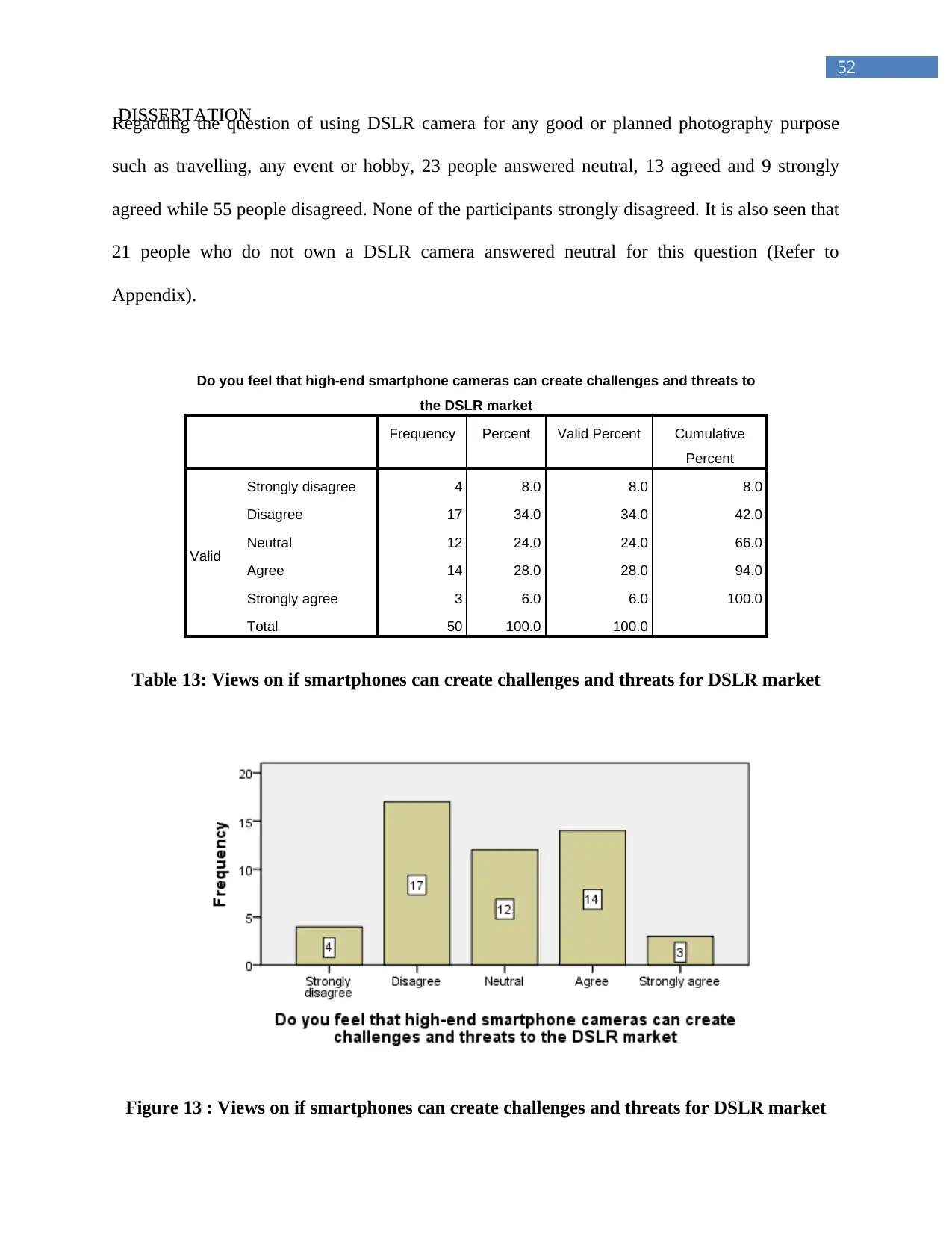
52
DISSERTATIONRegarding the question of using DSLR camera for any good or planned photography purpose
such as travelling, any event or hobby, 23 people answered neutral, 13 agreed and 9 strongly
agreed while 55 people disagreed. None of the participants strongly disagreed. It is also seen that
21 people who do not own a DSLR camera answered neutral for this question (Refer to
Appendix).
Do you feel that high-end smartphone cameras can create challenges and threats to
the DSLR market
Frequency Percent Valid Percent Cumulative
Percent
Valid
Strongly disagree 4 8.0 8.0 8.0
Disagree 17 34.0 34.0 42.0
Neutral 12 24.0 24.0 66.0
Agree 14 28.0 28.0 94.0
Strongly agree 3 6.0 6.0 100.0
Total 50 100.0 100.0
Table 13: Views on if smartphones can create challenges and threats for DSLR market
Figure 13 : Views on if smartphones can create challenges and threats for DSLR market
DISSERTATIONRegarding the question of using DSLR camera for any good or planned photography purpose
such as travelling, any event or hobby, 23 people answered neutral, 13 agreed and 9 strongly
agreed while 55 people disagreed. None of the participants strongly disagreed. It is also seen that
21 people who do not own a DSLR camera answered neutral for this question (Refer to
Appendix).
Do you feel that high-end smartphone cameras can create challenges and threats to
the DSLR market
Frequency Percent Valid Percent Cumulative
Percent
Valid
Strongly disagree 4 8.0 8.0 8.0
Disagree 17 34.0 34.0 42.0
Neutral 12 24.0 24.0 66.0
Agree 14 28.0 28.0 94.0
Strongly agree 3 6.0 6.0 100.0
Total 50 100.0 100.0
Table 13: Views on if smartphones can create challenges and threats for DSLR market
Figure 13 : Views on if smartphones can create challenges and threats for DSLR market
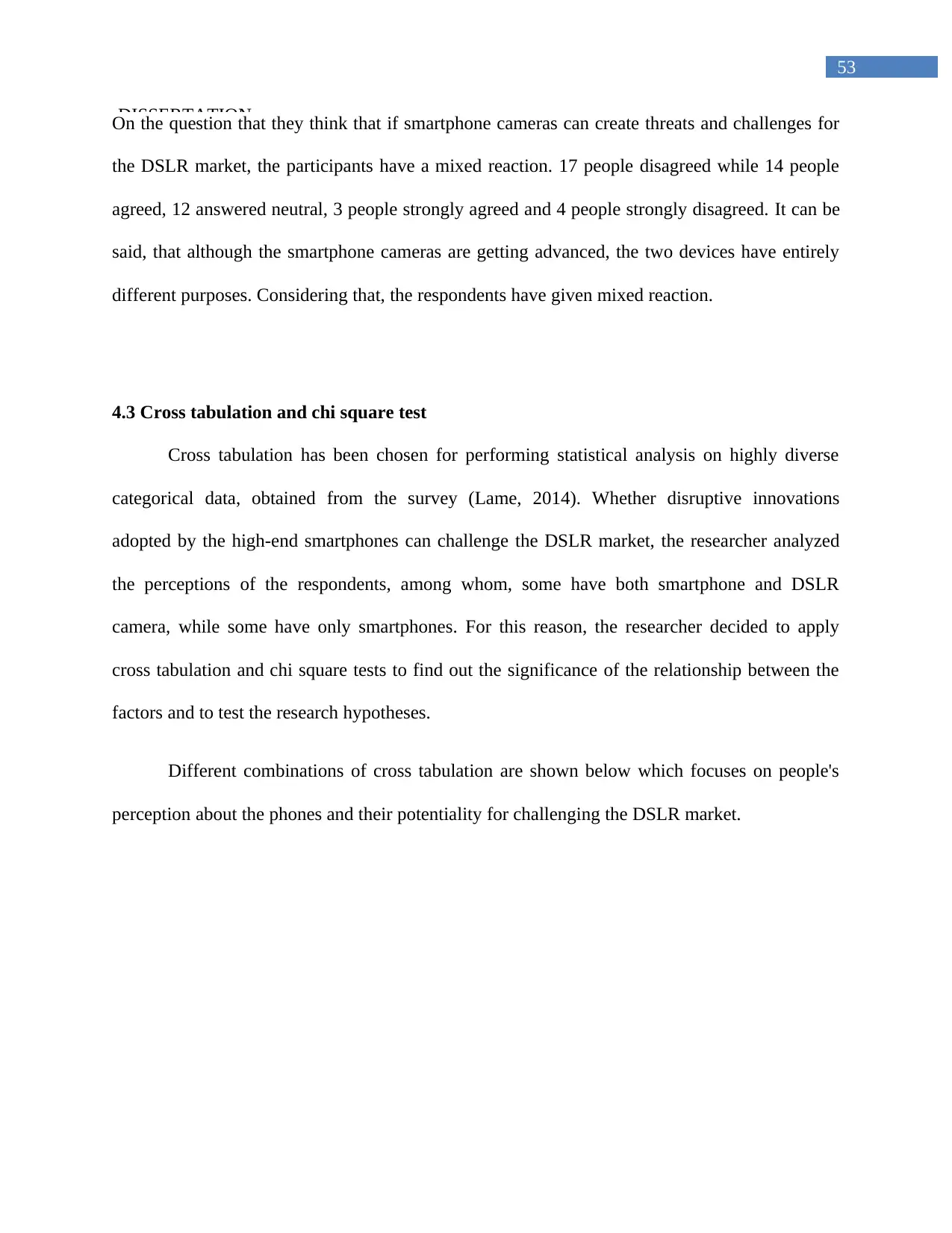
53
DISSERTATIONOn the question that they think that if smartphone cameras can create threats and challenges for
the DSLR market, the participants have a mixed reaction. 17 people disagreed while 14 people
agreed, 12 answered neutral, 3 people strongly agreed and 4 people strongly disagreed. It can be
said, that although the smartphone cameras are getting advanced, the two devices have entirely
different purposes. Considering that, the respondents have given mixed reaction.
4.3 Cross tabulation and chi square test
Cross tabulation has been chosen for performing statistical analysis on highly diverse
categorical data, obtained from the survey (Lame, 2014). Whether disruptive innovations
adopted by the high-end smartphones can challenge the DSLR market, the researcher analyzed
the perceptions of the respondents, among whom, some have both smartphone and DSLR
camera, while some have only smartphones. For this reason, the researcher decided to apply
cross tabulation and chi square tests to find out the significance of the relationship between the
factors and to test the research hypotheses.
Different combinations of cross tabulation are shown below which focuses on people's
perception about the phones and their potentiality for challenging the DSLR market.
DISSERTATIONOn the question that they think that if smartphone cameras can create threats and challenges for
the DSLR market, the participants have a mixed reaction. 17 people disagreed while 14 people
agreed, 12 answered neutral, 3 people strongly agreed and 4 people strongly disagreed. It can be
said, that although the smartphone cameras are getting advanced, the two devices have entirely
different purposes. Considering that, the respondents have given mixed reaction.
4.3 Cross tabulation and chi square test
Cross tabulation has been chosen for performing statistical analysis on highly diverse
categorical data, obtained from the survey (Lame, 2014). Whether disruptive innovations
adopted by the high-end smartphones can challenge the DSLR market, the researcher analyzed
the perceptions of the respondents, among whom, some have both smartphone and DSLR
camera, while some have only smartphones. For this reason, the researcher decided to apply
cross tabulation and chi square tests to find out the significance of the relationship between the
factors and to test the research hypotheses.
Different combinations of cross tabulation are shown below which focuses on people's
perception about the phones and their potentiality for challenging the DSLR market.
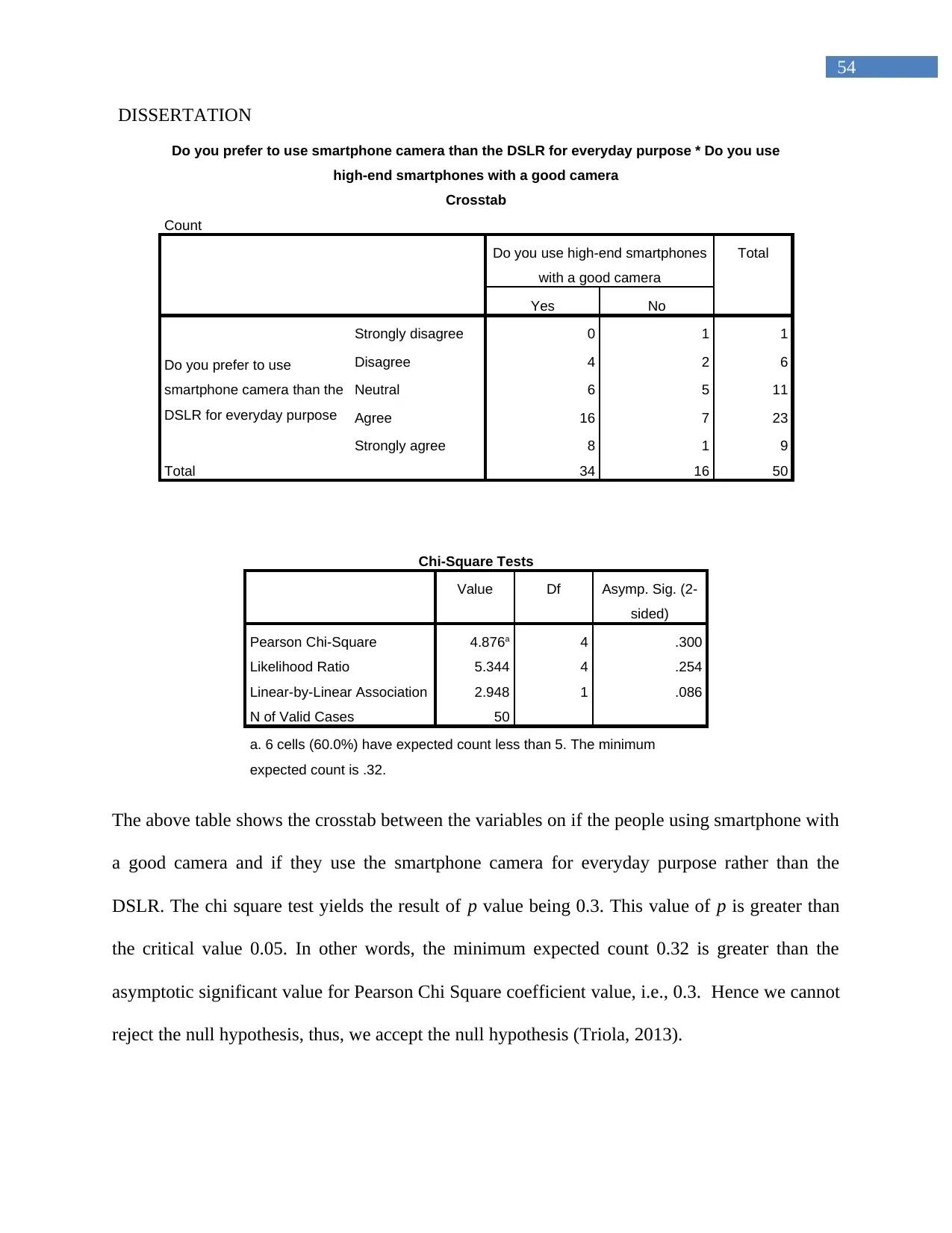
54
DISSERTATION
Do you prefer to use smartphone camera than the DSLR for everyday purpose * Do you use
high-end smartphones with a good camera
Crosstab
Count
Do you use high-end smartphones
with a good camera
Total
Yes No
Do you prefer to use
smartphone camera than the
DSLR for everyday purpose
Strongly disagree 0 1 1
Disagree 4 2 6
Neutral 6 5 11
Agree 16 7 23
Strongly agree 8 1 9
Total 34 16 50
Chi-Square Tests
Value Df Asymp. Sig. (2-
sided)
Pearson Chi-Square 4.876a 4 .300
Likelihood Ratio 5.344 4 .254
Linear-by-Linear Association 2.948 1 .086
N of Valid Cases 50
a. 6 cells (60.0%) have expected count less than 5. The minimum
expected count is .32.
The above table shows the crosstab between the variables on if the people using smartphone with
a good camera and if they use the smartphone camera for everyday purpose rather than the
DSLR. The chi square test yields the result of p value being 0.3. This value of p is greater than
the critical value 0.05. In other words, the minimum expected count 0.32 is greater than the
asymptotic significant value for Pearson Chi Square coefficient value, i.e., 0.3. Hence we cannot
reject the null hypothesis, thus, we accept the null hypothesis (Triola, 2013).
DISSERTATION
Do you prefer to use smartphone camera than the DSLR for everyday purpose * Do you use
high-end smartphones with a good camera
Crosstab
Count
Do you use high-end smartphones
with a good camera
Total
Yes No
Do you prefer to use
smartphone camera than the
DSLR for everyday purpose
Strongly disagree 0 1 1
Disagree 4 2 6
Neutral 6 5 11
Agree 16 7 23
Strongly agree 8 1 9
Total 34 16 50
Chi-Square Tests
Value Df Asymp. Sig. (2-
sided)
Pearson Chi-Square 4.876a 4 .300
Likelihood Ratio 5.344 4 .254
Linear-by-Linear Association 2.948 1 .086
N of Valid Cases 50
a. 6 cells (60.0%) have expected count less than 5. The minimum
expected count is .32.
The above table shows the crosstab between the variables on if the people using smartphone with
a good camera and if they use the smartphone camera for everyday purpose rather than the
DSLR. The chi square test yields the result of p value being 0.3. This value of p is greater than
the critical value 0.05. In other words, the minimum expected count 0.32 is greater than the
asymptotic significant value for Pearson Chi Square coefficient value, i.e., 0.3. Hence we cannot
reject the null hypothesis, thus, we accept the null hypothesis (Triola, 2013).
Paraphrase This Document
Need a fresh take? Get an instant paraphrase of this document with our AI Paraphraser
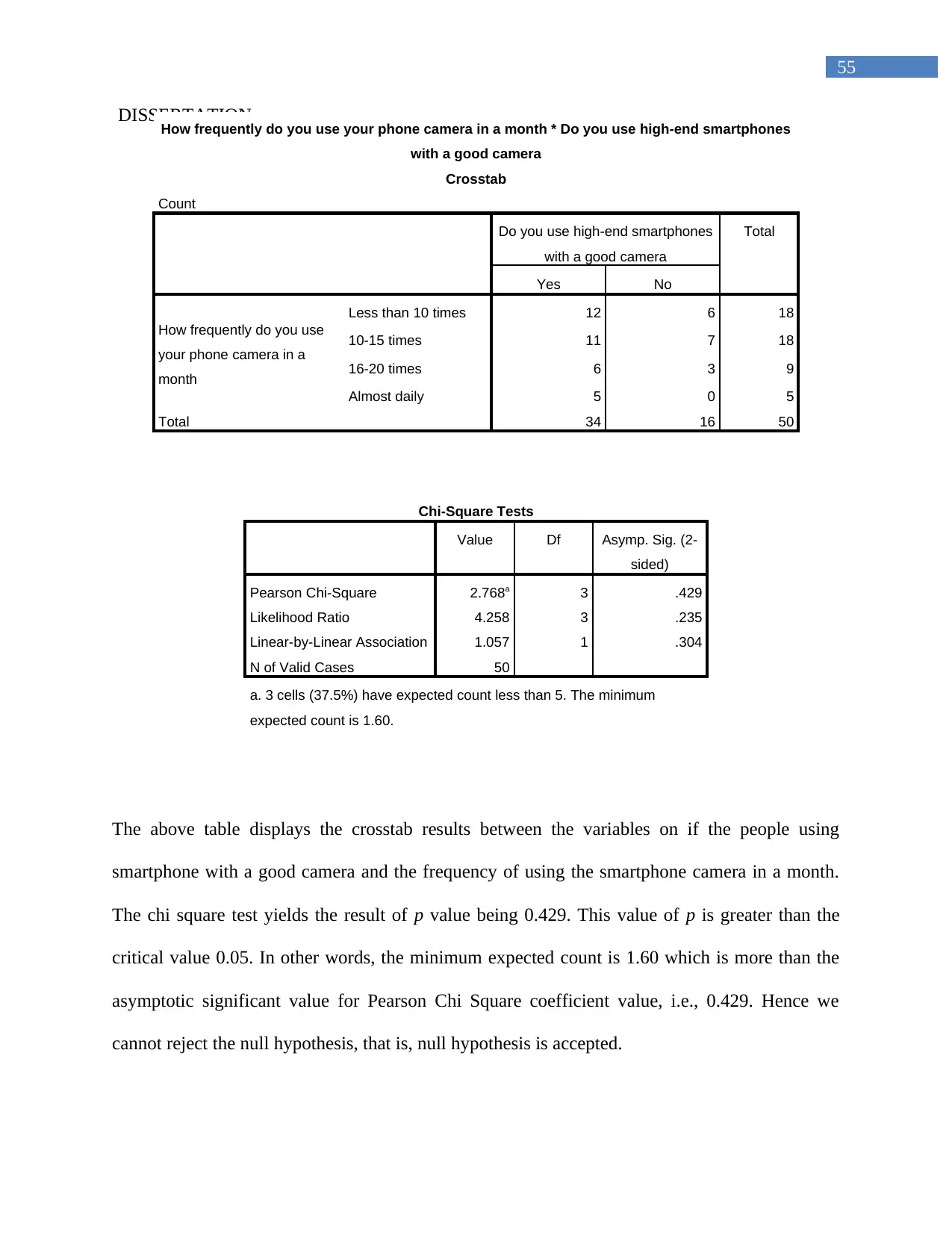
55
DISSERTATION
How frequently do you use your phone camera in a month * Do you use high-end smartphones
with a good camera
Crosstab
Count
Do you use high-end smartphones
with a good camera
Total
Yes No
How frequently do you use
your phone camera in a
month
Less than 10 times 12 6 18
10-15 times 11 7 18
16-20 times 6 3 9
Almost daily 5 0 5
Total 34 16 50
Chi-Square Tests
Value Df Asymp. Sig. (2-
sided)
Pearson Chi-Square 2.768a 3 .429
Likelihood Ratio 4.258 3 .235
Linear-by-Linear Association 1.057 1 .304
N of Valid Cases 50
a. 3 cells (37.5%) have expected count less than 5. The minimum
expected count is 1.60.
The above table displays the crosstab results between the variables on if the people using
smartphone with a good camera and the frequency of using the smartphone camera in a month.
The chi square test yields the result of p value being 0.429. This value of p is greater than the
critical value 0.05. In other words, the minimum expected count is 1.60 which is more than the
asymptotic significant value for Pearson Chi Square coefficient value, i.e., 0.429. Hence we
cannot reject the null hypothesis, that is, null hypothesis is accepted.
DISSERTATION
How frequently do you use your phone camera in a month * Do you use high-end smartphones
with a good camera
Crosstab
Count
Do you use high-end smartphones
with a good camera
Total
Yes No
How frequently do you use
your phone camera in a
month
Less than 10 times 12 6 18
10-15 times 11 7 18
16-20 times 6 3 9
Almost daily 5 0 5
Total 34 16 50
Chi-Square Tests
Value Df Asymp. Sig. (2-
sided)
Pearson Chi-Square 2.768a 3 .429
Likelihood Ratio 4.258 3 .235
Linear-by-Linear Association 1.057 1 .304
N of Valid Cases 50
a. 3 cells (37.5%) have expected count less than 5. The minimum
expected count is 1.60.
The above table displays the crosstab results between the variables on if the people using
smartphone with a good camera and the frequency of using the smartphone camera in a month.
The chi square test yields the result of p value being 0.429. This value of p is greater than the
critical value 0.05. In other words, the minimum expected count is 1.60 which is more than the
asymptotic significant value for Pearson Chi Square coefficient value, i.e., 0.429. Hence we
cannot reject the null hypothesis, that is, null hypothesis is accepted.
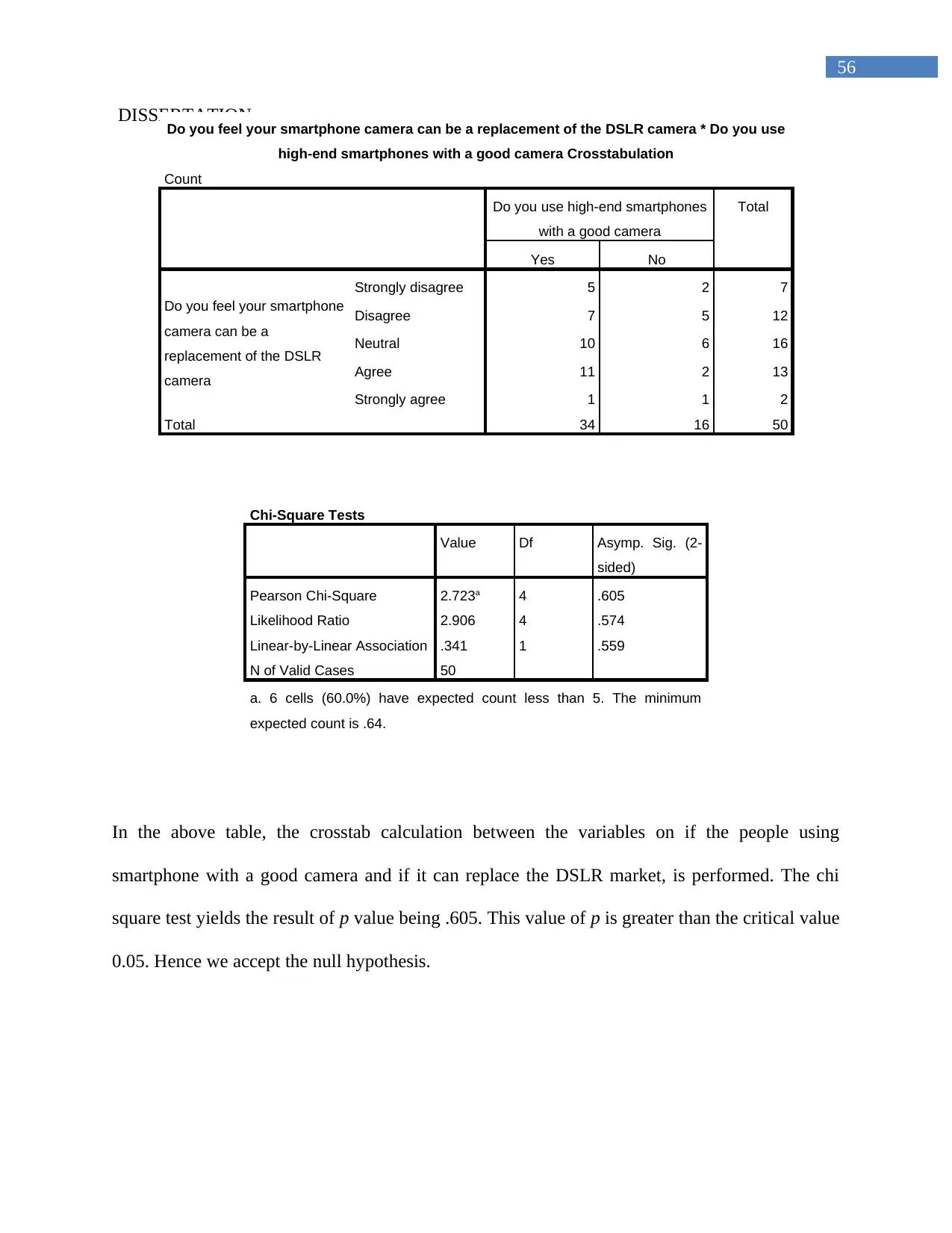
56
DISSERTATION
Do you feel your smartphone camera can be a replacement of the DSLR camera * Do you use
high-end smartphones with a good camera Crosstabulation
Count
Do you use high-end smartphones
with a good camera
Total
Yes No
Do you feel your smartphone
camera can be a
replacement of the DSLR
camera
Strongly disagree 5 2 7
Disagree 7 5 12
Neutral 10 6 16
Agree 11 2 13
Strongly agree 1 1 2
Total 34 16 50
Chi-Square Tests
Value Df Asymp. Sig. (2-
sided)
Pearson Chi-Square 2.723a 4 .605
Likelihood Ratio 2.906 4 .574
Linear-by-Linear Association .341 1 .559
N of Valid Cases 50
a. 6 cells (60.0%) have expected count less than 5. The minimum
expected count is .64.
In the above table, the crosstab calculation between the variables on if the people using
smartphone with a good camera and if it can replace the DSLR market, is performed. The chi
square test yields the result of p value being .605. This value of p is greater than the critical value
0.05. Hence we accept the null hypothesis.
DISSERTATION
Do you feel your smartphone camera can be a replacement of the DSLR camera * Do you use
high-end smartphones with a good camera Crosstabulation
Count
Do you use high-end smartphones
with a good camera
Total
Yes No
Do you feel your smartphone
camera can be a
replacement of the DSLR
camera
Strongly disagree 5 2 7
Disagree 7 5 12
Neutral 10 6 16
Agree 11 2 13
Strongly agree 1 1 2
Total 34 16 50
Chi-Square Tests
Value Df Asymp. Sig. (2-
sided)
Pearson Chi-Square 2.723a 4 .605
Likelihood Ratio 2.906 4 .574
Linear-by-Linear Association .341 1 .559
N of Valid Cases 50
a. 6 cells (60.0%) have expected count less than 5. The minimum
expected count is .64.
In the above table, the crosstab calculation between the variables on if the people using
smartphone with a good camera and if it can replace the DSLR market, is performed. The chi
square test yields the result of p value being .605. This value of p is greater than the critical value
0.05. Hence we accept the null hypothesis.
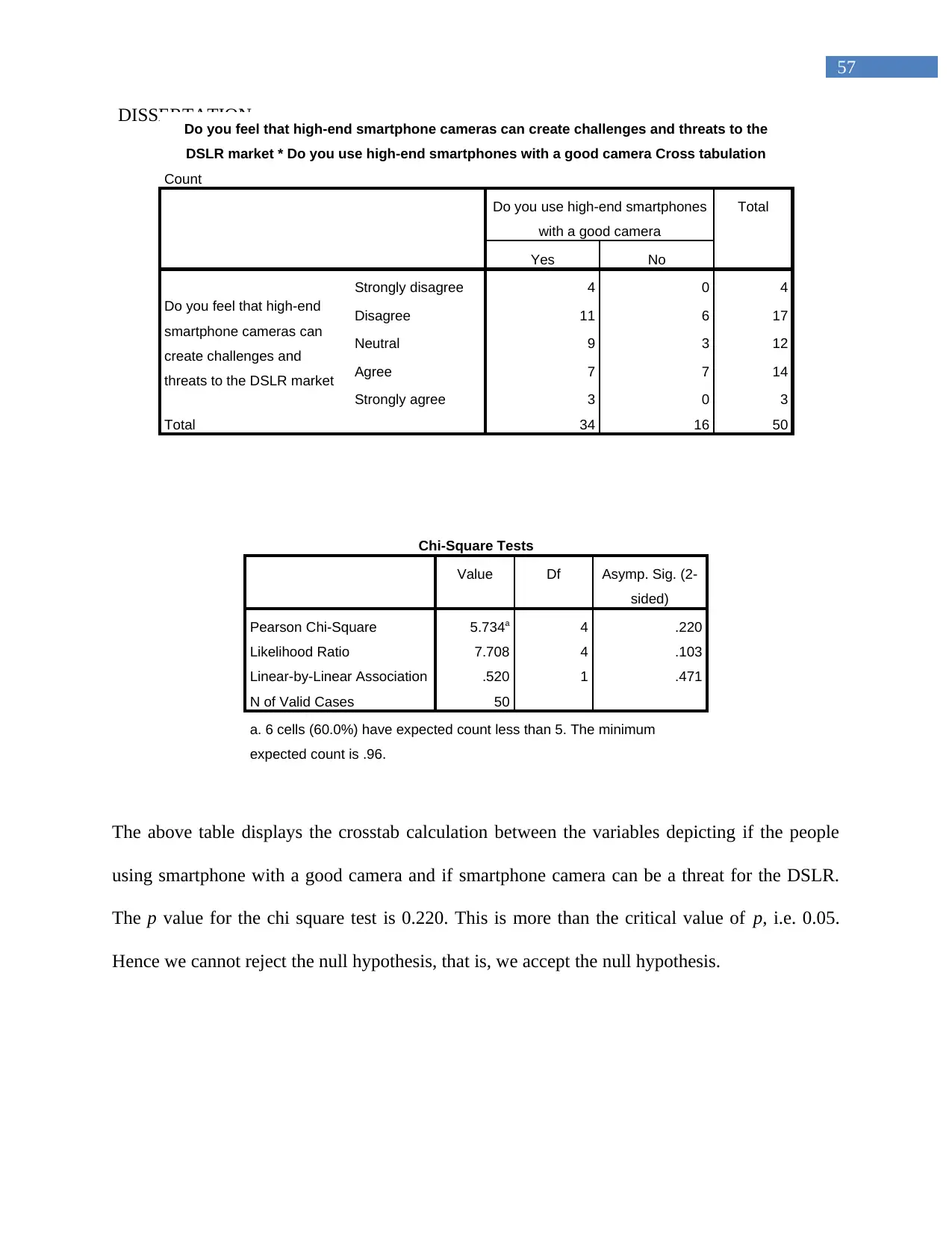
57
DISSERTATION
Do you feel that high-end smartphone cameras can create challenges and threats to the
DSLR market * Do you use high-end smartphones with a good camera Cross tabulation
Count
Do you use high-end smartphones
with a good camera
Total
Yes No
Do you feel that high-end
smartphone cameras can
create challenges and
threats to the DSLR market
Strongly disagree 4 0 4
Disagree 11 6 17
Neutral 9 3 12
Agree 7 7 14
Strongly agree 3 0 3
Total 34 16 50
Chi-Square Tests
Value Df Asymp. Sig. (2-
sided)
Pearson Chi-Square 5.734a 4 .220
Likelihood Ratio 7.708 4 .103
Linear-by-Linear Association .520 1 .471
N of Valid Cases 50
a. 6 cells (60.0%) have expected count less than 5. The minimum
expected count is .96.
The above table displays the crosstab calculation between the variables depicting if the people
using smartphone with a good camera and if smartphone camera can be a threat for the DSLR.
The p value for the chi square test is 0.220. This is more than the critical value of p, i.e. 0.05.
Hence we cannot reject the null hypothesis, that is, we accept the null hypothesis.
DISSERTATION
Do you feel that high-end smartphone cameras can create challenges and threats to the
DSLR market * Do you use high-end smartphones with a good camera Cross tabulation
Count
Do you use high-end smartphones
with a good camera
Total
Yes No
Do you feel that high-end
smartphone cameras can
create challenges and
threats to the DSLR market
Strongly disagree 4 0 4
Disagree 11 6 17
Neutral 9 3 12
Agree 7 7 14
Strongly agree 3 0 3
Total 34 16 50
Chi-Square Tests
Value Df Asymp. Sig. (2-
sided)
Pearson Chi-Square 5.734a 4 .220
Likelihood Ratio 7.708 4 .103
Linear-by-Linear Association .520 1 .471
N of Valid Cases 50
a. 6 cells (60.0%) have expected count less than 5. The minimum
expected count is .96.
The above table displays the crosstab calculation between the variables depicting if the people
using smartphone with a good camera and if smartphone camera can be a threat for the DSLR.
The p value for the chi square test is 0.220. This is more than the critical value of p, i.e. 0.05.
Hence we cannot reject the null hypothesis, that is, we accept the null hypothesis.
Secure Best Marks with AI Grader
Need help grading? Try our AI Grader for instant feedback on your assignments.
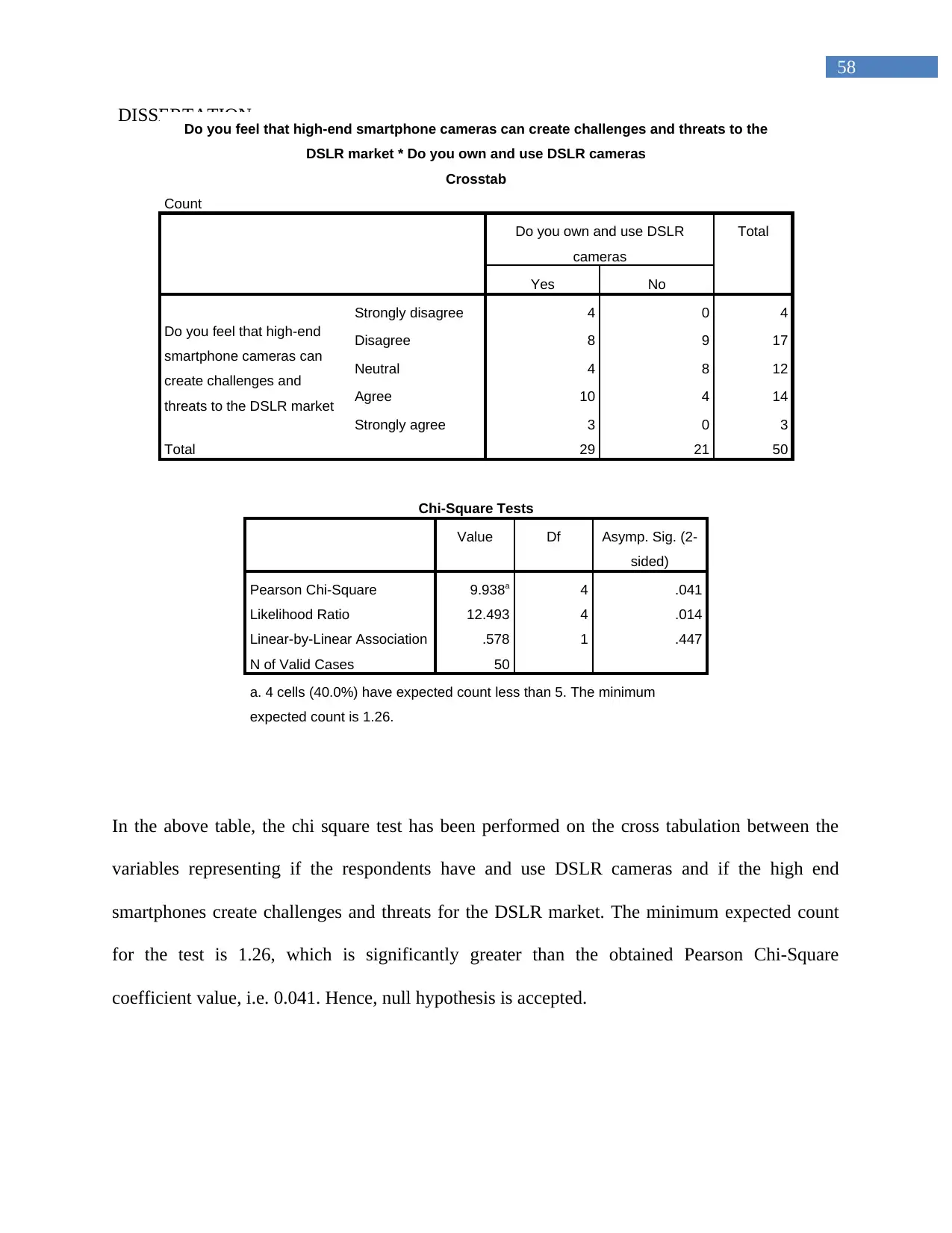
58
DISSERTATION
Do you feel that high-end smartphone cameras can create challenges and threats to the
DSLR market * Do you own and use DSLR cameras
Crosstab
Count
Do you own and use DSLR
cameras
Total
Yes No
Do you feel that high-end
smartphone cameras can
create challenges and
threats to the DSLR market
Strongly disagree 4 0 4
Disagree 8 9 17
Neutral 4 8 12
Agree 10 4 14
Strongly agree 3 0 3
Total 29 21 50
Chi-Square Tests
Value Df Asymp. Sig. (2-
sided)
Pearson Chi-Square 9.938a 4 .041
Likelihood Ratio 12.493 4 .014
Linear-by-Linear Association .578 1 .447
N of Valid Cases 50
a. 4 cells (40.0%) have expected count less than 5. The minimum
expected count is 1.26.
In the above table, the chi square test has been performed on the cross tabulation between the
variables representing if the respondents have and use DSLR cameras and if the high end
smartphones create challenges and threats for the DSLR market. The minimum expected count
for the test is 1.26, which is significantly greater than the obtained Pearson Chi-Square
coefficient value, i.e. 0.041. Hence, null hypothesis is accepted.
DISSERTATION
Do you feel that high-end smartphone cameras can create challenges and threats to the
DSLR market * Do you own and use DSLR cameras
Crosstab
Count
Do you own and use DSLR
cameras
Total
Yes No
Do you feel that high-end
smartphone cameras can
create challenges and
threats to the DSLR market
Strongly disagree 4 0 4
Disagree 8 9 17
Neutral 4 8 12
Agree 10 4 14
Strongly agree 3 0 3
Total 29 21 50
Chi-Square Tests
Value Df Asymp. Sig. (2-
sided)
Pearson Chi-Square 9.938a 4 .041
Likelihood Ratio 12.493 4 .014
Linear-by-Linear Association .578 1 .447
N of Valid Cases 50
a. 4 cells (40.0%) have expected count less than 5. The minimum
expected count is 1.26.
In the above table, the chi square test has been performed on the cross tabulation between the
variables representing if the respondents have and use DSLR cameras and if the high end
smartphones create challenges and threats for the DSLR market. The minimum expected count
for the test is 1.26, which is significantly greater than the obtained Pearson Chi-Square
coefficient value, i.e. 0.041. Hence, null hypothesis is accepted.
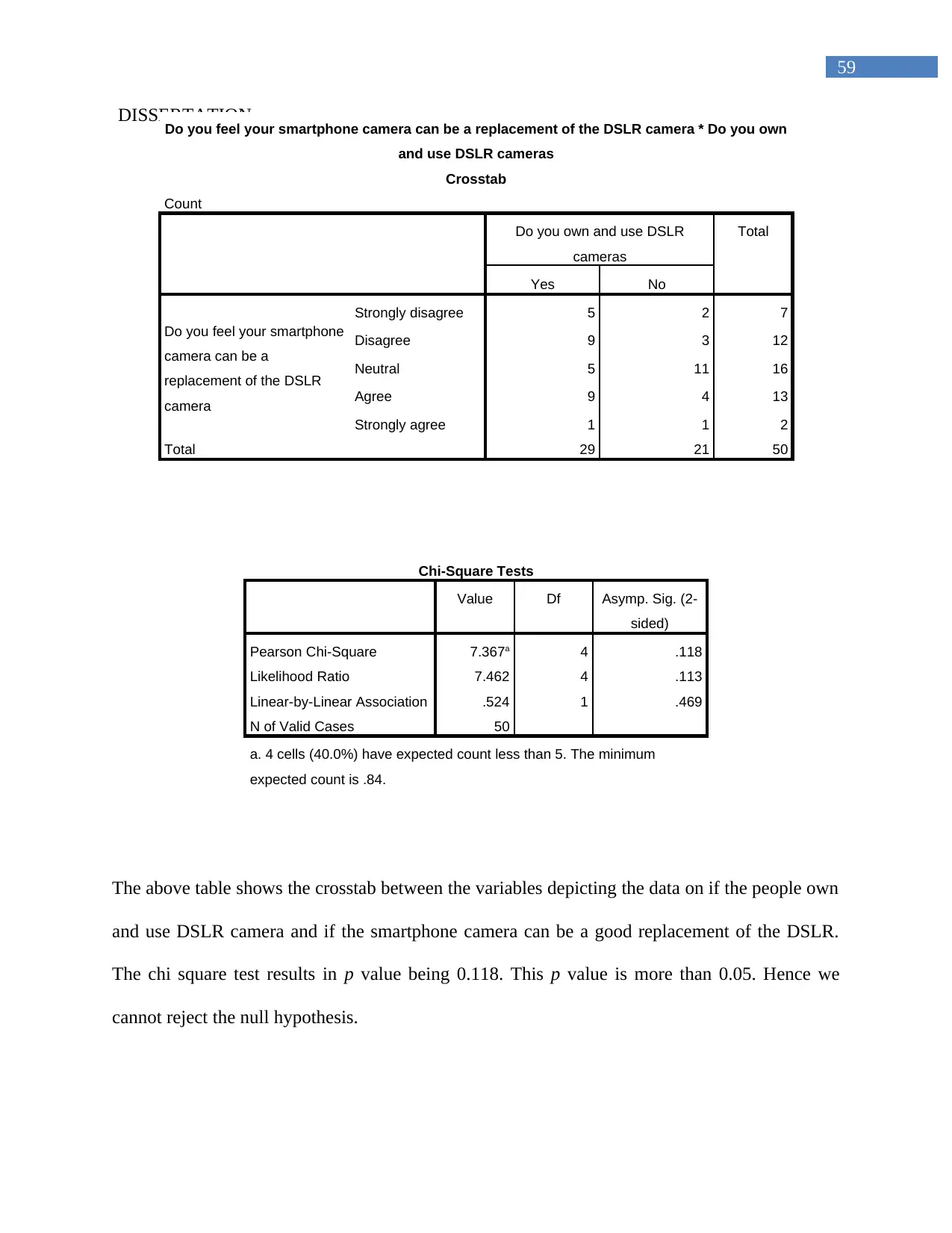
59
DISSERTATION
Do you feel your smartphone camera can be a replacement of the DSLR camera * Do you own
and use DSLR cameras
Crosstab
Count
Do you own and use DSLR
cameras
Total
Yes No
Do you feel your smartphone
camera can be a
replacement of the DSLR
camera
Strongly disagree 5 2 7
Disagree 9 3 12
Neutral 5 11 16
Agree 9 4 13
Strongly agree 1 1 2
Total 29 21 50
Chi-Square Tests
Value Df Asymp. Sig. (2-
sided)
Pearson Chi-Square 7.367a 4 .118
Likelihood Ratio 7.462 4 .113
Linear-by-Linear Association .524 1 .469
N of Valid Cases 50
a. 4 cells (40.0%) have expected count less than 5. The minimum
expected count is .84.
The above table shows the crosstab between the variables depicting the data on if the people own
and use DSLR camera and if the smartphone camera can be a good replacement of the DSLR.
The chi square test results in p value being 0.118. This p value is more than 0.05. Hence we
cannot reject the null hypothesis.
DISSERTATION
Do you feel your smartphone camera can be a replacement of the DSLR camera * Do you own
and use DSLR cameras
Crosstab
Count
Do you own and use DSLR
cameras
Total
Yes No
Do you feel your smartphone
camera can be a
replacement of the DSLR
camera
Strongly disagree 5 2 7
Disagree 9 3 12
Neutral 5 11 16
Agree 9 4 13
Strongly agree 1 1 2
Total 29 21 50
Chi-Square Tests
Value Df Asymp. Sig. (2-
sided)
Pearson Chi-Square 7.367a 4 .118
Likelihood Ratio 7.462 4 .113
Linear-by-Linear Association .524 1 .469
N of Valid Cases 50
a. 4 cells (40.0%) have expected count less than 5. The minimum
expected count is .84.
The above table shows the crosstab between the variables depicting the data on if the people own
and use DSLR camera and if the smartphone camera can be a good replacement of the DSLR.
The chi square test results in p value being 0.118. This p value is more than 0.05. Hence we
cannot reject the null hypothesis.
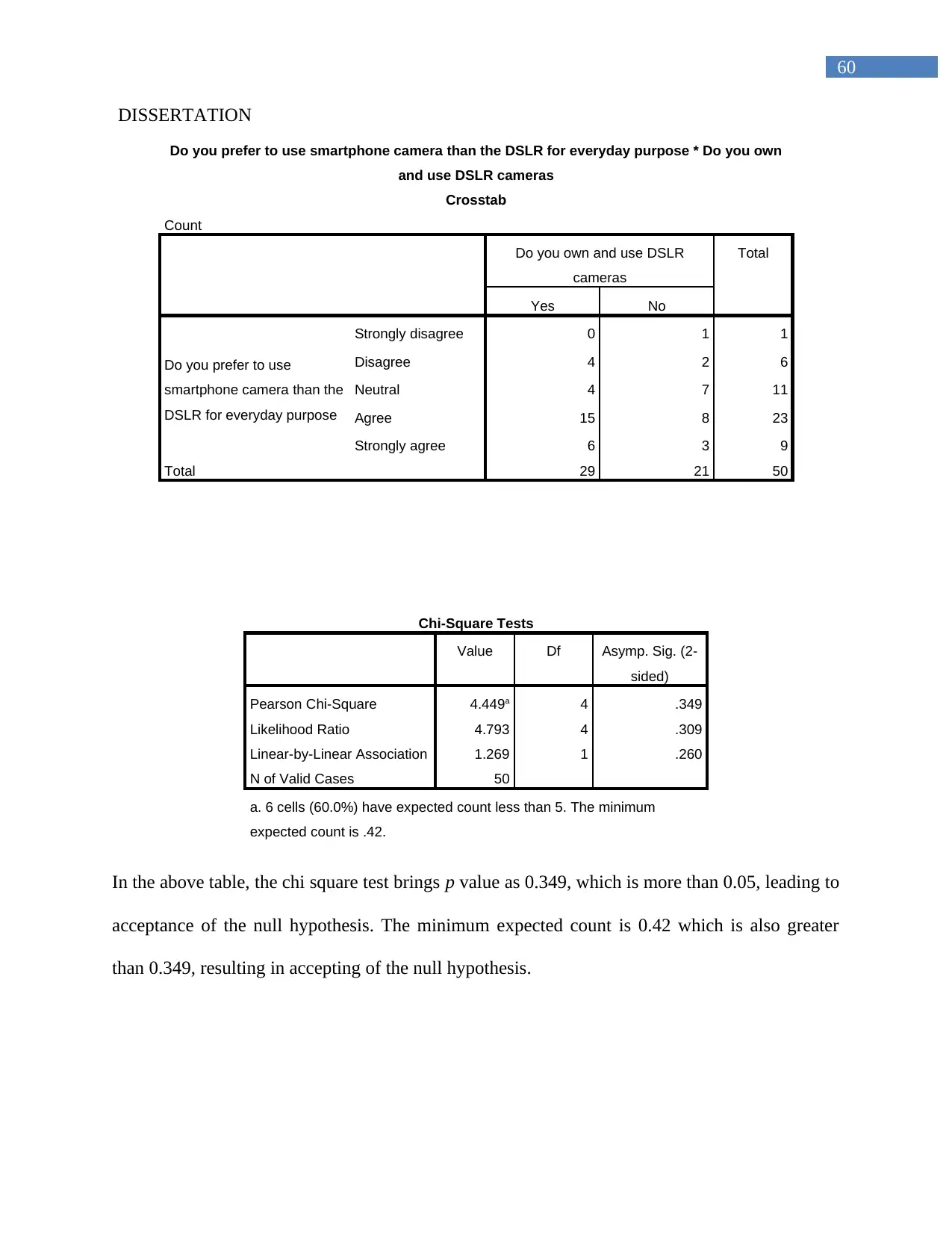
60
DISSERTATION
Do you prefer to use smartphone camera than the DSLR for everyday purpose * Do you own
and use DSLR cameras
Crosstab
Count
Do you own and use DSLR
cameras
Total
Yes No
Do you prefer to use
smartphone camera than the
DSLR for everyday purpose
Strongly disagree 0 1 1
Disagree 4 2 6
Neutral 4 7 11
Agree 15 8 23
Strongly agree 6 3 9
Total 29 21 50
Chi-Square Tests
Value Df Asymp. Sig. (2-
sided)
Pearson Chi-Square 4.449a 4 .349
Likelihood Ratio 4.793 4 .309
Linear-by-Linear Association 1.269 1 .260
N of Valid Cases 50
a. 6 cells (60.0%) have expected count less than 5. The minimum
expected count is .42.
In the above table, the chi square test brings p value as 0.349, which is more than 0.05, leading to
acceptance of the null hypothesis. The minimum expected count is 0.42 which is also greater
than 0.349, resulting in accepting of the null hypothesis.
DISSERTATION
Do you prefer to use smartphone camera than the DSLR for everyday purpose * Do you own
and use DSLR cameras
Crosstab
Count
Do you own and use DSLR
cameras
Total
Yes No
Do you prefer to use
smartphone camera than the
DSLR for everyday purpose
Strongly disagree 0 1 1
Disagree 4 2 6
Neutral 4 7 11
Agree 15 8 23
Strongly agree 6 3 9
Total 29 21 50
Chi-Square Tests
Value Df Asymp. Sig. (2-
sided)
Pearson Chi-Square 4.449a 4 .349
Likelihood Ratio 4.793 4 .309
Linear-by-Linear Association 1.269 1 .260
N of Valid Cases 50
a. 6 cells (60.0%) have expected count less than 5. The minimum
expected count is .42.
In the above table, the chi square test brings p value as 0.349, which is more than 0.05, leading to
acceptance of the null hypothesis. The minimum expected count is 0.42 which is also greater
than 0.349, resulting in accepting of the null hypothesis.
Paraphrase This Document
Need a fresh take? Get an instant paraphrase of this document with our AI Paraphraser
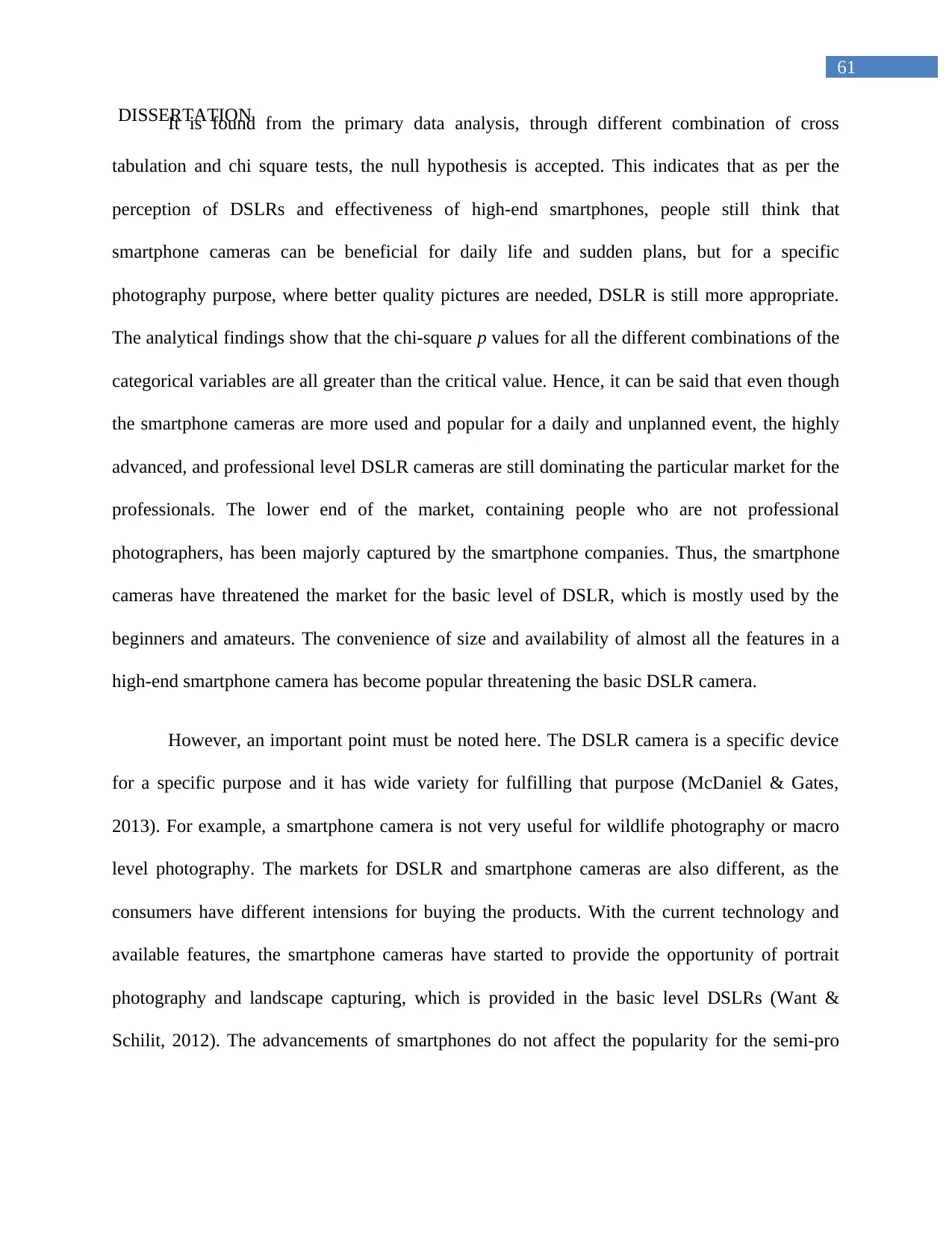
61
DISSERTATIONIt is found from the primary data analysis, through different combination of cross
tabulation and chi square tests, the null hypothesis is accepted. This indicates that as per the
perception of DSLRs and effectiveness of high-end smartphones, people still think that
smartphone cameras can be beneficial for daily life and sudden plans, but for a specific
photography purpose, where better quality pictures are needed, DSLR is still more appropriate.
The analytical findings show that the chi-square p values for all the different combinations of the
categorical variables are all greater than the critical value. Hence, it can be said that even though
the smartphone cameras are more used and popular for a daily and unplanned event, the highly
advanced, and professional level DSLR cameras are still dominating the particular market for the
professionals. The lower end of the market, containing people who are not professional
photographers, has been majorly captured by the smartphone companies. Thus, the smartphone
cameras have threatened the market for the basic level of DSLR, which is mostly used by the
beginners and amateurs. The convenience of size and availability of almost all the features in a
high-end smartphone camera has become popular threatening the basic DSLR camera.
However, an important point must be noted here. The DSLR camera is a specific device
for a specific purpose and it has wide variety for fulfilling that purpose (McDaniel & Gates,
2013). For example, a smartphone camera is not very useful for wildlife photography or macro
level photography. The markets for DSLR and smartphone cameras are also different, as the
consumers have different intensions for buying the products. With the current technology and
available features, the smartphone cameras have started to provide the opportunity of portrait
photography and landscape capturing, which is provided in the basic level DSLRs (Want &
Schilit, 2012). The advancements of smartphones do not affect the popularity for the semi-pro
DISSERTATIONIt is found from the primary data analysis, through different combination of cross
tabulation and chi square tests, the null hypothesis is accepted. This indicates that as per the
perception of DSLRs and effectiveness of high-end smartphones, people still think that
smartphone cameras can be beneficial for daily life and sudden plans, but for a specific
photography purpose, where better quality pictures are needed, DSLR is still more appropriate.
The analytical findings show that the chi-square p values for all the different combinations of the
categorical variables are all greater than the critical value. Hence, it can be said that even though
the smartphone cameras are more used and popular for a daily and unplanned event, the highly
advanced, and professional level DSLR cameras are still dominating the particular market for the
professionals. The lower end of the market, containing people who are not professional
photographers, has been majorly captured by the smartphone companies. Thus, the smartphone
cameras have threatened the market for the basic level of DSLR, which is mostly used by the
beginners and amateurs. The convenience of size and availability of almost all the features in a
high-end smartphone camera has become popular threatening the basic DSLR camera.
However, an important point must be noted here. The DSLR camera is a specific device
for a specific purpose and it has wide variety for fulfilling that purpose (McDaniel & Gates,
2013). For example, a smartphone camera is not very useful for wildlife photography or macro
level photography. The markets for DSLR and smartphone cameras are also different, as the
consumers have different intensions for buying the products. With the current technology and
available features, the smartphone cameras have started to provide the opportunity of portrait
photography and landscape capturing, which is provided in the basic level DSLRs (Want &
Schilit, 2012). The advancements of smartphones do not affect the popularity for the semi-pro

62
DISSERTATIONand pro level DSLRs, which is the niche business for the companies, unless the smartphone
companies develop and adopt the another level of disruptive innovations.
4.4 Secondary data analysis
Due to the advent of high-end smartphones, with higher level of camera in every new
model, the DSLR camera market has been experiencing a slow growth over the last few years.
The market leaders for DSLRs are Canon and Nikon, followed by Sony, Olympus and few more.
On the other hand, following iPhone, there are many smartphone companies, such as, Samsung,
Google Pixel, HTC, Huawei, that are providing technologically highly advanced smartphones
with super powerful back as well as front camera (Berry & Schleser, 2014). However, to
understand the level of challenges that the smartphone companies are throwing towards the
DSLR companies, few factors should be analyzed.
4.4.1 Technological difference
DSLR cameras are meant for photography only and hence, the technology is precisely
focused on providing the best quality photos. On the other hand, smartphones are essentially
mobile phones, which are providing the camera as an additional feature among many (Islam &
Want, 2014). Although, many of the new phones, such as, iPhone 7 provides 12 MP (f/1.8,
28mm, 1/3"), phase detection autofocus, OIS, quad-LED dual-tone flash, check quality primary
camera and 7 MP (f/2.2, 32mm), 1080p@30fps, 720p@240fps, face detection, HDR, panorama
secondary camera, along with high power video facilities, Google Pixel provides 12.3 MP
primary camera, Samsung galaxy offers 16.3 MP and Huawei Honor 7X provides 16 MP + 2 MP
dual lens primary camera. All these phones also provide basic DSLR features such as, HDR
DISSERTATIONand pro level DSLRs, which is the niche business for the companies, unless the smartphone
companies develop and adopt the another level of disruptive innovations.
4.4 Secondary data analysis
Due to the advent of high-end smartphones, with higher level of camera in every new
model, the DSLR camera market has been experiencing a slow growth over the last few years.
The market leaders for DSLRs are Canon and Nikon, followed by Sony, Olympus and few more.
On the other hand, following iPhone, there are many smartphone companies, such as, Samsung,
Google Pixel, HTC, Huawei, that are providing technologically highly advanced smartphones
with super powerful back as well as front camera (Berry & Schleser, 2014). However, to
understand the level of challenges that the smartphone companies are throwing towards the
DSLR companies, few factors should be analyzed.
4.4.1 Technological difference
DSLR cameras are meant for photography only and hence, the technology is precisely
focused on providing the best quality photos. On the other hand, smartphones are essentially
mobile phones, which are providing the camera as an additional feature among many (Islam &
Want, 2014). Although, many of the new phones, such as, iPhone 7 provides 12 MP (f/1.8,
28mm, 1/3"), phase detection autofocus, OIS, quad-LED dual-tone flash, check quality primary
camera and 7 MP (f/2.2, 32mm), 1080p@30fps, 720p@240fps, face detection, HDR, panorama
secondary camera, along with high power video facilities, Google Pixel provides 12.3 MP
primary camera, Samsung galaxy offers 16.3 MP and Huawei Honor 7X provides 16 MP + 2 MP
dual lens primary camera. All these phones also provide basic DSLR features such as, HDR
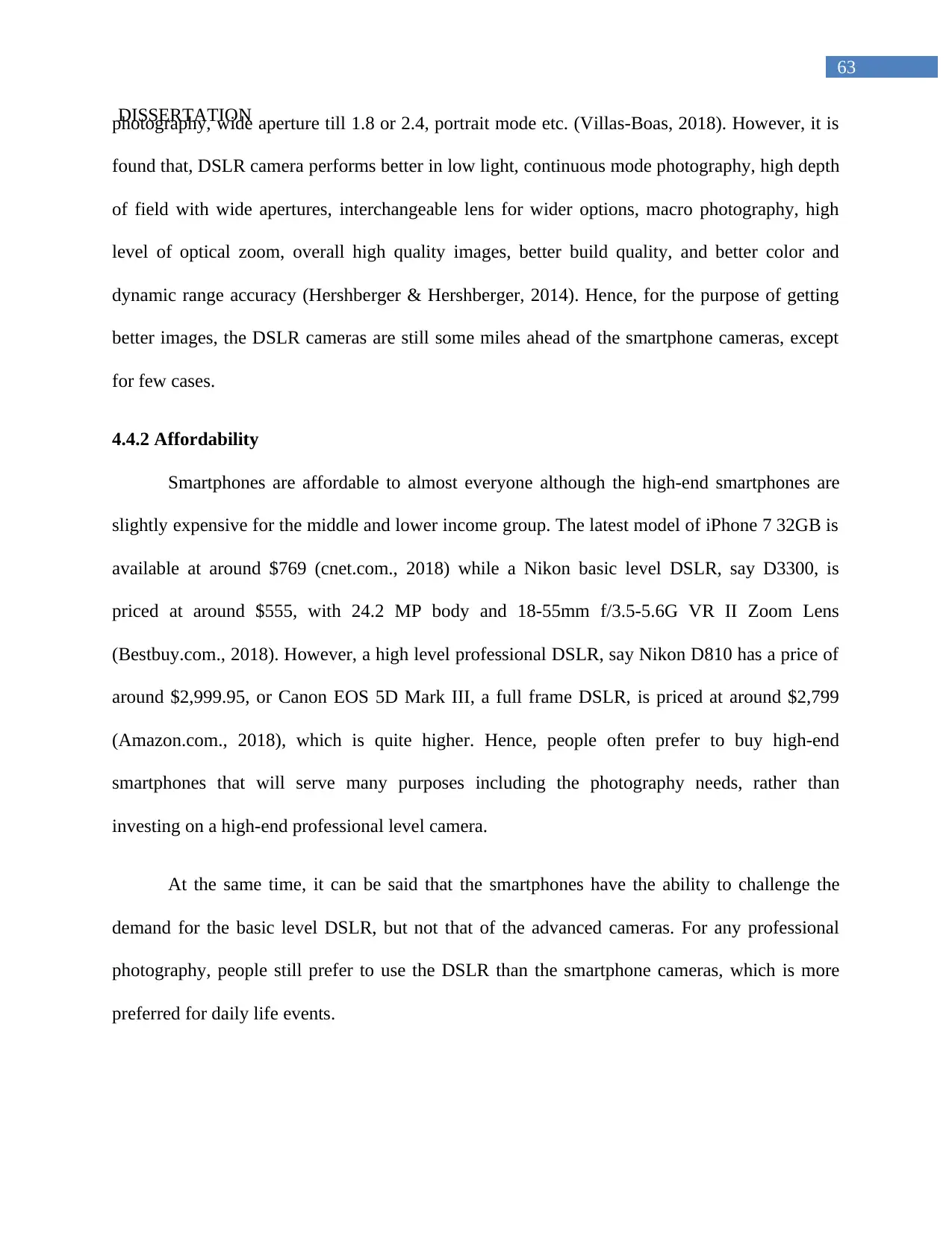
63
DISSERTATIONphotography, wide aperture till 1.8 or 2.4, portrait mode etc. (Villas-Boas, 2018). However, it is
found that, DSLR camera performs better in low light, continuous mode photography, high depth
of field with wide apertures, interchangeable lens for wider options, macro photography, high
level of optical zoom, overall high quality images, better build quality, and better color and
dynamic range accuracy (Hershberger & Hershberger, 2014). Hence, for the purpose of getting
better images, the DSLR cameras are still some miles ahead of the smartphone cameras, except
for few cases.
4.4.2 Affordability
Smartphones are affordable to almost everyone although the high-end smartphones are
slightly expensive for the middle and lower income group. The latest model of iPhone 7 32GB is
available at around $769 (cnet.com., 2018) while a Nikon basic level DSLR, say D3300, is
priced at around $555, with 24.2 MP body and 18-55mm f/3.5-5.6G VR II Zoom Lens
(Bestbuy.com., 2018). However, a high level professional DSLR, say Nikon D810 has a price of
around $2,999.95, or Canon EOS 5D Mark III, a full frame DSLR, is priced at around $2,799
(Amazon.com., 2018), which is quite higher. Hence, people often prefer to buy high-end
smartphones that will serve many purposes including the photography needs, rather than
investing on a high-end professional level camera.
At the same time, it can be said that the smartphones have the ability to challenge the
demand for the basic level DSLR, but not that of the advanced cameras. For any professional
photography, people still prefer to use the DSLR than the smartphone cameras, which is more
preferred for daily life events.
DISSERTATIONphotography, wide aperture till 1.8 or 2.4, portrait mode etc. (Villas-Boas, 2018). However, it is
found that, DSLR camera performs better in low light, continuous mode photography, high depth
of field with wide apertures, interchangeable lens for wider options, macro photography, high
level of optical zoom, overall high quality images, better build quality, and better color and
dynamic range accuracy (Hershberger & Hershberger, 2014). Hence, for the purpose of getting
better images, the DSLR cameras are still some miles ahead of the smartphone cameras, except
for few cases.
4.4.2 Affordability
Smartphones are affordable to almost everyone although the high-end smartphones are
slightly expensive for the middle and lower income group. The latest model of iPhone 7 32GB is
available at around $769 (cnet.com., 2018) while a Nikon basic level DSLR, say D3300, is
priced at around $555, with 24.2 MP body and 18-55mm f/3.5-5.6G VR II Zoom Lens
(Bestbuy.com., 2018). However, a high level professional DSLR, say Nikon D810 has a price of
around $2,999.95, or Canon EOS 5D Mark III, a full frame DSLR, is priced at around $2,799
(Amazon.com., 2018), which is quite higher. Hence, people often prefer to buy high-end
smartphones that will serve many purposes including the photography needs, rather than
investing on a high-end professional level camera.
At the same time, it can be said that the smartphones have the ability to challenge the
demand for the basic level DSLR, but not that of the advanced cameras. For any professional
photography, people still prefer to use the DSLR than the smartphone cameras, which is more
preferred for daily life events.
Secure Best Marks with AI Grader
Need help grading? Try our AI Grader for instant feedback on your assignments.
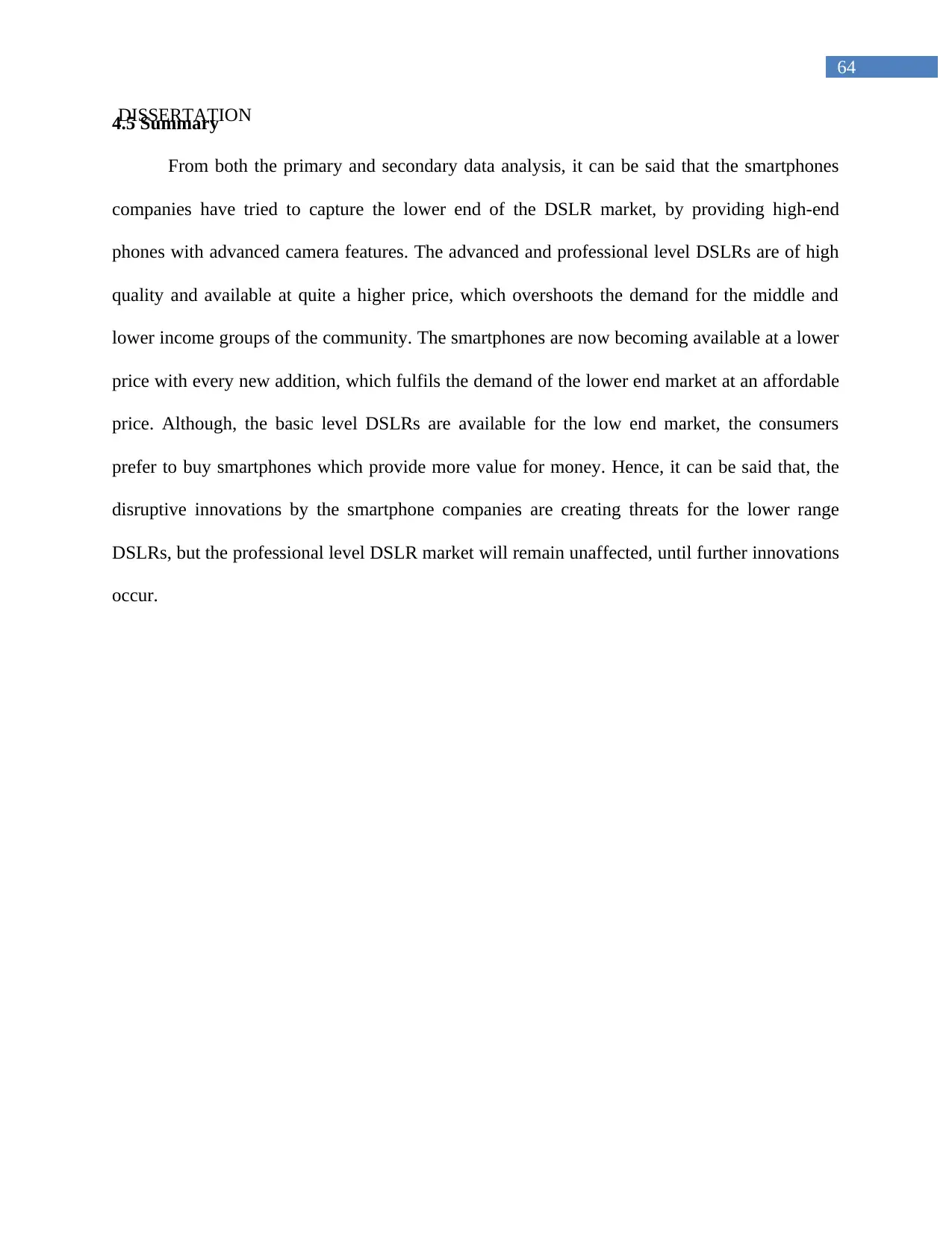
64
DISSERTATION4.5 Summary
From both the primary and secondary data analysis, it can be said that the smartphones
companies have tried to capture the lower end of the DSLR market, by providing high-end
phones with advanced camera features. The advanced and professional level DSLRs are of high
quality and available at quite a higher price, which overshoots the demand for the middle and
lower income groups of the community. The smartphones are now becoming available at a lower
price with every new addition, which fulfils the demand of the lower end market at an affordable
price. Although, the basic level DSLRs are available for the low end market, the consumers
prefer to buy smartphones which provide more value for money. Hence, it can be said that, the
disruptive innovations by the smartphone companies are creating threats for the lower range
DSLRs, but the professional level DSLR market will remain unaffected, until further innovations
occur.
DISSERTATION4.5 Summary
From both the primary and secondary data analysis, it can be said that the smartphones
companies have tried to capture the lower end of the DSLR market, by providing high-end
phones with advanced camera features. The advanced and professional level DSLRs are of high
quality and available at quite a higher price, which overshoots the demand for the middle and
lower income groups of the community. The smartphones are now becoming available at a lower
price with every new addition, which fulfils the demand of the lower end market at an affordable
price. Although, the basic level DSLRs are available for the low end market, the consumers
prefer to buy smartphones which provide more value for money. Hence, it can be said that, the
disruptive innovations by the smartphone companies are creating threats for the lower range
DSLRs, but the professional level DSLR market will remain unaffected, until further innovations
occur.
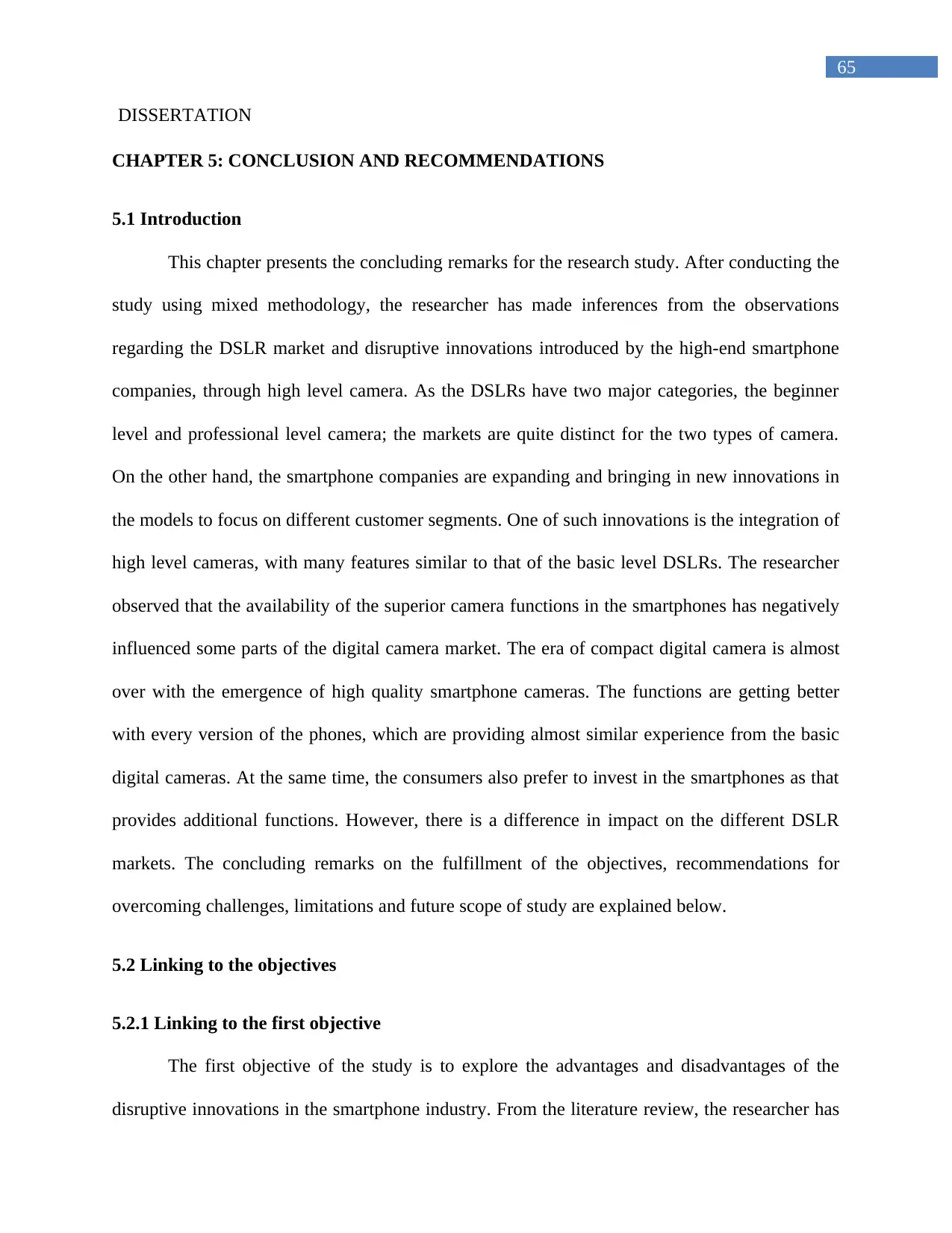
65
DISSERTATION
CHAPTER 5: CONCLUSION AND RECOMMENDATIONS
5.1 Introduction
This chapter presents the concluding remarks for the research study. After conducting the
study using mixed methodology, the researcher has made inferences from the observations
regarding the DSLR market and disruptive innovations introduced by the high-end smartphone
companies, through high level camera. As the DSLRs have two major categories, the beginner
level and professional level camera; the markets are quite distinct for the two types of camera.
On the other hand, the smartphone companies are expanding and bringing in new innovations in
the models to focus on different customer segments. One of such innovations is the integration of
high level cameras, with many features similar to that of the basic level DSLRs. The researcher
observed that the availability of the superior camera functions in the smartphones has negatively
influenced some parts of the digital camera market. The era of compact digital camera is almost
over with the emergence of high quality smartphone cameras. The functions are getting better
with every version of the phones, which are providing almost similar experience from the basic
digital cameras. At the same time, the consumers also prefer to invest in the smartphones as that
provides additional functions. However, there is a difference in impact on the different DSLR
markets. The concluding remarks on the fulfillment of the objectives, recommendations for
overcoming challenges, limitations and future scope of study are explained below.
5.2 Linking to the objectives
5.2.1 Linking to the first objective
The first objective of the study is to explore the advantages and disadvantages of the
disruptive innovations in the smartphone industry. From the literature review, the researcher has
DISSERTATION
CHAPTER 5: CONCLUSION AND RECOMMENDATIONS
5.1 Introduction
This chapter presents the concluding remarks for the research study. After conducting the
study using mixed methodology, the researcher has made inferences from the observations
regarding the DSLR market and disruptive innovations introduced by the high-end smartphone
companies, through high level camera. As the DSLRs have two major categories, the beginner
level and professional level camera; the markets are quite distinct for the two types of camera.
On the other hand, the smartphone companies are expanding and bringing in new innovations in
the models to focus on different customer segments. One of such innovations is the integration of
high level cameras, with many features similar to that of the basic level DSLRs. The researcher
observed that the availability of the superior camera functions in the smartphones has negatively
influenced some parts of the digital camera market. The era of compact digital camera is almost
over with the emergence of high quality smartphone cameras. The functions are getting better
with every version of the phones, which are providing almost similar experience from the basic
digital cameras. At the same time, the consumers also prefer to invest in the smartphones as that
provides additional functions. However, there is a difference in impact on the different DSLR
markets. The concluding remarks on the fulfillment of the objectives, recommendations for
overcoming challenges, limitations and future scope of study are explained below.
5.2 Linking to the objectives
5.2.1 Linking to the first objective
The first objective of the study is to explore the advantages and disadvantages of the
disruptive innovations in the smartphone industry. From the literature review, the researcher has
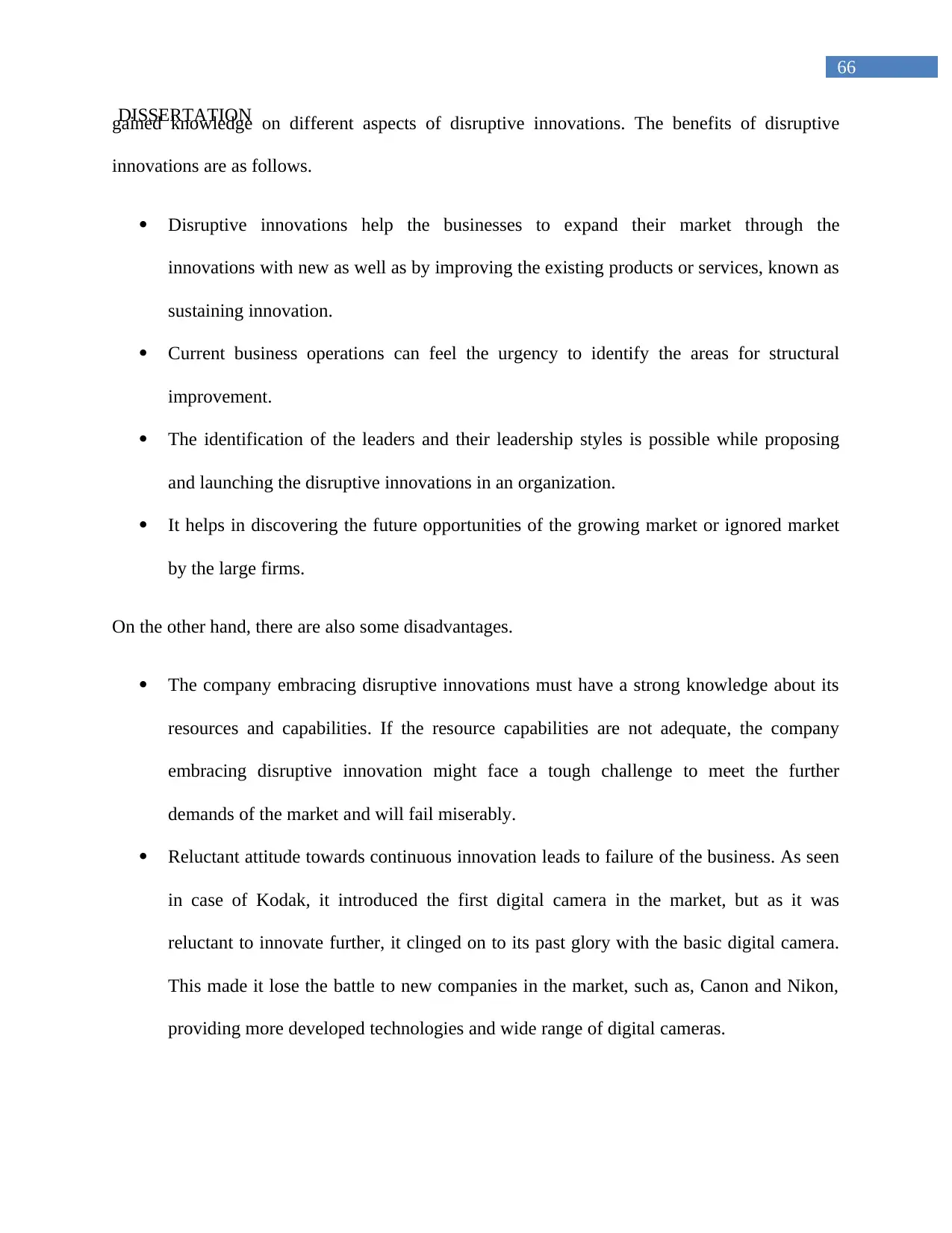
66
DISSERTATIONgained knowledge on different aspects of disruptive innovations. The benefits of disruptive
innovations are as follows.
Disruptive innovations help the businesses to expand their market through the
innovations with new as well as by improving the existing products or services, known as
sustaining innovation.
Current business operations can feel the urgency to identify the areas for structural
improvement.
The identification of the leaders and their leadership styles is possible while proposing
and launching the disruptive innovations in an organization.
It helps in discovering the future opportunities of the growing market or ignored market
by the large firms.
On the other hand, there are also some disadvantages.
The company embracing disruptive innovations must have a strong knowledge about its
resources and capabilities. If the resource capabilities are not adequate, the company
embracing disruptive innovation might face a tough challenge to meet the further
demands of the market and will fail miserably.
Reluctant attitude towards continuous innovation leads to failure of the business. As seen
in case of Kodak, it introduced the first digital camera in the market, but as it was
reluctant to innovate further, it clinged on to its past glory with the basic digital camera.
This made it lose the battle to new companies in the market, such as, Canon and Nikon,
providing more developed technologies and wide range of digital cameras.
DISSERTATIONgained knowledge on different aspects of disruptive innovations. The benefits of disruptive
innovations are as follows.
Disruptive innovations help the businesses to expand their market through the
innovations with new as well as by improving the existing products or services, known as
sustaining innovation.
Current business operations can feel the urgency to identify the areas for structural
improvement.
The identification of the leaders and their leadership styles is possible while proposing
and launching the disruptive innovations in an organization.
It helps in discovering the future opportunities of the growing market or ignored market
by the large firms.
On the other hand, there are also some disadvantages.
The company embracing disruptive innovations must have a strong knowledge about its
resources and capabilities. If the resource capabilities are not adequate, the company
embracing disruptive innovation might face a tough challenge to meet the further
demands of the market and will fail miserably.
Reluctant attitude towards continuous innovation leads to failure of the business. As seen
in case of Kodak, it introduced the first digital camera in the market, but as it was
reluctant to innovate further, it clinged on to its past glory with the basic digital camera.
This made it lose the battle to new companies in the market, such as, Canon and Nikon,
providing more developed technologies and wide range of digital cameras.
Paraphrase This Document
Need a fresh take? Get an instant paraphrase of this document with our AI Paraphraser
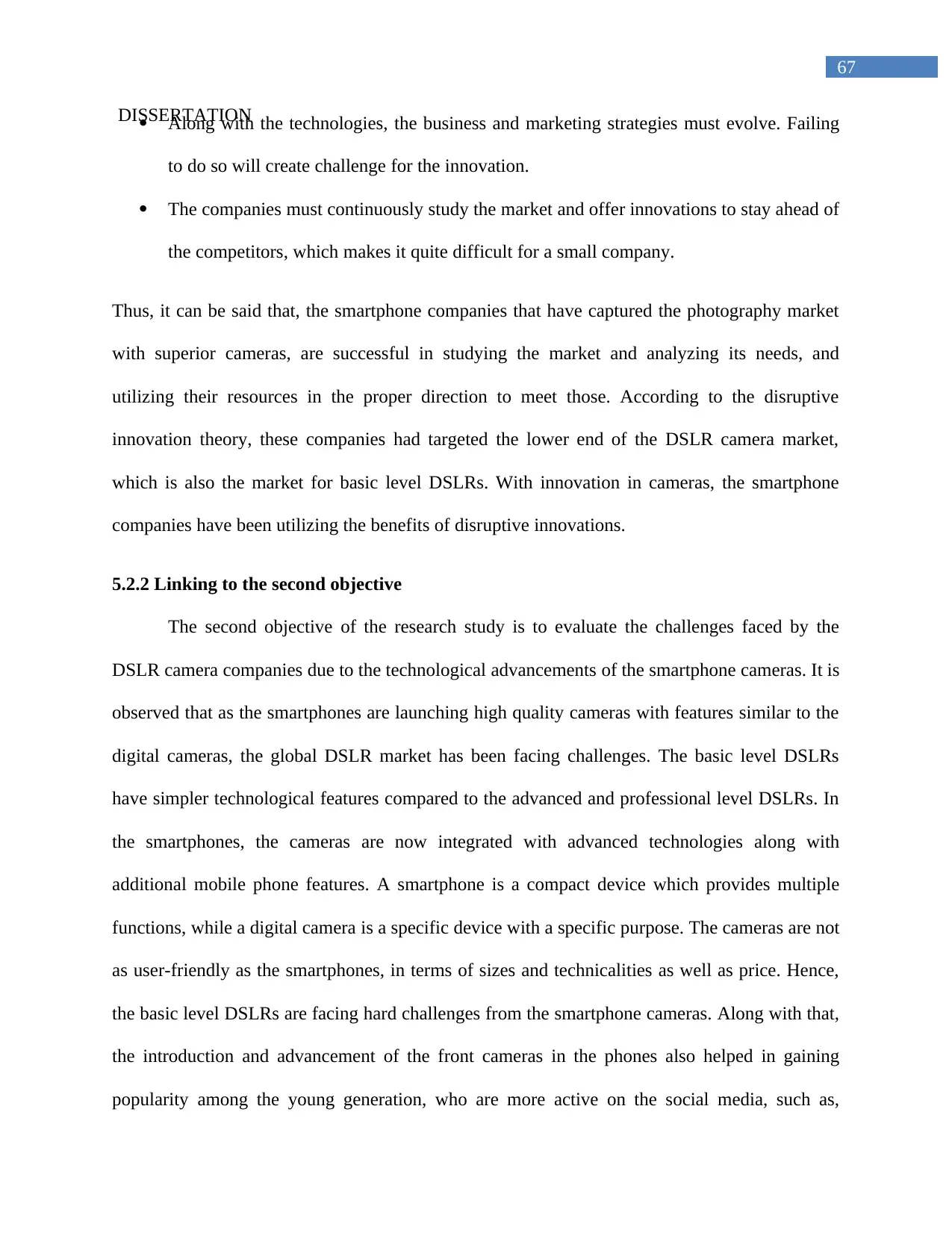
67
DISSERTATION Along with the technologies, the business and marketing strategies must evolve. Failing
to do so will create challenge for the innovation.
The companies must continuously study the market and offer innovations to stay ahead of
the competitors, which makes it quite difficult for a small company.
Thus, it can be said that, the smartphone companies that have captured the photography market
with superior cameras, are successful in studying the market and analyzing its needs, and
utilizing their resources in the proper direction to meet those. According to the disruptive
innovation theory, these companies had targeted the lower end of the DSLR camera market,
which is also the market for basic level DSLRs. With innovation in cameras, the smartphone
companies have been utilizing the benefits of disruptive innovations.
5.2.2 Linking to the second objective
The second objective of the research study is to evaluate the challenges faced by the
DSLR camera companies due to the technological advancements of the smartphone cameras. It is
observed that as the smartphones are launching high quality cameras with features similar to the
digital cameras, the global DSLR market has been facing challenges. The basic level DSLRs
have simpler technological features compared to the advanced and professional level DSLRs. In
the smartphones, the cameras are now integrated with advanced technologies along with
additional mobile phone features. A smartphone is a compact device which provides multiple
functions, while a digital camera is a specific device with a specific purpose. The cameras are not
as user-friendly as the smartphones, in terms of sizes and technicalities as well as price. Hence,
the basic level DSLRs are facing hard challenges from the smartphone cameras. Along with that,
the introduction and advancement of the front cameras in the phones also helped in gaining
popularity among the young generation, who are more active on the social media, such as,
DISSERTATION Along with the technologies, the business and marketing strategies must evolve. Failing
to do so will create challenge for the innovation.
The companies must continuously study the market and offer innovations to stay ahead of
the competitors, which makes it quite difficult for a small company.
Thus, it can be said that, the smartphone companies that have captured the photography market
with superior cameras, are successful in studying the market and analyzing its needs, and
utilizing their resources in the proper direction to meet those. According to the disruptive
innovation theory, these companies had targeted the lower end of the DSLR camera market,
which is also the market for basic level DSLRs. With innovation in cameras, the smartphone
companies have been utilizing the benefits of disruptive innovations.
5.2.2 Linking to the second objective
The second objective of the research study is to evaluate the challenges faced by the
DSLR camera companies due to the technological advancements of the smartphone cameras. It is
observed that as the smartphones are launching high quality cameras with features similar to the
digital cameras, the global DSLR market has been facing challenges. The basic level DSLRs
have simpler technological features compared to the advanced and professional level DSLRs. In
the smartphones, the cameras are now integrated with advanced technologies along with
additional mobile phone features. A smartphone is a compact device which provides multiple
functions, while a digital camera is a specific device with a specific purpose. The cameras are not
as user-friendly as the smartphones, in terms of sizes and technicalities as well as price. Hence,
the basic level DSLRs are facing hard challenges from the smartphone cameras. Along with that,
the introduction and advancement of the front cameras in the phones also helped in gaining
popularity among the young generation, who are more active on the social media, such as,
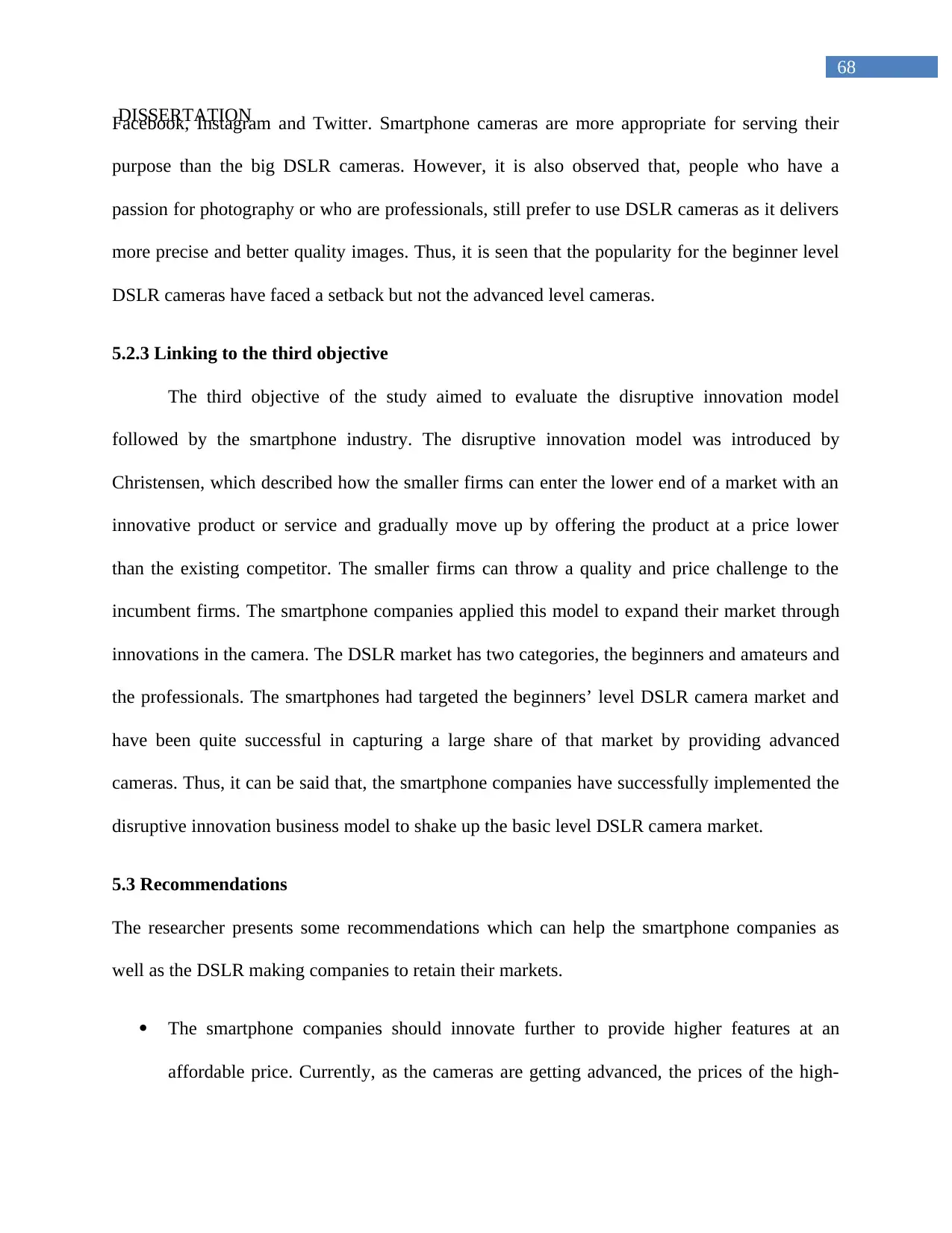
68
DISSERTATIONFacebook, Instagram and Twitter. Smartphone cameras are more appropriate for serving their
purpose than the big DSLR cameras. However, it is also observed that, people who have a
passion for photography or who are professionals, still prefer to use DSLR cameras as it delivers
more precise and better quality images. Thus, it is seen that the popularity for the beginner level
DSLR cameras have faced a setback but not the advanced level cameras.
5.2.3 Linking to the third objective
The third objective of the study aimed to evaluate the disruptive innovation model
followed by the smartphone industry. The disruptive innovation model was introduced by
Christensen, which described how the smaller firms can enter the lower end of a market with an
innovative product or service and gradually move up by offering the product at a price lower
than the existing competitor. The smaller firms can throw a quality and price challenge to the
incumbent firms. The smartphone companies applied this model to expand their market through
innovations in the camera. The DSLR market has two categories, the beginners and amateurs and
the professionals. The smartphones had targeted the beginners’ level DSLR camera market and
have been quite successful in capturing a large share of that market by providing advanced
cameras. Thus, it can be said that, the smartphone companies have successfully implemented the
disruptive innovation business model to shake up the basic level DSLR camera market.
5.3 Recommendations
The researcher presents some recommendations which can help the smartphone companies as
well as the DSLR making companies to retain their markets.
The smartphone companies should innovate further to provide higher features at an
affordable price. Currently, as the cameras are getting advanced, the prices of the high-
DISSERTATIONFacebook, Instagram and Twitter. Smartphone cameras are more appropriate for serving their
purpose than the big DSLR cameras. However, it is also observed that, people who have a
passion for photography or who are professionals, still prefer to use DSLR cameras as it delivers
more precise and better quality images. Thus, it is seen that the popularity for the beginner level
DSLR cameras have faced a setback but not the advanced level cameras.
5.2.3 Linking to the third objective
The third objective of the study aimed to evaluate the disruptive innovation model
followed by the smartphone industry. The disruptive innovation model was introduced by
Christensen, which described how the smaller firms can enter the lower end of a market with an
innovative product or service and gradually move up by offering the product at a price lower
than the existing competitor. The smaller firms can throw a quality and price challenge to the
incumbent firms. The smartphone companies applied this model to expand their market through
innovations in the camera. The DSLR market has two categories, the beginners and amateurs and
the professionals. The smartphones had targeted the beginners’ level DSLR camera market and
have been quite successful in capturing a large share of that market by providing advanced
cameras. Thus, it can be said that, the smartphone companies have successfully implemented the
disruptive innovation business model to shake up the basic level DSLR camera market.
5.3 Recommendations
The researcher presents some recommendations which can help the smartphone companies as
well as the DSLR making companies to retain their markets.
The smartphone companies should innovate further to provide higher features at an
affordable price. Currently, as the cameras are getting advanced, the prices of the high-
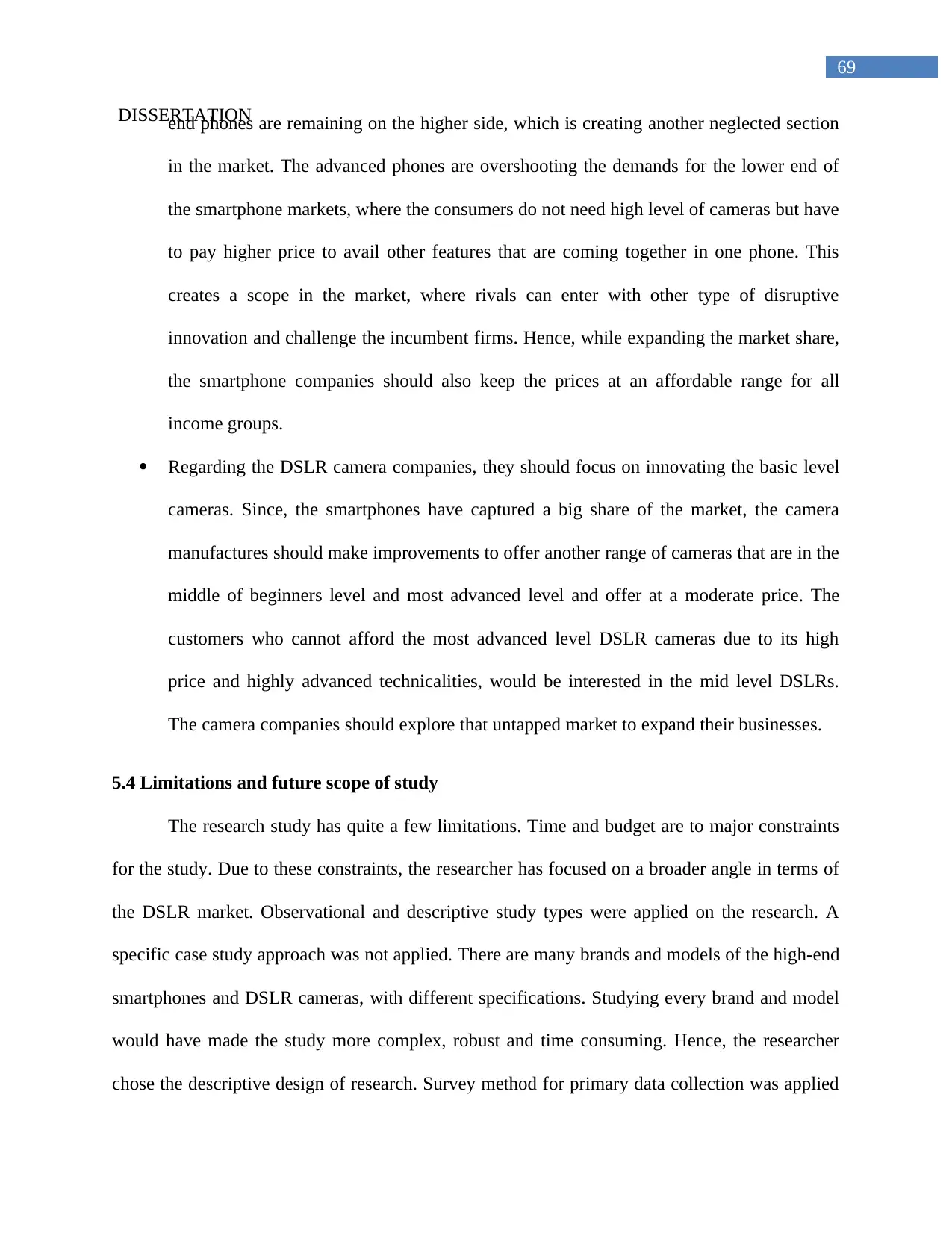
69
DISSERTATIONend phones are remaining on the higher side, which is creating another neglected section
in the market. The advanced phones are overshooting the demands for the lower end of
the smartphone markets, where the consumers do not need high level of cameras but have
to pay higher price to avail other features that are coming together in one phone. This
creates a scope in the market, where rivals can enter with other type of disruptive
innovation and challenge the incumbent firms. Hence, while expanding the market share,
the smartphone companies should also keep the prices at an affordable range for all
income groups.
Regarding the DSLR camera companies, they should focus on innovating the basic level
cameras. Since, the smartphones have captured a big share of the market, the camera
manufactures should make improvements to offer another range of cameras that are in the
middle of beginners level and most advanced level and offer at a moderate price. The
customers who cannot afford the most advanced level DSLR cameras due to its high
price and highly advanced technicalities, would be interested in the mid level DSLRs.
The camera companies should explore that untapped market to expand their businesses.
5.4 Limitations and future scope of study
The research study has quite a few limitations. Time and budget are to major constraints
for the study. Due to these constraints, the researcher has focused on a broader angle in terms of
the DSLR market. Observational and descriptive study types were applied on the research. A
specific case study approach was not applied. There are many brands and models of the high-end
smartphones and DSLR cameras, with different specifications. Studying every brand and model
would have made the study more complex, robust and time consuming. Hence, the researcher
chose the descriptive design of research. Survey method for primary data collection was applied
DISSERTATIONend phones are remaining on the higher side, which is creating another neglected section
in the market. The advanced phones are overshooting the demands for the lower end of
the smartphone markets, where the consumers do not need high level of cameras but have
to pay higher price to avail other features that are coming together in one phone. This
creates a scope in the market, where rivals can enter with other type of disruptive
innovation and challenge the incumbent firms. Hence, while expanding the market share,
the smartphone companies should also keep the prices at an affordable range for all
income groups.
Regarding the DSLR camera companies, they should focus on innovating the basic level
cameras. Since, the smartphones have captured a big share of the market, the camera
manufactures should make improvements to offer another range of cameras that are in the
middle of beginners level and most advanced level and offer at a moderate price. The
customers who cannot afford the most advanced level DSLR cameras due to its high
price and highly advanced technicalities, would be interested in the mid level DSLRs.
The camera companies should explore that untapped market to expand their businesses.
5.4 Limitations and future scope of study
The research study has quite a few limitations. Time and budget are to major constraints
for the study. Due to these constraints, the researcher has focused on a broader angle in terms of
the DSLR market. Observational and descriptive study types were applied on the research. A
specific case study approach was not applied. There are many brands and models of the high-end
smartphones and DSLR cameras, with different specifications. Studying every brand and model
would have made the study more complex, robust and time consuming. Hence, the researcher
chose the descriptive design of research. Survey method for primary data collection was applied
Secure Best Marks with AI Grader
Need help grading? Try our AI Grader for instant feedback on your assignments.
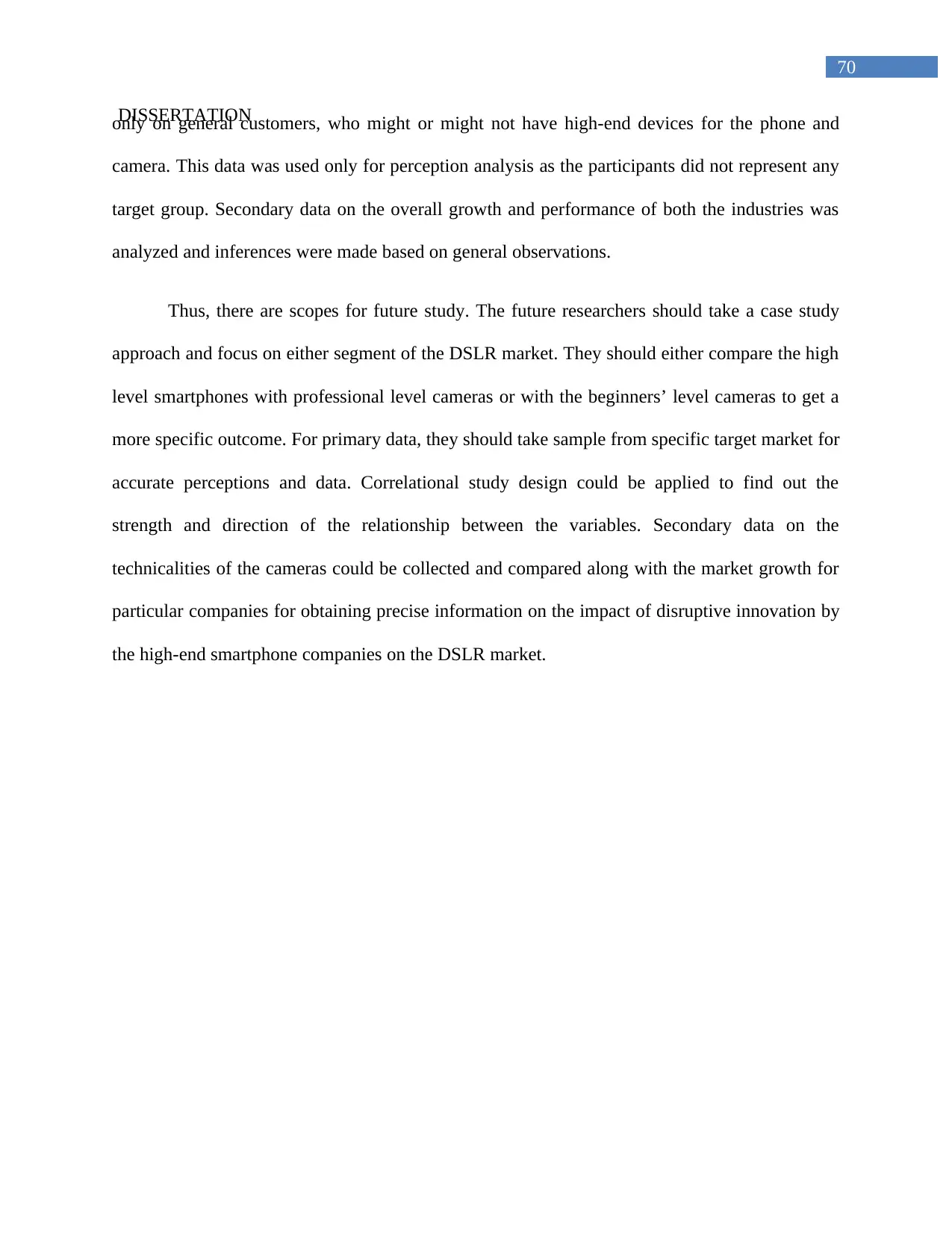
70
DISSERTATIONonly on general customers, who might or might not have high-end devices for the phone and
camera. This data was used only for perception analysis as the participants did not represent any
target group. Secondary data on the overall growth and performance of both the industries was
analyzed and inferences were made based on general observations.
Thus, there are scopes for future study. The future researchers should take a case study
approach and focus on either segment of the DSLR market. They should either compare the high
level smartphones with professional level cameras or with the beginners’ level cameras to get a
more specific outcome. For primary data, they should take sample from specific target market for
accurate perceptions and data. Correlational study design could be applied to find out the
strength and direction of the relationship between the variables. Secondary data on the
technicalities of the cameras could be collected and compared along with the market growth for
particular companies for obtaining precise information on the impact of disruptive innovation by
the high-end smartphone companies on the DSLR market.
DISSERTATIONonly on general customers, who might or might not have high-end devices for the phone and
camera. This data was used only for perception analysis as the participants did not represent any
target group. Secondary data on the overall growth and performance of both the industries was
analyzed and inferences were made based on general observations.
Thus, there are scopes for future study. The future researchers should take a case study
approach and focus on either segment of the DSLR market. They should either compare the high
level smartphones with professional level cameras or with the beginners’ level cameras to get a
more specific outcome. For primary data, they should take sample from specific target market for
accurate perceptions and data. Correlational study design could be applied to find out the
strength and direction of the relationship between the variables. Secondary data on the
technicalities of the cameras could be collected and compared along with the market growth for
particular companies for obtaining precise information on the impact of disruptive innovation by
the high-end smartphone companies on the DSLR market.
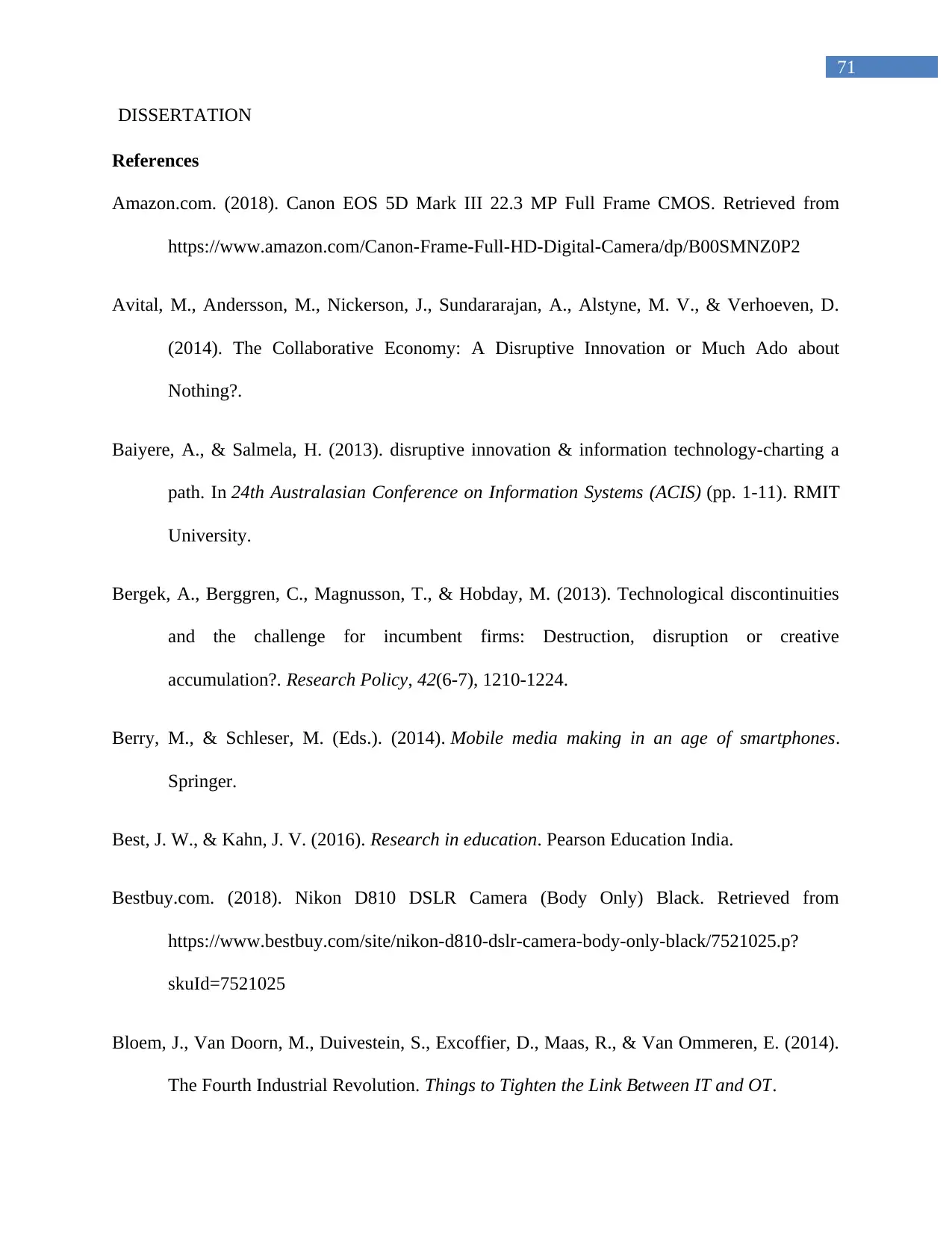
71
DISSERTATION
References
Amazon.com. (2018). Canon EOS 5D Mark III 22.3 MP Full Frame CMOS. Retrieved from
https://www.amazon.com/Canon-Frame-Full-HD-Digital-Camera/dp/B00SMNZ0P2
Avital, M., Andersson, M., Nickerson, J., Sundararajan, A., Alstyne, M. V., & Verhoeven, D.
(2014). The Collaborative Economy: A Disruptive Innovation or Much Ado about
Nothing?.
Baiyere, A., & Salmela, H. (2013). disruptive innovation & information technology-charting a
path. In 24th Australasian Conference on Information Systems (ACIS) (pp. 1-11). RMIT
University.
Bergek, A., Berggren, C., Magnusson, T., & Hobday, M. (2013). Technological discontinuities
and the challenge for incumbent firms: Destruction, disruption or creative
accumulation?. Research Policy, 42(6-7), 1210-1224.
Berry, M., & Schleser, M. (Eds.). (2014). Mobile media making in an age of smartphones.
Springer.
Best, J. W., & Kahn, J. V. (2016). Research in education. Pearson Education India.
Bestbuy.com. (2018). Nikon D810 DSLR Camera (Body Only) Black. Retrieved from
https://www.bestbuy.com/site/nikon-d810-dslr-camera-body-only-black/7521025.p?
skuId=7521025
Bloem, J., Van Doorn, M., Duivestein, S., Excoffier, D., Maas, R., & Van Ommeren, E. (2014).
The Fourth Industrial Revolution. Things to Tighten the Link Between IT and OT.
DISSERTATION
References
Amazon.com. (2018). Canon EOS 5D Mark III 22.3 MP Full Frame CMOS. Retrieved from
https://www.amazon.com/Canon-Frame-Full-HD-Digital-Camera/dp/B00SMNZ0P2
Avital, M., Andersson, M., Nickerson, J., Sundararajan, A., Alstyne, M. V., & Verhoeven, D.
(2014). The Collaborative Economy: A Disruptive Innovation or Much Ado about
Nothing?.
Baiyere, A., & Salmela, H. (2013). disruptive innovation & information technology-charting a
path. In 24th Australasian Conference on Information Systems (ACIS) (pp. 1-11). RMIT
University.
Bergek, A., Berggren, C., Magnusson, T., & Hobday, M. (2013). Technological discontinuities
and the challenge for incumbent firms: Destruction, disruption or creative
accumulation?. Research Policy, 42(6-7), 1210-1224.
Berry, M., & Schleser, M. (Eds.). (2014). Mobile media making in an age of smartphones.
Springer.
Best, J. W., & Kahn, J. V. (2016). Research in education. Pearson Education India.
Bestbuy.com. (2018). Nikon D810 DSLR Camera (Body Only) Black. Retrieved from
https://www.bestbuy.com/site/nikon-d810-dslr-camera-body-only-black/7521025.p?
skuId=7521025
Bloem, J., Van Doorn, M., Duivestein, S., Excoffier, D., Maas, R., & Van Ommeren, E. (2014).
The Fourth Industrial Revolution. Things to Tighten the Link Between IT and OT.
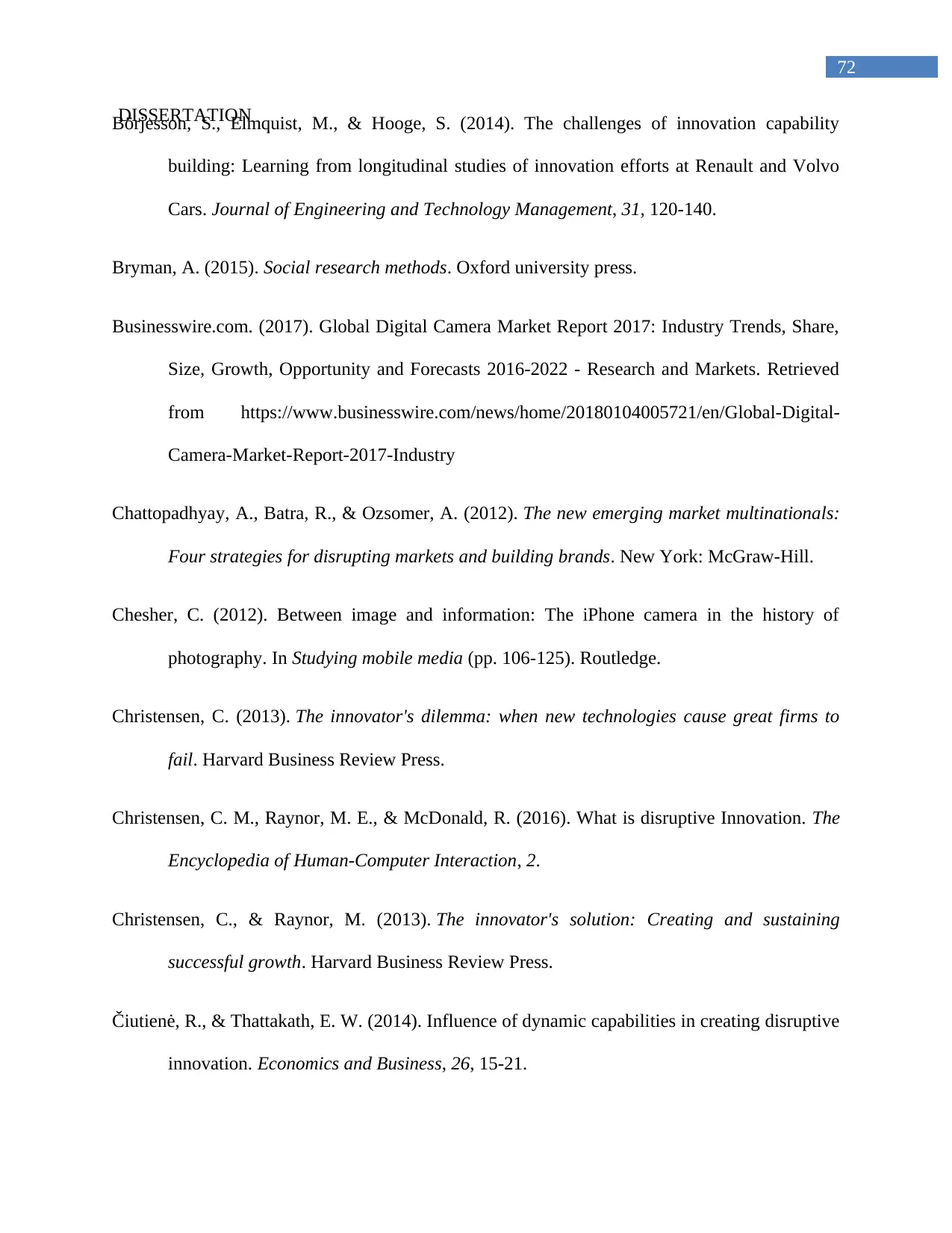
72
DISSERTATIONBörjesson, S., Elmquist, M., & Hooge, S. (2014). The challenges of innovation capability
building: Learning from longitudinal studies of innovation efforts at Renault and Volvo
Cars. Journal of Engineering and Technology Management, 31, 120-140.
Bryman, A. (2015). Social research methods. Oxford university press.
Businesswire.com. (2017). Global Digital Camera Market Report 2017: Industry Trends, Share,
Size, Growth, Opportunity and Forecasts 2016-2022 - Research and Markets. Retrieved
from https://www.businesswire.com/news/home/20180104005721/en/Global-Digital-
Camera-Market-Report-2017-Industry
Chattopadhyay, A., Batra, R., & Ozsomer, A. (2012). The new emerging market multinationals:
Four strategies for disrupting markets and building brands. New York: McGraw-Hill.
Chesher, C. (2012). Between image and information: The iPhone camera in the history of
photography. In Studying mobile media (pp. 106-125). Routledge.
Christensen, C. (2013). The innovator's dilemma: when new technologies cause great firms to
fail. Harvard Business Review Press.
Christensen, C. M., Raynor, M. E., & McDonald, R. (2016). What is disruptive Innovation. The
Encyclopedia of Human-Computer Interaction, 2.
Christensen, C., & Raynor, M. (2013). The innovator's solution: Creating and sustaining
successful growth. Harvard Business Review Press.
Čiutienė, R., & Thattakath, E. W. (2014). Influence of dynamic capabilities in creating disruptive
innovation. Economics and Business, 26, 15-21.
DISSERTATIONBörjesson, S., Elmquist, M., & Hooge, S. (2014). The challenges of innovation capability
building: Learning from longitudinal studies of innovation efforts at Renault and Volvo
Cars. Journal of Engineering and Technology Management, 31, 120-140.
Bryman, A. (2015). Social research methods. Oxford university press.
Businesswire.com. (2017). Global Digital Camera Market Report 2017: Industry Trends, Share,
Size, Growth, Opportunity and Forecasts 2016-2022 - Research and Markets. Retrieved
from https://www.businesswire.com/news/home/20180104005721/en/Global-Digital-
Camera-Market-Report-2017-Industry
Chattopadhyay, A., Batra, R., & Ozsomer, A. (2012). The new emerging market multinationals:
Four strategies for disrupting markets and building brands. New York: McGraw-Hill.
Chesher, C. (2012). Between image and information: The iPhone camera in the history of
photography. In Studying mobile media (pp. 106-125). Routledge.
Christensen, C. (2013). The innovator's dilemma: when new technologies cause great firms to
fail. Harvard Business Review Press.
Christensen, C. M., Raynor, M. E., & McDonald, R. (2016). What is disruptive Innovation. The
Encyclopedia of Human-Computer Interaction, 2.
Christensen, C., & Raynor, M. (2013). The innovator's solution: Creating and sustaining
successful growth. Harvard Business Review Press.
Čiutienė, R., & Thattakath, E. W. (2014). Influence of dynamic capabilities in creating disruptive
innovation. Economics and Business, 26, 15-21.
Paraphrase This Document
Need a fresh take? Get an instant paraphrase of this document with our AI Paraphraser

73
DISSERTATIONcnet.com. (2018). iPhone 7 Plus ups photo ante with 2 rear cameras (hands-on). Retrieved from
https://www.cnet.com/products/apple-iphone-7-plus/preview/
Cortez, N. (2014). Regulating disruptive innovation. Berkeley Technology Law Journal, 175-
228.
Cramer, J., & Krueger, A. B. (2016). Disruptive change in the taxi business: The case of
Uber. American Economic Review, 106(5), 177-82.
Creswell, J. W. (2013). Research design: Qualitative, quantitative, and mixed methods
approaches. Sage publications.
Curley, N. (2015). Why companies should embrace disruption. Retrieved from
https://www.weforum.org/agenda/2015/01/why-companies-should-embrace-disruption/
Downes, L., & Nunes, P. (2013). Big bang disruption.
Fitzgerald, M., Kruschwitz, N., Bonnet, D., & Welch, M. (2014). Embracing digital technology:
A new strategic imperative. MIT sloan management review, 55(2), 1.
Flavin, M. (2012). Disruptive technologies in higher education. Research in Learning
Technology, 20(sup1), 19184.
Flick, U., (2015). Introducing research methodology: A beginner's guide to doing a research
project. Sage.
Fontaine, R. (2013, June). Innovative technology elements for large and small pixel CIS devices.
In 2013 International Image Sensor Workshop (IISW), IISS.
DISSERTATIONcnet.com. (2018). iPhone 7 Plus ups photo ante with 2 rear cameras (hands-on). Retrieved from
https://www.cnet.com/products/apple-iphone-7-plus/preview/
Cortez, N. (2014). Regulating disruptive innovation. Berkeley Technology Law Journal, 175-
228.
Cramer, J., & Krueger, A. B. (2016). Disruptive change in the taxi business: The case of
Uber. American Economic Review, 106(5), 177-82.
Creswell, J. W. (2013). Research design: Qualitative, quantitative, and mixed methods
approaches. Sage publications.
Curley, N. (2015). Why companies should embrace disruption. Retrieved from
https://www.weforum.org/agenda/2015/01/why-companies-should-embrace-disruption/
Downes, L., & Nunes, P. (2013). Big bang disruption.
Fitzgerald, M., Kruschwitz, N., Bonnet, D., & Welch, M. (2014). Embracing digital technology:
A new strategic imperative. MIT sloan management review, 55(2), 1.
Flavin, M. (2012). Disruptive technologies in higher education. Research in Learning
Technology, 20(sup1), 19184.
Flick, U., (2015). Introducing research methodology: A beginner's guide to doing a research
project. Sage.
Fontaine, R. (2013, June). Innovative technology elements for large and small pixel CIS devices.
In 2013 International Image Sensor Workshop (IISW), IISS.
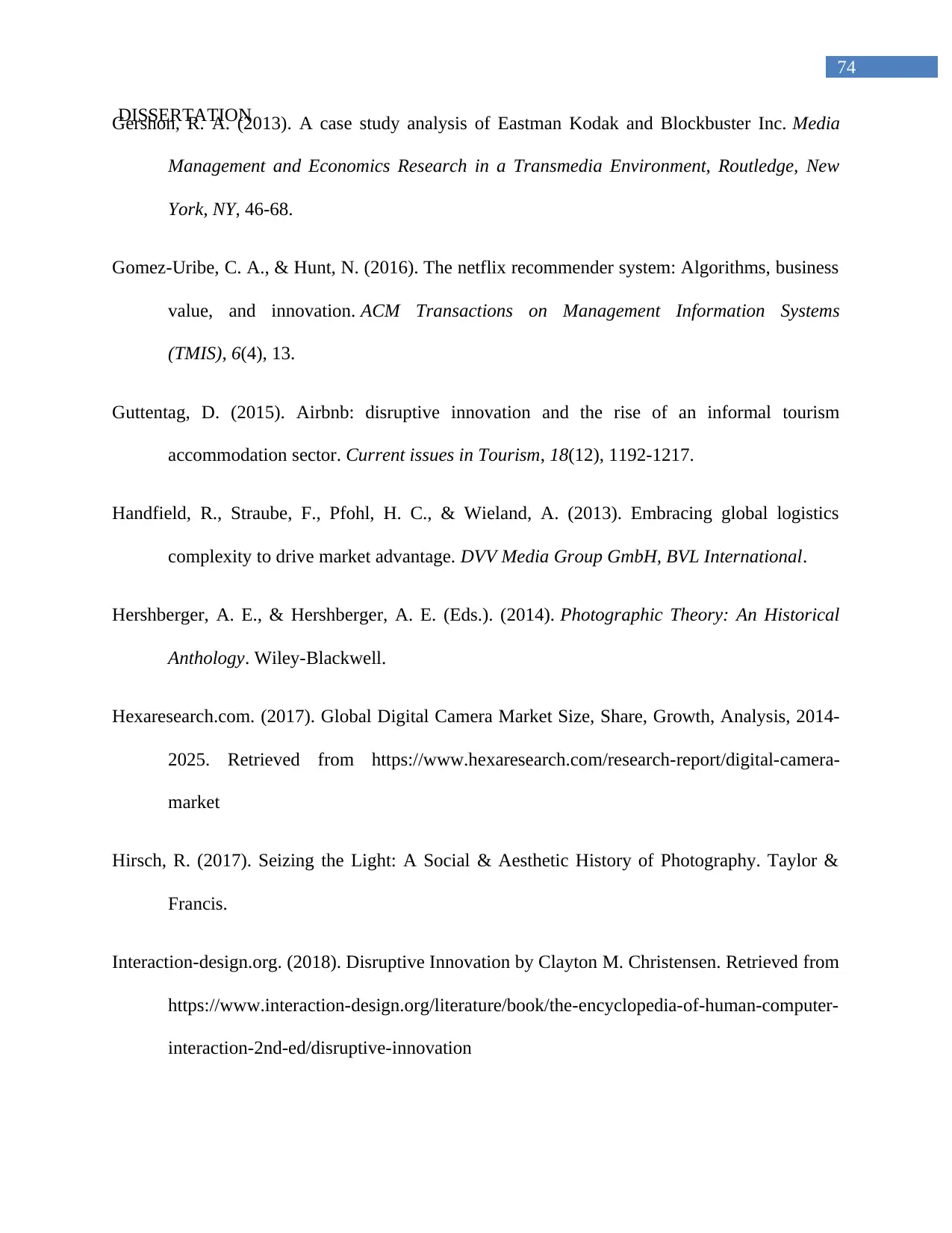
74
DISSERTATIONGershon, R. A. (2013). A case study analysis of Eastman Kodak and Blockbuster Inc. Media
Management and Economics Research in a Transmedia Environment, Routledge, New
York, NY, 46-68.
Gomez-Uribe, C. A., & Hunt, N. (2016). The netflix recommender system: Algorithms, business
value, and innovation. ACM Transactions on Management Information Systems
(TMIS), 6(4), 13.
Guttentag, D. (2015). Airbnb: disruptive innovation and the rise of an informal tourism
accommodation sector. Current issues in Tourism, 18(12), 1192-1217.
Handfield, R., Straube, F., Pfohl, H. C., & Wieland, A. (2013). Embracing global logistics
complexity to drive market advantage. DVV Media Group GmbH, BVL International.
Hershberger, A. E., & Hershberger, A. E. (Eds.). (2014). Photographic Theory: An Historical
Anthology. Wiley-Blackwell.
Hexaresearch.com. (2017). Global Digital Camera Market Size, Share, Growth, Analysis, 2014-
2025. Retrieved from https://www.hexaresearch.com/research-report/digital-camera-
market
Hirsch, R. (2017). Seizing the Light: A Social & Aesthetic History of Photography. Taylor &
Francis.
Interaction-design.org. (2018). Disruptive Innovation by Clayton M. Christensen. Retrieved from
https://www.interaction-design.org/literature/book/the-encyclopedia-of-human-computer-
interaction-2nd-ed/disruptive-innovation
DISSERTATIONGershon, R. A. (2013). A case study analysis of Eastman Kodak and Blockbuster Inc. Media
Management and Economics Research in a Transmedia Environment, Routledge, New
York, NY, 46-68.
Gomez-Uribe, C. A., & Hunt, N. (2016). The netflix recommender system: Algorithms, business
value, and innovation. ACM Transactions on Management Information Systems
(TMIS), 6(4), 13.
Guttentag, D. (2015). Airbnb: disruptive innovation and the rise of an informal tourism
accommodation sector. Current issues in Tourism, 18(12), 1192-1217.
Handfield, R., Straube, F., Pfohl, H. C., & Wieland, A. (2013). Embracing global logistics
complexity to drive market advantage. DVV Media Group GmbH, BVL International.
Hershberger, A. E., & Hershberger, A. E. (Eds.). (2014). Photographic Theory: An Historical
Anthology. Wiley-Blackwell.
Hexaresearch.com. (2017). Global Digital Camera Market Size, Share, Growth, Analysis, 2014-
2025. Retrieved from https://www.hexaresearch.com/research-report/digital-camera-
market
Hirsch, R. (2017). Seizing the Light: A Social & Aesthetic History of Photography. Taylor &
Francis.
Interaction-design.org. (2018). Disruptive Innovation by Clayton M. Christensen. Retrieved from
https://www.interaction-design.org/literature/book/the-encyclopedia-of-human-computer-
interaction-2nd-ed/disruptive-innovation
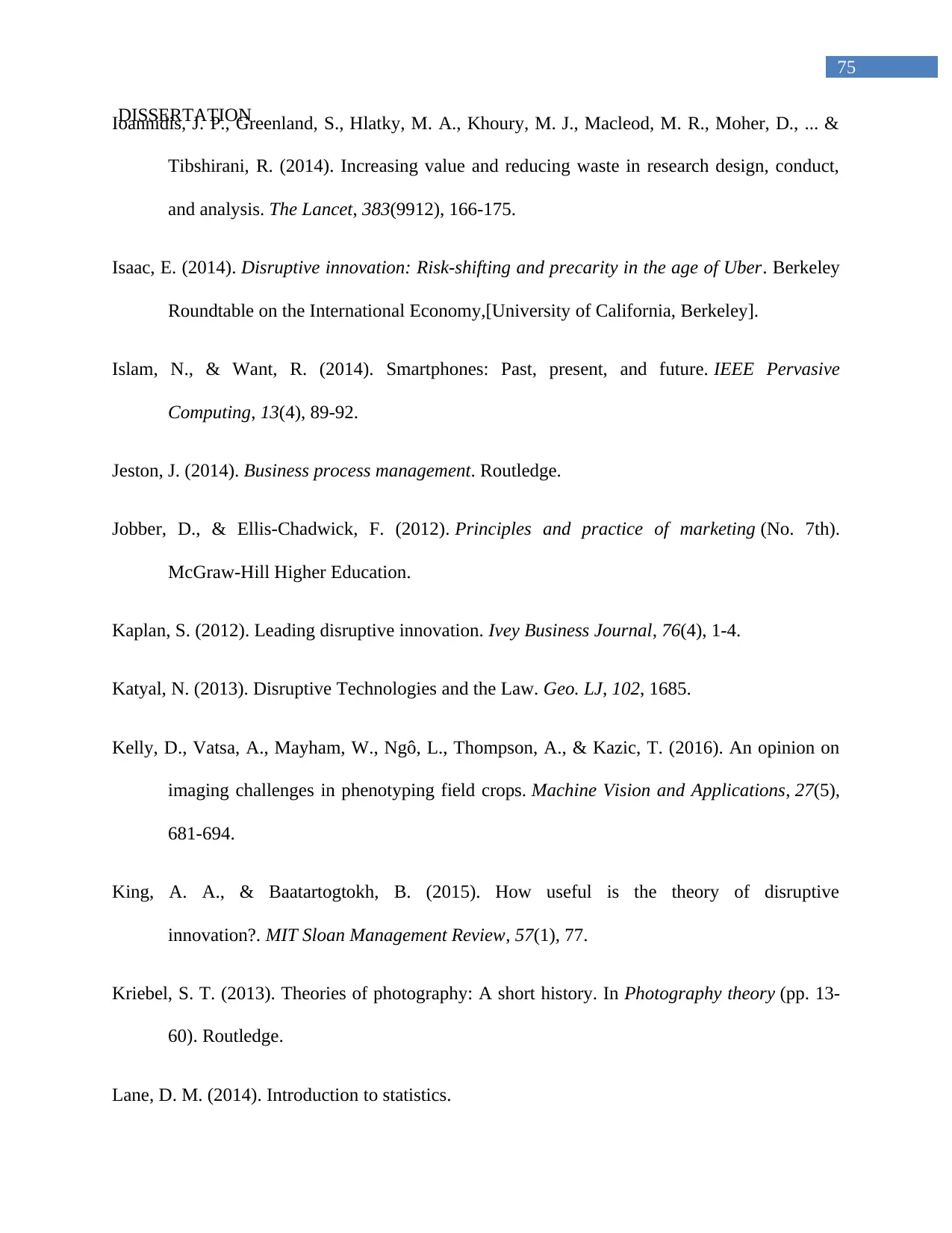
75
DISSERTATIONIoannidis, J. P., Greenland, S., Hlatky, M. A., Khoury, M. J., Macleod, M. R., Moher, D., ... &
Tibshirani, R. (2014). Increasing value and reducing waste in research design, conduct,
and analysis. The Lancet, 383(9912), 166-175.
Isaac, E. (2014). Disruptive innovation: Risk-shifting and precarity in the age of Uber. Berkeley
Roundtable on the International Economy,[University of California, Berkeley].
Islam, N., & Want, R. (2014). Smartphones: Past, present, and future. IEEE Pervasive
Computing, 13(4), 89-92.
Jeston, J. (2014). Business process management. Routledge.
Jobber, D., & Ellis-Chadwick, F. (2012). Principles and practice of marketing (No. 7th).
McGraw-Hill Higher Education.
Kaplan, S. (2012). Leading disruptive innovation. Ivey Business Journal, 76(4), 1-4.
Katyal, N. (2013). Disruptive Technologies and the Law. Geo. LJ, 102, 1685.
Kelly, D., Vatsa, A., Mayham, W., Ngô, L., Thompson, A., & Kazic, T. (2016). An opinion on
imaging challenges in phenotyping field crops. Machine Vision and Applications, 27(5),
681-694.
King, A. A., & Baatartogtokh, B. (2015). How useful is the theory of disruptive
innovation?. MIT Sloan Management Review, 57(1), 77.
Kriebel, S. T. (2013). Theories of photography: A short history. In Photography theory (pp. 13-
60). Routledge.
Lane, D. M. (2014). Introduction to statistics.
DISSERTATIONIoannidis, J. P., Greenland, S., Hlatky, M. A., Khoury, M. J., Macleod, M. R., Moher, D., ... &
Tibshirani, R. (2014). Increasing value and reducing waste in research design, conduct,
and analysis. The Lancet, 383(9912), 166-175.
Isaac, E. (2014). Disruptive innovation: Risk-shifting and precarity in the age of Uber. Berkeley
Roundtable on the International Economy,[University of California, Berkeley].
Islam, N., & Want, R. (2014). Smartphones: Past, present, and future. IEEE Pervasive
Computing, 13(4), 89-92.
Jeston, J. (2014). Business process management. Routledge.
Jobber, D., & Ellis-Chadwick, F. (2012). Principles and practice of marketing (No. 7th).
McGraw-Hill Higher Education.
Kaplan, S. (2012). Leading disruptive innovation. Ivey Business Journal, 76(4), 1-4.
Katyal, N. (2013). Disruptive Technologies and the Law. Geo. LJ, 102, 1685.
Kelly, D., Vatsa, A., Mayham, W., Ngô, L., Thompson, A., & Kazic, T. (2016). An opinion on
imaging challenges in phenotyping field crops. Machine Vision and Applications, 27(5),
681-694.
King, A. A., & Baatartogtokh, B. (2015). How useful is the theory of disruptive
innovation?. MIT Sloan Management Review, 57(1), 77.
Kriebel, S. T. (2013). Theories of photography: A short history. In Photography theory (pp. 13-
60). Routledge.
Lane, D. M. (2014). Introduction to statistics.
Secure Best Marks with AI Grader
Need help grading? Try our AI Grader for instant feedback on your assignments.
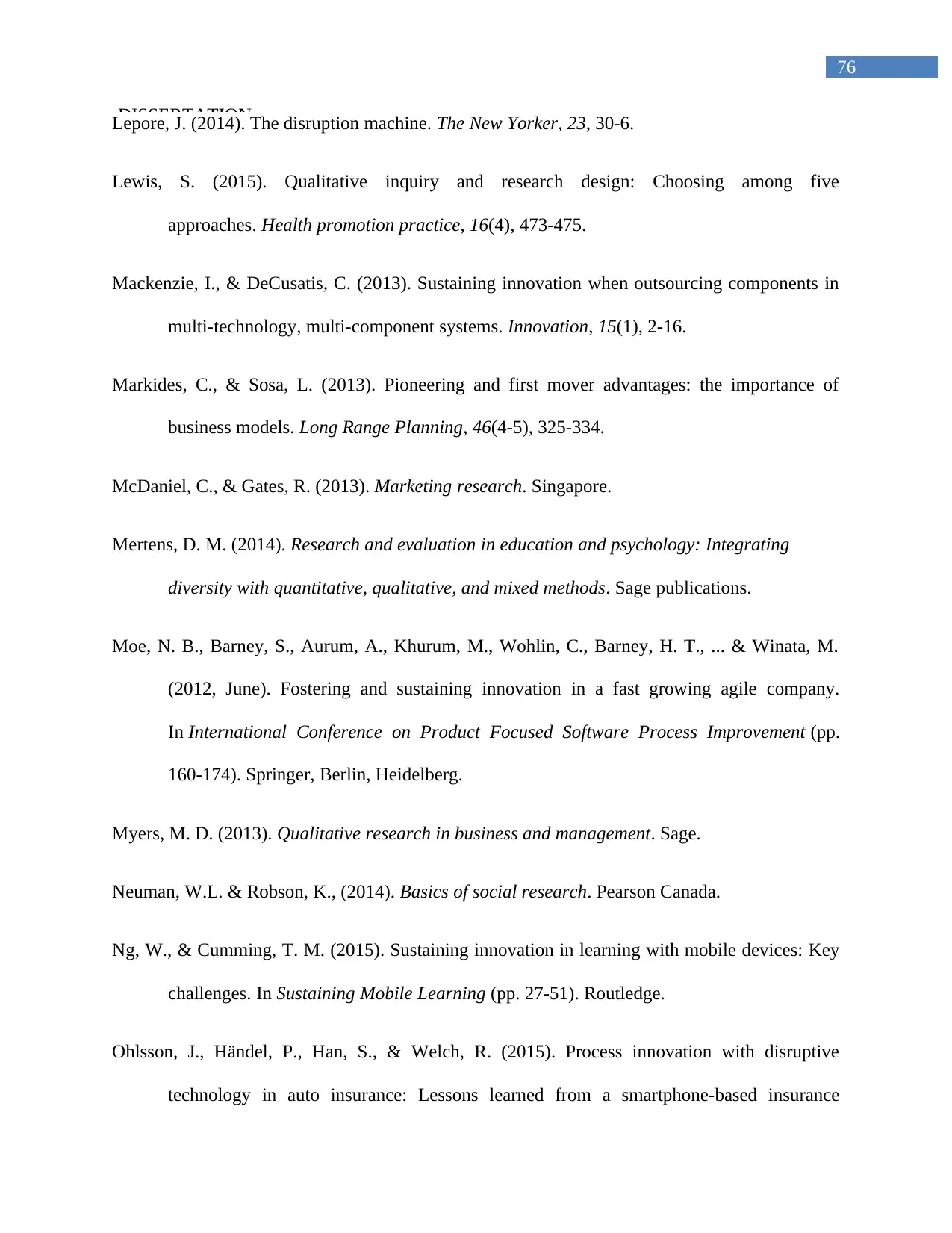
76
DISSERTATIONLepore, J. (2014). The disruption machine. The New Yorker, 23, 30-6.
Lewis, S. (2015). Qualitative inquiry and research design: Choosing among five
approaches. Health promotion practice, 16(4), 473-475.
Mackenzie, I., & DeCusatis, C. (2013). Sustaining innovation when outsourcing components in
multi-technology, multi-component systems. Innovation, 15(1), 2-16.
Markides, C., & Sosa, L. (2013). Pioneering and first mover advantages: the importance of
business models. Long Range Planning, 46(4-5), 325-334.
McDaniel, C., & Gates, R. (2013). Marketing research. Singapore.
Mertens, D. M. (2014). Research and evaluation in education and psychology: Integrating
diversity with quantitative, qualitative, and mixed methods. Sage publications.
Moe, N. B., Barney, S., Aurum, A., Khurum, M., Wohlin, C., Barney, H. T., ... & Winata, M.
(2012, June). Fostering and sustaining innovation in a fast growing agile company.
In International Conference on Product Focused Software Process Improvement (pp.
160-174). Springer, Berlin, Heidelberg.
Myers, M. D. (2013). Qualitative research in business and management. Sage.
Neuman, W.L. & Robson, K., (2014). Basics of social research. Pearson Canada.
Ng, W., & Cumming, T. M. (2015). Sustaining innovation in learning with mobile devices: Key
challenges. In Sustaining Mobile Learning (pp. 27-51). Routledge.
Ohlsson, J., Händel, P., Han, S., & Welch, R. (2015). Process innovation with disruptive
technology in auto insurance: Lessons learned from a smartphone-based insurance
DISSERTATIONLepore, J. (2014). The disruption machine. The New Yorker, 23, 30-6.
Lewis, S. (2015). Qualitative inquiry and research design: Choosing among five
approaches. Health promotion practice, 16(4), 473-475.
Mackenzie, I., & DeCusatis, C. (2013). Sustaining innovation when outsourcing components in
multi-technology, multi-component systems. Innovation, 15(1), 2-16.
Markides, C., & Sosa, L. (2013). Pioneering and first mover advantages: the importance of
business models. Long Range Planning, 46(4-5), 325-334.
McDaniel, C., & Gates, R. (2013). Marketing research. Singapore.
Mertens, D. M. (2014). Research and evaluation in education and psychology: Integrating
diversity with quantitative, qualitative, and mixed methods. Sage publications.
Moe, N. B., Barney, S., Aurum, A., Khurum, M., Wohlin, C., Barney, H. T., ... & Winata, M.
(2012, June). Fostering and sustaining innovation in a fast growing agile company.
In International Conference on Product Focused Software Process Improvement (pp.
160-174). Springer, Berlin, Heidelberg.
Myers, M. D. (2013). Qualitative research in business and management. Sage.
Neuman, W.L. & Robson, K., (2014). Basics of social research. Pearson Canada.
Ng, W., & Cumming, T. M. (2015). Sustaining innovation in learning with mobile devices: Key
challenges. In Sustaining Mobile Learning (pp. 27-51). Routledge.
Ohlsson, J., Händel, P., Han, S., & Welch, R. (2015). Process innovation with disruptive
technology in auto insurance: Lessons learned from a smartphone-based insurance
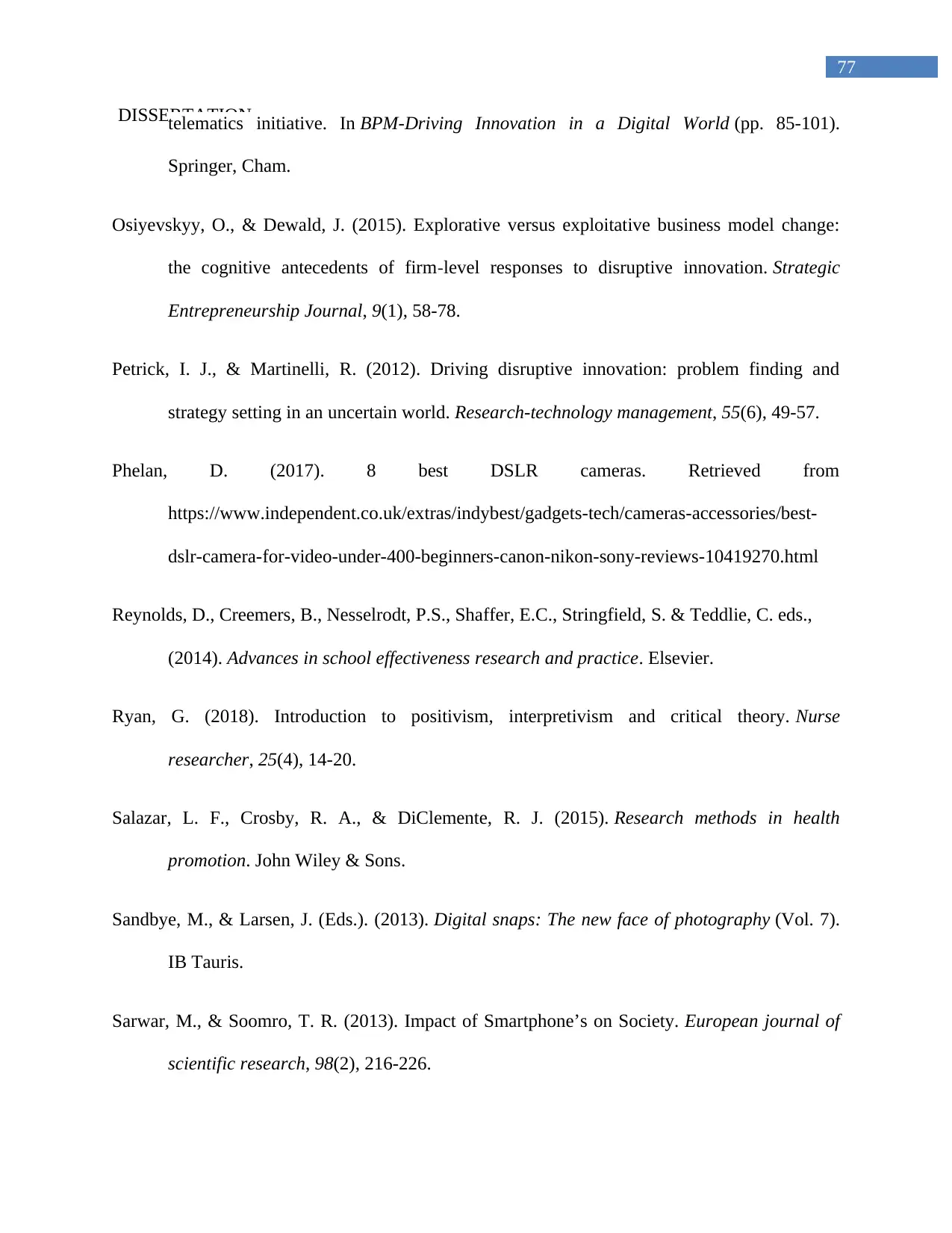
77
DISSERTATIONtelematics initiative. In BPM-Driving Innovation in a Digital World (pp. 85-101).
Springer, Cham.
Osiyevskyy, O., & Dewald, J. (2015). Explorative versus exploitative business model change:
the cognitive antecedents of firm‐level responses to disruptive innovation. Strategic
Entrepreneurship Journal, 9(1), 58-78.
Petrick, I. J., & Martinelli, R. (2012). Driving disruptive innovation: problem finding and
strategy setting in an uncertain world. Research-technology management, 55(6), 49-57.
Phelan, D. (2017). 8 best DSLR cameras. Retrieved from
https://www.independent.co.uk/extras/indybest/gadgets-tech/cameras-accessories/best-
dslr-camera-for-video-under-400-beginners-canon-nikon-sony-reviews-10419270.html
Reynolds, D., Creemers, B., Nesselrodt, P.S., Shaffer, E.C., Stringfield, S. & Teddlie, C. eds.,
(2014). Advances in school effectiveness research and practice. Elsevier.
Ryan, G. (2018). Introduction to positivism, interpretivism and critical theory. Nurse
researcher, 25(4), 14-20.
Salazar, L. F., Crosby, R. A., & DiClemente, R. J. (2015). Research methods in health
promotion. John Wiley & Sons.
Sandbye, M., & Larsen, J. (Eds.). (2013). Digital snaps: The new face of photography (Vol. 7).
IB Tauris.
Sarwar, M., & Soomro, T. R. (2013). Impact of Smartphone’s on Society. European journal of
scientific research, 98(2), 216-226.
DISSERTATIONtelematics initiative. In BPM-Driving Innovation in a Digital World (pp. 85-101).
Springer, Cham.
Osiyevskyy, O., & Dewald, J. (2015). Explorative versus exploitative business model change:
the cognitive antecedents of firm‐level responses to disruptive innovation. Strategic
Entrepreneurship Journal, 9(1), 58-78.
Petrick, I. J., & Martinelli, R. (2012). Driving disruptive innovation: problem finding and
strategy setting in an uncertain world. Research-technology management, 55(6), 49-57.
Phelan, D. (2017). 8 best DSLR cameras. Retrieved from
https://www.independent.co.uk/extras/indybest/gadgets-tech/cameras-accessories/best-
dslr-camera-for-video-under-400-beginners-canon-nikon-sony-reviews-10419270.html
Reynolds, D., Creemers, B., Nesselrodt, P.S., Shaffer, E.C., Stringfield, S. & Teddlie, C. eds.,
(2014). Advances in school effectiveness research and practice. Elsevier.
Ryan, G. (2018). Introduction to positivism, interpretivism and critical theory. Nurse
researcher, 25(4), 14-20.
Salazar, L. F., Crosby, R. A., & DiClemente, R. J. (2015). Research methods in health
promotion. John Wiley & Sons.
Sandbye, M., & Larsen, J. (Eds.). (2013). Digital snaps: The new face of photography (Vol. 7).
IB Tauris.
Sarwar, M., & Soomro, T. R. (2013). Impact of Smartphone’s on Society. European journal of
scientific research, 98(2), 216-226.
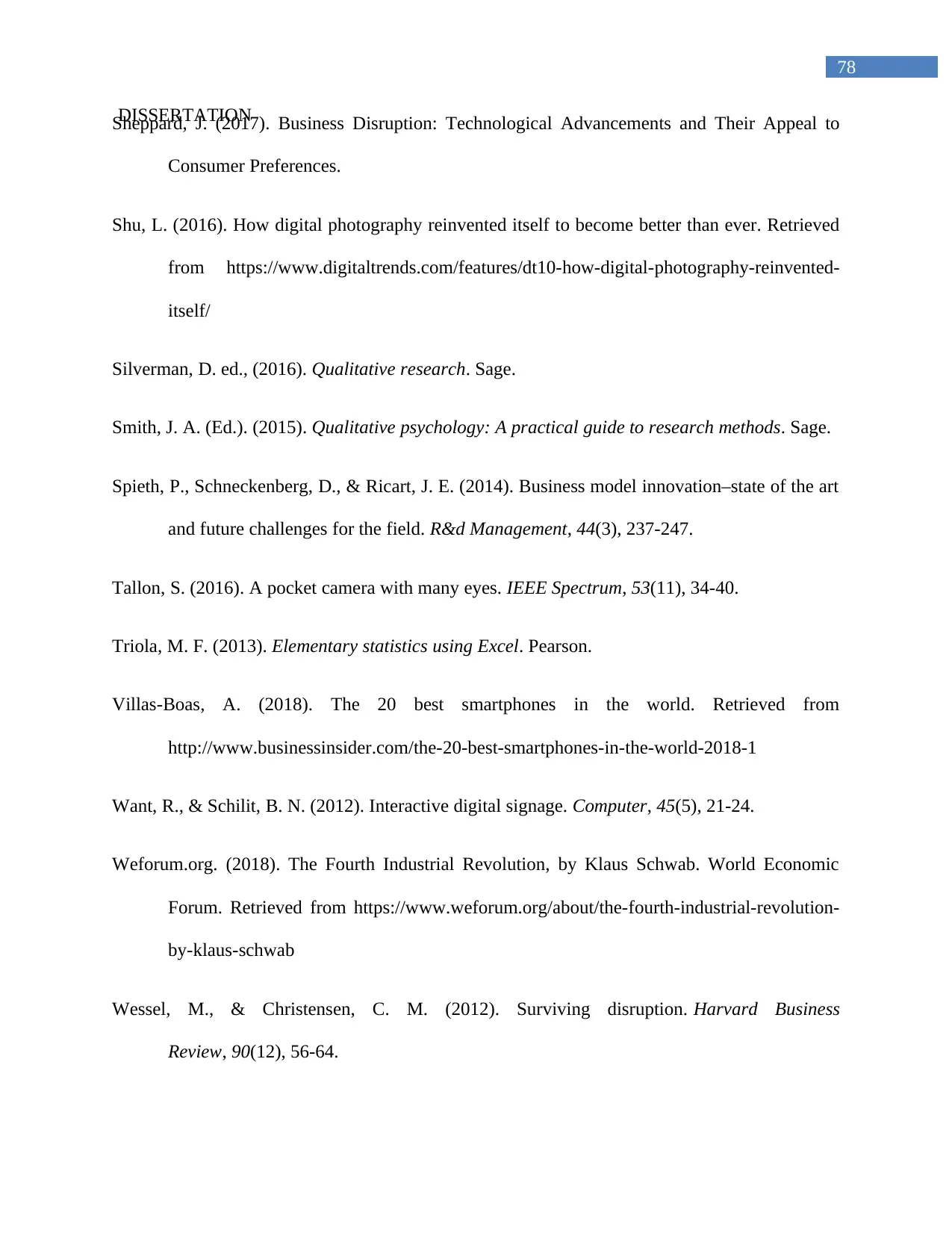
78
DISSERTATIONSheppard, J. (2017). Business Disruption: Technological Advancements and Their Appeal to
Consumer Preferences.
Shu, L. (2016). How digital photography reinvented itself to become better than ever. Retrieved
from https://www.digitaltrends.com/features/dt10-how-digital-photography-reinvented-
itself/
Silverman, D. ed., (2016). Qualitative research. Sage.
Smith, J. A. (Ed.). (2015). Qualitative psychology: A practical guide to research methods. Sage.
Spieth, P., Schneckenberg, D., & Ricart, J. E. (2014). Business model innovation–state of the art
and future challenges for the field. R&d Management, 44(3), 237-247.
Tallon, S. (2016). A pocket camera with many eyes. IEEE Spectrum, 53(11), 34-40.
Triola, M. F. (2013). Elementary statistics using Excel. Pearson.
Villas-Boas, A. (2018). The 20 best smartphones in the world. Retrieved from
http://www.businessinsider.com/the-20-best-smartphones-in-the-world-2018-1
Want, R., & Schilit, B. N. (2012). Interactive digital signage. Computer, 45(5), 21-24.
Weforum.org. (2018). The Fourth Industrial Revolution, by Klaus Schwab. World Economic
Forum. Retrieved from https://www.weforum.org/about/the-fourth-industrial-revolution-
by-klaus-schwab
Wessel, M., & Christensen, C. M. (2012). Surviving disruption. Harvard Business
Review, 90(12), 56-64.
DISSERTATIONSheppard, J. (2017). Business Disruption: Technological Advancements and Their Appeal to
Consumer Preferences.
Shu, L. (2016). How digital photography reinvented itself to become better than ever. Retrieved
from https://www.digitaltrends.com/features/dt10-how-digital-photography-reinvented-
itself/
Silverman, D. ed., (2016). Qualitative research. Sage.
Smith, J. A. (Ed.). (2015). Qualitative psychology: A practical guide to research methods. Sage.
Spieth, P., Schneckenberg, D., & Ricart, J. E. (2014). Business model innovation–state of the art
and future challenges for the field. R&d Management, 44(3), 237-247.
Tallon, S. (2016). A pocket camera with many eyes. IEEE Spectrum, 53(11), 34-40.
Triola, M. F. (2013). Elementary statistics using Excel. Pearson.
Villas-Boas, A. (2018). The 20 best smartphones in the world. Retrieved from
http://www.businessinsider.com/the-20-best-smartphones-in-the-world-2018-1
Want, R., & Schilit, B. N. (2012). Interactive digital signage. Computer, 45(5), 21-24.
Weforum.org. (2018). The Fourth Industrial Revolution, by Klaus Schwab. World Economic
Forum. Retrieved from https://www.weforum.org/about/the-fourth-industrial-revolution-
by-klaus-schwab
Wessel, M., & Christensen, C. M. (2012). Surviving disruption. Harvard Business
Review, 90(12), 56-64.
Paraphrase This Document
Need a fresh take? Get an instant paraphrase of this document with our AI Paraphraser
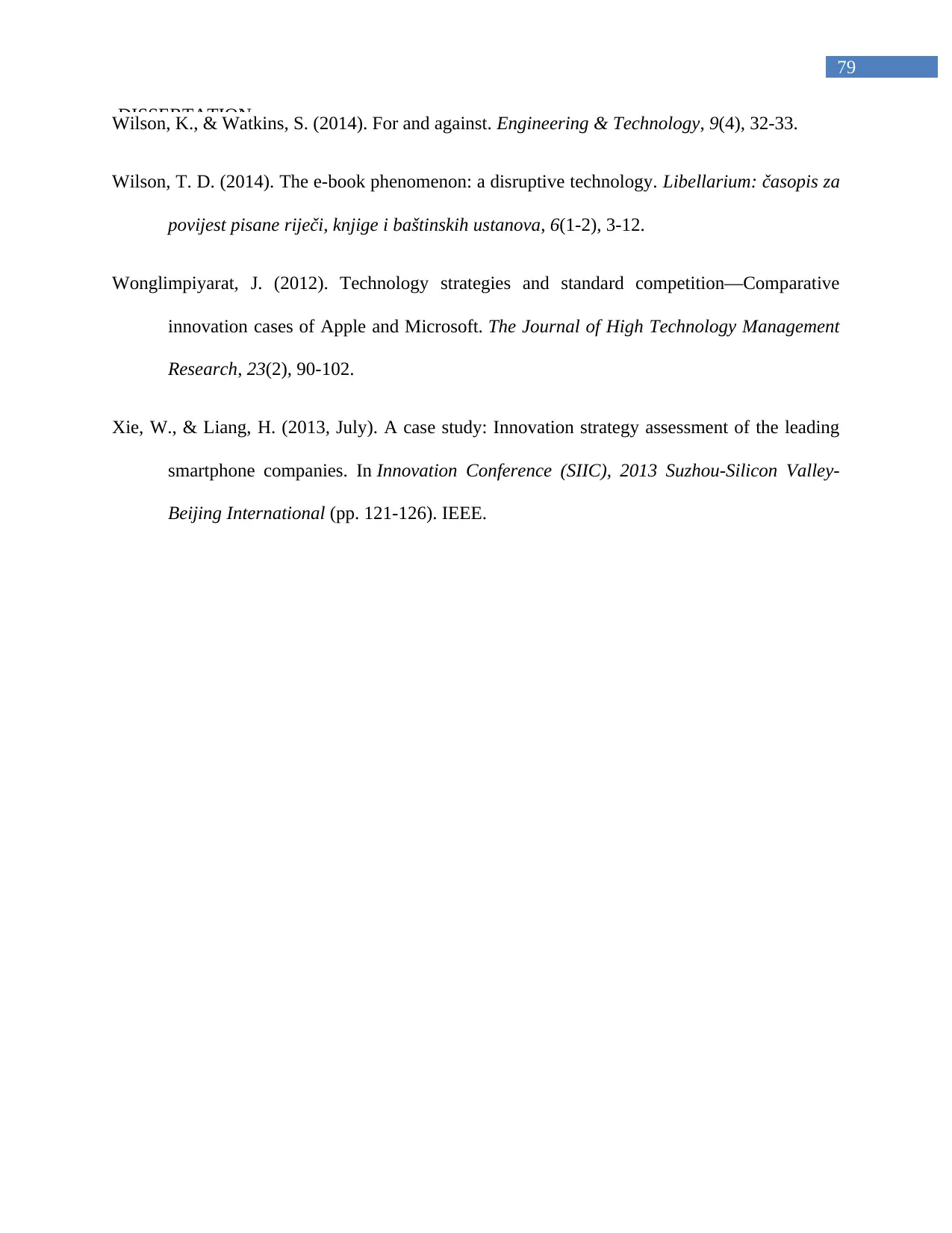
79
DISSERTATIONWilson, K., & Watkins, S. (2014). For and against. Engineering & Technology, 9(4), 32-33.
Wilson, T. D. (2014). The e-book phenomenon: a disruptive technology. Libellarium: časopis za
povijest pisane riječi, knjige i baštinskih ustanova, 6(1-2), 3-12.
Wonglimpiyarat, J. (2012). Technology strategies and standard competition—Comparative
innovation cases of Apple and Microsoft. The Journal of High Technology Management
Research, 23(2), 90-102.
Xie, W., & Liang, H. (2013, July). A case study: Innovation strategy assessment of the leading
smartphone companies. In Innovation Conference (SIIC), 2013 Suzhou-Silicon Valley-
Beijing International (pp. 121-126). IEEE.
DISSERTATIONWilson, K., & Watkins, S. (2014). For and against. Engineering & Technology, 9(4), 32-33.
Wilson, T. D. (2014). The e-book phenomenon: a disruptive technology. Libellarium: časopis za
povijest pisane riječi, knjige i baštinskih ustanova, 6(1-2), 3-12.
Wonglimpiyarat, J. (2012). Technology strategies and standard competition—Comparative
innovation cases of Apple and Microsoft. The Journal of High Technology Management
Research, 23(2), 90-102.
Xie, W., & Liang, H. (2013, July). A case study: Innovation strategy assessment of the leading
smartphone companies. In Innovation Conference (SIIC), 2013 Suzhou-Silicon Valley-
Beijing International (pp. 121-126). IEEE.

80
DISSERTATION
Appendix 1
SURVEY QUESTIONNAIRE
1. Do you use high-end smartphones with a good camera?
a) Yes
b) No
2. Do you own and use DSLR cameras?
a) Yes
b) No
3. Please specify your age group.
a) 18-25 years
b) 26-35 years
c) 36-45 years
d) 46-55 years
e) 56 years and above
4. Please specify your income level (annually)
a) Less than €200,000
b) €200,000 - €500,000
c) €500,000 and above
5. How frequently do you use your phone camera in a month?
a) Less than 10 times
b) 10-15 times
c) 16-20 times
DISSERTATION
Appendix 1
SURVEY QUESTIONNAIRE
1. Do you use high-end smartphones with a good camera?
a) Yes
b) No
2. Do you own and use DSLR cameras?
a) Yes
b) No
3. Please specify your age group.
a) 18-25 years
b) 26-35 years
c) 36-45 years
d) 46-55 years
e) 56 years and above
4. Please specify your income level (annually)
a) Less than €200,000
b) €200,000 - €500,000
c) €500,000 and above
5. How frequently do you use your phone camera in a month?
a) Less than 10 times
b) 10-15 times
c) 16-20 times
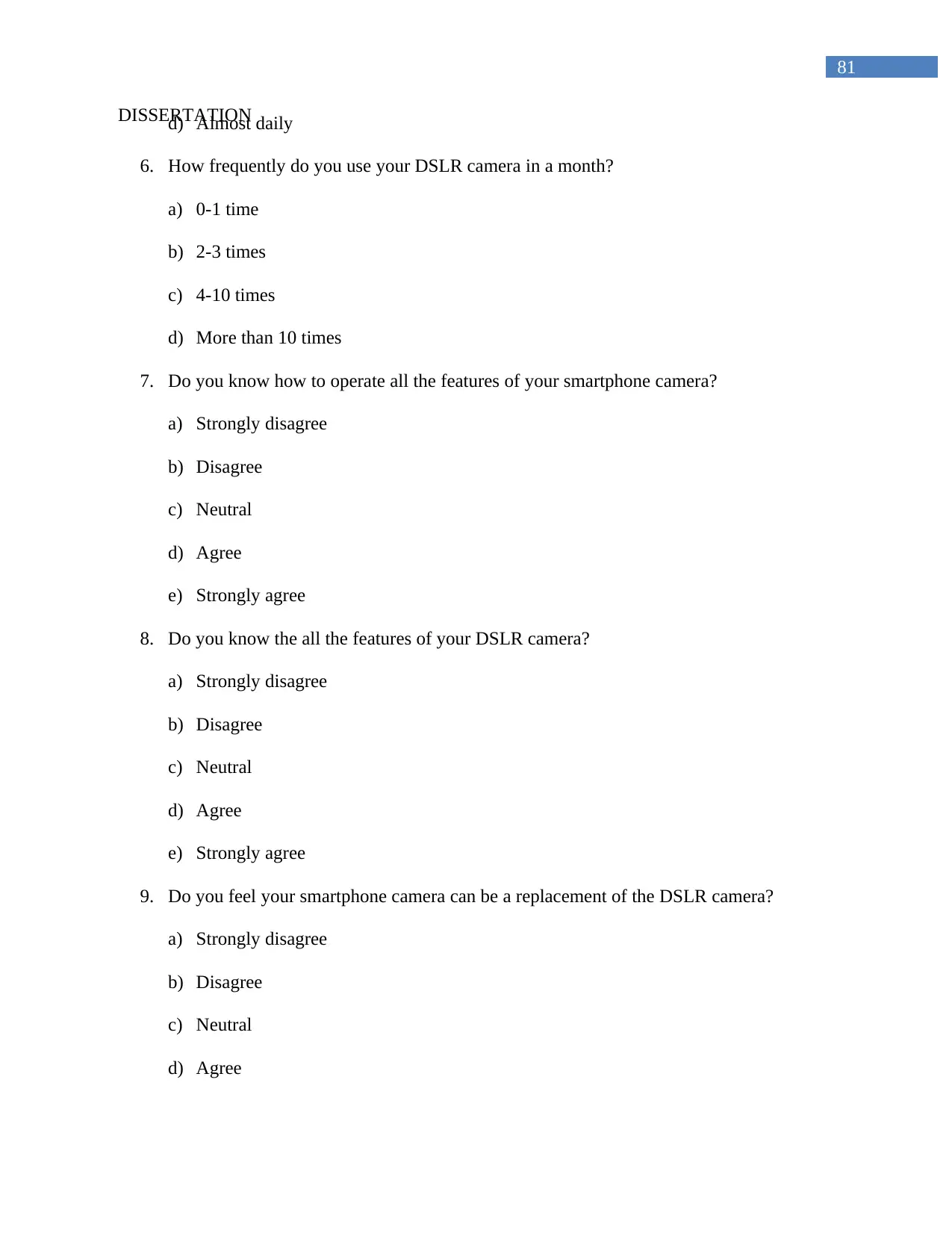
81
DISSERTATIONd) Almost daily
6. How frequently do you use your DSLR camera in a month?
a) 0-1 time
b) 2-3 times
c) 4-10 times
d) More than 10 times
7. Do you know how to operate all the features of your smartphone camera?
a) Strongly disagree
b) Disagree
c) Neutral
d) Agree
e) Strongly agree
8. Do you know the all the features of your DSLR camera?
a) Strongly disagree
b) Disagree
c) Neutral
d) Agree
e) Strongly agree
9. Do you feel your smartphone camera can be a replacement of the DSLR camera?
a) Strongly disagree
b) Disagree
c) Neutral
d) Agree
DISSERTATIONd) Almost daily
6. How frequently do you use your DSLR camera in a month?
a) 0-1 time
b) 2-3 times
c) 4-10 times
d) More than 10 times
7. Do you know how to operate all the features of your smartphone camera?
a) Strongly disagree
b) Disagree
c) Neutral
d) Agree
e) Strongly agree
8. Do you know the all the features of your DSLR camera?
a) Strongly disagree
b) Disagree
c) Neutral
d) Agree
e) Strongly agree
9. Do you feel your smartphone camera can be a replacement of the DSLR camera?
a) Strongly disagree
b) Disagree
c) Neutral
d) Agree
Secure Best Marks with AI Grader
Need help grading? Try our AI Grader for instant feedback on your assignments.
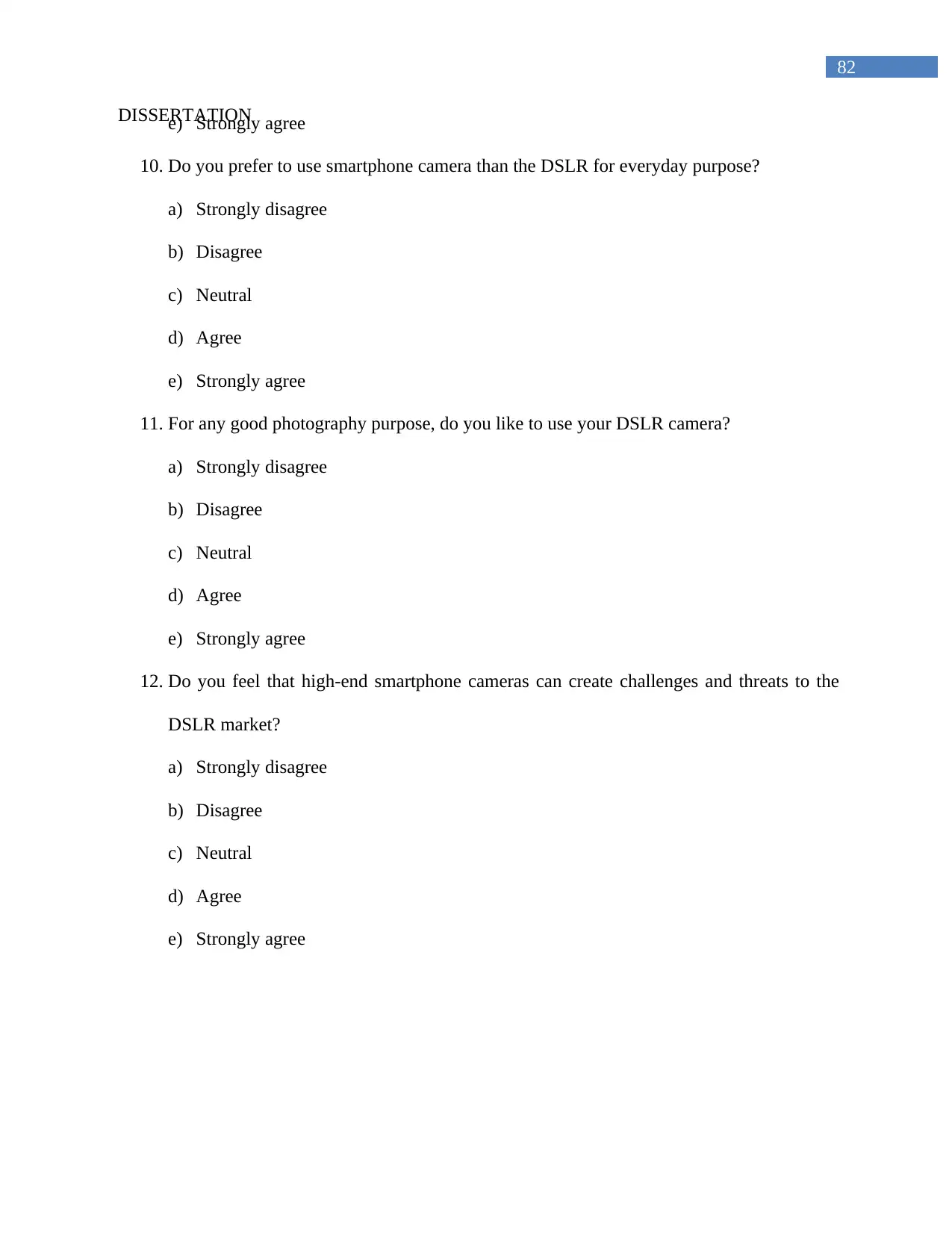
82
DISSERTATIONe) Strongly agree
10. Do you prefer to use smartphone camera than the DSLR for everyday purpose?
a) Strongly disagree
b) Disagree
c) Neutral
d) Agree
e) Strongly agree
11. For any good photography purpose, do you like to use your DSLR camera?
a) Strongly disagree
b) Disagree
c) Neutral
d) Agree
e) Strongly agree
12. Do you feel that high-end smartphone cameras can create challenges and threats to the
DSLR market?
a) Strongly disagree
b) Disagree
c) Neutral
d) Agree
e) Strongly agree
DISSERTATIONe) Strongly agree
10. Do you prefer to use smartphone camera than the DSLR for everyday purpose?
a) Strongly disagree
b) Disagree
c) Neutral
d) Agree
e) Strongly agree
11. For any good photography purpose, do you like to use your DSLR camera?
a) Strongly disagree
b) Disagree
c) Neutral
d) Agree
e) Strongly agree
12. Do you feel that high-end smartphone cameras can create challenges and threats to the
DSLR market?
a) Strongly disagree
b) Disagree
c) Neutral
d) Agree
e) Strongly agree
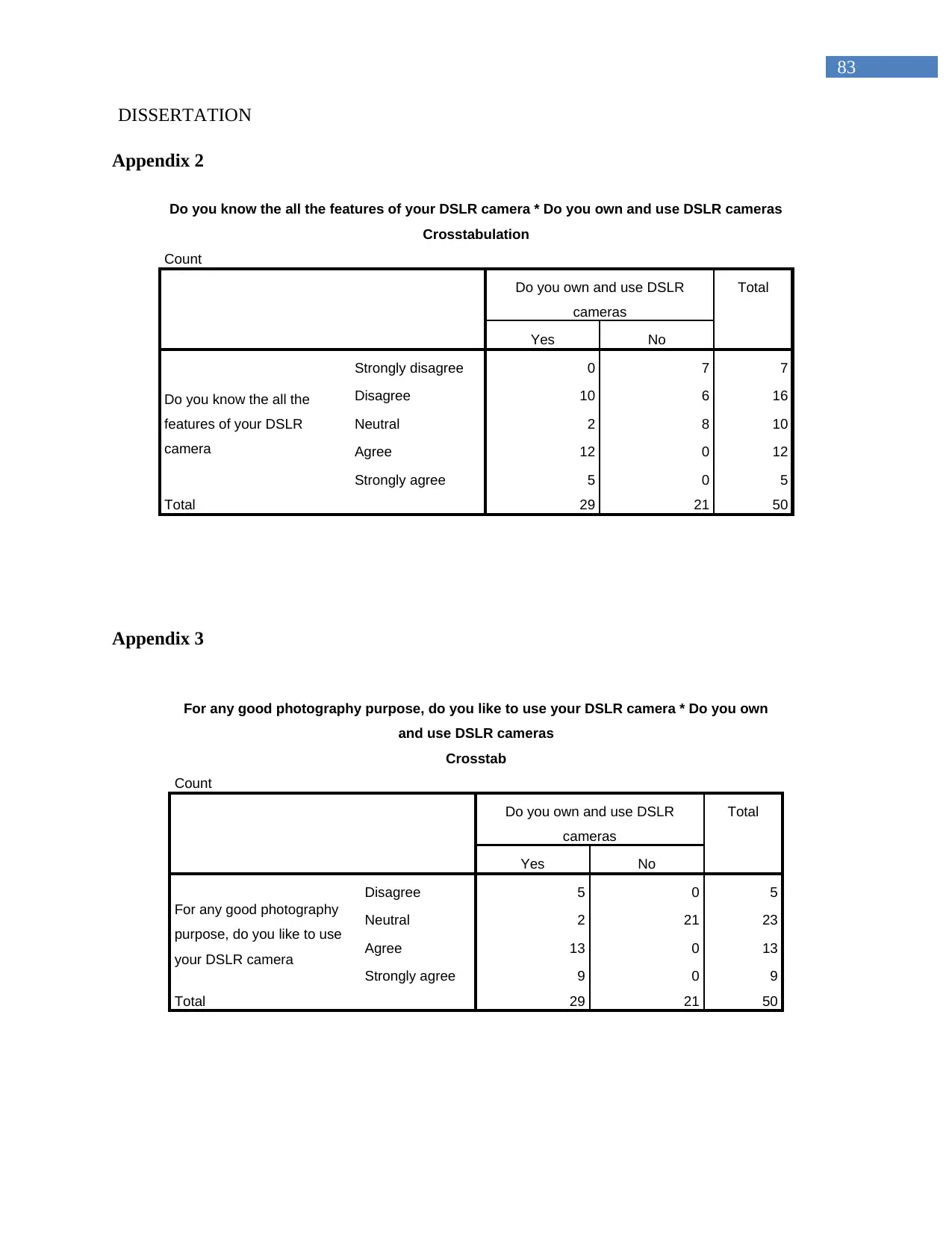
83
DISSERTATION
Appendix 2
Do you know the all the features of your DSLR camera * Do you own and use DSLR cameras
Crosstabulation
Count
Do you own and use DSLR
cameras
Total
Yes No
Do you know the all the
features of your DSLR
camera
Strongly disagree 0 7 7
Disagree 10 6 16
Neutral 2 8 10
Agree 12 0 12
Strongly agree 5 0 5
Total 29 21 50
Appendix 3
For any good photography purpose, do you like to use your DSLR camera * Do you own
and use DSLR cameras
Crosstab
Count
Do you own and use DSLR
cameras
Total
Yes No
For any good photography
purpose, do you like to use
your DSLR camera
Disagree 5 0 5
Neutral 2 21 23
Agree 13 0 13
Strongly agree 9 0 9
Total 29 21 50
DISSERTATION
Appendix 2
Do you know the all the features of your DSLR camera * Do you own and use DSLR cameras
Crosstabulation
Count
Do you own and use DSLR
cameras
Total
Yes No
Do you know the all the
features of your DSLR
camera
Strongly disagree 0 7 7
Disagree 10 6 16
Neutral 2 8 10
Agree 12 0 12
Strongly agree 5 0 5
Total 29 21 50
Appendix 3
For any good photography purpose, do you like to use your DSLR camera * Do you own
and use DSLR cameras
Crosstab
Count
Do you own and use DSLR
cameras
Total
Yes No
For any good photography
purpose, do you like to use
your DSLR camera
Disagree 5 0 5
Neutral 2 21 23
Agree 13 0 13
Strongly agree 9 0 9
Total 29 21 50
1 out of 84
Related Documents
Your All-in-One AI-Powered Toolkit for Academic Success.
+13062052269
info@desklib.com
Available 24*7 on WhatsApp / Email
![[object Object]](/_next/static/media/star-bottom.7253800d.svg)
Unlock your academic potential
© 2024 | Zucol Services PVT LTD | All rights reserved.





